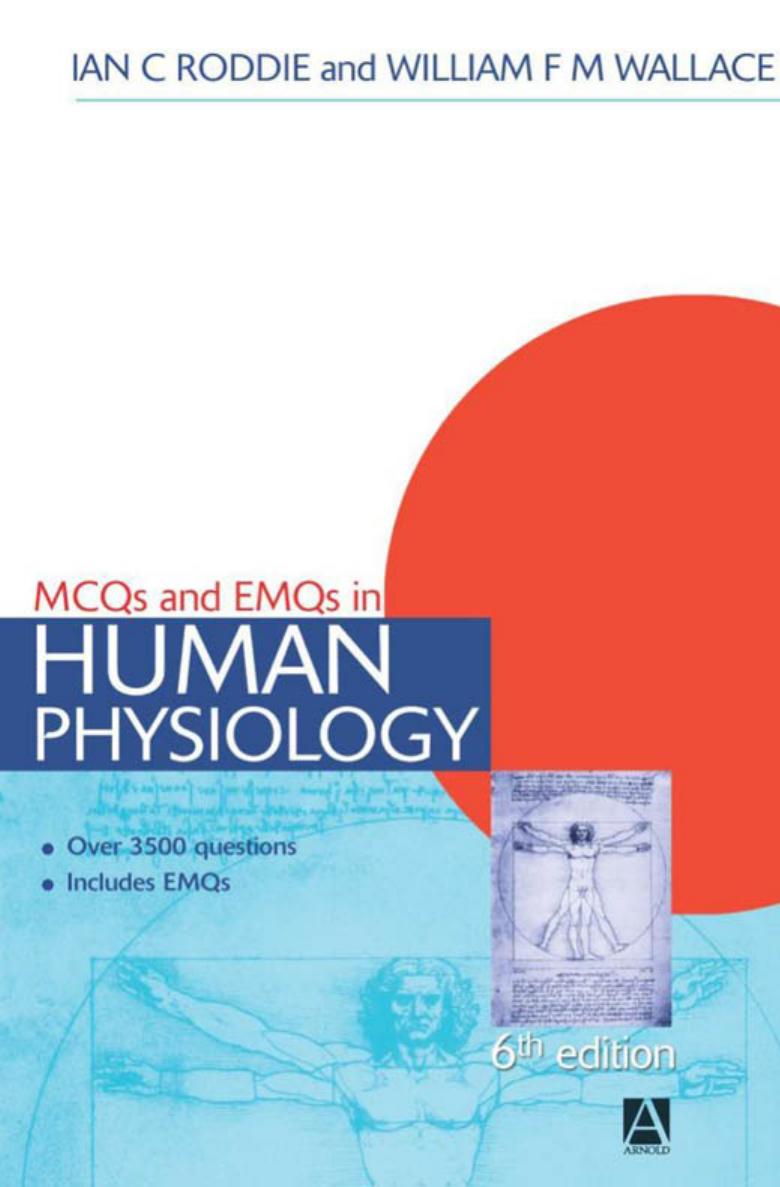

MCQs and EMQs in
HUMAN
PHYSIOLOGY
6
th
edition

This page intentionally left blank
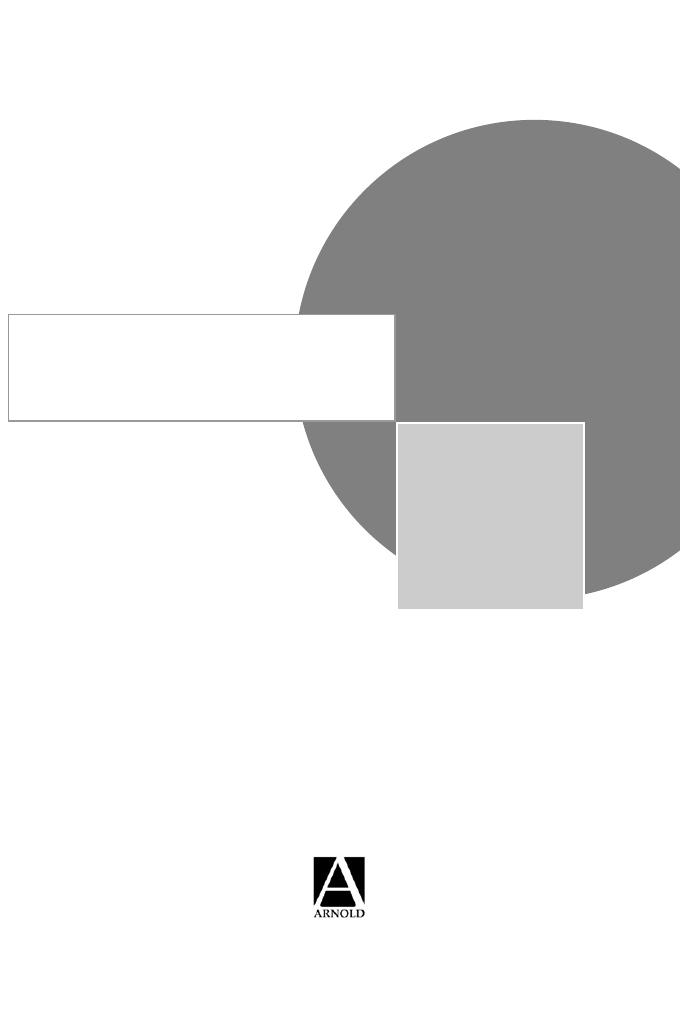
MCQs and EMQs in
HUMAN
PHYSIOLOGY
Ian C Roddie
CBE, DSc, MD, FRCPI
Emeritus Professor of Physiology, The Queen's University of Belfast; former
Head of Medical Education, National Guard King Khalid Hospital, Jeddah,
Saudi Arabia
William FM Wallace
BSc, MD, FRCP, FRCA, FCARCSI, FRCSEd
Emeritus Professor of Applied Physiology, The Queen’s University of Belfast;
former Consultant in Physiology, Belfast City Hospital, Belfast, N. Ireland
A member of the Hodder Headline Group
LONDON
6
th
edition
with answers and
explanatory comments

First published in Great Britain in 1971
Second edition 1977
Third edition 1984
Fourth edition 1994
Fifth edition 1997
This sixth edition published in 2004 by
Arnold, a member of the Hodder Headline Group,
338 Euston Road, London NW1 3BH
http://www.arnoldpublishers.com
Distributed in the United States of America by
Oxford University Press Inc.,
198 Madison Avenue, New York, NY10016
Oxford is a registered trademark of Oxford University Press
© 2004 Ian C. Roddie and William F.M. Wallace
All rights reserved. No part of this publication may be reproduced or
transmitted in any form or by any means, electronically or mechanically,
including photocopying, recording or any information storage or retrieval
system, without either prior permission in writing from the publisher or a
licence permitting restricted copying. In the United Kingdom such licences
are issued by the Copyright Licensing Agency: 90 Tottenham Court Road,
London W1T 4LP.
Whilst the advice and information in this book are believed to be true and
accurate at the date of going to press, neither the author[s] nor the publisher
can accept any legal responsibility or liability for any errors or omissions
that may be made. In particular (but without limiting the generality of the
preceding disclaimer) every effort has been made to check drug dosages;
however it is still possible that errors have been missed. Furthermore,
dosage schedules are constantly being revised and new side-effects
recognized. For these reasons the reader is strongly urged to consult the
drug companies’ printed instructions before administering any of the drugs
recommended in this book.
British Library Cataloguing in Publication Data
A catalogue record for this book is available from the British Library
Library of Congress Cataloging-in-Publication Data
A catalog record for this book is available from the Library of Congress
ISBN 0 340 811919
1 2 3 4 5 6 7 8 9 10
Commissioning Editor: Georgina Bentliff
Project Editor: Heather Smith
Production Controller: Jane Lawrence
Cover Design: Amina Dudhia
Index: Dr Laurence Errington
Typeset in 9pt Rotis Serif by Servis Filmsetting Ltd, Manchester
Printed and bound in Malta
What do you think about this book? Or any other Arnold title?
Please send your comments to feedback.arnold@hodder.co.uk

This book has now reached its sixth edition since it was first published over 30 years ago. Our
aim to base the questions on generally accepted aspects of physiology most relevant to clini-
cal practice seems to have been fulfilled – medical, dental and other health care students and
doctors in specialty training in countries around the world have told us of the book’s relevance
and usefulness.
We have tried to cover most of the concepts and knowledge typically asked for in physiol-
ogy examinations and to concentrate on the core knowledge that is essential to pass them. We
believe that students who score consistently well in these questions know enough to face most
examinations in physiology with confidence. By concentrating on the area where yes/no
answers can be given to questions with reasonable certainty, we have had to exclude areas
where knowledge is as yet conjectural and speculative. We have tried to avoid excessive detail
in the way of facts and figures; those which are included are of value in medical practice. Both
conventional and SI units are generally quoted. Comments on the answers are given on the
reverse of each question. We hope that, with the comments, the book will provide a compact
revision tutor, encouraging understanding rather than rote learning.
For most questions the common five-branch MCQ format has been used. The stem and a
single branch constitute a statement to be judged True or False by the reader. Care has been
taken that the statements in any question are not mutually exclusive, so five independent deci-
sions are required to answer each question. This system has the advantage of simplicity and
brevity over most other forms of multiple-choice question. In this edition, a further opportu-
nity has been taken to prune and edit questions for greater compactness, clarity and precision
and to bring in new areas of knowledge which have emerged since the last edition went to
press. We have also tended to expand the comments in an effort to increase the clarity of our
explanations and so add to the educational value of the self-assessment exercise.
The book is divided into sections, each section containing questions related to one of the
main physiological systems of the body. They cover both basic and applied aspects of the sub-
ject. The applied questions are designed so that the answers may be deduced mainly by making
use of basic physiological knowledge and should provide a link with clinical practice. There is
also a section on sports and exercise physiology and one containing ‘Interpretative’ questions
to provide practice in the interpretation of data, diagrams and figures. A new feature in this
edition is the addition of a number of Extended Matching Questions (EMQs) for each section of
the book. EMQs are an alternative form of multiple-choice question where answers have to be
selected from lists of options. They are becoming increasingly popular in undergraduate and
postgraduate examinations.
We thank colleagues for suggesting questions and all who commented on previous editions.
We continue to welcome such comments.
ICR
WFMW
September 2003

1. A stimulus to fill gaps in your knowledge
This book is intended as a revision tutor and should help you to revise your physiology in prep-
aration for examinations. It is particularly aimed at helping you to identify areas where your
knowledge and understanding need to be improved. The statements in this book are presented
so that you can commit yourself in written opinion and can then confirm correct information
and identify errors. The comments should reinforce your knowledge when you are correct and
indicate why you were mistaken if your answer is wrong.
2. Scoring your answers – multiple choice questions
A
Answer, say, 20 questions (100 decisions), aiming to complete them in about 50 minutes.
In our experience of this type of question (one point tested in each Part), it is best for can-
didates to answer virtually all questions.
B
Score your answers by giving
⫹1 for a correct response, ⫺1 for an incorrect response and
0 for any omitted. It is suggested that this approach is in line with professional life when
many true/false decisions must be taken – send the patient to hospital? Begin a certain
treatment? Carry out surgery urgently? The penalties for a wrong decision can be consid-
erable!
C
As a very approximate guide, the following scale would apply to candidates who have not
spent time memorizing particular questions:
50–60
fair
60–70
good
70–90
excellent
90–100
outstanding
3. Scoring your answers – extended matching questions
For these questions it is usual not to subtract marks for wrong answers, since the chance of
randomly getting the correct answer is much less than for multiple-choice questions, where it
is 50%. The same stratification of results (above) can then be applied.
4. Range of options
Please note for the MCQs that all, some, or none of the branches in each question may be true.
Also, for the EMQs a given option may be used more than once, or not at all.

This page intentionally left blank

1. Extracellular fluid in adults differs from intracellular fluid in that its
A.
Volume is greater.
B.
Tonicity is lower.
C.
Anions are mainly inorganic.
D.
Sodium:potassium molar ratio is higher.
E.
pH is lower.
2. Blood group antigens (agglutinogens) are
A.
Carried on the haemoglobin molecule.
B.
Beta globulins.
C.
Equally immunogenic.
D.
Not present in fetal blood.
E.
Inherited as recessive Mendelian characteristics.
3. Total body water, expressed as a percentage of body weight
A.
Can be measured with an indicator dilution technique using deuterium oxide.
B.
Is smaller on average in women than in men.
C.
Rises following injection of posterior pituitary extracts.
D.
Falls during starvation.
E.
Is less than 80 per cent in young adults.
4. Breakdown of erythrocytes in the body
A.
Occurs when they are 6–8 weeks old.
B.
Takes place in the reticulo-endothelial system.
C.
Yields iron, most of which is excreted in the urine.
D.
Yields bilirubin which is carried by plasma protein to the liver.
E.
Is required for the synthesis of bile salts.
5. A person with group A blood
A.
Has anti-B antibody in the plasma.
B.
May have the genotype AB.
C.
May have a parent with group O blood.
D.
May have children with group A or group O blood only.
E.
Whose partner is also A can only have children of groups A or O.
6. Blood platelets assist in arresting bleeding by
A.
Releasing factors promoting blood clotting.
B.
Adhering together to form plugs when exposed to collagen.
C.
Liberating high concentrations of calcium.
D.
Releasing factors causing vasoconstriction.
E.
Inhibiting fibrinolysis by blocking the conversion of plasminogen to plasmin.
7. Plasma bilirubin
A.
Is a steroid pigment.
B.
Is converted to biliverdin in the liver.
C.
Does not normally cross cerebral capillary walls.
D.
Is freely filtered in the renal glomerulus.
E.
Is sensitive to light.
MCQ
1
1

2
Body fluids – answers
Answers
1.
A.
False
Cells contain half to two-thirds of the total body fluid.
B.
False
It is the same; if it were lower, osmosis would draw water into the cells.
C.
True
Mainly Cl
⫺
and HCO
3
⫺
; inside, the main anions are protein and organic phos-
phates.
D.
True
Around 30:1; the intracellular ratio is about 1:10.
E.
False
Intracellular pH is lower due to cellular metabolism.
2.
A.
False
They are part of the red cell membrane.
B.
False
They are glycoproteins.
C.
False
A, B and D antigens are more immunogenic than the others.
D.
False
Fetal blood may elicit immune responses if it enters the maternal circulation.
E.
False
They are Mendelian dominants.
3.
A.
True
D
2
O (heavy water) exchanges with water in all body fluid compartments.
B.
True
Women carry relatively more fat than men and fat has a low water content.
C.
True
ADH in the extracts inhibits water excretion by the kidneys.
D.
False
It rises as fat stores are metabolized to provide energy.
E.
True
70 per cent, the percentage in the lean body mass, is about the maximum per cent
possible.
4.
A.
False
The normal erythrocyte lifespan is 16–18 weeks.
B.
True
The RES removes effete RBCs from the circulation.
C.
False
Most of the iron is retained for further use.
D.
True
The protein makes the bilirubin relatively water-soluble.
E.
False
Bile salts are synthesized from sterols in the liver.
5.
A.
True
This appears about the time of birth.
B.
False
This would make them blood group AB.
C.
True
They could inherit an A gene from the other parent to give genotype AO.
D.
False
B or AB are possible depending on the partner’s genes.
E.
True
In this case, neither parent has the B gene.
6.
A.
True
e.g. Thromboplastin, part of the intrinsic pathway.
B.
True
Vascular leaks are sealed by such platelet plugs.
C.
False
High Ca
2
⫹
levels are not needed for haemostasis; normal levels are adequate.
D.
True
e.g. Serotonin (5-hydroxytryptamine).
E.
False
Serotonin from platelets can release vascular plasminogen activators.
7.
A.
False
It is a porphyrin pigment derived from haem.
B.
False
Bilirubin is derived from biliverdin formed from haem, not the other way about.
C.
True
The ‘blood–brain barrier’ normally prevents bilirubin entering brain tissue.
D.
False
The bilirubin–protein complex is too large to pass the glomerular filter.
E.
True
Light converts bilirubin to lumirubin which is excreted more rapidly; photo-
therapy may be used in the treatment of haemolytic jaundice in children.
MCQ

Body fluids – questions
3
Questions 8–13
8. Monocytes
A.
Originate from precursor cells in lymph nodes.
B.
Can increase in number when their parent cells are stimulated by factors released from
activated lymphocytes.
C.
Unlike granulocytes, do not migrate across capillary walls.
D.
Can transform into large multinucleated cells in certain chronic infections.
E.
Manufacture immunoglobulin M.
9. Erythrocytes
A.
Are responsible for the major part of blood viscosity.
B.
Contain the enzyme carbonic anhydrase.
C.
Metabolize glucose to produce CO
2
and H
2
O.
D.
Swell to bursting point when suspended in 0.9 per cent (150 mmol/litre) saline.
E.
Have rigid walls.
10. Human plasma albumin
A.
Contributes more to plasma colloid osmotic pressure than globulin.
B.
Filters freely at the renal glomerulus.
C.
Is negatively charged at the normal pH of blood.
D.
Carries carbon dioxide in blood.
E.
Lacks the essential amino acids.
11. Neutrophil granulocytes
A.
Are the most common leukocyte in normal blood.
B.
Contain proteolytic enzymes.
C.
Have a lifespan in the circulation of 3–4 weeks.
D.
Contain actin and myosin microfilaments.
E.
Are present in high concentration in pus.
12. Bleeding from a small cut in the skin
A.
Is normally diminished by local vascular spasm.
B.
Ceases within about five minutes in normal people.
C.
Is prolonged in severe factor VIII (antihaemophilic globulin) deficiency.
D.
Is greater from warm skin than from cold skin.
E.
Is reduced if the affected limb is elevated.
13. Antibodies
A.
Are protein molecules.
B.
Are absent from the blood in early fetal life.
C.
Are produced at a greater rate after a first, than after a second, exposure to an antigen
six weeks later.
D.
Circulating as free immunoglobulins are produced by B lymphocytes.
E.
With a 1 in 8 titre are more concentrated than ones with a 1 in 4 titre.
MCQ

4
Body fluids – answers
Answers
8.
A.
False
They originate from stem cells in bone marrow.
B.
True
Activated T cells release GMCSF (granulocyte/macrophage colony stimulating
factor) which stimulates monocyte stem cells to proliferate.
C.
False
After 4–6 days in the circulation, monocytes migrate out to become tissue macro-
phages.
D.
True
The ‘giant cells’ seen in tissues affected by tuberculosis and leprosy.
E.
False
Immunoglobulins are made by ribosomes in lymphocytes.
9.
A.
True
Blood viscosity rises exponentially with the haematocrit.
B.
True
It catalyses the reaction CO
2
⫹H
2
O
⫽H
⫹
⫹HCO
3
⫺
.
C.
True
Glycolysis generates the energy needed to maintain electrochemical gradients
across their membranes.
D.
False
This is isotonic with their contents.
E.
False
The walls deform easily to squeeze through capillaries.
10.
A.
True
Its greater mass and lower molecular weight provide more osmotically active par-
ticles.
B.
False
Only a small amount is filtered normally and this is reabsorbed by the tubules.
C.
True
Blood pH is well above albumin’s isoelectric point so negative charges (COO
⫺
)
predominate.
D.
True
As carbamino protein (R-NH
2
⫹CO
2
⫽R-NH COOH).
E.
False
It is a first class protein containing essential and non-essential amino acids.
11.
A.
True
They comprise 60–70 per cent of circulating leukocytes.
B.
True
Their granules contain such enzymes, which, with toxic oxygen metabolites, can
kill and digest the bacteria they engulf.
C.
False
Less than a day.
D.
True
Responsible for their amoeboid motility.
E.
True
Pus consists largely of dead neutrophils.
12.
A.
True
Due to the effects of tissue damage and serotonin on vascular smooth muscle.
B.
True
This is the upper limit of the normal ‘bleeding time’.
C.
False
Factor VIII increases clotting time, not bleeding time.
D.
True
Warmth dilates skin blood vessels.
E.
True
Intravascular pressure is reduced in an elevated limb.
13.
A.
True
They are made by ribosomes in plasma cells.
B.
True
Immunological tolerance prevents the fetus forming antibodies to its own pro-
teins.
C.
False
The response to the second exposure is greater since the immune system has been
sensitized by the first exposure.
D.
True
T lymphocytes are responsible for cell-mediated immunity.
E.
True
Antibody with a 1 in 8 titre is detected at greater dilution than one with a 1 in 4
titre.
MCQ

Body fluids – questions
5
Questions 14–19
14. Circulating red blood cells
A.
Are about 1 per cent nucleated.
B.
May show an intracellular network pattern if appropriately stained.
C.
Are distributed evenly across the blood stream in large blood vessels.
D.
Travel at slower velocity in venules than in capillaries.
E.
Deform as they pass through the capillaries.
15. Lymphocytes
A.
Constitute 1–2 per cent of circulating white cells.
B.
Are motile.
C.
Can transform into plasma cells.
D.
Decrease in number following removal of the adult thymus gland.
E.
Decrease in number during immunosuppressive drug therapy.
16. The specific gravity (relative density) of
A.
Red cells is less than that of plasma.
B.
Plasma is due more to its protein than to its electrolyte content.
C.
Plasma decreases as extracellular fluid and electrolytes are lost.
D.
Blood is higher on average in women than in men.
E.
Urine can fall below 1.000 in a water diuresis
17. Blood
A.
Makes up about 7 per cent of body weight.
B.
Forms a higher percentage of body weight in fat than in thin people.
C.
Volume can be calculated by multiplying plasma volume by the haematocrit (expressed
as a percentage).
D.
Volume rises after water is drunk.
E.
Expresses serum when it clots.
18. The cell membranes in skeletal muscle
A.
Are impermeable to fat-soluble substances.
B.
Are more permeable to sodium than to potassium ions.
C.
Become more permeable to glucose in the presence of insulin.
D.
Become less permeable to potassium in the presence of insulin.
E.
Show invaginations which connect to a system of intracellular tubules involved in exci-
tation contraction coupling.
19. The osmolality of
A.
A solution determines its freezing point.
B.
Intracellular fluid is about twice that of extracellular fluid.
C.
1.8 per cent sodium chloride is about twice that of normal plasma.
D.
5 per cent dextrose solution is about five times that of 0.9 per cent saline.
E.
Plasma is due more to its protein than to its electrolyte content.
MCQ

6
Body fluids – answers
Answers
14.
A.
False
Nucleated red cells are not normally seen in peripheral blood.
B.
True
Reticulocytes, the most immature circulating RBCs, show this pattern when
stained with certain dyes.
C.
False
They form an axial stream away from the vessel wall.
D.
False
The capillary bed has a greater total cross-sectional area than the venular bed.
E.
True
Normal cells, around 7 microns in diameter, become bullet-shaped as they pass
through 5 micron diameter capillaries.
15.
A.
False
About 20 per cent of leukocytes are lymphocytes.
B.
True
They migrate by amoeboid movement to areas of chronic inflammation.
C.
True
As plasma cells they manufacture humoral antibodies.
D.
False
The thymus is atrophied and has little function in the adult.
E.
True
Lymphocytes and immune responses are closely linked.
16.
A.
False
Red cells are heavier and hence sediment on standing.
B.
True
The mass of plasma proteins (70–80 grams/litre) far exceeds that of plasma elec-
trolytes (about 10 grams/litre).
C.
False
It increases; plasma specific gravity is an index of ECF volume if protein levels
are normal.
D.
False
It is higher in men, who have a higher haematocrit.
E.
False
The specific gravity of pure water is 1.000; urine is water plus solutes.
17.
A.
True
For example, 5 kg (about 5 litres) in a 70 kg man.
B.
False
Since fat tissue is relatively avascular, the reverse is true.
C.
False
It can be calculated by multiplying plasma volume by 1/1 minus haematocrit
(expressed as a decimal).
D.
True
The water is absorbed into the blood.
E.
True
Serum is plasma minus its clotting factors.
18.
A.
False
The membrane consists largely of lipid.
B.
False
The reverse is true; sodium ions, being more hydrated than potassium ions, are
larger complexes.
C.
True
Thus glucose is stored as muscle glycogen after a meal.
D.
False
They become more permeable; injections of insulin and glucose lower the serum
potassium level.
E.
True
These are called the T system of tubules.
19.
A.
True
Depression of the freezing point is an index of a solution’s osmolality.
B.
False
Their osmolality is the same; osmotic water movements ensure that this is so.
C.
True
Plasma has the tonicity of a normal saline solution (0.9 per cent sodium chloride).
D.
False
They have the same number of particles.
E.
False
Proteins account for only 1 per cent of plasma osmolality.
MCQ

Body fluids – questions
7
Questions 20-25
20. The pH
A.
Of arterial blood normally ranges from 7.2 to 7.6.
B.
Units express [H
⫹
] in moles/litre.
C.
Of blood is directly proportional to the P
CO
2
.
D.
Of blood is directly proportional to [HCO
3
⫺
].
E.
Of urine is usually less than 7.
21. Cerebrospinal fluid
A.
Is an ultrafiltrate of plasma.
B.
Is the main source of the brain’s nutrition.
C.
Has the same pH as arterial blood.
D.
Has a higher glucose concentration than has plasma.
E.
Has a higher calcium concentration than has plasma.
22. Antigens
A.
Are usually proteins or polypeptide molecules.
B.
Can only be recognized by immune system cells previously exposed to that antigen.
C.
Are normally absorbed from the gut via lymphatics and carried to mesenteric lymph
nodes.
D.
Induce a smaller immune response when protein synthesis is suppressed.
E.
Are taken up by antigen-presenting macrophages which activate the immune system.
23. Blood eosinophils
A.
Have agranular cytoplasm.
B.
Are about a quarter of all leukocytes.
C.
Are relatively abundant in the mucosa of the respiratory, urinary and alimentary tracts.
D.
Release cytokines.
E.
Increase in number in viral infections.
24. Normal blood clotting requires
A.
Inactivation of heparin.
B.
Inactivation of plasmin (fibrinolysin).
C.
Calcium ions.
D.
An adequate intake of vitamin K.
E.
An adequate intake of vitamin C.
25. Antibodies (agglutinins) of the A and B red cell antigens (agglutinogens)
A.
Are present in fetal plasma.
B.
Cause haemolysis of RBCs containing the A and B antigens when added to a suspension
of red cells in saline.
C.
Do not normally cross the placental barrier.
D.
Have a molecular weight in excess of 500 000.
E.
Are monovalent.
MCQ

8
Body fluids – answers
Answers
20.
A.
False
The range is normally between 7.35 and 7.45.
B.
False
They express it as the negative logarithm of the [H
⫹
] in moles/litre.
C.
False
P
CO
2
raises [H
⫹
] and hence lowers pH.
D.
True
[HCO
3
⫺
] lowers [H
⫹
] by buffering and hence raises pH.
E.
True
The normal diet leaves acidic, rather than alkaline, residues.
21.
A.
False
It is secreted actively by the choroid plexuses.
B.
False
Brain nutrition is delivered mainly by cerebral blood flow.
C.
False
It is around 7.3 compared with 7.4 in blood.
D.
False
It is about two-thirds that of plasma.
E.
False
About half; protein-bound calcium is negligible in CSF.
22.
A.
True
Large carbohydrate molecules may also be antigenic.
B.
False
The ability to recognize foreign antigens is innate and does not depend on pre-
vious exposure to them.
C.
False
Antigens, being proteins or carbohydrates, are not normally absorbed; they are
digested in the gut.
D.
True
Antibodies are proteins synthesized by ribosomes in activated lymphocytes.
E.
True
Antigens can also act directly on receptors on lymphocyte membranes.
23.
A.
False
They have eosinophilic granules (eosinophilic granulocytes).
B.
False
Only 1–4 per cent of white cells are eosinophils.
C.
True
They are involved in mucosal immunity.
D.
True
Interleukin 4 and platelet activating factor (PAF).
E.
False
Their number increases in parasitic infections and allergic conditions.
24.
A.
False
The anticoagulant effects of heparin are overwhelmed.
B.
False
Blood clots in spite of the fibrinolytic system.
C.
True
Removal of calcium ions prevents clotting.
D.
True
Vitamin K is needed by the liver for synthesis of prothrombin and other factors.
E.
False
The spontaneous bleeding from the gums etc. seen in scurvy is due to capillary
abnormality, not a clotting defect.
25.
A.
False
They form shortly after birth, possibly in response to A and B antigens carried
into the body by invading bacteria.
B.
False
They cause agglutination (clumping) of A, B and AB cells.
C.
True
Unlike Rh antibodies which have a smaller molecular size.
D.
True
Around 1 000 000.
E.
False
They are divalent and hence cause red cells to adhere to one another during
agglutination.
MCQ

Body fluids – questions
9
Questions 26-31
26. Lymph
A.
Contains plasma proteins.
B.
Vessels are involved in the absorption of amino acids from the intestine.
C.
Production increases during muscular activity.
D.
Does not normally contain cells.
E.
Flow is aided by contraction of adjacent skeletal muscles.
27. Blood platelets
A.
Are formed in the bone marrow.
B.
Are normally more numerous than white cells.
C.
Have a small single-lobed nucleus.
D.
Increase in number after injury and surgery.
E.
Alter shape when in contact with collagen.
28. The conversion of fibrinogen to fibrin
A.
Is effected by prothrombin.
B.
Involves the disruption of certain peptide linkages by a proteolytic enzyme.
C.
Is followed by polymerization of fibrin monomers.
D.
Is inhibited by heparin.
E.
Is reversed by plasmin (fibrinolysin).
29. An appropriate dilution indicator for measuring
A.
Total body water is sucrose.
B.
Plasma volume is radioactive sodium.
C.
Extracellular fluid volume is inulin.
D.
Intracellular fluid volume directly is heavy water (deuterium oxide).
E.
Total body potassium is radioactive potassium.
30. Thirst can be
A.
Produced by a rise in plasma tonicity.
B.
Produced by stimulation of certain areas in the hypothalamus.
C.
Produced by a fall in blood volume.
D.
Associated with decreased secretion of ADH.
E.
Relieved by water intake before the water has been absorbed from the gut.
31. Intravenous infusion of
A.
Two litres of normal saline restores blood volume in a patient who suddenly lost two
litres of blood.
B.
Bicarbonate is appropriate for patients being treated for cardiac and respiratory arrest.
C.
Potassium-free fluids are appropriate for a patient with severe vomiting.
D.
Isotonic glucose will expand both intracellular and extracellular fluid compartments.
E.
Hypertonic saline will raise intracellular osmolality.
MCQ

10
Body fluids – answers
Answers
26.
A.
True
Derived from plasma proteins leaked from capillaries into the tissues; it returns
these to the blood.
B.
False
Lymph vessels are involved in the uptake and transport of absorbed fat.
C.
True
Increased capillary pressure due to muscle vasodilatation increases tissue fluid
formation.
D.
False
It contains lymphocytes derived from lymph nodes.
E.
True
In addition, intrinsic rhythmic contractions in lymphatics help to propel lymph.
27.
A.
True
They are formed from megalokaryocytes.
B.
True
By a factor of 20 or more.
C.
False
No nucleus – but the cytoplasm contains electron dense granules, lysosomes and
mitochondria.
D.
True
This increases the tendency of blood to clot.
E.
True
They put out pseudopodia and adhere to the collagen and to one another.
28.
A.
False
It is effected by thrombin; prothrombin is the inactive precursor of thrombin.
B.
True
Thrombin breaks off the solubilizing end groups.
C.
True
Polymerized fibrin monomers form the strands of the clot meshwork.
D.
True
This is a rapidly acting anticoagulant.
E.
False
Plasmin does not convert fibrin back to fibrinogen, it degrades both fibrin and
fibrinogen to products which can inhibit thrombin.
29.
A.
False
Sucrose does not cross the cell membrane freely to equilibrate with ICF.
B.
False
Sodium ions migrate easily from plasma to equilibrate with interstitial fluid.
C.
True
Inulin crosses capillary walls freely but does not enter cells.
D.
False
ICF volume is not measured directly; it is calculated by measuring ECF volume
and total body water and subtracting the former from the latter.
E.
True
Radioactive K
⫹
equilibrates with the body pool of non-radioactive K
⫹
; both iso-
topes are treated similarly in the body.
30.
A.
True
Stimulation of osmoreceptors by the increased tonicity generates thirst sensation.
B.
True
The supraoptic nucleus of the hypothalamus contains osmoreceptors.
C.
True
This can happen, even though blood tonicity is unchanged; volume receptors
may be involved.
D.
False
ADH secretion is increased.
E.
True
Flushing out the mouth with water can provide temporary relief from thirst.
31.
A.
False
Some of the saline escapes from the circulation to the interstitial fluid.
B.
True
It corrects the acidosis caused by accumulation of lactic acid and CO
2
in the tis-
sues.
C.
False
Alimentary secretions are rich in potassium.
D.
True
Glucose is metabolized, leaving the water to be distributed in both compartments.
E.
True
Hypertonic extracellular fluid will draw water osmotically from the cells.
MCQ

Body fluids – questions
11
Questions 32–37
32. Excessive tissue fluid (oedema) in the legs may
A.
Be associated with a raised extracellular fluid volume.
B.
Result from hepatic disease.
C.
Result from blockage of pelvic lymphatics.
D.
Increase local interstitial fluid pressure.
E.
Result from a high arterial blood pressure in the absence of heart failure.
33. Haemolytic disease of the newborn
A.
Affects mainly babies of Rh-positive mothers.
B.
Occurs mainly in babies who lack D agglutinogen.
C.
Causes jaundice which clears rapidly after birth.
D.
Can be treated by transfusing the affected baby with Rh-positive blood.
E.
Can be prevented by injecting the mother with anti-D agglutinins just after delivery.
34. The appearance of centrifuged blood may suggest that
A.
Anaemia is present if there is more plasma than packed cells.
B.
The plasma lipid level is high.
C.
The patient has jaundice.
D.
Haemolysis has occurred.
E.
The patient has leukaemia.
35. Patients with moderate to severe anaemia have a reduced
A.
Cardiac output.
B.
Incidence of vascular bruits.
C.
2:3-diphosphoglycerate blood level.
D.
Arterial P
O2
.
E.
Capacity to raise oxygen consumption in exercise.
36. Iron deficiency
A.
Frequently follows persistent loss of blood from the body.
B.
Is more common in men than in women.
C.
May cause anaemia by inhibiting the rate of multiplication of RBC stem cells.
D.
May cause large pale erythrocytes to appear in peripheral blood.
E.
Anaemia should normally be treated by injections of iron
37. Severe reactions are likely after transfusion of blood group
A.
A to a group B person.
B.
O to a group AB person.
C.
A to a group O person.
D.
A to a group AB person.
E.
O Rh- negative to a group AB Rh-positive person.
MCQ

12
Body fluids – answers
Answers
32.
A.
True
Oedema is an increase in the interstitial component of ECF.
B.
True
Albumin deficiency reduces plasma colloid osmotic pressure.
C.
True
Protein accumulates in interstitial fluid and reduces the colloid osmotic pressure
gradient across the capillary wall.
D.
True
This contributes to a new pressure equilibrium.
E.
False
Arteriolar constriction in hypertension raises arterial, but not capillary, pressure.
33.
A.
False
It affects babies of Rh-negative mothers when the child’s red cell membranes
carry the D antigen.
B.
False
It occurs in Rh-positive babies.
C.
False
The jaundice deepens rapidly after birth as bilirubin is no longer excreted by the
maternal liver.
D.
False
This would be attacked by maternal Rh antibodies in the infant’s blood; Rh-
negative blood is given.
E.
True
These destroy fetal Rh-positive cells in the maternal circulation before such cells
can sensitize her to D antigen.
34.
A.
False
If the normal percentage of plasma in centrifuged blood is about 55 per cent.
B.
True
If the plasma is cloudy or even milky.
C.
True
If the plasma is yellow.
D.
True
If the plasma is red.
E.
True
If the buffy coat is greatly thickened.
35.
A.
False
Output rises to compensate for the blood’s reduced O
2
carrying capacity.
B.
False
Bruits are common since increased flow velocity and decreased blood viscosity
increase the likelihood of turbulent flow.
C.
False
2:3-DPG is increased, shifting the dissociation curve to the right so that blood
gives up its oxygen more easily.
D.
False
Arterial P
O2
is normal; it is O
2
content which is reduced.
E.
True
Due to the reduced capacity to deliver O
2
to the muscles.
36.
A.
True
Especially if dietary intake of iron is limited.
B.
False
It is more common in women due to menstrual blood loss.
C.
False
It causes anaemia by limiting the rate of haemoglobin synthesis.
D.
False
In iron deficiency anaemia, RBCs are small and pale due to lack of haemoglobin.
E.
False
Oral iron is avidly absorbed in iron deficiency states.
37.
A.
True
The recipients have anti-A antibody.
B.
False
Group O people are ‘universal donors’.
C.
True
The recipients have anti-A antibody.
D.
False
Group AB persons, ‘universal recipients’, lack anti-A and anti-B antibodies.
E.
False
The recipients lack anti-A, anti-B and anti-Rh antibodies.
MCQ

Body fluids – questions
13
Questions 38–43
38. The haematocrit (packed cell volume)
A.
May be obtained by centrifugation of blood.
B.
May be calculated by multiplying the mean cell volume by the red cell count.
C.
Rises in a patient who sustains widespread burns.
D.
Rises following injections of aldosterone.
E.
Rises in macrocytic megaloblastic anaemias such as pernicious (B
12
deficiency) anaemia.
39. Red cell formation is increased
A.
By giving vitamin B
12
injections to healthy people on a normal diet.
B.
In blood donors one week after a blood donation.
C.
In patients with haemolytic anaemia.
D.
By giving injections of erythropoietin to nephrectomized patients.
E.
In patients who have a raised blood reticulocyte count.
40. Vitamin B
12
deficiency may
A.
Result from disease of the terminal part of the ileum.
B.
Result in anaemia with small RBCs well filled with haemoglobin.
C.
Cause wasting (atrophy) of the gastric mucosa.
D.
Cause a reduction in the circulating platelet level.
E.
Cause pathological changes in the central nervous system.
41. A raised blood pH and bicarbonate level is consistent with
A.
Metabolic acidosis.
B.
Partly compensated respiratory alkalosis.
C.
A reduced P
CO
2
.
D.
Chronic renal failure with a raised P
CO
2
.
E.
A history of persistent vomiting of gastric contents.
42. A patient with partly compensated respiratory acidosis
A.
Must have a raised P
CO
2
.
B.
May have a reduced hydrogen ion concentration [H
⫹
].
C.
Must have a raised bicarbonate concentration [HCO
3
⫺
].
D.
May have evidence of renal compensation.
E.
May have respiratory failure due to hypoventilation
43. A patient with an uncompensated respiratory alkalosis may have
A.
Been exposed to living at high altitudes.
B.
A reduced [H
2
CO
3
]:[HCO
3
⫺
] ratio.
C.
Neuromuscular hyperexcitability.
D.
An arterial pH of 7.3.
E.
A blood [H
⫹
] of 30 nmol/litre.
MCQ

14
Body fluids – answers
Answers
38.
A.
True
Since red cells are heavier than plasma.
B.
True
This gives a slightly lower value than centrifugation which traps a little plasma
between cells.
C.
True
Due to loss of plasma and interstitial fluid.
D.
False
It falls as extracellular fluid and hence plasma volume increases.
E.
False
Though individual RBCs are large, total red cell mass is decreased.
39.
A.
False
Healthy normal people do not benefit from vitamin B
12
supplements.
B.
True
The RBC deficit is corrected by bone marrow stimulation by erythropoietin.
C.
True
The reduced oxygen carrying capacity of the blood causes release of erythropoie-
tin which stimulates RBC stem cells in the bone marrow.
D.
True
The anaemia seen in nephrectomized patients is due largely to lack of erythro-
poietin.
E.
True
A raised reticulocyte count is evidence of a hyperactive bone marrow.
40.
A.
True
The B
12
/intrinsic factor complex is absorbed in the terminal ileum.
B.
False
Lack of B
12
results in a macrocytic hyperchromic anaemia.
C.
False
Gastric mucosa atrophy is a cause, not an effect, of B
12
lack; gastric mucosa nor-
mally produces the ‘intrinsic factor’ required for B
12
absorption.
D.
True
B
12
is used in the DNA synthesis required by platelet precursor cells.
E.
True
Maintenance of myelin in neural sheaths also depends on vitamin B
12
.
41.
A.
False
It is consistent with a metabolic alkalosis.
B.
False
A partly compensated acidosis has a low pH.
C.
False
P
CO
2
is normally raised in metabolic alkalosis as a compensatory mechanism.
D.
False
All these values are reduced in chronic renal failure.
E.
True
Pyloric obstruction causes a metabolic alkalosis.
42.
A.
True
This is the hallmark of a respiratory acidosis.
B.
False
[H
⫹
] is raised in uncompensated acidosis.
C.
True
The raised [HCO
3
⫺
] is compensating partly for the raised P
CO
2
.
D.
True
The raised [HCO
3
⫺
], compensating the raised P
CO
2
is generated by the kidneys.
E.
True
This leads to retention of carbon dioxide.
43.
A.
False
Living at high altitudes induces partial compensation, i.e. fall in [HCO
3
⫺
]
B.
True
This is consistent with alkalosis.
C.
True
Alkalosis favours the development of tetany by increasing the binding power of
plasma protein for ionic calcium.
D.
False
This is an acidotic pH.
E.
True
The normal level is 40 nmol/litre.
MCQ

Body fluids – questions
15
Questions 44–49
44. In investigating a patient’s acid-base status
A.
Venous rather than arterial blood should be studied.
B.
Blood samples may be stored for up to 12 hours at room temperature before analysis.
C.
pH can be calculated if [HCO
3
⫺
] and P
CO
2
are known.
D.
Raised urinary ammonium salts suggest renal compensation for respiratory acidosis.
E.
An early fall in [HCO
3
⫺
] suggests that the acid-base disturbance is respiratory in origin.
45. Respiratory alkalosis differs from metabolic alkalosis in that the
A.
Likelihood of tetany is less.
B.
Urine is alkaline.
C.
Arterial blood [HCO
3
⫺
] is normal or low.
D.
Arterial blood P
CO
2
is reduced.
E.
Reduction in cerebral blood flow is greater.
46. Rejection of a transplanted organ is made less likely by
A.
Treatment which reduces the blood lymphocyte count.
B.
Keeping the recipient in a germ-free environment.
C.
Irradiation of the transplanted organ with X-rays.
D.
Drugs which interfere with mitosis.
E.
Transplanting between identical twins.
47. Reduction in the neutrophil granulocyte count may be
A.
Caused by drugs suppressing bone marrow activity.
B.
A consequence of tissue damage.
C.
Associated with painful throat ulcers.
D.
Associated with widespread purulent infections.
E.
Caused by high levels of circulating glucocorticoids
48. A fall in plasma sodium concentration
A.
May result from excessive production of ADH.
B.
Decreases intracellular fluid volume.
C.
May occur in people engaged in hard physical work in humid tropical climates.
D.
Reduces plasma osmolality.
E.
Is likely to cause thirst.
49. Sodium retention
A.
Occurs for several days after major surgery.
B.
Occurs in response to secretion of aldosterone, but not cortisol.
C.
Expands the extracellular fluid volume.
D.
Expands the blood volume.
E.
Increases the severity of oedema.
MCQ

16
Body fluids – answers
Answers
44.
A.
False
Only arterial blood is precisely regulated for [H
⫹
].
B.
False
Analysis should be prompt; acid-base status is affected by blood cell metabolism.
C.
True
pH is a function of their ratio.
D.
True
Ammonia is secreted to buffer the hydrogen ions being excreted as the kidneys
manufacture bicarbonate.
E.
False
A primary respiratory acid–base problem leads initially to an altered P
CO
2
.
45.
A.
False
Both kinds of alkalosis may result in tetany.
B.
False
It is likely to be alkaline in both.
C.
True
[HCO
3
⫺
] is raised in metabolic alkalosis but falls to compensate for the low P
CO
2
in respiratory alkalosis.
D.
True
P
CO
2
is reduced in respiratory alkalosis but rises to compensate for the high
[H
2
CO
3
⫺
] in metabolic alkalosis.
E.
True
The greater fall in P
CO
2
in respiratory alkalosis causes more cerebral vasoconstric-
tion.
46.
A.
True
T lymphocytes are responsible for tissue rejection.
B.
False
This environment may be necessary because of suppression of the recipient’s
immune responses; it has no bearing on the rejection process.
C.
False
This would not affect the transplant antigens.
D.
True
These suppress the multiplication of lymphocytic stem cells.
E.
True
Identical twins have identical antigens and do not reject each other’s tissues.
47.
A.
True
Granulocytes are formed in the bone marrow.
B.
False
Production of neutrophils increases following tissue damage.
C.
True
Neutrophils are not available to kill bacterial invaders.
D.
False
There will not be much pus since pus consists mainly of dead neutrophils.
E.
False
These suppress lymphocytes and eosinophils.
48.
A.
True
Due to excessive reabsorption of water from the collecting ducts of the nephron.
B.
False
Water is drawn into cells from the hypotonic extracellular fluid; water intoxica-
tion may occur.
C.
True
People sweating heavily may replace their water, but not their salt, deficit; they
tend to get muscle cramps unless they supplement their salt intake.
D.
True
Sodium ions are responsible for nearly half of plasma osmolality.
E.
False
The hypothalamic osmoreceptors responsible for thirst respond to hypertonicity,
not hypotonicity of the ECF.
49.
A.
True
This is part of the metabolic response to trauma.
B.
False
Both have mineralocorticoid effects.
C.
True
Sodium chloride is the ‘skeleton’ of the ECF; chloride and water are retained with
the sodium.
D.
True
Plasma is part of extracellular volume.
E.
True
Oedema fluid is excess interstitial fluid.
MCQ

Body fluids – questions
17
Questions 50-55
50. Sodium depletion differs from sodium retention in that it causes a
reduction in
A.
Central venous pressure.
B.
Renin production.
C.
The specific gravity of the blood.
D.
Intracellular fluid volume.
E.
Total body mass.
51. Sodium depletion differs from water depletion in that
A.
Cardiovascular changes are less pronounced.
B.
Intracellular fluid volume is less affected.
C.
The haematocrit increases.
D.
Thirst is more severe.
E.
Antidiuretic hormone levels are higher.
52. Potassium depletion
A.
Can be detected by analysis of a biopsied sample of muscle.
B.
Can result from loss of gastrointestinal secretions.
C.
Causes increased activity of intestinal smooth muscle.
D.
Exacerbates pre-existing acidosis.
E.
Increases T wave amplitude in the electrocardiogram.
53. A high blood potassium level (hyperkalaemia)
A.
Occurs in acute renal failure.
B.
Follows severe crush injuries to the limbs.
C.
May diminish cardiac performance and cause death.
D.
Increases skeletal muscle strength.
E.
May be reduced by intravenous infusion of insulin and glucose.
54. Deficiency of factor VIII (antihaemophilic globulin)
A.
Increases the bleeding time.
B.
Is due to an abnormal gene on the Y chromosome.
C.
To 75 per cent of its normal value results in excessive bleeding after tooth extraction.
D.
Causes small (petechial) haemorrhages into the skin to cause purpura.
E.
Affects the extrinsic, rather than the intrinsic, pathway for blood coagulation.
55. A raised level of calcium in the blood (hypercalcaemia)
A.
May occur when parathyroid activity decreases.
B.
May occur when the plasma protein level falls.
C.
May occur in chronic renal failure.
D.
Causes increased excitability of nerve and muscle.
E.
Increases the risk of stone formation in the urinary tract.
MCQ

18
Body fluids – answers
Answers
50.
A.
True
Blood volume parallels body sodium levels; it expands with sodium retention and
shrinks with sodium depletion.
B.
False
A reduced blood volume stimulates release of renin.
C.
False
It is increased in sodium depletion due to an increased haematocrit.
D.
False
If anything, ICF volume expands osmotically in sodium depletion.
E.
True
Due to the loss of extracellular fluid in sodium depletion.
51.
A.
False
Blood volume is more reduced with sodium depletion; cardiovascular changes are
more pronounced.
B.
True
Extracellular volume is a function of body sodium content.
C.
False
It increases in both cases.
D.
False
Hypertonicity is the main stimulus causing thirst.
E.
False
Here also, hypertonicity is the main stimulus for ADH secretion.
52.
A.
True
Since most body potassium is intracellular.
B.
True
Gastrointestinal secretions are rich in potassium.
C.
False
Activity decreases and intestinal paralysis (paralytic ileus) may occur.
D.
False
K
⫹
competes with H
⫹
for excretion in the renal tubules; a low [K
⫹
] favours renal
excretion of H
⫹
ions and this would reduce the severity of acidosis.
E.
False
The amplitude of the T waves decreases.
53.
A.
True
Due to inability to excrete K
⫹
ingested and released from cell breakdown in the
body.
B.
True
Potassium is released from the damaged muscle fibres.
C.
True
Abnormal rhythms and heart failure may result.
D.
False
Both hypo- and hyperkalaemia cause skeletal muscle weakness.
E.
True
This facilitates entry of potassium into cells.
54.
A.
False
Clotting time is increased, but bleeding time is determined by platelets and by
vascular contraction.
B.
False
It is due to a recessive abnormality of the X chromosome.
C.
False
Abnormal bleeding does not occur until the level falls below 50 per cent.
D.
False
Purpura is caused by capillary or platelet disorders.
E.
False
It affects the intrinsic pathway.
55.
A.
False
This reduces blood calcium.
B.
False
This lowers the protein-bound, and hence the total, calcium level.
C.
False
In chronic renal failure PO
4
retention raises blood PO
4
levels; Ca
2
⫹
levels fall to
maintain a constant [Ca
2
⫹
] [PO
4
⫺
] product.
D.
False
It depresses excitability.
E.
True
More calcium is filtered and this increases the urinary [Ca
2
⫹
] [PO
4
⫺
] solubility
product.
MCQ

Body fluids – questions
19
Questions 56-57
56. Intravenous infusion of one litre of
A.
Normal (isotonic) saline increases the ECF more than the ICF volume.
B.
10 per cent dextrose provides sufficient energy for a sedentary adult for one day.
C.
A suspension of lipids provides 2–3 times the energy of a suspension of carbohydrates
with the same concentration.
D.
Isotonic (5 per cent) dextrose raises total body water by 1–5 per cent in the average
adult.
E.
An amino acid solution provides between 3–4 times the energy of a carbohydrate solu-
tion with the same concentration.
57. In patients with the acquired immune deficiency syndrome (AIDS)
A.
Neutrophils are more affected than lymphocytes.
B.
Total white cell count is a better indicator of progression than any subset of white cells.
C.
Host DNA is incorporated into the human immunodeficiency (HIV) virus.
D.
Occurrence in infancy results from transmission of infection rather than inheritance.
E.
There is increased risk of malignant tumours.
MCQ

20
Body fluids – answers
Answers
56.
A.
True
Sodium and chloride remain mainly extracellular.
B.
False
It provides less than a quarter of the daily energy requirement.
C.
True
A gram of fat when oxidized liberates 2–3 times the energy liberated by a gram
of carbohydrate.
D.
True
Total body water (about 40 litres) increases to about 41 litres (2.5 per cent
increase).
E.
False
Amino acids and carbohydrates provide similar energy per unit weight but amino
acids are useful for maintaining body tissue proteins.
57.
A.
False
Lymphocytes are more involved than neutrophils with immunity.
B.
False
The CD4 (or T
4
) count is a major indicator and falls markedly as AIDS progresses.
C.
False
Viral reverse transcriptase incorporates viral RNA into host DNA.
D.
True
In contrast to genetic immune disorders such as X-linked hypogammaglobulinae-
mia.
E.
True
The normal immune system suppresses such tumours.
MCQ

EMQ Question 58
For each case of disordered haemostasis A–E, select the most appropriate option from the fol-
lowing list of findings.
1. Capillary abnormality.
2. Deficiency of factor VIII.
3. Increased fibrinogen level.
4. Deficiency of prothrombin.
5. Deficiency of vitamin K.
6. Excessive heparin activity.
7. Massive blood transfusion.
8. Platelet count 90
⫻10
9
per litre.
9. Platelet count 20
⫻10
9
per litre.
A.
A 15-year-old child is admitted to hospital with recent onset of widespread purpura
(pin-head areas of haemorrhage into the skin). Laboratory investigations reveal an
abnormality which accounts for the bleeding tendency.
B.
A 50-year-old man is receiving anticoagulant therapy (warfarin, a vitamin K antagonist)
after heart valve replacement. He is admitted to hospital with haematuria (blood in the
urine) and his INR (international normalized ratio, a measure of the prothrombin clot-
ting time in relation to the normal time) is found to be 4.2.
C.
A 90-year-old women has blotchy purple areas about 5 cm diameter on her hands and
arms. They are not uncomfortable and she has no health complaints.
D.
A 70-year-old man is operated on for aneurysm (swelling) of his aorta. Severe bleeding
requires infusion of forty units of blood. His recovery is complicated by a bleeding ten-
dency and he is found to have a very low level of fibrinogen. His treatment includes
administration of heparin.
E.
A 10-year-old child with no known medical problems has been admitted to hospital for
persistent bleeding after tooth extraction. Haemostasis had been achieved initially after
the extraction but subsequently prolonged oozing from the tooth socket began.
EMQ
BODY FLUIDS
21
1

22
Body fluids – answers
Answers for 58
A.
Option 9
Platelet count 20
⫻10
9
per litre. Widespread purpura is due to failure of
platelet plugging of capillaries and may be due to a low platelet count or to capillary
abnormality. An abnormal laboratory test to account for this would be a low platelet
count. Although both those given are below normal, only values below 20–40
⫻10
9
per
litre account for serious bleeding.
B.
Option 4
Deficiency of prothrombin. The action of warfarin, a vitamin K antagonist,
is to impair formation of several coagulation factors, notably prothrombin. There are a
number of cardiological indications for the use of warfarin, including heart valve replace-
ment. The value quoted is above the usual recommended range and the prolonged pro-
thrombin time due to a low level of prothrombin would account for the bleeding.
C.
Option 1
Capillary abnormality. With advancing age, capillaries like tissues generally
become less resilient in the face of stress such as a relatively high internal pressure. This
leads randomly to patchy areas of bleeding such as those described. Apart from their
appearance they cause no problems.
D.
Option 7
Massive blood transfusion. Massive blood transfusion may lead to wide-
spread activation of the coagulation mechanism – diffuse intravascular coagulopathy. This
in turn causes so much deposition of fibrin that the circulating fibrinogen level falls to
levels which result in a bleeding tendency. Paradoxically heparin, by preventing the
abnormal coagulation, allows the fibrinogen level to rise and can relieve the condition.
E.
Option 2
Deficiency of factor VIII. This condition (haemophilia) does not interfere
with initial haemostasis due to vascular closure, so the bleeding time is normal as in this
case. However, when the vascular spasm wears off, failure to clot is revealed as a persis-
tent ooze of blood. Treatment is by supplying the missing factor VIII.
EMQ

Body fluids – questions
23
EMQ Question 59
For each case of disturbed acid–base balance A–E, select the most appropriate option from the
following list of results of arterial blood analysis.
pH
P
O
2
P
CO
2
HCO
3
(kPa)
(kPa)
(mmol/l.)
1
7.15
16
3
11
2
7.4
14
5
25
3
7.25
9
8
32
4
7.55
10
3
20
5
7.55
11
7
32
6
7.2
25
9
32
100 mmHg
⫽13.3 kPa
A.
A 60-year-old woman who suffers from long standing chronic bronchitis has just been
admitted to hospital because her condition deteriorated when she developed a chest
infection. No treatment had been given before the blood sample was taken.
B.
A 50-year-old man with long-standing chronic bronchitis has been in hospital for sev-
eral days for treatment of an exacerbation. He is receiving oxygen therapy but his con-
dition is deteriorating.
C.
A 50-year-old woman with long-standing renal disease has been admitted with deteri-
oration of her condition, including marked drowsiness. She is noticed to be hyperventi-
lating.
D.
A 25-year-old man is taking part in a mountain climbing expedition in the Himalayas
and the medical officer of the team is carrying out physiological measurements. The
subject has been through the usual protocol for acclimatization to high altitude.
E.
A 30-year-old man has been admitted to hospital suffering from abdominal pain and
general malaise. He has long-standing upper abdominal pain for which he has been
treating himself for some years with quite large amounts of sodium bicarbonate which
rapidly relieves the pain. He has begun to get muscle spasms in his hands and feet.
EMQ

24
Body fluids – answers
Answers for 59
A.
Option 3
This patient has features suggesting respiratory failure – drowsiness and
cyanosis in someone with chronic obstructive airways disease. So we are looking for signs
of a respiratory acidosis – low pH due to high carbon dioxide levels and a reduced oxygen
level to account for the cyanosis. Only Option 3 has these three features. In someone with
a long-standing respiratory acidosis the bicarbonate is usually raised as in this case (for
comparison, results in Option 2 are all average normal).
B.
Option 6
This patient is very similar to the one above except that he has been receiv-
ing oxygen therapy for his hypoxic hypoxia. Deterioration on oxygen suggests the pos-
sibility that complete relief of the hypoxia has resulted in respiratory depression with a
rising carbon dioxide level and worsening respiratory acidosis. Results in Option 6 confirm
this with the very high oxygen pressure which can be produced by breathing oxygen
together with a high carbon dioxide level and a dangerously low pH. Correct therapy is to
give controlled oxygen at, for example, 24–28 per cent and monitor the blood gases so
that the oxygen level is above dangerous levels but the carbon dioxide does not rise dan-
gerously.
C.
Option 1
This patient has the symptoms of severe renal failure, a condition which
leads to a non-respiratory (or metabolic) acidosis. This is confirmed by the very low bicar-
bonate level and the very low pH. Such a condition leads to respiratory compensation by
hyperventilation to lower the carbon dioxide level as shown. The hyperventilation also
raises the oxygen level towards that in the atmosphere.
D.
Option 4
High altitudes lead to hyperventilation triggered by the carotid bodies in
response to hypoxic hypoxia. The hyperventilation improves the oxygen level (which is
still below that at sea level) but produces a respiratory alkalosis due to washout of carbon
dioxide. With acclimatization the kidney responds by lowering the bicarbonate level by
reducing tubular secretion of the now scarce hydrogen ions.
E.
Option 5
This is now a rather rare cause of metabolic alkalosis – ingestion of large
amounts of sodium bicarbonate which relieves ulcer pain by temporarily buffering the
gastric acid. However the bicarbonate is absorbed and can lead to a metabolic alkalosis.
Alkalosis increases the binding of available calcium ions in the blood by plasma proteins
and can lead to tetany, which usually starts in adults with ‘carpo-pedal’ spasm. Metabolic
alkalosis is compensated by depression of respiration, allowing the carbon dioxide level
to rise and balance the increased bicarbonate level. The oxygen pressure tends to fall with
the hypoventilation.
EMQ

Body fluids – questions
25
EMQ Question 60
For each case of fluid balance disturbance A–E, select the most appropriate option from the
following list.
1. Increased total body water.
2. Decreased total body water.
3. Increased extracellular fluid.
4. Decreased extracellular fluid.
5. Increased interstitial fluid.
6. Decreased interstitial fluid.
7. Increased blood volume.
8. Decreased blood volume.
9. Increased plasma volume.
10. Decreased plasma volume.
A.
A 20-year-old mentally disturbed patient has refused all food and drink for several
days. Urine volume has fallen to around 100 ml in five hours. Plasma osmolality has
risen to 320 mosmol per litre (previously 290 mosmol per litre).
B.
A 50-year-old man has suffered from vomiting and diarrhoea for several days. His
peripheries are cold and he has a heart rate of 120 per minute and an arterial blood
pressure of 90/65.
C.
A 50-year-old woman is suffering from weakness and mild confusion. She is found to
have a plasma sodium level of 125 mmol/litre (normal about 140 mmol/litre) and has a
raised level of vasopressin (antidiuretic hormone).
D.
An 80-year-old woman has been admitted to hospital after vomiting blood. Following
transfusion of several pints of blood she has become breathless and is found to have an
increased jugular venous pressure.
E.
A 40-year-old man has been admitted to hospital with full thickness burns of 40 per
cent of his body surface. Next day his blood pressure has fallen. A blood test shows a
haematocrit of 54 per cent.
EMQ

26
Body fluids – answers
Answers for 60
A.
Option 2
Decreased total body water. In the absence of any water intake, a person
loses a minimum of around 1500 ml per day (500 ml insensible loss from the lungs,
500 ml insensible loss from the skin and 500 ml as the minimum amount of water which
can dissolve excreted solid waste products in the urine). A urine volume of 100 ml in five
hours confirms this condition. After several days there will be a water deficit of around
four to five litres or 10 per cent of total body water, so the osmolality has risen by about
10 per cent. The water deficit is distributed between intracellular and extracellular fluid
and oral water would correct the deficit.
B.
Option 4
Decreased extracellular fluid. The patient has lost a considerable volume of
intestinal secretions. This fluid is isotonic and rich in sodium and chloride, the main extra-
cellular ions. His main depletion is of extracellular fluid and this is confirmed by signs of
severe peripheral circulatory failure evidenced by a low arterial blood pressure despite
vasoconstriction (cold peripheries) and a rapid heart rate. He urgently needs replenishment
of his extracellular fluid by intravenous infusion of isotonic (normal) saline. Although
Option 8 accounts for the peripheral circulatory failure, Option 4 is more appropriate as it
includes the underlying mechanism and points to the appropriate treatment.
C.
Option l
Increased total body water. Inappropriately raised secretion of antidiuretic
hormone causes excessive reabsorption of water as fluid passes through the collecting
ducts. This dilutes all body fluids as indicated by the low sodium level (osmolality would
be correspondingly reduced). The waterlogging of the body cells impairs function and this
effect in the brain is manifested by confusion. Restricted water intake would improve the
condition.
D.
Option 7
Increased blood volume. Replacement of blood loss is urgent in the elderly,
but over-transfusion can increase the blood volume above normal. In the elderly there is
an increased risk of heart failure and increasing the blood volume can precipitate this so
that the heart cannot adequately clear the venous return. The filling pressure of the two
sides of the heart increases, causing pulmonary oedema and breathlessness plus increased
systemic venous pressure. Diuretic therapy would reduce blood volume by causing excre-
tion of salt and water, thereby lowering extracellular fluid volume.
E.
Option 10
Decreased plasma volume. By damaging capillaries, burns cause increased
loss of fluid and proteins from the circulation. In addition large amounts of interstitial
fluid are lost through the damaged skin. Both effects lower plasma volume, raising the
haematocrit. Low blood volume can lead to peripheral circulatory failure. The standard
treatment is to infuse large quantities of normal saline, in proportion to the area of seri-
ously burnt skin.
EMQ

Body fluids – questions
27
EMQ Question 61
For each blood transfusion problem A–E, select the most appropriate option from the follow-
ing list.
1. ABO incompatibility.
2. Rhesus incompatibility.
3. Major incompatibility.
4. Minor incompatibility.
5. Multiple repeated transfusions.
6. Massive blood transfusion.
7. Use of stored blood.
8. Use of fresh blood.
A.
A patient has been given three units of blood during a surgical operation. Just after the
operation the patient is at risk of inadequate tissue oxygenation despite satisfactory
arterial blood pressure, haemoglobin and arterial blood oxygen saturation levels.
B.
A patient has been given two units of blood on the day before a planned surgical oper-
ation. Towards the end of the transfusion the patient was noted to have mild fever, and
the next morning slight jaundice was noted in the conjunctivae.
C.
A patient admitted with vomiting of blood shows signs of circulatory failure and is
given a unit of blood quite rapidly. As the transfusion is nearly completed it is discov-
ered that there has been confusion between two patients with exactly the same first and
second names and the patient with the transfusion appears much more unwell than at
the start of the transfusion. In fact the group B patient was given group A blood.
D.
During emergency surgery for a dissected aortic aneurysm, a condition notorious for
severe bleeding during operation, a patient is transfused with 20 units of blood. Despite
restoration of a normal blood volume this patient is at risk of hypothermia, tissue
hypoxia and coagulation problems.
E.
A patient with failure of bone marrow function causing aplastic anaemia is admitted for
transfusion as the haemoglobin level has fallen to an unacceptable level. The blood
bank report difficulty in finding suitable red cells due to problems with some of the
‘minor’ blood groups, M and Kell.
EMQ Question 62
For each case of anaemia A–E, select the most appropriate option from the following list.
1. Iron deficiency anaemia.
2. Pernicious anaemia.
3. Microcytic anaemia.
4. Macrocytic anaemia.
5. Normocytic anaemia.
6. Bone marrow disease.
7. Compensatory rise in cardiac output.
8. Decreased blood viscosity.
9. Haemolytic anaemia.
10. Increased bone marrow activity.
A.
Normal under the microscope. The mean red cell volume is normal at 90 cubic microns.
B.
A patient with long-standing indigestion has noticed increasing lack of energy and tir-
edness when walking uphill. On questioning he has noticed that the bowel motions are
unusually dark from time to time. Due to the indigestion the patient takes a bland diet
without much meat or vegetables.
C.
A patient with a blood haemoglobin concentration of 60 grams per litre complains of
recent palpitations (an abnormal awareness of the heart beat, often rather fast). When at
rest, the pulse is 110 per minute and the blood pressure 140/60 mmHg.
D.
A woman of 75 has noticed unusual lack of energy recently and feels she is paler than
usual. Her haemoglobin level is 110 grams per litre and the red cell count is depressed
beyond that expected with the fall in haemoglobin. The circulating level of vitamin B
12
is very low, but the folate level is normal.
E.
A patient with moderate anaemia is found to have a bruit (abnormal murmur) when a
stethoscope is used to listen over each of the carotid arteries in the neck. The doctor is
inclined to attribute the murmur to a physical effect of the anaemia on the blood rather
than to an abnormality of the carotid arteries.
EMQ

28
Body fluids – answers
Answers for 61
A.
Option 7
Use of stored blood. This blood has the characteristic property of stored
blood – a low level of 2:3-DPG. Hence the blood oxygen dissociation curve is shifted to
the left, and the blood does not give up adequate oxygen at tissue oxygen tensions.
B.
Option 4
Minor incompatibility. There has been a mild antibody rejection of the
donor red cells. A relatively small number of these have been broken down (lysed) to
release bilirubin which causes the jaundice. The immune response also releases products,
including interleukin-1, which cause the fever.
C.
Option 3
Major incompatibility. This type of mistake carries a high risk of death
because the recipient’s naturally occurring anti-A antibody (agglutinin) rapidly destroys
the transfused group A red cells, releasing huge amounts of deadly toxins.
D.
Option 6
Massive blood transfusion. A massive blood transfusion is defined as one
where the volume of blood transfused equals or exceeds the patient’s original blood
volume. Stored blood carries the problem mentioned in (A) but because large volumes of
blood must be given very rapidly there is not time to heat them to body temperature from
their initial low temperature, so the patient’s core temperature drops (hypothermia). This
compounds the shift in the blood oxygen dissociation curve and also slows the coagula-
tion reactions.
E.
Option 5
Multiple repeated transfusions. Such patients require regular blood trans-
fusions on repeated occasions, so their immune system builds up antibodies to minor
blood group antigens such as M, N, Kell and Duffy.
Answers for 62
A.
Option 5
Normocytic anaemia. The haemoglobin concentration is about half normal,
indicating moderate anaemia. Since the red cells look normal and mean cell volume is also
normal this is a normocytic anaemia. It could be due to bone marrow disease, lack of
erythropoietin or other chronic disease.
B.
Option 1
Iron deficiency anaemia. This patient has symptoms of anaemia, along with
a suggestion of repeated bleeding into the bowel and a diet likely to be low in iron. The
most likely explanation is anaemia due to iron deficiency. This is likely to be a microcytic
anaemia, but no confirmatory details of the presence of small pale red cells are given in
this case.
C.
Option 7
Compensatory rise in cardiac output. This patient has severe anaemia. In
order to provide adequate oxygen for the tissues, the low oxygen content per litre must
be compensated by increased flow. This patient shows the features – fast pulse, high pulse
pressure – of an increased resting cardiac output (hyperdynamic circulation).
D.
Option 2
Pernicious anaemia. This patient has moderately severe anaemia. Because
the red cell count is disproportionately low, the cells must be larger than normal – macro-
cytic. This is explained by the low level of vitamin B
12
and the normal folate excludes
another major macrocytic anaemia. The B
12
deficiency at this age is usually due to failure
of the stomach to produce intrinsic factor – pernicious anaemia. The term pernicious was
used because before the discovery of vitamin B
12
there was no treatment and the condi-
tion got worse and worse until the patient died from an extremely low level of haemo-
globin.
E.
Option 8
Decreased blood viscosity. A bruit or murmur in the circulation indicates tur-
bulent flow. Turbulent flow is much more likely as the viscosity of blood decreases. Since
most of the blood viscosity is due to the haematocrit, moderate anaemia could reduce the
viscosity by around half. The increased velocity of flow due to the increased cardiac
output mentioned in (C) would also increase the chance of turbulence.
EMQ

Body fluids – questions
29
EMQ Question 63
For each lipid-related topic A–E, select the most appropriate option from the following list.
1. Coronary artery disease risk factor.
2. Source of energy.
3. Cell membrane solubility.
4. Cell membrane structure.
5. Metabolic energy per unit mass.
6. Derived from cholesterol.
7. Body lipid stores.
8. Lipase.
9. Carbohydrate hormones.
10. Protein hormones.
A.
When explorers were crossing Antarctica trailing all their food in a hand sleigh there
was an advantage in taking a high proportion of fat rather than carbohydrate.
B.
Oestradiol, testosterone and aldosterone share a property which is not shared by insulin
and vasopressin.
C.
In life-threatening acute inflammation of the pancreas (pancreatitis) considerable tissue
damage is produced by a chemical which is detected in the bloodstream in large
amounts.
D.
In patients who have had a heart attack due to blockage of the blood supply of the
myocardium, drugs may be given to lower the blood cholesterol level.
E.
The interior of muscle fibres contains many glycogen granules and lipid droplets.
EMQ Question 64
For each of the descriptions A–E, select the most appropriate option from the following list.
1. Neutrophil polymorphonuclear
2. Platelet.
1.
granulocyte.
3. Lymphocyte.
4. Thrombocytopoenia.
5. Leukaemia.
A.
Responsible for ingesting invading bacteria.
B.
The blood cell most affected by AIDS.
C.
A condition where abnormal white cells invade the bone marrow.
D.
The smallest cellular element in the blood.
E.
Uniquely capable of becoming sticky.
EMQ Question 65
For each of the descriptions related to body fluids A–E, select the most appropriate option from
the following list.
1. Osmolality.
2. Plasma albumin.
3. Glucose.
4. Sodium.
5. Plasma globulin.
A.
Responsible for most of the colloid osmotic pressure of the plasma.
B.
Responsible for fluid shifts between intracellular and extracellular fluid.
C.
Provides about half of osmotically active particles in extracellular fluid.
D.
Mainly responsible for opposing the leak of fluid out of capillaries.
E.
Determines the freezing point of a solution.
EMQ

30
Body fluids – answers
Answers for 63
A.
Option 5
Metabolic energy per unit mass. Fat liberates just over twice the metabolic
energy per unit mass that is liberated by metabolism of carbohydrates. The two substrates
are both used by the body to provide energy especially in strenuous exercise. So by drag-
ging relatively large amounts of fat the explorers were minimizing the load on their sleigh
and maximizing the energy they obtained from their food.
B.
Option 6
Derived from cholesterol. Oestradiol, testosterone and aldosterone are all
derived in the body from cholesterol. Despite being a risk factor for arterial disease when
present in excess in the blood, cholesterol is a precursor of vital hormones and is synthe-
sized in the body. Insulin is a protein hormone and vasopressin a polypeptide hormone.
C.
Option 8
Lipase. In acute pancreatitis large amounts of lipase escape into the blood
and this leads to widespread fat necrosis as part of the life-threatening state when the pan-
creatic hormones enter the bloodstream.
D.
Option 1
Coronary artery disease risk factor. Excessive lipids in the blood, including
cholesterol, are a risk factor for coronary atheroma. The lipid profile may also be improved
by moderate exercise and avoidance of obesity.
E.
Option 2
Source of energy. During prolonged exercise energy is derived in approxi-
mately equal amounts from carbohydrate and fat. The glycogen granules in particular are
a major source of energy. They become more prominent with physical training and are
depleted after prolonged fasting exercise.
Answers for 64
A.
Option 1
Neutrophil polymorphonuclear granulocyte. These are the commonest of the
white cell types. In an area of serious prolonged infection the ‘neutrophils’ ingest bacte-
ria, eventually die and accumulate as pus.
B.
Option 3
Lymphocyte. The lymphocytes are responsible for immunity, so a disease
which damages their function leads to immune deficiency.
C.
Option 5
Leukaemia. Leukaemia is a cancerous multiplication of abnormal white cells
which replace normal bone marrow cells, suppressing normal formation of white cells, red
cells and other marrow-derived cells.
D.
Option 2
Platelet. Platelets are about half the diameter of red cells, which in turn are
smaller than white cells. Lack of platelets is called thrombocytopoenia.
E.
Option 2
Platelet. Areas of endothelial damage expose collagen to which platelets are
attracted. They adhere to the collagen and become sticky for other platelets so that a plate-
let plug develops to close the gap and prevent loss of blood.
Answers for 65
A.
Option 2
Plasma albumin. Colloid osmotic pressure is due to protein molecules which
cannot readily cross the capillary wall; albumin constitutes the larger portion of the
plasma protein mass, its molecules are smaller than globulin so it exerts much more
osmotic pressure.
B.
Option 1
Osmolality. Water passes across the cell wall by osmotic forces due to the
sum of the effects of all dissolved particles – the osmolality.
C.
Option 4
Sodium. Sodium has a concentration around 135 mmol per litre and pro-
vides nearly half of the total osmolality of around 285 mosmol per kg.
D.
Option 2
Plasma albumin. Because most particles are in equilibrium across the capil-
lary wall they do not contribute to the osmotic force opposing fluid leak. The proteins pro-
vide an opposing force and albumin is the commonest protein particle.
E.
Option 1
Osmolality. Osmolality can be measured by noting the freezing point of the
solution being tested.
EMQ

Body fluids – questions
31
EMQ Question 66
For each of the intravenous fluids A–E, select the most appropriate option from the following
list of infusions.
1. 50 per cent glucose.
2. 1.8 per cent saline.
3. 5 per cent glucose (dextrose).
4. Normal (0.9 per cent) saline (sodium
5. 8.4 per cent sodium bicarbonate.
4.
chloride).
A.
An isotonic solution which expands mainly the extracellular fluid volume.
B.
An isotonic solution which expands both intra- and extracellular fluid volumes.
C.
A major nutrient used in intravenous nutrition.
D.
A hypertonic fluid with about twice the osmolality of plasma.
E.
A fluid occasionally used to treat severe acidosis.
EMQ Question 67
For each of the body fluid disturbances A–E, select the most appropriate option from the fol-
lowing list of abnormalities.
1. Hyper-osmolality.
2. Hypo-osmolality.
3. Hyponatraemia.
4. Hyperkalaemia.
5. Raised haematocrit.
A.
Excessive retention of water by the kidneys.
B.
Excessive loss of plasma and extracellular fluid as a result of severe burns.
C.
Likely to be present if the blood glucose level is 30 (normal 5–8) mmol/litre.
D.
Produced by drinking excessive amounts of water.
E.
Likely to cause swelling of brain cells.
EMQ

32
Body fluids – answers
Answers for 66
A.
Option 4
Normal saline. Normal saline has the same tonicity (osmolality) as plasma
and extracellular fluid. Sodium doesn’t enter intracellular fluid appreciably. The chloride
and water remain with the sodium in the extracellular space.
B.
Option 3
5 per cent glucose. 5 per cent glucose (dextrose) is also isotonic. It has the
same number of particles as 0.9 per cent saline. Saline dissociates so the average particle
molecular weight is about 30. Dextrose has a molecular weight of 180 and does not dis-
sociate so about six times the mass of dextrose is required for isotonicity.
C.
Option 1
50 per cent glucose. A litre of 50 per cent glucose contains 500 grams of
glucose, yielding about 2000 kilocalories (about 9 megajoules, MJ), around the resting
daily requirement of an adult.
D.
Option 2
1.8 per cent saline. This is twice the osmolality of normal saline – around
600 as compared with around 300 mosmoles per kg.
E.
Option 5
8.4 per cent sodium bicarbonate. This concentrated bicarbonate solution has
a high buffering capacity for hydrogen ions. However correcting acid–base balance is a
complex procedure rarely benefiting from such drastic measures.
Answers for 67
A.
Option 2
Hypo-osmolality. Excessive retention of water dilutes all the body fluids
leading to hypo-osmolality. Water crosses the cell membrane until equilibrium is attained.
Inappropriately high levels of antidiuretic hormone could do this.
B.
Option 5
Raised haematocrit. As fluid is lost, plasma volume declines, so the red
blood cells become an increasing proportion of blood volume.
C.
Option 1
Hyper-osmolality. The high glucose raises the osmolality proportionately, so
a rise of 25 mmol/litre in the extracellular glucose level would raise the osmolality from
285 to 310 mosmol/kg, an appreciable rise. This would draw fluid from cells, including
brain cells, disturbing function.
D.
Option 2
Hypo-osmolality. Drinking excessive amounts of water has the same effect
as excessive retention by the kidney. However healthy people promptly excrete the excess
fluid.
E.
Option 2
Hypo-osmolality. Excess water is drawn into brain cells by osmosis. This also
disturbs brain function.
EMQ

33
2
68. Coronary blood flow to the left ventricle increases during
A.
Early systole.
B.
Myocardial hypoxia.
C.
Hypothermia.
D.
Stimulation of sympathetic nerves to the heart.
E.
Arterial hypertension.
69. Local metabolic activity is the chief factor determining the rate of blood
flow to the
A.
Heart.
B.
Skin.
C.
Skeletal muscle.
D.
Lung.
E.
Kidney.
70. The pressure
A.
Drop along large veins is similar to that along large arteries.
B.
Drop across the hepatic portal bed is similar to that across the splenic vascular bed.
C.
In the hepatic portal vein exceeds that in the inferior vena cava.
D.
Drop across the vascular bed in the foot is greater when a subject is in the vertical than
when he is in the horizontal position.
E.
In foot veins is lower when walking than when standing still.
71. The second heart sound differs from the first heart sound in that it is
A.
Related to turbulence set up by valve closure.
B.
Longer lasting than the first sound.
C.
Higher in frequency.
D.
Occasionally split.
E.
Heard when the ventricles are relaxing.
72. Pulmonary vascular resistance is
A.
Less than one-third that offered by the systemic circuit.
B.
Decreased when alveolar oxygen pressure falls.
C.
Expressed in units of volume flow per unit time per unit pressure gradient.
D.
Decreased during exercise.
E.
Regulated reflexly by sympathetic vasoconstrictor nerves.
MCQ

34
Cardiovascular system – answers
Answers
68.
A.
False
It falls; coronary vessels are compressed by the contracting myocardium.
B.
True
A fall in P
O
2
has a potent vasodilator effect on coronary vessels. Adenosine
released from hypoxic myocardium is also a potent vasodilator.
C.
False
The fall in metabolic rate and cardiac output in hypothermia reduce cardiac work
and lead to a reduction in coronary blood flow.
D.
True
Sympathetic stimulation increases the rate and force of contraction; the resulting
increase in the rate of production of vasodilator metabolites dilates coronary ves-
sels.
E.
True
Myocardial work and metabolism are increased in hypertension.
69.
A.
True
There is a close relationship between the work of the heart and coronary flow.
B.
False
Skin blood flow is geared mainly to thermoregulation and normally exceeds that
needed for skin’s modest metabolic requirements.
C.
True
Local blood flow is largely determined by the vasoactive metabolites such as
rising P
CO
2
, H
⫹
concentration and falling P
O
2
. The changes produced by vaso-
motornerves are small compared with those produced by metabolites.
D.
False
The entire cardiac output must pass through the lungs regardless of the local
metabolic needs of the pulmonary tissues. It is greatly in excess of the lungs’
metabolic needs.
E.
False
As in skin, renal blood flow (about one quarter of total cardiac output) greatly
exceeds local metabolic needs. The blood is sent to the kidneys for processing.
70.
A.
True
About 10 mmHg or less; both offer little resistance to flow.
B.
False
The drop across the splenic vascular bed (about 60 mmHg) is much larger; the
hepatic portal bed offers little resistance to flow.
C.
True
Otherwise blood would not flow through the portal bed.
D.
False
Changing from the horizontal to the vertical position increases arterial and
venous pressures equally.
E.
True
The muscle pump in the leg decreases venous pressure.
71.
A.
False
This applies to both heart sounds.
B.
False
It is about 20 per cent shorter.
C.
True
About 50 Hz compared with 35 Hz for the first sound.
D.
False
Both may be split due to asynchronous valve closure.
E.
True
The first sound is due to ventricular systole; the second occurs during ventricu-
lar relaxation when the aortic valves snap shut as ventricular pressure falls below
aortic.
72.
A.
True
The pressure head needed to drive cardiac output through the pulmonary circuit
(about 15 mmHg) is much less than that needed in the systemic circuit (about
90 mmHg).
B.
False
The reverse is true; low alveolar P
O
2
may cause pulmonary hypertension.
C.
False
These are conductance units, the reciprocal of resistance units.
D.
True
Thus there is little rise in pulmonary arterial pressure during exercise despite the
increased flow rate. Release of nitric oxide from the pulmonary vascular endo-
thelium may account for the vasodilatation.
E.
False
Pulmonary vascular resistance is controlled by local rather than by nervous
mechanisms.
MCQ

Cardiovascular system – questions
35
Questions 73–78
73. Ventricular filling
A.
Depends mainly on atrial contraction.
B.
Begins during isometric ventricular relaxation.
C.
Gives rise to a third heart sound in some healthy people.
D.
Can occur only when atrial pressure is greater than atmospheric pressure.
E.
Is most rapid in the first half of diastole.
74. Veins
A.
Contain most of the blood volume.
B.
Have a sympathetic vasoconstrictor innervation.
C.
Receive nutrition from vasa vasorum arising from their lumen.
D.
Respond to distension by contraction of their smooth muscle.
E.
Undergo smooth muscle hypertrophy when exposed to high pressure through an arterio-
venous fistula.
75. In the heart
A.
The left atrial wall is about three times thicker than the right atrial wall.
B.
Systolic contraction normally begins in the left atrium.
C.
Excitation spreads directly from atrial muscle cells to ventricular muscle cells.
D.
Atrial and ventricular muscle contracts simultaneously in systole.
E.
The contracting ventricles shorten from apex to base.
76. Isometric (static) exercise differs from isotonic (dynamic) exercise in that
it causes a greater increase in
A.
Venous return.
B.
Pressure in the veins draining the exercising muscle.
C.
Muscle blood flow.
D.
Mean arterial pressure.
E.
Cardiac work for the same increase in cardiac output.
77. The net loss of fluid from capillaries in the legs is increased by
A.
Arteriolar dilation.
B.
Change from the recumbent to the standing position.
C.
Lymphatic obstruction.
D.
Leg exercise.
E.
Plasma albumin depletion.
78. When measuring blood pressure by the auscultatory method
A.
The sounds that are heard are generated in the heart.
B.
The cuff pressure at which the first sounds are heard indicate systolic pressure.
C.
The cuff pressure at which the loudest sounds are heard indicate diastolic pressure.
D.
Systolic pressure estimations tend to be lower than those made by the palpatory
method.
E.
Wider cuffs are required for larger arms.
MCQ

36
Cardiovascular system – answers
Answers
73.
A.
False
Atrial contraction accounts for only about 20 per cent of filling at rest.
B.
False
During this phase the AV valves are closed and ventricular volume is constant.
C.
True
This low-pitched sound is sometimes heard in early diastole.
D.
False
Filling occurs when atrial pressure exceeds ventricular pressure.
E.
True
Due to entry of blood accumulated in the atria during ventricular systole.
74.
A.
True
Around three-quarters; veins are referred to as ‘capacitance’ vessels.
B.
True
These modulate venous capacity.
C.
False
Their vasa arise from neighbouring arteries.
D.
True
This ‘myogenic’ response helps to limit the degree of distension.
E.
True
Another functional adaptation to resist distension.
75.
A.
False
Their wall thickness is similar since the workload of the two atria is similar.
B.
False
It begins at the sinuatrial node in the right atrium.
C.
False
Excitation can only pass from atria to ventricles via specialized conducting tissue
in the AV bundle.
D.
False
Delay of excitation in the AV bundle makes atrial precede ventricular contraction.
E.
True
Due to the spiral arrangement of some muscle fibres; circular fibres reduce ven-
tricular circumference.
76.
A.
False
The muscle pump is more effective in dynamic than in static exercise.
B.
True
In dynamic exercise, the muscle pump increases venous return and so decreases
venous pressure in dependent veins.
C.
False
The increase is less since inflow is obstructed by the sustained compression
exerted by the contracting muscle.
D.
True
There is relatively little fall in total peripheral resistance with static exercise.
E.
True
The rise in arterial pressure with static exercise increases cardiac work since car-
diac output has to be ejected against a higher aortic pressure.
77.
A.
True
This increases capillary hydrostatic pressure.
B.
True
In the standing position, capillary pressure increases by the hydrostatic equiva-
lent of the column of blood below the heart.
C.
False
Lymphatic obstruction allows tissue fluid to accumulate; the rise in interstitial
pressure reduces the capillary transmural hydrostatic pressure gradient.
D.
True
Capillary pressure rises during the exercise hyperaemia.
E.
True
Hypoproteinaemia decreases the transmural colloid osmotic pressure gradient.
78.
A.
False
Korotkoff sounds are produced locally by the turbulence of blood being forced
past the narrow segment of a partially occluded artery.
B.
True
The sharp taps of Phase 1 are generated as the systolic pressure peaks force blood
under the cuff.
C.
False
Sudden muffling (Phase 4) or disappearance (Phase 5) of the sounds indicate the
diastolic pressure point.
D.
False
They are usually higher since palpation may fail to detect the first tiny pulses.
E.
True
Otherwise the full cuff pressure may not be transmitted to the artery.
MCQ

Cardiovascular system – questions
37
Questions 79–84
79. The absolute refractory period in the ventricles
A.
Is the period when the ventricles are completely inexcitable.
B.
Corresponds to the period of ventricular depolarization.
C.
Corresponds approximately to the period of ventricular contraction.
D.
Is shorter than the corresponding period in atrial muscle.
E.
Decreases during sympathetic stimulation of the heart.
80. Vascular resistance
A.
Increases by 50 per cent when the vascular radius is halved.
B.
Is related to the thickness of the wall of the vessel.
C.
Is related to the vessel’s length.
D.
Is affected by blood viscosity.
E.
Is greater in the capillary bed than in the arteriolar bed.
81. Sympathetic drive to the heart is increased
A.
In exercise.
B.
In excitement.
C.
In hypotension.
D.
When parasympathetic drive is decreased.
E.
During a vasovagal attack.
82. In an adult subject standing quietly at rest, venous pressure in the
A.
Foot is approximately equal to arterial pressure at heart level.
B.
Thorax decreases when the subject inhales.
C.
Hand is subatmospheric when the hand is raised above the head.
D.
Venous sinuses of the skull are subatmospheric.
E.
Superior vena cava is an index of cardiac filling pressure.
83. Hyperaemia in skeletal muscle during exercise is normally associated with
A.
Release of sympathetic vasoconstrictor tone in the exercising muscles.
B.
Capillary dilation due to relaxation of capillary smooth muscle.
C.
A fall in arterial pressure.
D.
Reflex vasoconstriction in other vascular beds.
E.
An increase in cardiac output.
84. Sinuatrial node cells are
A.
Found in both atria.
B.
Innervated by the vagus.
C.
Unable to generate impulses when completely denervated.
D.
Connected to the AV node by fine bundles of Purkinje tissue.
E.
Able to generate impulses because their membrane potential is unstable.
MCQ

38
Cardiovascular system – answers
Answers
79.
A.
True
This is the definition.
B.
True
Depolarized cells cannot be excited.
C.
True
This prevents tetanic contraction of the heart.
D.
False
It is longer, as is the duration of its depolarization.
E.
True
Shortening the refractory period permits higher heart rates.
80.
A.
False
By more than 90 per cent; resistance is related to the fourth power of the radius.
B.
False
Vascular resistance is not related to wall thickness.
C.
True
It is directly proportional to length.
D.
True
Resistance is related to Viscosity
⫻Length/Radius
4
.
E.
False
Total arteriolar resistance exceeds total capillary resistance though the reverse is
true for single vessels.
81.
A.
True
-adrenergic blocking drugs reduce exercise tachycardia.
B.
True
The tachycardia during excitement is also reduced by
-blocking drugs.
C.
True
A reflex response to decreased stretch of arterial baroreceptors.
D.
False
The two systems can function independently.
E.
False
Parasympathetic drive slows the heart during a vasovagal attack; sympathetic
drive may stimulate the heart during recovery.
82.
A.
True
It is about 90 mmHg, due to the column of blood (about 1 metre) between the
heart and the foot.
B.
True
The negative intrathoracic pressure during inhalation is transmitted to the veins.
C.
False
Limb veins collapse above heart level. Negative pressure cannot be transmitted
along a collapsed tube so venous pressure is atmospheric in the raised hand.
D.
True
The sinuses are held open by their meningeal attachments and cannot collapse.
E.
True
A central venous pressure line is usually placed here.
83.
A.
False
Exercise hyperaemia occurs normally in sympathectomized muscles.
B.
False
True capillaries have no smooth muscle; they dilate passively with the rise in
capillary pressure due to active arteriolar dilation.
C.
False
Arterial pressure usually rises.
D.
True
Vasoconstriction in kidneys, gut and skin prevent excessive falls in total periph-
eral resistance.
E.
True
This, together with the reflex constriction above, compensate for the fall in mus-
cular vascular resistance and thus prevent arterial pressure falling during exer-
cise.
84.
A.
False
The SA node is in the right atrium near its junction with the superior vena cava.
B.
True
Vagal activity slows the rate of impulse generation and thus the heart rate.
C.
False
The SA node has intrinsic rhythmicity and can generate impulses independently.
D.
False
Purkinje tissue is confined to the ventricles; atrial fibres conduct impulses from
the SA to the AV node.
E.
True
Impulse generation is due to spontaneous diastolic depolarization of the cells.
MCQ

Cardiovascular system – questions
39
Questions 85–91
85. The first heart sound corresponds in time with
A.
Closure of the aortic and pulmonary valves.
B.
The P wave of the electrocardiogram.
C.
A rise in atrial pressure.
D.
A rise in ventricular pressure.
E.
The A wave in central venous pressure.
86. Increased sympathetic drive to the heart increases the
A.
Rate of diastolic depolarization in sinuatrial node cells.
B.
Coronary blood flow.
C.
Rate of conduction in Purkinje tissue.
D.
Slope of the Frank–Starling (work versus stretch) curve of the heart.
E.
Ejection fraction of the left ventricle.
87. The velocity of blood flow
A.
In capillaries is low because they offer high resistance to flow.
B.
In veins is greater than in venules.
C.
Can fall to zero in the ascending aorta during diastole.
D.
Is greater towards the centre of large blood vessels than at the periphery.
E.
In the circulation falls as the haematocrit falls.
88. The strength of contraction of left ventricular muscle increases when
A.
End-diastolic ventricular filling pressure rises.
B.
Serum potassium levels rise.
C.
Blood calcium levels fall.
D.
Strenuous exercise is undertaken.
E.
Peripheral resistance is increased as in hypertension.
89. During isometric ventricular contraction
A.
The entry and exit valves of the ventricle are closed.
B.
Pressure in the aorta rises.
C.
Pressure in the atria falls.
D.
Left coronary blood flow falls.
E.
The rate of rise in pressure is greater in the right than in the left ventricle.
90. In the electrocardiogram, the
A.
QRS complex follows the onset of ventricular contraction.
B.
T wave is due to repolarization of the ventricles.
C.
PR interval corresponds with atrial depolarization.
D.
RT interval is related to ventricular action potential duration.
E.
R-R interval normally varies during the respiratory cycle.
91. Cardiac output
A.
Is normally expressed as the output of one ventricle in litres/minute.
B.
May not increase when heart rate rises.
C.
Usually rises when a person lies down.
D.
Rises in a hot environment.
E.
Does not increase in exercise following denervation of the heart.
MCQ

40
Cardiovascular system – answers
Answers
85.
A.
False
It is synchronous with mitral and tricuspid closure.
B.
False
It corresponds with the QRS complex.
C.
True
The mitral and tricuspid valves bulge back into the atria.
D.
True
This closes the mitral and tricuspid valves.
E.
False
It corresponds with the C wave; the A wave is due to atrial contraction which pre-
cedes the first heart sound.
86.
A.
True
This increases the rate of impulse generation and hence heart rate.
B.
True
The increase in myocardial metabolism generates vasodilator metabolites.
C.
True
Rapid spread of excitation in the ventricles results in more forceful contractions
as the ventricular fibres are activated nearly simultaneously.
D.
True
This enhances the force of contraction at any given filling pressure.
E.
True
Due to the increased force of contraction.
87.
A.
False
It is low because the capillary bed has a large total cross-sectional area.
B.
True
The venous bed has a smaller total cross-sectional area than the venular bed.
C.
True
There is a brief period of retrograde flow as the aortic valve closes.
D.
True
Axial flow occurs in large vessels; near the walls, flow velocity is zero.
E.
False
It rises due to the compensatory increase in cardiac output.
88.
A.
True
As seen in the Frank–Starling left ventricular function curve.
B.
False
High K
⫹
levels decrease cardiac contractility.
C.
False
Calcium channel blockers decrease cardiac contractility.
D.
True
Due to increased sympathetic drive to the ventricles and increased venous return.
E.
True
Initially by increased ventricular filling: later by ventricular hypertrophy.
89.
A.
True
Hence no blood leaves the ventricles.
B.
False
Pressure in the aorta falls as run-off of blood to the tissues continues.
C.
False
It rises as ventricular pressure causes the AV valves to bulge into the atria.
D.
True
The blood vessels are squeezed by the contracting myocardium.
E.
False
The greater force of contraction in the left ventricle gives a greater rate of rise of
pressure.
90.
A.
False
The electrical event precedes the mechanical event.
B.
True
This electrical event corresponds with ventricular relaxation.
C.
False
It corresponds to the interval between atrial and ventricular depolarization due
to delay of the impulse in the AV bundle.
D.
True
R indicates the beginning, and T the end, of the ventricular action potential.
E.
True
Due to the heart rate changes associated with respiratory sinus arrhythmia.
91.
A.
True
The output from the left and right ventricle is the same.
B.
True
It depends on what happens to stroke volume.
C.
True
Lying down normally increases the filling pressure of the heart.
D.
True
To meet the needs of increased metabolism and increased skin blood flow.
E.
False
The output does increase due to changes in the filling pressure, level of circulat-
ing hormones, etc.
MCQ

Cardiovascular system – questions
41
Questions 92–97
92. Arterioles
A.
Have a smaller wall:lumen ratio than have arteries.
B.
Play a major role in regulating arterial blood pressure.
C.
Play a major role in regulating local blood flow.
D.
Offer more resistance to flow than capillaries.
E.
Have a larger total cross-sectional area than do the capillaries.
93. The Purkinje tissue cells in the heart
A.
Conduct impulses faster than some neurones.
B.
Are larger than ventricular myocardial cells.
C.
Lead to contraction of the base before the apex of the heart.
D.
Are responsible for the short duration of the QRS complex.
E.
Are responsible for the configuration of the QRS complex.
94. In the brachial artery
A.
Pulse waves travel at the same velocity as blood.
B.
Pulse pressure falls with decreasing elasticity of the wall.
C.
Pressure rises markedly when the artery is occluded distally.
D.
Pressure falls when the arm is raised above head level.
E.
Pulse pressures have a smaller amplitude than aortic pulse pressures.
95. The tendency for blood flow to be turbulent increases when there is a
decrease in blood
A.
Vessel diameter.
B.
Density.
C.
Flow velocity.
D.
Viscosity.
E.
Haemoglobin level.
96. Arterioles offer more resistance to flow than other vessels since they have
A.
Thicker muscular walls.
B.
Richer sympathetic innervation.
C.
Smaller internal diameters.
D.
A smaller total cross-sectional area.
E.
A greater pressure drop along their length.
97. In the denervated heart, left ventricular stroke work increases when
A.
The end-diastolic length of the ventricular fibres increases.
B.
Peripheral resistance rises.
C.
Blood volume falls.
D.
Right ventricular output increases.
E.
The veins constrict.
MCQ

42
Cardiovascular system – answers
Answers
92.
A.
False
In arterioles the ratio is much greater, at about 1:1.
B.
True
They provide most of the peripheral resistance.
C.
True
Local flow varies directly with the fourth power of their radii.
D.
True
The drop in pressure across arterioles is greater than that across capillaries.
E.
False
It is smaller, so blood flow velocity is higher in arterioles.
93.
A.
True
They conduct at around 4 metres/second. Small diameter nerve fibres conduct
impulses at about 1 metre per second.
B.
True
This facilitates rapid conduction.
C.
False
Purkinje fibres travel to the apex before proceeding to the base of the heart.
D.
True
They spread depolarization rapidly over the entire ventricular myocardium.
E.
True
Damage to the cells (as in bundle-branch block) changes the pattern of spread of
ventricular depolarization, and hence the shape of the QRS complex.
94.
A.
False
Pulse waves travel at about ten times the blood velocity.
B.
False
It rises; arterial elasticity normally damps the pulse pressure.
C.
False
Blood flows off rapidly via collaterals so that little pressure change occurs.
D.
True
By the hydrostatic equivalent of the column of blood between it and the heart.
E.
False
Brachial arterial pulse pressures are greater due to the superimposition of waves
reflected from the end of the arterial tree.
95.
A.
False
The tendency is directly proportional to vessel diameter.
B.
False
The tendency is directly proportional to fluid density.
C.
False
The tendency is directly proportional to velocity.
D.
True
The tendency is inversely proportional to viscosity.
E.
True
In anaemia, the increase in velocity and decrease in viscosity of blood in the
hyperdynamic circulation promote turbulence; bruits may be heard over periph-
eral arteries.
96.
A.
False
Wall thickness is not a factor determining resistance.
B.
False
But it suggests that the resistance they offer may be varied by change in nerve
activity.
C.
False
Capillaries have even smaller internal diameters.
D.
False
The aorta has a much smaller total cross-sectional area.
E.
True
The pressure drop across the arteriolar bed is larger than in other beds indicating
that arterioles are responsible for most of the circulation’s vascular resistance.
97.
A.
True
As stated in the Frank–Starling Law.
B.
True
This impedes ventricular outflow, thus increasing end-diastolic fibre length.
C.
False
This reduces cardiac filling pressure and hence end-diastolic fibre length.
D.
True
This tends to increase left ventricular filling pressure and end-diastolic fibre
length.
E.
True
This also raises cardiac filling pressure.
MCQ

Cardiovascular system – questions
43
Questions 98–103
98. With increasing distance from the heart, arterial
A.
Walls contain relatively more smooth muscle than elastic tissue.
B.
Flow has a greater tendency to be turbulent.
C.
Mean pressure tends to rise slightly.
D.
Pulse pressure tends to increase slightly.
E.
P
O
2
falls appreciably.
99. In the estimation of cardiac output by an indicator dilution technique, the
A.
Indicator must mix evenly with the entire blood volume.
B.
Primary dilution curve may be followed by a secondary rise in indicator concentration.
C.
Duration of the dilution curve shortens as cardiac output rises.
D.
Mean indicator concentration under the curve increases as cardiac output rises.
E.
Injection and monitoring devices may be placed in the pulmonary artery.
100. In the estimation of cardiac output using the Fick principle
A.
Pulmonary blood flow is measured.
B.
The P
O
2
of arterial and mixed venous blood are measured.
C.
Oxygen uptake is estimated from alveolar P
O
2
measurements.
D.
Pulmonary arterial blood is sampled to measure the oxygen in mixed venous blood.
E.
Pulmonary venous blood is sampled to measure the oxygen in arterial blood.
101. Intravenous infusions of adrenaline and noradrenaline have similar
effects on
A.
Skeletal muscle blood flow.
B.
Renal blood flow.
C.
Skin blood flow.
D.
Diastolic arterial pressure.
E.
Heart rate.
102. When the heart suddenly stops beating (cardiac asystole)
A.
The physical signs are similar to those of ventricular fibrillation.
B.
Consciousness is lost after 1–2 minutes.
C.
Cardiac compression should be applied at a rate of 10–15 per minute.
D.
Artificial ventilation of the lungs should be given.
E.
Electric shocks across the thorax should be applied.
103. Vasovagal fainting or syncope
A.
Causes loss of consciousness.
B.
Is associated with tachycardia.
C.
Is associated with skeletal muscle vasodilation.
D.
Is more likely to occur when standing than when lying down.
E.
Is more likely to occur in a cold than in a hot environment.
MCQ

44
Cardiovascular system – answers
Answers
98.
A.
True
The relative amount of smooth muscle increases but that of elastic tissue falls.
B.
False
With the decreasing vessel diameter and flow velocity, the tendency decreases.
B.
False
It falls slightly; blood will only flow down a pressure gradient.
C.
True
Distal arterial pulse pressure is increased by the superimposition of waves
reflected back from the end of the arterial tree.
E.
False
Blood cannot release its oxygen until it reaches the exchange vessels.
99.
A.
False
Complete mixing with the blood is required for estimation of blood volume.
B.
True
The secondary peak is due to recirculation of indicator.
C.
True
Due to the more rapid passage of indicator past the sampling site.
D.
False
It falls as the indicator is diluted in a bigger volume.
E.
True
Pulmonary artery blood flow equals cardiac output.
100.
A.
True
Pulmonary blood flow
⫽right ventricular output⫽cardiac output.
B.
False
The O
2
content of arterial and mixed venous blood are measured.
C.
False
To measure O
2
consumption, the subject breathes from a spirometer filled with
oxygen with a CO
2
absorber in the circuit; an open circuit method may also be
used.
D.
True
The pulmonary artery is relatively easy to catheterize and the venous blood it
contains is thoroughly mixed.
E.
False
Pulmonary veins are difficult to catheterize. Blood from any artery may be used
since the O
2
content of peripheral arterial blood is the same as that in the pulmo-
nary vein.
101.
A.
False
Adrenaline increases, and noradrenaline reduces skeletal muscle blood flow.
B.
True
Both decrease renal blood flow.
C.
True
Both cause cutaneous vasoconstriction.
D.
False
Noradrenaline raises diastolic pressure; adrenaline lowers it.
E.
False
Adrenaline increases heart rate; noradrenaline raises mean arterial pressure and
causes reflex cardiac slowing.
102.
A.
True
In both cases there is no useful cardiac output.
B.
False
Consciousness is lost within about five seconds.
C.
False
60–80 compressions/minute are needed to maintain flow to the brain.
D.
True
This is needed to maintain oxygenation of the brain.
E.
False
This treatment (applied with a defibrillator) is given for ventricular fibrillation.
103.
A.
True
Due to cerebral ischaemia caused by the abrupt fall in arterial pressure.
B.
False
Increased vagal activity slows the heart and reduces cardiac output.
C.
True
This vasodilation reduces peripheral resistance.
D.
True
Because of gravity, pressure in cerebral arteries is lower when standing than
when lying down.
E.
False
The skin vasoconstriction in cold environments raises peripheral resistance.
MCQ

Cardiovascular system – questions
45
Questions 104–109
104. Systemic hypertension may be caused by
A.
Hypoxia due to chronic respiratory failure.
B.
Excessive secretion of aldosterone.
C.
Excessive secretion of adrenocorticotrophic hormone (ACTH).
D.
Myocardial thickening (hypertrophy) of the left ventricle.
E.
The rapid cardiac action of ventricular fibrillation.
105. Peripheral differs from central circulatory failure in that
A.
Hypovolaemia is unusual.
B.
It leads to underperfusion of the tissues.
C.
Cardiac output is usually normal.
D.
Central venous pressure is low.
E.
Ventricular function is usually normal.
106. In atrial fibrillation
A.
The electrocardiogram shows no evidence of atrial activity.
B.
Ventricular rate is lower than atrial rate.
C.
Respiratory sinus arrhythmia can usually be seen.
D.
The ventricular rate is irregular.
E.
The QRS complexes have an abnormal configuration.
107. Severe systemic hypertension may result in
A.
An increase in the number of myocardial cells in the left ventricle.
B.
Increased QRS voltage in certain leads.
C.
Increased coronary blood flow.
D.
Pulmonary oedema.
E.
Impaired vision.
108. Auscultation of the heart can provide evidence of
A.
The direction of turbulent flow causing a murmur.
B.
Aortic stenosis, if there is a loud pre-systolic murmur in the aortic valve area.
C.
Mitral incompetence, if a systolic murmur is heard in the axilla.
D.
Ventricular septal defect, if a loud diastolic murmur is heard.
E.
Mitral stenosis, if an early diastolic and pre-systolic murmurs are heard.
109. The electrocardiogram shows
A.
Irregular P waves in atrial flutter.
B.
Regular QRS complexes in atrial fibrillation.
C.
Regular QRS complexes in complete heart block.
D.
High voltage R waves over the right ventricle in right ventricular hypertrophy.
E.
An irregular saw-tooth appearance in ventricular fibrillation.
MCQ

46
Cardiovascular system – answers
Answers
104.
A.
False
This constricts blood vessels in the lungs causing pulmonary hypertension but
dilates systemic vessels.
B.
True
Salt and water retention by the kidneys expands ECF and hence blood volume
and cardiac output.
C.
True
The resulting secretion of cortisol also causes salt and water retention.
D.
False
This is a consequence of hypertension, not a cause.
E.
False
This ineffective pumping in ventricular fibrillation causes severe hypotension.
105.
A.
False
Hypovolaemia due to severe haemorrhage is a common cause of peripheral cir-
culatory failure; blood volume may be normal in central circulatory failure.
B.
False
Both types of failure lead to underperfusion of the tissues.
C.
False
It is usually reduced in both types of failure.
D.
True
It is usually raised in central circulatory failure.
E.
True
Reduced ventricular function is the cause of central circulatory failure.
106.
A.
False
Small rapid waves indicate the atrial fibrillation.
B.
True
Atrial rate is higher than ventricular rate as some impulses are filtered out by the
atrioventricular node.
C.
False
Sinus arrhythmia indicates normal sinus rhythm.
D.
True
Due to the irregularity of the impulses passing through the AV node.
E.
False
QRS complexes are normal since the pattern of ventricular depolarization is
normal.
107.
A.
False
The cells increase in size (hypertrophy), not in number (hyperplasia).
B.
True
Due to the left ventricular hypertrophy.
C.
True
Due to increased left ventricular work.
D.
True
Due to left ventricular failure.
E.
True
Due to damage to retinal blood vessels.
108.
A.
True
The direction in which the murmur is conducted indicates the direction of flow.
B.
False
The characteristic murmur is a systolic murmur conducted to the neck vessels.
C.
True
This is the direction of flow of the regurgitant blood.
D.
False
The murmur occurs during ventricular contraction and is therefore systolic.
E.
True
Mitral flow is greatest in early diastole but rises again during atrial systole.
109.
A.
False
In atrial flutter, P waves have a high but regular frequency (about 300/minute).
B.
False
Ventricular beats are irregular in rate and strength since impulses pass through
the AV node in a random fashion.
C.
True
The beats generated by ventricular pacemakers have slow but regular frequency.
D.
True
The increased muscle bulk generates enhanced voltages during depolarization.
E.
True
Due to chaotic electrical activity in the ventricles.
MCQ

Cardiovascular system – questions
47
Questions 110–115
110. The jugular venous
A.
Pulse is not visible in normal healthy people.
B.
Pulse has greater amplitude in patients with tricuspid incompetence.
C.
Pulse can vary widely in amplitude in patients with complete heart block.
D.
Pressure is raised in patients with right ventricular failure.
E.
Pressure is commonly raised in patients with mediastinal tumours.
111. In heart failure
A.
The resting cardiac output may be higher than normal.
B.
The arteriovenous oxygen difference during exercise is less than in normal people.
C.
There is sodium retention.
D.
Oedema occurs in dependent parts of the body.
E.
Pulmonary oedema occurs when pulmonary capillary pressure doubles.
112. Respiratory failure (low arterial P
O2
; raised arterial P
CO2
) leads to
A.
Raised pulmonary artery pressure (pulmonary hypertension).
B.
Right ventricular failure.
C.
Low voltage P waves in the electrocardiogram.
D.
Decreased cerebral blood flow.
E.
Warm hands and feet.
113. Pain due to poor coronary blood flow (angina) may be relieved by
A.
Cutting the sympathetic nerve trunks supplying the heart.
B.
Correcting anaemia if present.
C.
Providing the patient with a cold environment.
D.
-adrenoceptor stimulating drugs.
E.
Drugs causing peripheral vasodilation.
114. Narrowing of the lumen of major arteries supplying the leg is associated
with
A.
Pain in the calf during exercise which is relieved by rest.
B.
Growth of collateral vessels.
C.
Reduction in the duration of reactive hyperaemias in the calf.
D.
Delayed healing of cuts in leg skin.
E.
Reduced arterial pulse amplitude at the ankle.
115. Arterial pulse contours that have
A.
Sharp peaks indicate rapid left ventricular ejection.
B.
Greatly increased pulse pressures are seen in patients with mitral incompetence.
C.
Slowly rising systolic phases are seen in patients with aortic stenosis.
D.
Varying beat-to-beat amplitude is seen in patients with atrial fibrillation.
E.
Rapid run-offs and low diastolic pressure suggest high peripheral resistance.
MCQ

48
Cardiovascular system – answers
Answers
110.
A.
False
It can be seen in healthy people when they lie almost flat.
B.
True
Systolic regurgitation of right ventricular blood can cause giant waves.
C.
True
Periodic giant waves are seen when atrial and ventricular systoles coincide.
D.
True
This is an important sign in right ventricular failure; venous pulsation is present.
E.
True
The jugular veins are distended due to venous obstruction but there is little or no
pulsation.
111.
A.
True
In high output failures; however, the ability to raise cardiac output in exercise is
impaired in all types of failure.
B.
False
With inadequate output, desaturation of blood in the tissues increases.
C.
True
This increases extracellular fluid and hence blood volume.
D.
True
The back pressure in veins raises capillary hydrostatic pressure and results in
oedema in dependent parts where venous pressure is already raised due to grav-
ity.
E.
False
When pulmonary capillary pressure (about 5 mmHg) doubles, it is still less than
plasma oncotic pressure (25 mmHg) so fluid does not accumulate in the alveoli.
112.
A.
True
Hypoxia causes generalized pulmonary vasoconstriction.
B.
True
Pulmonary hypertension can lead to right ventricular failure (‘cor pulmonale’).
C.
False
Atrial hypertrophy in cor pulmonale results in prominent P waves.
D.
False
CO
2
dilates cerebral blood vessels.
E.
True
CO
2
is a vasodilator and ‘cor pulmonale’ is a ‘high output’ failure.
113.
A.
True
Pain sensory fibres from the heart travel with the sympathetic nerves.
B.
True
In anaemia, the capacity of the blood to deliver oxygen is decreased but cardiac
work increases due to the rise in cardiac output.
C.
False
Cold vasoconstriction raises arterial pressure and so increases myocardial work.
D.
False
These increase heart rate and force and so increase myocardial work
E.
True
By reducing arterial pressure, vasodilator drugs such as nitrates reduce myocar-
dial work.
114.
A.
True
This is ‘intermittent claudication’; pain metabolites accumulate in muscle during
exercise in ischaemic limbs and stimulate local pain receptors.
B.
True
When the major arteries are obstructed, collateral vessels open up to help main-
tain blood flow to the ischaemic tissues.
C.
False
Though the hyperaemias have smaller peak values, their durations are longer.
D.
True
Cuts and ulcers are slow to heal because the supply of nutrients is impaired.
E.
True
Pulses may be absent with severe narrowing.
115.
A.
True
As seen in strenuous exercise.
B.
False
This is typical of aortic incompetence.
C.
True
Due to slow expulsion of blood from the ventricle past the stenosed valve.
D.
True
The variable filling of the ventricle results in variable stroke output.
E.
False
They suggest a low peripheral resistance.
MCQ

Cardiovascular system – questions
49
Questions 116–120
116. Murmurs (or bruits) may be detected by auscultation over
A.
Vessels in which there is turbulence.
B.
Large arteries in healthy adults.
C.
Dilations (aneurysms) in arteries.
D.
Constrictions (stenoses) in arteries.
E.
The heart in healthy young adults in early diastole.
117. Factors ensuring that ventricular muscle has an adequate oxygen supply
include the
A.
Good functional anastomoses that exist between adjacent coronary arteries.
B.
Structural arrangements that prevent vascular compression during systole.
C.
High oxygen extraction rate from blood circulating through the myocardium.
D.
Sympathetic vasodilator nerve supply to ventricular muscle.
E.
Fall in coronary vascular resistance during exercise.
118. When the AV bundle is completely interrupted, as in complete heart
block, the
A.
Atrial beat becomes irregular.
B.
PR interval shows beat-to-beat variability.
C.
Ventricular filling shows beat-to-beat variability.
D.
QRS complex shows beat-to-beat variability.
E.
Ventricular rate falls below 50 beats/minute.
119. Aortic valve incompetence may cause
A.
Increase in arterial pulse pressure.
B.
Systolic murmurs in the aortic valve area.
C.
Hypertrophy of left ventricular muscle.
D.
Decreased myocardial blood flow.
E.
Left ventricular failure.
120. Ventricular extrasystoles
A.
Are usually associated with a normal QRS complex.
B.
From the same focus have similar QRS complexes.
C.
Usually occur following a compensatory pause.
D.
May fail to produce a pulse at the wrist.
E.
Indicate serious heart disease.
MCQ

50
Cardiovascular system – answers
Answers
116.
A.
True
Turbulent vibrations generate sound waves.
B.
False
Flow is laminar rather than turbulent in normal large arteries.
C.
True
Turbulence is set up as blood flows into the dilated segment.
D.
True
Turbulence is set up as blood squirts through the constricted segment.
E.
True
Rapid ventricular filling in early diastole can cause turbulence in healthy young
adults and generate a sound (the third heart sound).
117.
A.
False
Coronary arteries are functional ‘end arteries’ and have few anastomotic connec-
tions; sudden occlusion of an artery usually leads to local muscle death.
B.
False
Coronary vessels are compressed by the contracting myocardium in systole.
C.
True
The extraction rate is about 75 per cent.
D.
False
Reflex vasodilatation is not important in regulating coronary blood flow.
E.
True
The rise in metabolic activity in the exercising heart provides the vasodilator
metabolites which adapt coronary flow to supply myocardial oxygen needs.
118.
A.
False
The atria continue to beat regularly at normal sinus rate.
B.
True
In complete block, atria and ventricles beat independently at different rates.
C.
True
Due to loss of the normal sequence of the atrial and ventricular contractions.
D.
False
There is usually a single ventricular pacemaker giving an abnormal but regular
QRS complex.
E.
True
The ventricular intrinsic rate of beating is 30–40/minute.
119.
A.
True
Diastolic pressure is abnormally low due to regurgitation of aortic blood into the
left ventricle in diastole.
B.
False
Blood regurgitating in diastole causes diastolic turbulence.
C.
True
The greater stroke volume needed to compensate for regurgitating blood increases
ventricular workload.
D.
False
Flow increases as ventricular work increases.
E.
True
A persistent increase in ventricular workload can lead to ventricular failure.
120.
A.
False
Extrasystoles are associated with a prolonged abnormal QRS complex; the
impulse pathway from the ectopic focus over the myocardium is abnormal and
slow.
B.
True
If the focus is the same, the pathway for ventricular excitation will be the same.
C.
False
They are followed by a compensatory pause; the next normal beat may reach the
ventricles when they are refractory – a beat is lost.
D.
True
If they occur early in diastole, poor ventricular filling results in weak contrac-
tions and small pulses.
E.
False
They occur occasionally in many normal hearts.
MCQ

Cardiovascular system – questions
51
Questions 121–126
121. Pulmonary embolism (blood clots impacting in lung blood vessels)
usually decreases
A.
Pulmonary vascular resistance.
B.
Left atrial pressure.
C.
Right atrial pressure.
D.
Ventilation to perfusion ratios in the affected lung.
E.
P
O
2
in pulmonary venous blood.
122. Hardening of the arterial walls tends to raise
A.
Arterial compliance.
B.
Systolic arterial pressure.
C.
Diastolic arterial pressure.
D.
Peripheral resistance.
E.
Arterial pulse wave velocity.
123. The ‘A’ wave of venous pulsation in the neck is
A.
Caused by atrial systole.
B.
Seen just after the carotid artery pulse.
C.
Exaggerated in atrial fibrillation.
D.
Exaggerated in tricuspid stenosis.
E.
Exaggerated periodically in complete heart block.
124. Left ventricular failure tends to cause an increase in
A.
Left atrial pressure.
B.
Left ventricular ejection fraction.
C.
Pulmonary capillary pressure.
D.
Lung compliance.
E.
Pulmonary oedema when the patient stands up.
125. In otherwise healthy people, local tissue death follows obstruction of
A.
An internal carotid artery.
B.
A renal artery.
C.
A femoral artery.
D.
A retinal artery.
E.
The hepatic portal vein.
126. In the measurement of forearm blood flow by venous occlusion
plethysmography
A.
A continuous record is made of forearm volume.
B.
A collecting cuff is applied to the wrist.
C.
It is assumed that venous outflow is arrested by the collecting cuff during measurement.
D.
The collecting cuff pressure should be greater than diastolic but less than systolic arte-
rial pressure.
E.
The forearm must be kept below heart level during the measurements.
MCQ

52
Cardiovascular system – answers
Answers
121.
A.
False
Vascular obstruction tends to increase pulmonary vascular resistance and cause
pulmonary hypertension.
B.
True
Due to the fall in pulmonary blood flow, atrial pressure tends to fall.
C.
False
The obstruction tends to dam back blood in the right heart.
D.
False
It rises since pulmonary capillary perfusion falls.
E.
False
Blood that traverses pulmonary capillaries is adequately oxygenated; cyanosis in
patients with pulmonary embolism is usually peripheral cyanosis due to low car-
diac output.
122.
A.
False
Compliance, the change of arterial volume per unit pressure change, decreases.
B.
True
Systolic ejection causes greater pressure rise when arteries are less distensible.
C.
False
Poor elastic recoil in diastole allows diastolic pressure to fall further.
D.
False
Stiffness of the wall is not a factor determining vascular resistance.
E.
True
Vibrations travel faster in stiff than in lax structures.
123.
A.
True
The pressure wave due to atrial contraction passes up freely into the neck.
B.
False
Atrial systole precedes the ventricular systole that generates the carotid pulse.
C.
False
It is absent – there is no effective atrial systole in atrial fibrillation.
D.
True
Right atrial contraction is more forceful to overcome valvular resistance.
E.
True
If the atrial and ventricular systoles coincide, the A and C waves merge to give a
giant wave.
124.
A.
True
Due to inadequate emptying of the left ventricle in systole.
B.
False
Stroke volume falls; end-diastolic volume rises.
C.
True
The rise may cause pulmonary oedema if pressure exceeds the colloid osmotic
pressure of the plasma proteins.
D.
False
It falls; congestion of pulmonary vessels with blood makes the lungs stiffer.
E.
False
The decrease in venous return on standing up may relieve pulmonary congestion
and hence dyspnoea.
125.
A.
False
Flow through the circle of Willis normally maintains the viability of the tissue.
B.
True
There is no significant collateral circulation.
C.
False
Normally there is adequate collateral circulation. However, if there is advanced
arterial disease, sudden obstruction may cause gangrene.
D.
True
The collateral circulation is not good enough to prevent this.
E.
False
The liver has a dual blood supply; the hepatic artery flow can maintain viability.
126.
A.
True
Plethysmography means volume measurement.
B.
False
It is applied to the upper arm.
C.
True
When this is the case, the volume increase equals arterial inflow.
D.
False
It must be below diastolic so as not to interfere with arterial inflow.
E.
False
Below heart level, the veins fill with blood and are unable to accommodate more
during venous occlusion; the forearm must be above heart level.
MCQ

CARDIOVASCULAR SYSTEM
53
2
EMQ Question 127
For each of the clinical descriptions (A–E) select the most appropriate options from the follow-
ing list of circulatory changes.
1. Increased cerebral vascular resistance. 2. Decreased cerebral vascular resistance.
3. Increased coronary resistance.
4. Decreased coronary resistance.
5. Increased splanchnic resistance.
6. Decreased splanchnic resistance.
7. Increased vascular resistance in skin.
8. Decreased vascular resistance in skin.
9. Increased renal vascular resistance.
10. Decreased renal vascular resistance.
11. Increased regional perfusion pressure. 12. Decreased regional perfusion pressure.
A.
A patient with a head injury receives artificial hyperventilation to reduce cerebral
oedema.
B.
It has been found that gastric mucosal intracellular acidosis as an indicator of local
stagnant hypoxia is useful in assessing splanchnic blood flow in peripheral circulatory
failure.
C.
Patients with myocardial infarction show electrocardiological improvement after treat-
ment to convert plasminogen into plasmin within six hours of heart attack.
D.
A patient suffering from chronic respiratory failure with carbon dioxide retention has
headaches and is found to have papilloedema.
E.
An elderly patient suffering from diarrhoea and vomiting for several days cannot sit or
stand without developing loss of consciousness (syncope).
EMQ

54
Cardiovascular system – answers
Answers for 127
A.
Option 1
Increased cerebral vascular resistance. Hyperventilation leads to constriction
of cerebral vessels due to washout of carbon dioxide from the body. This leads to
decreased cerebral capillary pressure and a reduction in cerebral interstitial fluid volume,
thereby reducing the oedema generated by head injury.
B.
Option 5
Increased splanchnic resistance. In circulatory failure, blood pressure is sup-
ported by increased peripheral vascular resistance induced by the baroreceptor reflex, par-
ticularly in the splanchnic circulation. Splanchnic vasoconstriction occurs early in the
condition. The resultant stagnant hypoxia in the alimentary mucosa is thus a sensitive
index of the early stages of circulatory failure before more severe effects such as hypo-
tension are obvious.
C.
Option 4
Decreased coronary resistance. Myocardial infarction results from complete
or almost complete cessation of perfusion of a region of cardiac muscle due to blocking,
often by thrombosis, of a coronary artery or arteries. This reduces flow by a massive
increase in resistance and a considerable mass of myocardium is threatened by stagnant
hypoxia due to poor flow (ischaemia). Activation of circulating plasminogen to plasmin
allows breakdown of blood clot (thrombolysis) and decreases regional coronary resistance
to a level which allows recovery of ischaemic areas.
D.
Option 2
Decreased cerebral vascular resistance. Carbon dioxide is an important
determinant of cerebral blood flow by its local vasodilator action (in underperfused areas
carbon dioxide accumulates and this leads to vasodilation and restoration of normal per-
fusion). When there is a raised level of carbon dioxide in arterial blood there is general-
ized cerebral vasodilation and this leads to increased formation of tissue fluid (oedema).
The resultant increased intracranial pressure leads to headaches and papilloedema, imitat-
ing the effects of an intracranial tumour or abscess.
E.
Option 12
Decreased regional perfusion pressure. With persistent diarrhoea and vomit-
ing, extracellular fluid volume can fall severely. The reduced plasma volume leads to
hypotension, especially in the elderly whose compensatory mechanisms are blunted.
Sitting and standing trap circulating fluid in the feet causing a severe fall in arterial blood
pressure. This decreases cerebral perfusion pressure to a point at which a local decrease in
vascular resistance cannot compensate and loss of consciousness (syncope) occurs from
cerebral ischaemia (inadequate blood flow).
EMQ

Cardiovascular system – questions
55
EMQ Question 128
For each of the clinical scenarios A–E, select the most appropriate option from the cardiovas-
cular parameters listed below.
Heart rate (per min)
Stroke volume (ml)
Pulse pressure (mmHg)
1.
60
80
40
2.
120
35
20
3.
180
110
110
4.
40
140
50
5.
100
70
70
6.
240
15
15
A.
A 30-year-old man has been admitted to hospital for minor elective surgery. He is a
long-distance runner of national standard. His cardiac shadow is enlarged on chest X-
ray and there is concern about his very slow pulse.
B.
A 50-year-old woman has been admitted to hospital for thyroid surgery and is found to
have signs of severe uncontrolled hyperthyroidism. Her peripheries are warm and moist
and her pulse is rapid and bounding.
C.
A 40-year-old woman trains regularly for physical fitness but has been concerned
recently about chest discomfort, fearing coronary artery disease. She undertakes cardio-
logical assessment during progressive exercise on a treadmill and the results correspond
to the final stage of severity, rarely reached by the patients assessed. At this stage her
systolic arterial pressure was 180 mmHg.
D.
A 40-year-old woman reports recent episodes of threatened loss of consciousness during
exercise and such an episode occurs during treadmill testing in hospital.
E.
A 70-year-old man has been admitted to hospital after he collapsed at home and found
he could not sit up without feeling he was about to faint. He suffers from epigastric
pain treated by a proton pump inhibitor and has recently noticed his bowel motions are
loose and very dark. On admission he is pale and sweating with cold peripheries and his
systolic arterial pressure is 80 mmHg even with the foot of the bed raised.
EMQ

56
Cardiovascular system – answers
Answers for 128
A.
Option 4
These results are typical of a high level athlete – a normal resting cardiac
output of 5.6 litres per minute with a very slow pulse rate compensating for a huge rest-
ing stroke volume. Such people have relatively large powerful hearts which contrast dra-
matically with the large weak hearts of patients with cardiac failure, some of whom may
suffer from a pathologically slow heart rate which exacerbates their condition.
B.
Option 5
Hyperthyroidism leads to a hyperdynamic circulation at rest – rapid strong
pulse associated with a high pulse pressure and an increased cardiac output (7 litres per
minute in her case). This is required for the increased metabolic rate due to the overactive
thyroid. The increased metabolic rate also generates excess heat, hence the sweating.
C.
Option 3
This woman is typical of patients with chest pain not due to coronary artery
disease. In association with regular training she is very fit and can exercise to the maxi-
mal level used in the treadmill cardiac stress test. At this stage she shows typical findings
of a cardiac output of about 20 litres per minute and arterial blood pressure 180/70 (high
systolic due to powerful ejection by the left ventricle and rapidly falling pressure due to
very low peripheral resistance). She has achieved the maximal predicted heart rate (220
minus age in years).
D.
Option 6
Syncope or pre-syncope during exercise can be due to an abnormal ineffec-
tive rapid cardiac rhythm (tachycardia). As with the previous case the maximal expected
rate is 180 and a rate of 240 does not allow adequate filling for a useful stroke volume.
Such a low cardiac output (3.6 litres per minute) would lead to loss of consciousness
during mild to moderate exercise.
E.
Option 2
This patient gives a history suggesting peptic ulcer treated by a drug which
raises gastric pH to relieve the pain. The history is strongly suggestive of chronic loss of
blood in the faeces (melaena). With an arterial blood pressure of 80/60 he cannot sustain
adequate cerebral blood flow in the upright posture. This is because of the reduced venous
return experienced by everyone in the upright position. Raising the foot of the bed max-
imizes venous return. He is suffering from peripheral circulatory failure due to severe
blood loss and blood transfusion is urgently indicated.
EMQ

Cardiovascular system – questions
57
EMQ Question 129
For each of the physiological characteristics A–E, select the most appropriate option from the
types of blood vessels listed below.
1. Veins.
2. Arteries.
3. Arterioles.
4. Venules.
5. Arteria-venous anastomoses.
A.
The major source of peripheral resistance.
B.
Are important in temperature regulation.
C.
Their walls contain relatively more elastic tissue than other blood vessels.
D.
Their valves prevent retrograde flow.
E.
Have the greatest wall thickness to lumen ratio in blood vessels.
EMQ Question 130
For each of the valvular functions A–E, select the most appropriate option from the valves
listed below.
1. Mitral valve
2. Tricuspid valve.
3. Aortic valve.
4. Foramen ovale valve.
5. Pulmonary valve.
A.
Preventing regurgitation of right ventricle inflow.
B.
Preventing regurgitation of left ventricular outflow.
C.
Preventing regurgitation of left ventricular inflow.
D.
Preventing regurgitation of right ventricular outflow.
E.
Preventing flow from the left to the right atrium after birth.
EMQ Question 131
For each of the physiological responses A–E, select the most appropriate option from the effec-
tor mechanisms listed below.
1. Vasodilator metabolites.
2. Autoregulatory responses.
3. Vasodilator nerves.
4. Vasoconstrictor nerves
5. Endothelium derived relaxing factor (EDRF).
A.
Minimizing blood flow changes in response to changes in perfusion pressure.
B.
Increasing local blood flow by a decrease in their activity.
C.
Release of noradrenaline.
D.
Baroreceptor reflex responses.
E.
Reactive hyperaemia responses.
EMQ

58
Cardiovascular system – answers
Answers for 129
A.
Option 3
Arterioles. Arterioles are the main source of peripheral resistance in the cir-
culation since the fall in blood pressure across arteriolar vessels is greater than in any
other vascular segment.
B.
Option 5
Arterio-venous anastomoses. The AV anastomoses in the extremities such as
the fingers and toes open up when body temperature rises and the resulting increase in
blood flow raises skin temperature so that there is greater heat loss from the skin.
C.
Option 2
Arteries. The arteries, especially those near the heart, are highly elastic. This
tissue is stretched during systole and the energy so stored is fed back during diastole to
maintain the diastolic pressure. Thus the elastic tissue dampens the large pressure gra-
dients generated by the ventricles into the smaller pressure pulses seen in the arterial
system.
D.
Option 1
Veins. These valves aid return of blood to the heart. When veins are com-
pressed by surrounding muscles or other organs, the valves do not allow retrograde flow
of blood, the blood in the veins is forced forward towards the heart.
E.
Option 3
Arterioles. The walls of arterioles are relatively thick relative to their lumen
because of the comparatively high smooth muscle component. This muscle is controlled
by vasoactive substances and vasomotor nerves to regulate local blood flow.
Answers for 130
A.
Option 2
Tricuspid valve. This valve closes when right ventricular pressure exceeds
right atrial pressure and so prevents regurgitation of blood into the atrium when the right
ventricle contracts.
B.
Option 3
This valve, situated in the mouth of the aorta, closes during diastole when
aortic pressure exceeds left ventricular pressure. Incompetence of this valve allows reflux
of blood from the aorta back into the ventricle and increases the work of the heart to
maintain the same cardiac output.
C.
Option 1
Mitral valve. This valve closes when left ventricular pressure exceeds left
atrial pressure and so prevents regurgitation of blood into the atria when the ventricle
contracts. When disease results in valve incompetence, a systolic murmur may be heard
over the heart.
D.
Option 5
Pulmonary valve. This valve, situated in the mouth of the pulmonary artery,
closes during diastole when pulmonary artery pressure exceeds right ventricular pressure.
E.
Option 4
Foramen ovale valve. This valve closes the foramen ovale in the inter-atrial
septum when return of blood in the pulmonary veins raises left atrial pressure above right
atrial pressure.
Answers for 131
A.
Option 2
Autoregulatory responses. When the perfusion pressure rises, the stretching
of the smooth muscle in the walls of blood vessels causes it to contract and so minimize
the increase in blood flow that would otherwise occur.
B.
Option 4
Vasoconstrictor nerves. These sympathetic nerves are normally active to
exert a steady vasoconstrictor ‘tone’. When their activity is decreased, the smooth muscle
in the walls of the blood vessels relaxes to cause an increase in local blood flow.
C.
Option 4
Vasoconstrictor nerves. The neurotransmitter for sympathetic vasoconstric-
tor nerves is noradrenaline
D.
Option 4
Vasoconstrictor nerves. When arterial pressure falls, it is countered by a
reflex increase in vasoconstrictor tone that raises peripheral resistance.
E.
Option 1
Vasodilator metabolites. The increase in local blood flow after circulatory
arrest (reactive hyperaemia) is due to the accumulation of products of metabolism caus-
ing vasodilation during the arrest period.
EMQ

Cardiovascular system – questions
59
EMQ Question 132
For each of the reflex systems A–E, select the most appropriate option from the types of recep-
tors listed below.
1. Arterial stretch receptors.
2. Arterial chemoreceptors.
3. Pulmonary stretch receptors.
4. Atrial stretch receptors.
5. Coronary artery chemoreceptors.
A.
The reflex regulation of blood pressure.
B.
The reflex regulation of ventilation.
C.
The reflex regulation of blood volume.
D.
System causing reflex hypotension, bradycardia and apnoea.
E.
The Hering–Breuer reflex.
EMQ Question 133
For each of the physiological characteristics A–E, select the most appropriate option from the
special circulations listed below.
1. Coronary blood flow.
2. Skeletal muscle blood flow.
3. Splanchnic blood flow.
4. Cerebral blood flow.
5. Skin blood flow.
A.
Increases during sweating.
B.
Greater during diastole than during systole.
C.
Passes through a portal circulation.
D.
Affected mainly by the P
CO
2
level in the blood.
E.
Increases during fainting.
EMQ Question 134
For each of the cardiac phenomena A–E, select the most appropriate option from the features
of the electrocardiogram listed below.
1. The T wave.
2. The P wave.
3. The P–R interval.
4. Depression of the ST segment.
5. A flat record.
A.
Cardiac arrest.
B.
Repolarization of the ventricles.
C.
Inadequate blood flow to ventricular muscle.
D.
The delay in impulse conduction in the AV node.
E.
Spread of the cardiac impulse over the atria.
EMQ Question 135
For each of the physiological changes A–E, select the most appropriate option from the pos-
sible precipitating causes listed below.
1. Fainting.
2. Severe haemorrhage.
3. Severe exercise.
4. Late pregnancy.
5. Hypothermia.
6. Lying down.
A.
A fall in the haematocrit.
B.
A decrease in heart rate.
C.
A decrease in oxygen consumption.
D.
A reduction in venous capacity.
E.
An increased right atrial pressure.
EMQ

60
Cardiovascular system – answers
Answers for 132
A.
Option 1
Arterial stretch receptors. Stretch of these receptors by a rise in blood pres-
sure results in a reflex reduction in heart rate and vasoconstrictor tone to limit the rise in
pressure.
B.
Option 2
Arterial chemoreceptors. A fall in P
O
2
or pH or a rise in P
CO
2
stimulates the
arterial chemoreceptors to cause a reflex increase in pulmonary ventilation. The main
stimulation effect of CO
2
on breathing is via the respiratory centre in the medulla oblon-
gata but the stimulatory effect of hypoxia is via the arterial chemoreceptors only.
C.
Option 4
Atrial stretch receptors. Stretch of atrial stretch receptors results in a fall in
blood pressure and an increase in urinary output.
D.
Option 5
Coronary artery chemoreceptors. C fibres close to the walls of coronary ves-
sels are stimulated by certain circulating substances such as serotonin and veratridine, to
cause hypotension, bradycardia and perhaps apnoea (the Bezold–Jarisch reflex).
E.
Option 3
Pulmonary stretch receptors. When pulmonary stretch receptors are
stretched during inspiration, they send impulses to the brain via the vagus nerves that
inhibit the inspiratory centre in the medulla oblongata.
Answers for 133
A.
Option 5
Skin blood flow. Skin blood flow increases during sweating due to an active
sympathetic cholinergic mechanism.
B.
Option 1
Coronary blood flow. Coronary blood flow is decreased during systole
because of compression of the vessels by the contracting ventricular myocardium.
C.
Option 3
Splanchnic blood flow. Splanchnic blood flow passes through two capillary
beds in one circuit of the circulation, firstly through the capillaries in the alimentary tract
and then through a portal capillary bed in the liver.
D.
Option 4
Cerebral blood flow. Cerebral blood flow is little affected by cardiovascular
reflexes. However it is very sensitive to changes in the P
CO
2
of the perfusing blood.
E.
Option 2
Skeletal muscle blood flow. Vasodilatation in skeletal muscle during fainting
causes a large fall in peripheral resistance and is one of the factors leading to the fall in
arterial pressure that results in the faint.
Answers for 134
A.
Option 5
A flat record. During asystole no ECG complexes can be detected.
B.
Option 1
The T wave. The T wave marks the end of the ventricular depolarization that
gives rise to systole.
C.
Option 4
Depression of the ST segment. Depression of the ST segment is a sign of
ischaemia during cardiac treadmill testing.
D.
Option 3
The P–R interval. This delay allows the atria to contract before the ventri-
cles contract.
E.
Option 2
The P wave. Abnormalities in the P waves indicate atrial dysfunction.
Answers for 135
A.
Option 4
Late pregnancy. The relative increase in plasma volume in late pregnancy
results in a low haematocrit.
B.
Option 1
Fainting. The vagal element of the vaso-vagal faint can cause severe brady-
cardia.
C.
Option 5
Hypothermia. The decrease in the metabolic rate in hypothermia reduces
oxygen consumption.
D.
Option 2
Severe haemorrhage. The intense reflex venoconstriction in severe haemor-
rhage may make it difficult to insert catheters for introducing intravenous fluids.
E.
Option 6
Lying down. Due to the increase in venous return to the heart.
EMQ

Cardiovascular system – questions
61
EMQ Question 136
For each of the features of the capillary circulation A–E, select the most appropriate option
from the possible locations and precipitating causes listed below.
1. In the brain.
2. In Vitamin C deficiency.
3. In exercising muscle.
4. After haemorrhage.
5. In the spleen.
A.
High permeability.
B.
Low permeability.
C.
High fragility.
D.
Net outflow of fluid.
E.
Net inflow of fluid.
EMQ Question 137
For each of the functional characteristics of heart muscle A–E, select the most appropriate
option from the types of heart muscle listed below.
1. The sinoatrial node.
2. The Purkinje system.
3. The AV node.
4. Atrial muscle.
5. Ventricular muscle.
A.
The fastest conduction rate in the heart.
B.
The slowest conduction rate in the heart.
C.
The fastest pacemaker in the heart.
D.
Associated with the P wave of the electrocardiogram.
E.
The longest action potentials.
EMQ Question 138
For each of the circulatory features A–E, select the most appropriate option from the special
circulations listed below.
1. Hypothalamic circulation.
2. Coronary circulation.
3. Pulmonary circulation.
4. Fetal circulation.
5. Cerebral circulation.
A.
A low-pressure circulation.
B.
A portal capillary system.
C.
Functional end arteries.
D.
A ductus arteriosus.
E.
An elaborate anastomotic system.
EMQ

62
Cardiovascular system – answers
Answers for 136
A.
Option 5
In the spleen. Splenic capillaries, because of the large slits between adjacent
endothelial cells, are freely permeable to most solutes.
B.
Option 1
In the brain. Because of the ‘blood–brain barrier’, cerebral capillaries are
much less permeable than capillaries elsewhere in the body so that tissue fluid in the brain
differs in composition from that of plasma.
C.
Option 2
In Vitamin C deficiency. Capillary (petechial) haemorrhages are a feature of
scurvy caused by Vitamin C deficiency.
D.
Option 3
In exercising muscle. Because the arteriolar vasodilation raises capillary
pressure.
E.
Option 4
After haemorrhage. Because arteriolar constriction decreased capillary pres-
sure.
Answers for 137
A.
Option 2
The Purkinje system. The modified heart muscle fibres in the Purkinje system
can conduct the impulse at about 8 metres/second.
B.
Option 3
The AV node. The slow conduction of the impulse through the AV node
allows the atrial muscle to contract before ventricular contraction begins.
C.
Option 1
The sinoatrial node. The sinoatrial node normally generates impulse faster
than any other cardiac pacemaker and so in responsible for the normal heart rate.
D.
Option 4
Atrial muscle. The P wave results from the spread of excitation from the
sinoatrial node over the atria.
E.
Option 5
The longest action potentials. Ventricular muscle action potentials are much
longer than those in atrial muscle.
Answers for 138
A.
Option 3
Pulmonary circulation. Pressure in the pulmonary circuit is much lower than
that in the systemic circuit since it offers much less resistance to flow.
B.
Option 1
Hypothalamic circulation. The capillary bed in the hypothalamus is con-
nected by blood vessels to a second capillary bed in the anterior pituitary gland. This
allows hormones secreted in the hypothalamus to be carried to the pituitary where they
lead to the release of certain pituitary gland hormones.
C.
Option 2
Coronary circulation. Coronary arteries, though they are connected by anas-
tomotic vessels act as functional end arteries so that when one is blocked the ventricular
muscle served by that artery dies.
D.
Option 4
Fetal circulation. During fetal life, blood returning from the placenta to the
right atrium bypasses the pulmonary circuit by (i) passing through the foramen ovale; and
(ii) being diverted from the proximal part of the pulmonary artery via the ductus arterio-
sus to the aorta.
D.
Option 5
Cerebral circulation. The circle of Willis is a vascular arrangement at the
base of the brain into which all the main arteries to the brain connect so that if one artery
should block, the brain can still be supplied by the other arteries in this anastomotic
arrangement.
EMQ

63
3
139. In a person breathing normally at rest with an environmental tempera-
ture of 25°C, the partial pressure of
A.
CO
2
in alveolar air is about twice that in room air.
B.
Water vapour in alveolar air is less than half the alveolar P
CO
2
level.
C.
Water vapour in alveolar air is greater than that in room air even at 100 per cent
humidity.
D.
O
2
in expired air is greater than in alveolar air.
E.
CO
2
in mixed venous blood is greater than in alveolar air.
140. As blood passes through systemic capillaries
A.
pH rises.
B.
HCO
3
⫺
ions pass from red cells to plasma.
C.
Cl
⫺
ion concentration in red cells falls.
D.
Its oxygen dissociation curve shifts to the right.
E.
Its ability to deliver oxygen to the tissues is enhanced.
141. The respiratory centre
A.
Is in the hypothalamus.
B.
Sends impulses to inspiratory muscles during quiet breathing.
C.
Sends impulses to expiratory muscles during quiet breathing.
D.
Is involved in the swallowing reflex.
E.
Is involved in the vomiting reflex.
142. The carotid bodies
A.
Are stretch receptors in the walls of the internal carotid arteries.
B.
Have a blood flow per unit volume similar to that in the brain.
C.
Are influenced more by blood P
O
2
than by its oxygen content.
D.
Generate more afferent impulses when blood H
⫹
ion concentration rises.
E.
And the aortic bodies are mainly responsible for the increased ventilation in hypoxia.
143. Pulmonary surfactant increases
A.
The surface tension of the fluid lining alveolar walls.
B.
Lung compliance.
C.
In effectiveness as the lungs are inflated.
D.
In amount when pulmonary blood flow is interrupted.
E.
In amount in fetal lungs during the last month of pregnancy.
144. As people age, there is usually a decrease in their
A.
Ratio of lung residual volume to vital capacity.
B.
Percentage of vital capacity expelled in one second.
C.
Lung volume level at which small airways start to close during expiration.
D.
Lung elasticity.
E.
Resting arterial blood P
O
2
.
MCQ

64
Respiratory system – answers
Answers
139.
A.
False
Room air P
CO
2
(0.2 mmHg; 0.03 kPa) is negligible compared with alveolar air P
CO
2
(40 mmHg; 5.3 kPa).
B.
False
Alveolar H
2
O vapour pressure at 37
o
C is 47 mmHg (6.3 kPa).
C.
True
Alveolar air is saturated with water vapour at 37˚C. At 25˚C saturated vapour
pressure is 24 mmHg (3.2 kPa), about half that at 37˚C.
D.
True
Expired air is alveolar air plus dead space air.
E.
True
This is necessary for CO
2
excretion by diffusion.
140.
A.
False
It falls, due largely to CO
2
uptake.
B.
True
Incoming CO
2
is converted to HCO
3
⫺
(carbonic anhydrase in RBCs catalyses the
reaction CO
2
⫹H
2
O
⫽H
⫹
⫹HCO
3
⫺
; HCO
3
⫺
migrates out as its concentration rises.
C.
False
It rises as Cl
⫺
moves in to replace departing HCO
3
⫺
in the ‘chloride shift’.
D.
True
Due largely to the rise in blood P
CO
2
.
E.
True
Due to the shift of the oxygen dissociation curve.
141.
A.
False
It is in the medulla oblongata.
B.
True
Causing expansion of the thorax cage.
C.
False
Expiration at rest is passive.
D.
True
It is inhibited during swallowing so preventing aspiration of food.
E.
True
Expiratory, including abdominal muscle contraction with the oesophagus relaxed
and the glottis closed helps expel gastric contents in vomiting.
142.
A.
False
The stretch receptors in internal carotid arteries are carotid sinus baroreceptors;
the carotid bodies are separate structures nearby.
B.
False
They have the greatest flow rate/unit volume yet described in the body.
C.
True
They are not excited in anaemia where P
CO
2
is normal but O
2
content is low.
D.
True
Acidosis stimulates ventilation.
E.
True
When carotid and aortic bodies are denervated, hypoxia depresses respiration.
143.
A.
False
It decreases surface tension.
B.
True
It permits the lungs to be more easily inflated.
C.
False
The decreasing effect as lungs inflate helps prevent overinflation.
D.
False
It decreases; this may lead to local collapse of the lung.
E.
True
Premature babies may have breathing problems due to surfactant deficiency.
144.
A.
False
Residual volume increases and vital capacity decreases.
B.
True
This gradually falls with normal ageing.
C.
False
The ‘closing volume’ increases with age.
D.
True
This increases residual and closing volumes.
E.
True
There is, however, little change in oxygen saturation.
MCQ

Respiratory system – questions
65
Questions 145–151
145. During inspiration
A.
Intrapleural pressure is lowest at mid-inspiration.
B.
Intrapulmonary pressure is lowest around mid-inspiration.
C.
Intraoesophageal pressure is lowest at mid-inspiration.
D.
The rate of air flow is greatest at end-inspiration.
E.
The lung volume/intrapleural pressure relationship is the same as in expiration.
146. Carbon dioxide
A.
Is carried as carboxyhaemoglobin on the haemoglobin molecule.
B.
Uptake by the blood increases its oxygen-binding power.
C.
Uptake by the blood leads to similar increases in H
⫹
and HCO
3
⫺
ion concentrations.
D.
Stimulates ventilation when breathed at a concentration of 20 per cent.
E.
Content is greater than oxygen content in arterial blood.
147. In normal lungs
A.
The rate of alveolar ventilation at rest exceeds the rate of alveolar capillary perfusion.
B.
The ventilation/perfusion (V/P) ratio exceeds 1.0 during maximal exercise.
C.
The V/P ratio is higher at the apex than at the base of the lungs when a person is
standing.
D.
Oxygen transfer can be explained by passive diffusion.
E.
Dead space increases during inspiration.
148. Alveolar ventilation is increased by breathing
A.
21 per cent O
2
and 79 per cent N
2
.
B.
17 per cent O
2
and 83 per cent N
2
.
C.
2 per cent CO
2
and 98 per cent O
2
.
D.
10 per cent CO
2
and 90 per cent O
2
.
E.
A gas mixture which raises arterial P
CO
2
by 10 per cent.
149. Bronchial smooth muscle contracts in response to
A.
Bronchial mucosal irritation.
B.
Local beta adrenoceptor stimulation.
C.
A fall in bronchial P
CO
2
.
D.
Inhalation of cold air.
E.
Circulating noradrenaline.
150. In early inspiration there is a fall in
A.
Intrapulmonary pressure.
B.
Intrathoracic pressure.
C.
Intra-abdominal pressure.
D.
Dead space P
O
2
.
E.
Pressure in the superior vena cava.
151. Compliance of the lungs is greater
A.
When they are expanded above their normal tidal volume range.
B.
In adults than in infants.
C.
Than the compliance of the lungs and thorax together.
D.
When they are filled with normal saline than when they are filled with air.
E.
In standing than in recumbent subjects.
MCQ

66
Respiratory system – answers
Answers
145.
A.
False
It is lowest at the end of inspiration.
B.
True
After mid-inspiration, intrapulmonary pressure rises as air is drawn into the
lungs.
C.
False
Its pattern is similar to that of intrapleural pressure.
D.
False
It is greatest at mid-inspiration; it depends on the mouth:alveoli pressure gradient.
E.
False
Volume changes lag behind pressure changes to give a hysteresis loop.
146.
A.
False
It is carried as carbaminohaemoglobin; carboxyhaemoglobin is the combination
of haemoglobin with carbon monoxide.
B.
False
It decreases as the oxygen dissociation curve is shifted to the right.
C.
False
HCO
3
⫺
ions increase more; H
⫹
ions are largely buffered by haemoglobin.
D.
False
Breathing 20 per cent CO
2
causes respiratory depression; stimulation of respira-
tion by CO
2
is maximal when breathed at concentrations of around 5 per cent.
E.
True
CO
2
content in arterial blood is about 500 ml/l; O
2
content is about 200 ml/l.
147.
A.
False
Alveolar ventilation at rest is about 4 l/min; perfusion is about 5 l/min.
B.
True
In maximal exercise, alveolar ventilation may rise to about 80 l/min whereas
alveolar perfusion (cardiac output) rises to about 25 l/min.
C.
True
Perfusion decreases from base to apex; ventilation does also but to a lesser extent.
D.
True
There is no evidence of O
2
secretion in the lungs.
E.
True
The trachea and bronchi expand as the lungs expand.
148.
A.
False
This is the normal composition of air.
B.
False
The O
2
level must fall to around 15 per cent before breathing is stimulated.
C.
True
The stimulating effect of high P
CO
2
is little affected by high P
O
2
levels.
D.
False
This level of carbon dioxide depresses breathing.
E.
True
This is enough to double the volume breathed per minute.
149.
A.
True
Via a reflex with a parasympathetic efferent pathway.
B.
False
This leads to relaxation.
C.
True
This tends to limit local overventilation.
D.
True
This is minimized normally by the warming of air in the upper airways.
E.
False
This causes relaxation via beta receptors.
150.
A.
True
This creates a pressure gradient between mouth and lungs.
B.
True
Due to an increase in the dimensions of the thoracic cage.
C.
False
It rises due to descent of the diaphragm.
D.
False
It rises as inspired air replaces alveolar air.
E.
True
It falls as intrathoracic pressure falls.
151.
A.
False
Compliance is maximal in the tidal volume range.
B.
True
Compliance is extremely small in infants.
C.
True
It is nearly twice as great.
D.
True
There are no surface tension forces to overcome in fluid-filled lungs.
E.
True
Lungs are less stiff when their blood content falls.
MCQ

Respiratory system – questions
67
Questions 152–158
152. At a high altitude where atmospheric pressure is halved, there is an
increase in
A.
Pulmonary ventilation.
B.
Alveolar H
2
O vapour pressure.
C.
Arterial P
O2
.
D.
Arterial pH.
E.
Cerebral blood flow.
153. During inspiration
A.
Venous return to the heart is increased.
B.
More energy is expended than during expiration.
C.
Lung expansion is assisted by surface tension forces in the alveoli.
D.
Lung expansion begins when intrapleural pressure falls below atmospheric.
E.
Lung expansion ends when intrapulmonary pressure falls to atmospheric.
154. The residual volume is
A.
The gas remaining in the lungs at the end of a full expiration.
B.
Greater on average in men than in women.
C.
3–4 litres on average in young adults.
D.
Measured directly using a spirometer.
E.
Smaller in old than in young people.
155. A rise in arterial P
CO2
leads to an increase in
A.
Ventilation due to stimulation of peripheral chemoreceptors.
B.
Ventilation due to stimulation of central chemoreceptors.
C.
Arterial pressure.
D.
Cerebral blood flow.
E.
The plasma bicarbonate level.
156. Ventilation is increased during
A.
Periods when cerebrospinal fluid pH is reduced.
B.
Chronic renal failure.
C.
Periods when plasma bicarbonate level is raised.
D.
Deep sleep.
E.
Exercise because of the ensuing fall in arterial P
O
2
.
157. Voluntarily hyperventilation increases the
A.
Negative charge on the plasma proteins.
B.
Level of ionized calcium in blood.
C.
Alveolar P
O
2
three-fold when ventilation is increased three-fold.
D.
Arterial blood oxygen saturation by 10–15 per cent when ventilation is increased by
10–15 per cent.
E.
The renal excretion of bicarbonate.
158. If the carotid and aortic chemoreceptors are denervated
A.
Increasing alveolar P
CO
2
by 25 per cent fails to stimulate ventilation.
B.
Halving the alveolar P
O
2
fails to stimulate ventilation.
C.
The resting ventilation rate is depressed by more than 40 per cent.
D.
Ventilation does not increase during exercise.
E.
The ability to adapt to life at high altitude is impaired.
MCQ

68
Respiratory system – answers
Answers
152.
A.
True
Due to stimulation of chemoreceptors by oxygen lack.
B.
False
This remains at the saturated pressure at body temperature.
C.
False
The fall in arterial P
O2
stimulates the carotid bodies to increase ventilation.
D.
True
Hyperventilation causes respiratory alkalosis.
E.
False
The fall in P
CO
2
causes cerebral vasoconstriction.
153.
A.
True
By decreasing intrathoracic venous pressure.
B.
True
Expiration is assisted by the elastic recoil of the lungs and thoracic cage.
C.
False
Surface tension is a force to be overcome in inspiration.
D.
False
Expansion begins when intrapulmonary pressure falls below atmospheric.
E.
True
There is no pressure gradient at this point to drive air.
154.
A.
True
This is its definition.
B.
True
Men, on average, have bigger thoracic cages than women.
C.
False
It is around 1–1.5 litres
D.
False
Residual air cannot be exhaled; it is measured indirectly by a dilution technique.
E.
False
It increases with age since the elastic recoil of the lungs decreases with age.
155.
A.
True
Via the carotid and aortic bodies.
B.
True
The central effect predominates.
C.
True
Reflex vasoconstriction and cardiac stimulation predominate over the direct
vasodilator effects of CO
2
.
D.
True
The cerebral vessels are little affected by sympathetic reflexes so the direct vaso-
dilator effect of CO
2
predominates.
E.
True
To compensate for the respiratory acidosis.
156.
A.
True
CO
2
acts centrally by reducing the pH of CSF.
B.
True
Because of the ensuing metabolic acidosis.
C.
False
The metabolic alkalosis depresses ventilation.
D.
False
Ventilation falls during deep sleep.
E.
False
Arterial P
O
2
is well maintained in exercise.
157.
A.
True
It makes it more negative by raising blood pH.
B.
False
It decreases as protein binding of calcium increases.
C.
False
Alveolar P
O
2
cannot exceed the P
O
2
of the air being breathed (160 mmHg, 21 kPa).
D.
False
The blood is normally almost fully saturated (95–98 per cent).
E.
True
To compensate for the respiratory alkalosis.
158.
A.
False
Raised P
CO
2
can still stimulate breathing by acting on central chemoreceptors.
B.
True
In fact, hypoxia depresses ventilation by its action on the respiratory centre.
C.
False
Normal ventilation is driven mainly by the effect of CO
2
on central chemorecep-
tors.
D.
False
Central and other peripheral effects increase respiratory drive in exercise.
E.
True
The individual is unable to increase ventilation in response to hypoxia.
MCQ

Respiratory system – questions
69
Questions 159–165
159. Pulmonary
A.
Arterial mean pressure is about one-sixth systemic mean arterial pressure.
B.
Blood flow/minute is similar to systemic blood flow/minute.
C.
Vascular resistance is about 50 per cent that of systemic vascular resistance.
D.
Vascular capacity is similar to systemic vascular capacity.
E.
Arterial pressure increases by about 50 per cent when cardiac output rises by 50 per
cent.
160. Carbon dioxide is carried in the blood in
A.
Combination with the haemoglobin molecule.
B.
Combination with plasma proteins.
C.
Physical solution in plasma.
D.
Greater quantity in red blood cells than in plasma.
E.
Greater quantity as HCO
3
⫺
ions than as other forms.
161. A shift of the oxygen dissociation curve of blood to the right
A.
Occurs in the pulmonary capillaries.
B.
Occurs if blood temperature rises.
C.
Favours oxygen delivery to the tissues.
D.
Favours oxygen uptake from the lungs by alveolar capillary blood.
E.
Increases the P
50
(the P
O
2
value giving 50 per cent blood oxygen saturation).
162. The work of breathing increases when
A.
Lung compliance increases.
B.
The subject exercises.
C.
The rate of breathing increases even though the minute volume stays constant.
D.
The subject lies down.
E.
Functional residual capacity increases.
163. The compliance of the lungs and chest wall is
A.
Expressed as volume change per unit change in pressure.
B.
Minimal during quiet breathing.
C.
Increased by the surface tension of the fluid lining the alveoli.
D.
Increased by surfactant.
E.
Changed by parallel displacement of the line relating lung volume to distending pres-
sure.
164. Respiratory dead space
A.
Saturates inspired air with water vapour before it reaches the alveoli.
B.
Removes all particles from inspired air before it reaches the alveoli.
C.
Decreases when blood catecholamine levels rise.
D.
Decreases during a deep inspiration.
E.
Decreases during a cough.
165. Vital capacity is
A.
The volume of air expired from full inspiration to full expiration.
B.
Reduced as one grows older.
C.
Greater in men than in women of the same age and height.
D.
Related more to total body mass than to lean body mass.
E.
The sum of the inspiratory and expiratory reserve volumes.
MCQ

70
Respiratory system – answers
Answers
159.
A.
True
About 15 compared with 90 mmHg in the systemic circuit.
B.
True
Otherwise blood would accumulate in one or other bed.
C.
False
From (A) and (B) above, it is only about 17 per cent of systemic resistance.
D.
False
Its capacity is about one-third of systemic capacity.
E.
False
Pulmonary vascular resistance falls when cardiac output rises, due possibly to
endothelial release of nitric oxide.
160.
A.
True
Attached to amino groups as carbaminohaemoglobin (Hb-NH.COOH).
B.
True
Attached to amino groups as carbaminoprotein (Pr-NHCOOH).
C.
True
It is the CO
2
in solution that exerts the P
CO
2
and is diffusible.
D.
False
Plasma carries the greater quantity, mainly as bicarbonate.
E.
True
Bicarbonate accounts for 80–90 per cent of the total CO
2
in blood.
161.
A.
False
It occurs in the systemic capillaries.
B.
True
This occurs when tissue metabolic activity increases.
C.
True
More oxygen is released at any given P
O
2
.
D.
False
Less oxygen is taken up at any given P
O
2
.
E.
True
For example, a rise in temperature raises the P
50
.
162.
A.
False
Compliant lungs are easier to inflate.
B.
True
Since the rate and depth of ventilation are increased.
C.
True
The work of breathing is minimal around the normal rate of breathing.
D.
True
The increase in pulmonary blood volume increases lung stiffness and abdominal
pressure on the diaphragm rises.
E.
True
Lung compliance falls at higher lung volumes.
163.
A.
True
The normal value is about 0.1 litre/cm H
2
O (1 litre/kPa).
B.
False
It is maximal over this range of chest movement.
C.
False
The surface tension of alveolar fluid decreases compliance.
D.
True
This decreases the surface tension.
E.
False
The slope of this line indicates compliance and is unchanged by a parallel shift.
164.
A.
True
This prevents drying of the alveolar surface.
B.
False
Particles less than about two microns can reach the alveoli.
C.
False
Catecholamines relax airway muscle and constrict mucosal vessels.
D.
False
Expansion of the lungs expands airways as well as alveoli.
E.
True
This allows air to be expelled at high airway velocity.
165.
A.
True
This is how it is usually measured.
B.
True
It falls on average by about a litre between age 20 and age 70.
C.
True
By half to one litre.
D.
False
It is related closely to lean body mass.
E.
False
The tidal volume must be added.
MCQ

Respiratory system – questions
71
Questions 166–171
166. In pulmonary capillary blood
A.
Carbonic anhydrase in erythrocytes catalyses the formation of H
⫹
and HCO
3
⫺
.
B.
Hydrogen ions dissociate from haemoglobin.
C.
The rise in P
O
2
is of greater magnitude than the fall in P
CO
2
.
D.
The oxygen content is linearly related to alveolar P
O
2
.
E.
The pH is lower than in blood in the pulmonary artery.
167. Oxygen debt is
A.
The amount of O
2
consumed after cessation of exercise.
B.
Incurred because the pulmonary capillary walls limit O
2
uptake during exercise.
C.
Possible since skeletal muscle can function temporarily without oxygen.
D.
Associated with a rise in blood lactate.
E.
Associated with metabolic acidosis.
168. The CO
2
dissociation curve for whole blood shows that
A.
Its shape is sigmoid.
B.
Blood saturates with CO
2
when P
CO
2
exceeds normal alveolar levels.
C.
Blood contains some CO
2
even when the P
CO
2
is zero.
D.
Oxygenation of the blood drives CO
2
out of the blood.
E.
Adding CO
2
to the blood drives O
2
out of the blood.
169. The oxygen content of mixed venous blood is
A.
Measured using blood sampled from the right atrium.
B.
Increased during generalized muscular exercise.
C.
Increased in a warm environment.
D.
Increased in cyanide poisoning.
E.
Decreased in circulatory failure.
170. Bronchial asthma is likely to be relieved by
A.
Stimulation of cholinergic receptors.
B.
Stimulation of beta adrenoceptors.
C.
Histamine aerosols.
D.
Drugs which stabilize mast cell membranes.
E.
Glucocorticoids.
171. Air in the pleural cavity (pneumothorax)
A.
Allows intrapleural pressure to rise to atmospheric pressure.
B.
Causes the underlying lung to collapse by compressing it.
C.
Increases the functional residual capacity.
D.
Leads to a slight outward movement of the chest wall.
E.
Reduces vital capacity.
MCQ

72
Respiratory system – answers
Answers
166.
A.
False
It catalyses the conversion of H
2
CO
3
to CO
2
and H
2
O.
B.
True
Oxygenation of haemoglobin favours this dissociation.
C.
True
P
O2
rises by at least 40 mmHg whereas P
CO
2
falls by only 6 mmHg.
D.
False
It follows the sigmoid oxygen dissociation curve.
E.
False
It is higher due to the diffusion of CO
2
out of the blood to the alveoli.
167.
A.
False
It is the amount of O
2
in excess of resting needs consumed after exercise stops.
B.
False
O
2
uptake across pulmonary capillary walls is not usually diffusion limited.
C.
True
The O
2
debt incurred during anaerobic metabolism is repaid later.
D.
True
This is generated during anaerobic metabolism.
E.
True
Due to the lactic acid, blood HCO
3
⫺
falls as the lactic acid is buffered.
168.
A.
False
The curves start and finish differently. The CO
2
curve has a steep initial slope
which gradually decreases, but there is no plateau. It is the O
2
curve which is sig-
moid in shape.
B.
False
Content continues to rise as P
CO
2
rises above normal alveolar levels.
C.
False
CO
2
content is zero when P
CO
2
is zero.
D.
True
Oxyhaemoglobin is a stronger acid than reduced haemoglobin; the liberated
H
⫹.
ions drive the reaction H
⫹
⫹HCO
3
⫺
→ H
2
CO
3
→ CO
2
⫹H
2
O.
E.
False
This is shown by the oxygen dissociation curve, not the carbon dioxide dissoci-
ation curve.
169.
A.
False
For adequate mixing, pulmonary artery blood is needed.
B.
False
It falls due to increased oxygen extraction by the active muscles.
C.
True
Due to large volumes of well oxygenated blood returning from skin.
D.
True
Cyanide blocks uptake of oxygen by tissue enzyme systems.
E.
True
Oxygen extraction is increased in stagnant hypoxia.
170.
A.
False
This causes bronchoconstriction.
B.
True
This causes relaxation of bronchial muscle.
C.
False
Histamine is a bronchoconstrictor.
D.
True
The chromoglycate drugs are thought to work like this and reduce release of
bronchoconstrictor agents from mast cells.
E.
True
These suppress bronchoconstrictor and inflammatory mechanisms.
171.
A.
True
Air flows in since the pressure in the cavity is normally subatmospheric.
B.
False
Except in tension pneumothorax, pleural pressure does not exceed intrapulmo-
nary pressure (atmospheric); collapse is due to elastic recoil of the lungs.
C.
False
It decreases as the lung collapses.
D.
True
The elastic recoil of the lung is no longer applied to the chest wall.
E.
True
The lungs cannot be fully inflated.
MCQ

Respiratory system – questions
73
Questions 172–177
172. A patient with chronic respiratory failure
A.
Shows an enhanced respiratory sensitivity to inhaled carbon dioxide.
B.
Shows little or no respiratory response to hypoxia.
C.
Is likely to have a low blood bicarbonate level.
D.
Responds well when given 100 per cent oxygen to breathe.
E.
Must have been breathing oxygen-enriched air if alveolar P
CO
2
is 150 mmHg (20 kPa).
173. Loss of pulmonary elastic tissue in ‘emphysema’ reduces
A.
Physiological dead space.
B.
Anatomical dead space.
C.
Residual volume.
D.
Vital capacity.
E.
The percentage of the vital capacity expired in one second.
174. Complete obstruction of a major bronchus usually results in
A.
Collapse of the alveoli supplied by the bronchus.
B.
A rise in local intrapleural pressure.
C.
An increase in physiological dead space.
D.
An increase in blood flow to the lung tissue supplied by the bronchus.
E.
Cyanosis.
175. A shift of the oxygen dissociation curve of blood to the left
A.
Decreases the O
2
content of blood at a given P
O
2
.
B.
Impairs O
2
delivery to the tissues at the normal tissue P
O
2
.
C.
Occurs in blood perfusing cold extremities.
D.
Occurs in blood stored for several weeks.
E.
Is characteristic of fetal blood when compared with adult blood.
176. Obstructive airways disease (COPD) is similar to restrictive lung disease
(RLD) in that it reduces
A.
Vital capacity (VC).
B.
The forced expiratory volume in one second (FEV
1
).
C.
The ratio FEV
1
/VC.
D.
Residual volume.
E.
Peak expiratory flow rate to the same degree.
177. A diver breathing air at a depth of 30 metres under water
A.
Is exposed to a pressure of about four times that at the surface.
B.
Has a raised pressure of nitrogen in the alveoli.
C.
Has a four-fold increase in the oxygen content of blood.
D.
Has a four-fold increase in alveolar water vapour pressure.
E.
Expends less energy than normal on the work of breathing.
MCQ

74
Respiratory system – answers
Answers
172.
A.
False
There is increased tolerance of high P
CO
2
levels.
B.
False
Sensitivity to low P
O
2
remains and is important in maintaining ventilation.
C.
False
HCO
3
⫺
levels rise to compensate for the raised P
CO
2
in respiratory acidosis.
D.
False
This could arrest ventilation by removing hypoxic drive; 24–28 per cent O
2
would
do.
E.
True
When breathing air, P
O
2
⫹P
CO
2
equal about 140 mmHg (19 kPa).
173.
A.
False
It increases as the walls between alveoli break down to form large sacs.
B.
True
Destruction of elastic fibres holding airways open allows them to narrow.
C.
False
It is increased as airways close more readily than usual during expiration.
D.
True
It decreases as the residual volume increases.
E.
True
Thus it is a typical obstructive airways disease.
174.
A.
True
This ‘atelectasis’ is due to absorption of trapped air.
B.
False
Local collapse of the lung lowers local intrapleural pressure.
C.
False
Since the affected lung is collapsed it does not count as dead space.
D.
False
Local hypoxia in the unventilated segment causes local vasoconstriction.
E.
False
Vasoconstriction in the collapsed segment prevents deoxygenated blood passing
through to the systemic circulation.
175.
A.
False
It increases content, especially at tissue P
O
2
.
B.
True
The blood does not release its oxygen adequately.
C.
True
Cold shifts the curve to the left and may reduce O
2
delivery to cold tissues.
D.
True
Such blood when transfused may not release its O
2
content adequately.
E.
True
Fetal blood can thus take up O
2
at the low P
O
2
levels seen in the placenta but fetal
tissue P
O
2
has to be low to permit its release.
176.
A.
True
In COPD by air trapping and in RLD by reducing total lung volume.
B.
True
In COPD by slowing flow and in RLD by restricting volume.
C.
False
Only COPD which slows flow reduces it.
D.
False
It rises in COPD and falls in RLD.
E.
False
COPD typically causes marked reduction, RLD typically has little effect.
177.
A.
True
10 metres of water
⫽approximately one atmosphere.
B.
True
Total alveolar pressure
⫽four atmospheres.
C.
False
Haemoglobin is already saturated with O
2
at sea level and cannot take up more;
the amount of dissolved oxygen increases raising total O
2
content by less than 10
per cent.
D.
False
This depends on temperature alone.
E.
False
More energy is needed to move air made more viscous by compression.
MCQ

Respiratory system – questions
75
Questions 178–183
178. Cyanosis
A.
May be caused by high levels of carboxyhaemoglobin in the blood.
B.
May be caused by high levels of methaemoglobin in the blood.
C.
Is seen in fingers of hands immersed in iced water.
D.
Occurs more easily in anaemic than in polycythaemic patients.
E.
Is severe in cyanide poisoning.
179. A patient with carbon dioxide retention is likely to have
A.
Metabolic acidosis.
B.
Alkaline urine.
C.
Cool extremities.
D.
Raised cerebral blood flow.
E.
Raised plasma bicarbonate.
180. Surgical removal of one lung reduces the
A.
FEV
1
by about 10 per cent.
B.
Percentage saturation of arterial blood with oxygen.
C.
Exercise tolerance.
D.
Residual volume.
E.
Ventilation/perfusion ratio by about 50 per cent.
181. Coughing
A.
Is reflexly initiated by irritation of the alveoli.
B.
Is associated with relaxation of airways smooth muscle.
C.
Depends on contraction of the diaphragm for expulsion of air.
D.
Differs from sneezing in that the glottis is initially closed.
E.
Is depressed during anaesthesia.
182. The severity of an obstructive airways disease is indicated by the degree
of change in the
A.
Total ventilation/perfusion ratio.
B.
Peak expiratory flow rate.
C.
Respiratory quotient.
D.
Tidal volume.
E.
Work of breathing.
183. A 50 per cent fall in the ventilation/perfusion ratio in one lung would
A.
Lower systemic arterial oxygen content.
B.
Have effects similar to those of a direct right to left atrial shunt.
C.
Increase the physiological dead space.
D.
Lower systemic arterial carbon dioxide content.
E.
Be compensated (with respect to oxygen uptake) by a high ratio in the other lung.
MCQ

76
Respiratory system – answers
Answers
178.
A.
False
Carboxyhaemoglobin is pink and gives the skin a pinkish colour.
B.
True
This blue pigment is a rare cause of central cyanosis.
C.
False
The fingers are red; cold inhibits oxygen dissociation and reduces metabolism.
D.
False
Cyanosis occurs when arterial blood contains more than 5 g/dl reduced haemo-
globin; low haemoglobin values in anaemia make it difficult to reach this level.
E.
False
Cyanide poisons the enzymes involved in O
2
uptake by the tissues; in cyanide
poisoning the blood remains fully oxygenated and the skin is pink.
179.
A.
False
CO
2
retention causes respiratory acidosis.
B.
False
In respiratory acidosis there is increased secretion of H
⫹
ions in urine.
C.
False
Carbon dioxide dilates peripheral blood vessels.
D.
True
The vasodilator effect of high P
CO
2
on cerebral vessels may lead to cerebral
oedema and headaches.
E.
True
The kidney manufactures bicarbonate to compensate the respiratory acidosis.
180.
A.
False
It reduces it by at least half.
B.
False
A single lung can maintain normal oxygenation at rest.
C.
True
Maximum ventilation and maximum oxygen uptake are reduced.
D.
True
It leads to a restrictive lung disease pattern.
E.
False
The ratio is little affected.
181.
A.
False
It is initiated by irritation of the trachea and bronchi.
B.
False
Contraction narrows airways and increases velocity of flow.
C.
False
It depends on expiratory muscles, particularly abdominal muscles.
D.
True
Thus it is more explosive than sneezing.
E.
True
This may lead to retention of mucous secretions.
182.
A.
False
It may well be normal.
B.
True
It is a sensitive indicator.
C.
False
RQ is related to the mixture of substrates being metabolized.
D.
False
This also may be normal.
E.
True
This is related to the increased airway resistance.
183.
A.
True
It constitutes a physiological shunt.
B.
True
This would be an anatomical shunt.
C.
False
Physiological dead space is relatively overventilated.
D.
False
It would tend to raise it.
E.
False
Increased ventilation cannot increase oxygen saturation; compensation for
carbon dioxide retention can occur.
MCQ

Respiratory system – questions
77
Questions 184–187
184. In the forced expiratory volume (FEV
1
) measurement, an adult patient
A.
With normal lungs should expire 95 per cent of vital capacity (VC) in 1 second.
B.
With restrictive disease may expire a greater than predicted per cent of VC in the first
second.
C.
Who is female would be expected to expire a greater per cent of VC in 1 second than a
male of the same age.
D.
With obstructive disease may take more than 5 second to complete the expiration.
E.
With normal lungs should achieve a peak flow rate of at least 200 litres/minute.
185. The hypoxia in chronic respiratory failure
A.
May cause central cyanosis.
B.
May cause peripheral cyanosis.
C.
Leads to increased formation of erythropoietin.
D.
Raises pulmonary vascular resistance.
E.
May lead to right heart failure.
186. ‘Blue Bloaters’ (patients with chronic obstructive pulmonary disease
showing marked cyanosis and oedema) differ from ‘Pink Puffers’
(patients with chronic obstructive pulmonary disease showing dyspnoea
but not cyanosis) by having a lower
A.
Forced expiratory volume in one second.
B.
Peak expiratory flow rate.
C.
Arterial blood pH.
D.
Sensitivity to carbon dioxide.
E.
Pulmonary arterial pressure.
187. The total amount of O
2
carried by the circulation to the tissues/min.
(oxygen delivery or total available oxygen)
A.
Normally equals the rate of O
2
consumption by the body/min.
B.
Is normally more than 95 per cent combined with haemoglobin.
C.
Must fall by about half if haemoglobin concentration is halved.
D.
Is more closely related to P
O2
than to percentage saturation of the blood with O
2
.
E.
Must double if body oxygen consumption doubles.
MCQ

78
Respiratory system – answers
Answers
184.
A.
False
The normal is about 85 per cent at age 20, falling to about 70 per cent at age
60–70.
B.
True
The airways are not obstructed and vital capacity volume is reduced.
C.
True
Females have, on average, smaller vital capacities than males.
D.
True
This is typical of moderately severe obstructive airways disease.
E.
True
200 litres/min is a low figure; most subjects, other than small elderly females,
should do better.
185.
A.
True
Reduced V/P ratios allow deoxygenated blood to be shunted to the left side of the
heart.
B.
False
The peripheral circulation in chronic respiratory failure is usually adequate.
C.
True
This in turn leads to the secondary polycythaemia typical of the condition.
D.
True
Hypoxia constricts pulmonary vessels and may cause pulmonary hypertension.
E.
True
Persistent pulmonary hypertension can lead to right heart failure.
186.
A.
False
This is not a differentiating feature.
B.
False
This tends to parallel the FEV
1
.
C.
True
They have a respiratory acidosis due to CO
2
retention.
D.
True
They do not respond adequately to their high P
CO
2
.
E.
False
Pulmonary hypertension in ‘Blue Bloaters’ leads to heart failure and oedema.
187.
A.
False
At rest, O
2
consumption (about 250 ml/min) is about 25 per cent of the total
available.
B.
True
All but 3 of the 200 ml/l is combined with haemoglobin, the rest is dissolved.
C.
False
In anaemic hypoxia, cardiac output rises to compensate for the reduced oxygen
content per litre of blood.
D.
False
If P
O
2
falls by 25 per cent from normal, there is relatively little change in the
blood oxygen content.
E.
False
The extraction ratio rises as oxygen consumption rises, e.g. during exercise.
MCQ
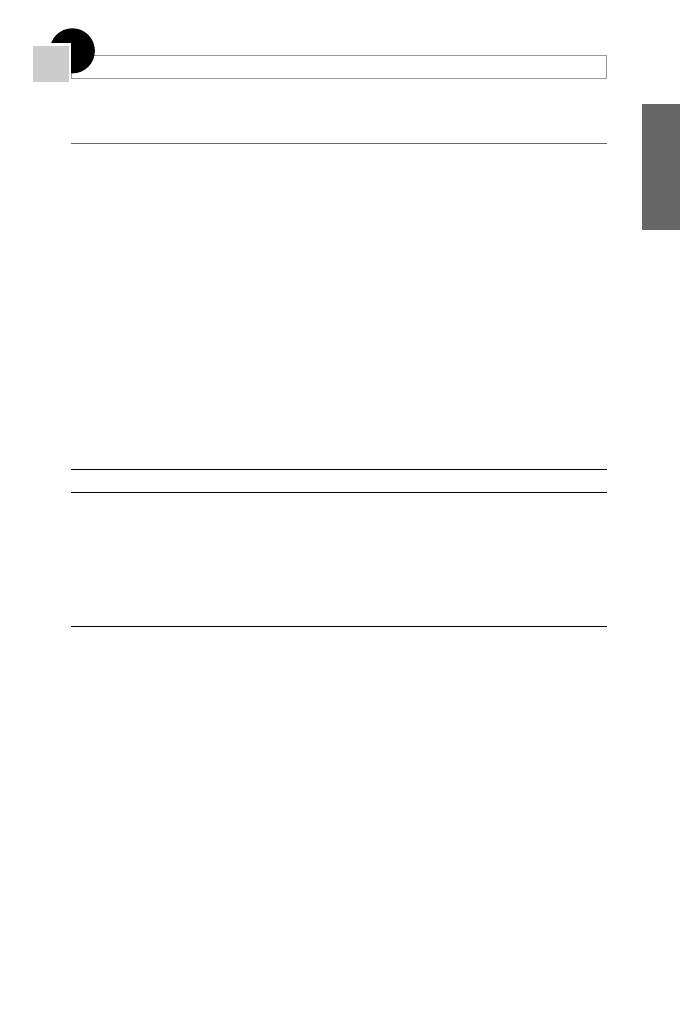
RESPIRATORY SYSTEM
79
3
EMQ Question 188
For each description of respiratory pressures A–E, select the most appropriate option from the
following list.
1. Intrapleural pressure.
2. Intra-abdominal pressure.
3. Intra-alveolar pressure.
4. Intra-oesophageal pressure.
5. Atmospheric pressure.
A.
Intra-alveolar pressure at end-inspiration and end-expiration.
B.
Shows transient rises and falls during the respiratory cycle peaking at mid-expiration
and mid-inspiration respectively.
C.
Approximates to intrapleural pressure.
D.
Rises markedly during the vomiting reflex.
E.
Determines the pressure gradient for inspiration and expiration.
EMQ Question 189
For each person described below A–E, select the most appropriate set of arterial blood gas
results (pH and bicarbonate are included) from the following list.
pH
P
O
2
P
CO
2
Bicarbonate
1.
Normal
Normal
Normal
Normal
2.
Normal
Reduced
Normal
Normal
3.
Reduced
Reduced
Increased
Normal
4.
Reduced
Reduced
Increased
Increased
5.
Reduced
Increased
Increased
Increased
6.
Reduced
Increased
Reduced
Reduced
7.
Increased
Increased
Reduced
Normal
8.
Increased
Reduced
Reduced
Reduced
A.
A healthy 25-year-old has climbed from sea level to a height of 1000 metres (about
3000 feet), feels fine and is enjoying the view.
B.
A 40-year-old known diabetic on insulin has been admitted to hospital, semi-conscious
with ketoacidosis and is breathing deeply.
C.
A healthy 30-year-old is on a high-altitude adventure holiday with initially several days
at moderate altitude where ventilation is definitely increased. Later, while climbing at
4500 metres (about 15 000 feet) severe headache, retching and inability to continue
climbing develop.
D.
A 55-year-old patient with long-standing cough and sputum has been admitted with
signs of serious chest infection and a general bluish colour. Initial treatment has
included treatment with oxygen through a facemask.
E.
A 30-year-old is admitted to hospital with signs of serious renal damage. The patient is
drowsy and is breathing deeply.
EMQ

80
Respiratory system – answers
Answers for 188
A.
Option 5
Atmospheric pressure. Intra-alveolar pressure returns to atmospheric pres-
sure at the end of each inspiratory and expiratory phase.
B.
Option 3
Intra-alveolar pressure. This dips transiently during inspiration and rises to
a similar extent during expiration.
C.
Option 4
Intra-oesophageal pressure. Since the oesophagus and the intrapleural
spaces are normally closed cavities within the chest, intra-oesophageal pressure normally
approximates to intrapleural pressure.
D.
Option 2
Intra-abdominal pressure. During vomiting this rises markedly to compress
the gut while the way out through the lower oesophageal (cardiac) sphincter is open due
to relaxation of oesophageal smooth muscle.
E.
Option 3
Intra-alveolar pressure. The difference between this and atmospheric pres-
sure constitutes the pressure gradient which determines the flow of air into or out of the
lungs.
Answers for 189
A.
Option 2
P
O
2
reduced, others normal. At 1000 metres, atmospheric pressure and hence
ambient oxygen pressure fall by about 10 per cent. This reduces alveolar and hence arte-
rial P
O2
by slightly more, since alveolar water vapour pressure and P
CO
2
do not change.
However, due to the plateau of the oxygen dissociation curve, arterial saturation falls only
slightly. Bodily function is unaffected, with no change in ventilation, so carbon dioxide,
pH and bicarbonate do not change.
B.
Option 6
All reduced, apart from Po
2
, which is increased. The ketoacidosis is due to
abnormal accumulation of highly acidic metabolites. Hence the pH is reduced. Bicarbonate
ions have buffered most of the surplus hydrogen ions to minimize the fall in pH, hence
bicarbonate is reduced. The acidosis stimulates ventilation. This reduces P
CO
2
and also
limits pH fall; the increased ventilation also increases P
O2
, though as in (A) the effect on
saturation is minute.
C.
Option 8
pH increased, others reduced. In this case, serious ‘hypoxic hypoxia’ leads
to increased ventilation reflexly via the carotid and aortic bodies. Increased ventilation
improves P
O2
, but it remains well below normal, causing general tissue hypoxia. The
increased ventilation acts mainly by lowering P
CO
2
, allowing oxygen to replace some of
the carbon dioxide in the alveoli. However, lowered P
CO
2
causes a respiratory alkalosis so
pH rises. To compensate for the respiratory alkalosis, the renal tubules reduce secretion of
hydrogen ions and lower blood bicarbonate level. However, all these compensations
merely reduce the abnormalities. The combination of tissue hypoxia, decreased cerebral
blood flow (due to the low P
CO
2
), and alkalosis seriously disturb bodily function. Some
people tolerate this quite well, but others, like this person, feel wretched and are at risk of
serious and even fatal complications.
D.
Option 5
pH reduced, others increased. The 55-year-old has inadequate ventilation
related to chronic respiratory disease. The inadequate ventilation is shown by the bluish
colour (cyanosis) due to excessive desaturated haemoglobin. This is another variety of
‘hypoxic hypoxia’. The inadequate ventilation also raises the P
CO
2
, causing a respiratory
acidosis. As with (C), but in the opposite direction, the renal tubules raise the blood bicar-
bonate level. The increased P
O
2
can only be explained by the administration of oxygen.
Before this the oxygen level would have been reduced. Such patients require careful mon-
itoring of their blood gases and control of the administered oxygen.
E.
Option 6
All reduced, apart from P
O
2
, which is increased. Here the renal damage
impairs hydrogen ion excretion in the urine and addition of bicarbonate to the blood. Just
like (B) this patient has a metabolic acidosis. The respiratory compensation and its effects
are explained in the same way.
EMQ

Respiratory system – questions
81
EMQ Question 190
For each person A–E, select the most appropriate set of results for respiratory function tests
from the following list, where VC
⫽vital capacity; FEV
1.0
⫽forced expiratory volume in one
second; RV
⫽residual volume all litres; PEFR⫽peak expiratory flow rate in litres per second.
VC
FEV
1.0
RV
FEV
1.0
/VC
Per cent
PEFR
1.
5.0
4.0
1.5
80
600
2.
3.0
2.1
1.2
70
350
3.
4.5
5.0
1.2
90
200
4.
4.0
2.0
2.5
50
120
5.
3.0
2.4
0.8
80
620
6.
4.0
3.4
1.2
85
450
A.
A woman of 19 years who had occasional asthma as a child but is now free of symp-
toms.
B.
A man of 32 who is having respiratory function testing as part of a routine health
check.
C.
A woman of 77 who is acting as a normal control in a research project.
D.
When this patient comes to discuss the results of respiratory testing, the doctor apolo-
gizes that there seems to have been a mistake as the results do not make sense.
E.
A man of 45 with a long history of chronic obstructive pulmonary disease (COPD).
EMQ Question 191
For each item A–E related to control of ventilation, select the most appropriate option from the
list below.
1. Voluntary hyperventilation.
2. Reflex hyperventilation.
3. Hypoventilation.
4. Ventilation controlled from the medulla
5. Ventilation controlled from above
5.
oblongata.
5.
the medulla oblongata.
6. Ventilation associated with dyspnoea.
A.
An athlete’s ventilation may increase from a normal value of 6 litres per minute to over
100 litres per minute while running a race.
B.
A student breathes a mixture of 5 per cent carbon dioxide and finds that, without
apparent effort, the breathing is much deeper than normal.
C.
Another student is asked to breathe rapidly and deeply for three minutes. Towards the
end of the time there is a strong wish to reduce the breathing and there is a feeling of
lightness and discomfort in the head.
D.
In normal people breathing continues steadily during sleep.
E.
In people with COPD the lungs are over-inflated and it may be harder to breathe in than
breathe out.
EMQ

82
Respiratory system – answers
Answers for 190
A.
Option 6
This is a normal vital capacity for a young female where volumes are smaller
than in males. FEV1
1.0
is 85 per cent of VC which is normal in young people; RV is also
in keeping. PEFR is also normal for a female. Option 2 would be the next best option but
note the comments in (C).
B.
Option 1
These are all normal values for an average male of this age.
C.
Option 2
These are normal values for a woman of this age. VC is smaller in females
and falls with age. FEV
1.0
/FVC also falls with age and this is normal at her age. RV tends
to rise with age, although the value is quite small it is a higher proportion of total lung
capacity (VC
⫹RV) here than in Option 1. This is a normal PEFR for a woman of this age.
D.
Option 3
This is a nonsense result. FEV
1.0
cannot be greater than VC; they may have
been reversed, which would correspond with the percentage of 90. However, these results
would not then correspond with the low PEFR.
E.
Option 4
These results are typical of fairly severe COPD. FEV
1.0
is only half the vital
capacity, RV is considerably increased and PEFR is much reduced. The changes would be
those expected in someone whose predicted normal results correspond to Option 1. If this
man had developed restrictive disease, then Option 5 would be appropriate parallel reduc-
tions in all volumes including RV, but a well preserved and even increased PEFR as the
airways are not affected by restrictive disease.
Answers to 191
A.
Option 4
Ventilation controlled from above the medulla oblongata. The commonest sit-
uation for this huge minute volume is strenuous exercise in a normal person. This is not
a reflex from a fall in arterial oxygen levels, which remain normal, but is controlled from
higher levels where circulatory and respiratory activities are coordinated with muscular
activity. This activity is sometimes identified with ‘the exercise centre’ though this is more
a function of the brain than a localized area.
B.
Option 2
Reflex hyperventilation. The increased ventilation is reflexly produced via
chemoreceptors in the region of the medulla oblongata. These respond to the huge rise in
hydrogen ions produced centrally from the rise in carbon dioxide level.
C.
Option 1
Voluntary hyperventilation. The hyperventilation lowers the carbon dioxide
level. This causes a respiratory alkalosis and constricts cerebral arterioles. There has been
a suggestion that people who are most distressed by this activity are the most likely to
suffer from severe symptoms at high altitudes where such changes are the result of reflex
hyperventilation.
D.
Option 4
Ventilation controlled from the medulla oblongata. The spontaneous rhyth-
micity in the inspiratory and expiratory centres here generate the basic breathing pattern
upon which other more complicated activities, including voluntary control as in respira-
tory function testing, are built.
E.
Option 6
Ventilation associated with dyspnoea. With severe over-inflation lung com-
pliance falls; this increases the work of breathing in and may be less severe when breath-
ing out (patients vary in this). The extra effort is interpreted as something wrong with the
breathing (dyspnoea means bad breathing). In Option 1 the problem is not with the breath-
ing but with the effects it produces. In Option 2 the increased breathing is not experienced
as particularly unpleasant. In Option 5 the increased breathing of exercise is recognized
as normal.
EMQ

Respiratory system – questions
83
EMQ Question 192
For each item A–E related to oxygen transport, select the most appropriate option from the list
below:
1. Sigmoid.
2. Plateau.
3. Oxygen in solution.
4. Percentage saturation.
5. Oxygen content, ml oxygen per
6. Shift of the curve to the right.
5.
litre of blood.
7. Shift of the curve to the left.
A.
When the y axis of the oxygen dissociation curve of blood is labelled thus, the curve for
severe anaemia is very similar to that for normal blood.
B.
The form in which oxygen passes from blood to tissues.
C.
This leads to proportionately greater release of oxygen to the tissues.
D.
A property of the oxygen dissociation curve which is related to the varying affinities of
haemoglobin for oxygen particularly at very low oxygen pressures and at the pressures
around the normal range for alveolar oxygen pressures.
E.
The reason the ‘plateau’ phase of the oxygen dissociation curve is not completely hori-
zontal.
EMQ Question 193
For each item A–E related to carbon dioxide transport, select the most appropriate option from
the list below.
1. Dissolved carbon dioxide.
2. Carbon dioxide combined with
3. Carbon dioxide in red cells.
2.
haemoglobin.
4. Carbon dioxide in plasma.
5. Carbaminohaemoglobin.
6. Carboxyhaemoglobin.
7. Ability of desaturated haemoglobin to
buffer hydrogen ions.
A.
This has a particularly unfavourable effect on the ability of blood to carry adequate
oxygen.
B.
The action of carbonic anhydrase is particularly important here.
C.
The relationship of this to partial pressure is quantitatively different than is the case
with oxygen.
D.
This favours carriage of carbon dioxide by the law of mass action.
E.
This form of transport is influenced more by the saturation of the haemoglobin with
oxygen than the partial pressure of carbon dioxide in the blood.
EMQ

84
Respiratory system – answers
Answers for 192
A.
Option 4
Percentage saturation. Regardless of the haemoglobin content, the oxygen
content of blood at a given oxygen pressure will always be very similar, expressed as a
percentage of the capacity. The very slight differences are due to the fact that in severe
anaemia the amount of dissolved oxygen relative to oxygen combined with haemoglobin
is slightly greater since there is a higher proportion of plasma.
B.
Option 3
Oxygen in solution. Only dissolved gases can pass through the tissue fluids.
C.
Option 6
Shift of the curve to the right. When the oxygen dissociation curve of blood
shifts to the right on the x axis, the oxygen content of blood at a given oxygen pressure
shifts downwards on the y axis. Thus the blood retains less oxygen and more is released
to the tissues.
D.
Option 1
Sigmoid. Sigmoid means S-shaped. The first bend of the S is produced by
the increasing affinity of haemoglobin for oxygen; at low pressures the curve becomes
increasingly steep and then straightens to a steep fairly linear rise. The second bend is pro-
duced as full saturation is approached and the steep rise curves to join the plateau.
E.
Option 3
Dissolved oxygen. As the partial pressure of oxygen increases above the
normal alveolar value, the content rises very gradually as the dissolved oxygen increases
in proportion to the pressure. In hyperbaric oxygen conditions this dissolved amount can
be significant. For example if 3 ml are dissolved per litre when P
O2
is 100 mmHg
(13.5 kPa), then at two atmospheres of oxygen, with a P
O2
around 1500 mmHg (200 kPa),
the dissolved oxygen amounts to 45 ml/litre. This can be helpful when haemoglobin has
been disabled by combination with carbon monoxide.
Answers for 193
A.
Option 6
Carboxyhaemoglobin. This is formed when people breathe even low concen-
trations of carbon monoxide. The great affinity of carbon monoxide for haemoglobin dis-
places most of the oxygen so that most haemoglobin is rendered useless and the patient
suffers from potentially fatal anaemic hypoxia.
B.
Option 3
Carbon dioxide in red cells. Carbonic anhydrase is located in red cells rather
than plasma. It provides the necessary acceleration of the formation of carbonic acid and
hence bicarbonate during the short time available for the uptake of carbon dioxide at
tissue level. Without it the dissolved carbon dioxide would build up a pressure which
would seriously slow diffusion from the tissues.
C.
Option 1
Dissolved carbon dioxide. At any given partial pressure carbon dioxide is
many times more soluble than oxygen.
D.
Option 7
Ability of desaturated haemoglobin to buffer hydrogen ions. As mentioned in
(B), generation of bicarbonate is necessary for adequate carriage of carbon dioxide.
Desaturated haemoglobin has a greater ability to buffer hydrogen ions than has oxy-
haemoglobin. The law of mass action predicts that the removal of hydrogen ions by buf-
fering favours further conversion of carbon dioxide to bicarbonate. In addition, diffusion
of bicarbonate ions from red cells to plasma lowers the concentration of the other prod-
uct of the reaction.
E.
Option 5
Carbaminohaemoglobin. Oxyhaemoglobin cannot carry as much CO
2
in the
carbamino compound as can reduced haemoglobin.
EMQ

Respiratory system – questions
85
EMQ Question 194
For each item A–E related to oxygen delivery and uptake by tissues, select the most appropri-
ate option from the list below.
1. Total available oxygen.
2. Cardiac output.
3. Blood haemoglobin concentration.
4. Arterial blood oxygen saturation.
5. Venous blood oxygen saturation.
6. Pulmonary arterial blood oxygen
saturation.
A.
Abnormality here is the fundamental cause of hypoxic hypoxia at high altitudes.
B.
The normal value for this in the resting average adult is around one litre per minute.
C.
Abnormality here is the fundamental cause of anaemic hypoxia.
D.
Abnormality here is the fundamental cause of hypoxic hypoxia in respiratory disease.
E.
This is reduced in stagnant hypoxia, in anaemic hypoxia and also in hypoxic hypoxia.
EMQ

86
Respiratory system – answers
Answers to 194
A.
Option 4
Arterial blood oxygen saturation. At high altitudes the alveolar oxygen pres-
sure falls to levels at which blood passing through the lungs is inadequately saturated with
oxygen. Therefore arterial blood oxygen saturation is seriously reduced and this is the
fundamental cause of impaired delivery of oxygen at high altitudes.
B.
Option 1
Total available oxygen. This equals the oxygen in five litres of normally sat-
urated blood with a normal haemoglobin content.
C.
Option 3
Blood haemoglobin concentration. Here the reduction in total available
oxygen is reduced in proportion to the reduction in the blood haemoglobin concentration.
D.
Option 4
Arterial blood oxygen saturation. As with (A) the hypoxic hypoxia is due to
inadequate saturation of blood in the lungs. However this time the cause is impaired lung
function rather than reduced inspired oxygen.
E.
Option 1
Total available oxygen. This depends on cardiac output, blood oxygen capac-
ity and arterial blood saturation percentage. Impaired cardiac output causes stagnant
hypoxia, impaired blood oxygen capacity causes anaemic hypoxia and reduced arterial
blood saturation causes hypoxic hypoxia.
EMQ

87
4
195. Bile
A.
Contains enzymes required for the digestion of fat.
B.
Contains unconjugated bilirubin.
C.
Salts make cholesterol more water-soluble.
D.
Pigments contain iron.
E.
Becomes more alkaline during storage in the gallbladder.
196. Saliva
A.
From different salivary glands has a similar composition.
B.
Contains enzymes essential for the digestion of carbohydrates.
C.
Has less than half the ionic calcium level of plasma.
D.
Has more than twice the iodide level of plasma.
E.
Has a pH between 5 and 6.
197. Swallowing is a reflex which
A.
Has its reflex centres in the cervical segments of the spinal cord.
B.
Includes inhibition of respiration.
C.
Is initiated by a voluntary act.
D.
Is dependent on intrinsic nerve networks in the oesophagus.
E.
Is more effective when the person is standing rather than when lying down.
198. Appetite for food is lost when
A.
Certain hypothalamic areas are stimulated.
B.
Certain hypothalamic areas are destroyed.
C.
The stomach is distended.
D.
The stomach is surgically removed.
E.
Blood glucose falls.
199. Secretion of saliva increases when
A.
Touch receptors in the mouth are stimulated.
B.
The mouth is flushed with acid fluids with a pH of about 4.
C.
A subject thinks of unappetizing food.
D.
Vomiting is imminent.
E.
Their sympathetic nerve supply is stimulated.
MCQ

88
Alimentary system – answers
Answers
195.
A.
False
Bile contains no digestive enzymes; its bile salts assist in the emulsification and
absorption of fat.
B.
False
The bilirubin is conjugated by the hepatocytes before excretion.
C.
True
By forming cholesterol micelles.
D.
False
Iron is removed from haem in the formation of bilirubin.
E.
False
It becomes more acid, which improves the solubility of bile solids.
196.
A.
False
Serous glands such as the parotids produce a watery juice; mucous glands such
as the sublinguals produce a thick viscid juice.
B.
False
The functions of salivary amylase (ptyalin) can be affected by enzymes from
other digestive glands.
C.
False
It is saturated with calcium ions; calcium salts are laid down as plaque on the
teeth.
D.
True
Saliva is an important route of iodide excretion; its concentration in saliva is
20–100 times that in plasma.
E.
False
Saliva has a neutral pH; acidity in the mouth tends to dissolve tooth enamel.
197.
A.
False
The reflex centres lie in the medulla oblongata.
B.
True
This plus closure of the glottis prevents food being aspirated into the airways.
C.
True
The voluntary act is propulsion of a bolus of food onto the posterior pharyngeal
wall.
D.
True
These are essential for the peristaltic phase.
E.
True
Gravity can assist the reflex; tablets are more difficult to swallow when lying
down.
198.
A.
True
For example, when the ‘satiety’ centres are stimulated.
B.
True
For example, when the ‘hunger’ centres are damaged.
C.
True
Appetite is relieved after a meal before the food products of digestion are
absorbed into the blood.
D.
False
The drive to eat does not depend on an intact stomach.
E.
False
It increases as hypothalamic ‘glucostats’ detect the low glucose and excite the
‘hunger’ centres to generate the emotional drive to eat.
199.
A.
True
Food, foreign bodies and the dentist are effective stimuli.
B.
True
E.g. lemon juice; saliva is a useful buffer to protect teeth from acid.
C.
False
Thinking of appetizing food results in salivary secretion by a conditioned reflex;
conversely, thinking of unappetizing food inhibits secretion.
D.
True
Saliva helps to buffer the acid vomitus when it reaches the mouth.
E.
True
Sympathetic stimulation produces a scanty viscid juice; parasympathetic stimu-
lation produces a copious watery juice.
MCQ

Alimentary system – questions
89
Questions 200–205
200. Defaecation is a reflex action
A.
That is coordinated by reflex centres in the sacral cord.
B.
Whose afferent limb carries impulses from stretch receptors in the colon.
C.
Whose efferent limb travels mainly in sympathetic autonomic nerves.
D.
Which is more likely to be initiated just after a meal than just before it.
E.
Which can be voluntarily inhibited or facilitated.
201. Thirst sensation occurs when
A.
Osmoreceptors in the sensory cortex are activated.
B.
Blood osmolality is raised but blood volume is normal.
C.
Blood volume is reduced but blood osmolality is normal.
D.
The mouth is dry.
E.
A patient has severe diabetic keto-acidosis.
202. In the stomach
A.
pH rarely falls below 4.0.
B.
Pepsinogen is converted to pepsin by hydrochloric acid.
C.
Ferrous iron is reduced to ferric iron by hydrochloric acid.
D.
Acid secretion is inhibited by pentagastrin.
E.
There is a rise in the bacterial count after histamine H
1
receptor blockade.
203. Intestinal secretions contain
A.
Potassium in a concentration similar to that in extracellular fluid.
B.
Enzymes that are released when the vagus nerve is stimulated.
C.
Enzymes that hydrolyze disaccharides.
D.
Enzymes that hydrolyze monosaccharides.
E.
Enzymes that activate pancreatic proteolyic enzymes.
204. Pancreatic secretion
A.
In response to vagal stimulation is copious, rich in bicarbonate but poor in enzymes.
B.
In response to acid in the duodenum is scanty but rich in enzymes.
C.
In response to secretin secretion is low in bicarbonate.
D.
Contains enzymes that digest neutral fat to glycerol and fatty acids.
E.
Contains enzymes that convert disaccharides to monosaccharides.
205. The liver is the principal site for
A.
Synthesis of plasma albumin.
B.
Synthesis of plasma globulins.
C.
Synthesis of vitamin B
12
.
D.
Storage of vitamin C.
E.
Storage of iron.
MCQ

90
Alimentary system – answers
Answers
200.
A.
True
Reflex defaecation can occur after complete spinal cord transection.
B.
False
The stretch receptors triggering the reflex are in the rectal wall.
C.
False
Parasympathetic nerves are the main motor nerves for defaecation.
D.
True
The wish to defaecate that follows a meal is attributed to a ‘gastrocolic reflex’.
E.
True
Forced expiration against a closed glottis facilitates the reflex by raising intra-
abdominal pressure and pushing faeces into the rectum; contraction of the vol-
untary muscle of the external sphincter can inhibit it.
201.
A.
False
The emotional drive to drink depends on ‘thirst centres’ in the hypothalamus.
B.
True
Presumably due to stimulation of hypothalamic osmoreceptors.
C.
True
Presumably due to stimulation of vascular volume receptors.
D.
True
Afferents from the upper alimentary tract can influence ‘thirst centre’ activity.
E.
True
Probably due to osmoreceptor stimulation by the hyperglycaemic blood and a
reduction in the activity of vascular volume receptors.
202.
A.
False
Values around pH 2–3 are normal.
B.
True
Pepsin is the active proteolyic form of pepsinogen.
C.
False
HCl reduces trivalent ferric iron to the divalent ferrous form in which it can be
absorbed in the small intestine.
D.
False
Pentagastrin is a powerful pharmacological stimulant of mucosal cells to produce
HCl.
E.
False
But it rises markedly after H
2
blockade which blocks gastric acid secretion.
203.
A.
False
The concentration is higher, due partly to potassium released from cast off cells.
B.
False
Intestinal secretion is not under vagal control; its enzymes are thought to be con-
stituents of the mucosal cells and released when these are cast off into the lumen.
C.
True
The mucosal cell brush border contains these enzymes, e.g. maltase and lactase.
D.
False
Monosaccharides are end-products of digestion and absorbed as such.
E.
True
For example, enterokinase which converts trypsinogen to trypsin.
204.
A.
False
It is scanty and rich in enzymes; it is secreted reflexly in the ‘cephalic’ phase of
pancreatic secretion when food is thought about or chewed.
B.
False
It is copious, bicarbonate rich and poor in enzymes; it buffers the acid secretions
entering the duodenum from the stomach.
C.
False
This is the hormone released when acid enters the duodenum that stimulates the
pancreas to produce the juice described in (B) above.
D.
True
Pancreatic lipase.
E.
False
Pancreatic amylase breaks down carbohydrates to dextrins and polysaccharides.
205.
A.
True
Plasma albumin concentration falls in liver failure.
B.
False
Immunoglobulins are produced by ribosomes in lymphocytes.
C.
False
Vitamin B
12
is ingested in food, absorbed complexed with intrinsic factor in the
terminal ileum and stored in the liver.
D.
False
Vitamin C is not stored; any in excess of requirements is excreted in urine.
E.
True
Iron released from haem from broken down RBCs is stored in the liver for future
haemopoiesis.
MCQ

Alimentary system – questions
91
Questions 206–211
206. In the colon
A.
A greater volume of water is absorbed than in the small intestine.
B.
Mucus is secreted to lubricate the faecal contents.
C.
Faecal transit time is normally about 7 days.
D.
Faecal transit time is inversely related to its fibre content.
E.
Bacteria normally account for about three quarters of the faecal weight.
207. Gastric juice
A.
Is secreted when the vagus nerves are stimulated.
B.
Is secreted in vagotomized animals when food is chewed but not swallowed.
C.
Inactivates the digestive enzymes secreted with saliva.
D.
Does not digest the gastric mucosa because it is protected by a pepsin inactivator.
E.
Irritates the oesophageal mucosa if regurgitated from the stomach.
208. An increase in body fat increases the
A.
Percentage of water in the body.
B.
Survival time during fasting.
C.
Survival time in cold water.
D.
Specific gravity of the body.
E.
Probability of increased morbidity and premature mortality.
209. The respiratory quotient
A.
Is the ratio of the volume of O
2
consumed to the volume of CO
2
produced.
B.
Depends essentially on the type of substrate being metabolized.
C.
Is 1.0 when glucose is the substrate metabolized.
D.
Is between 0.9 and 1.00 in the second week of fasting.
E.
For the brain is around 1.0.
210. Oxygen consumption tends to increase when the
A.
Concentration of oxygen in inspired air rises.
B.
Metabolic rate falls.
C.
Body temperature rises.
D.
Environmental temperature falls.
E.
After a meal is ingested.
211. Saliva is necessary for
A.
Digestion of food.
B.
Swallowing of food.
C.
Normal speech.
D.
Antisepsis in the mouth.
E.
Taste sensation.
MCQ

92
Alimentary system – answers
Answers
206.
A.
False
The colon absorbs 1–2 litres/day; 8–10 litres is absorbed per day in the small
intestine.
B.
True
Mucous cells are the predominant cells on the colonic mucosal surface.
C.
False
The average transit time from caecum to pelvic colon is about 12 hours but pas-
sage from the pelvic colon to the anus may take days.
D.
True
Fibre (cellulose, lignin etc.) in the colonic contents stimulates peristaltic move-
ments by adding ‘bulk’ to the food residues.
E.
False
But bacteria such as Escherichia coli make up about a third of faecal weight.
207.
A.
True
Vagal stimulation increases acid and pepsinogen secretion; this action is medi-
ated by acetylcholine and gastrin-releasing peptide released from the vagal nerve
endings.
B.
False
After vagotomy, food must enter the stomach to stimulate gastric secretions.
C.
True
Salivary enzymes are not effective at the low pH of gastric juice.
D.
False
But mucosal cells are protected by a coat of mucus impregnated with bicarbo-
nate.
E.
True
This is normally prevented by the cardiac sphincter.
208.
A.
False
The reverse is true, since fat tissue contains little water
B.
True
Fat is the main energy store of the body.
C.
True
It favours survival by increasing skin insulation.
D.
False
Fat has a lower specific gravity than the lean body mass.
E.
True
Actuarial tables show this to be true.
209.
A.
False
It is the inverse of this ratio.
B.
True
The respiratory quotients for carbohydrate, fat and protein metabolism are differ-
ent.
C.
True
C
6
H
12
O
6
⫹6O
2
⫽6CO
2
⫹6H
2
O; each molecule of O
2
consumed results in the pro-
duction of one molecule of CO
2
.
D.
False
It approaches 0.7, the value when fat is the main substrate being metabolized.
E.
True
Carbohydrate is the main substrate for brain metabolism.
210.
A.
False
The concentration of oxygen in the air breathed is not a determinant of oxygen
consumption.
B.
False
It rises; metabolic rate is the prime determinant of oxygen consumption.
C.
True
This increases metabolic rate by increasing the rate of cellular metabolism.
D.
True
More thermogenesis is required to maintain body temperature.
E.
True
Due to the specific dynamic action of the food, particularly protein.
211.
A.
False
Other digestive tract enzymes can take over if salivary enzymes are absent.
B.
False
But swallowing solids is difficult without saliva’s moisturizing and lubricant
effects.
C.
True
Nervous orators with dry mouths continually sip water.
D.
True
In the absence of saliva, the mouth becomes infected and ulceration occurs.
E.
True
Substances must go into solution before they can stimulate taste receptors.
MCQ

Alimentary system – questions
93
Questions 212–217
212. The stomach
A.
Is responsible for absorbing about 10 per cent of the ingested food.
B.
Contains mucosal cells containing high concentrations of carbonic anhydrase.
C.
Peristaltic contractions start from the pyloric region.
D.
Motility increases when fat enters the duodenum.
E.
Relaxes when food is ingested so that there is little rise in intra-gastric pressure.
213. Brown fat is
A.
Relatively more abundant in adults than in infants.
B.
Richer in mitochondria than ordinary fat.
C.
More vascular than ordinary fat.
D.
Stimulated to generate more heat when its parasympathetic nerve supply is stimulated.
E.
Is more important than shivering in neonatal thermoregulation.
214. Nitrogen balance
A.
Is the relationship between the body’s nitrogen intake and nitrogen loss.
B.
Is positive in childhood.
C.
Becomes more positive when dietary protein is increased.
D.
Becomes negative when a patient is immobilized in bed.
E.
Becomes less negative in the final stages of fatal starvation.
215. The normally innervated stomach
A.
Is stimulated to secrete gastric juice when food is chewed, even if it is not swallowed.
B.
Cannot secrete HCl when its H
1
histamine receptors are blocked.
C.
And the denervated stomach can secrete gastric juice after a meal is ingested.
D.
Empties more quickly than the denervated stomach.
E.
Is stimulated to secrete gastric juice by the hormone secretin
216. The passage of gastric contents to the duodenum may cause
A.
Copious secretion of pancreatic juice rich in bicarbonate.
B.
Decreased gastric motility.
C.
Contraction of the gallbladder.
D.
Contraction of the sphincter of Oddi.
E.
Release of pancreozymin.
217. Bile salts
A.
Are the only constituents of bile necessary for digestion.
B.
Have a characteristic molecule, part water-soluble and part fat-soluble.
C.
Are reabsorbed mainly in the upper small intestine.
D.
Are derived from cholesterol.
E.
Inhibit bile secretion by the liver.
MCQ

94
Alimentary system – answers
Answers
212.
A.
False
Little food is absorbed in the stomach other than alcohol.
B.
True
This is needed to generate the H
⫹
ions required for HCl secretion; carbonic anhy-
drase inhibitors reduce acid secretion.
C.
False
They begin at the other end, the fundus.
D.
False
Fat in the duodenum inhibits gastric motility.
E.
True
This ‘receptive relaxation’ allows the stomach to store large volumes of food
without discomfort.
213.
A.
False
The reverse is true.
B.
True
It has a higher metabolic rate than ordinary fat.
C.
True
Its higher metabolic rate merits a higher rate of blood flow.
D.
False
Metabolic activity in brown fat is stimulated by sympathetic nerve stimulation.
E.
True
Infants do not shiver well.
214.
A.
True
It is positive when more nitrogen is taken in than is lost.
B.
True
Nitrogen intake is greater than nitrogen loss during active tissue growth.
C.
False
The additional nitrogen intake is balanced by additional nitrogen loss as the extra
protein is metabolized and its nitrogen excreted in the urine.
D.
True
Muscles waste and the protein released is metabolized.
E.
False
It becomes more negative when little but protein remains to be metabolized.
215.
A.
True
This depends on a vagal reflex.
B.
False
Blockade of histamine H
2
receptors blocks gastric acid secretion.
C.
True
The denervated stomach is still affected by gastrin released from the gastric
mucosa when food enters the stomach.
D.
True
Gastric motility is more effective when it is coordinated by vagal nerve activity.
E.
False
Secretin, which stimulates pancreatic secretion, decreases gastric secretion.
216.
A.
True
This is caused by the hormone secretin released from the duodenal mucosa.
B.
True
This postpones further gastric emptying.
C.
True
Due to the action of cholecystokinin released from the mucosal cells.
D.
False
The sphincter of Oddi must relax to allow bile to enter the gut.
E.
True
Pancreozymin stimulates the pancreas to secrete a scanty, enzyme rich juice.
217.
A.
True
They emulsify fat creating a greater surface area for lipase to act on.
B.
True
This property allows them form to micelles for fat transport.
C.
False
They are absorbed in the terminal ileum.
D.
True
They are synthesized from cholesterol in the liver.
E.
False
They are ‘choleretics’, substances which stimulate bile secretion.
MCQ

Alimentary system – questions
95
Questions 218–222
218. Absorption of
A.
Fat is impaired if either bile or pancreatic juice is not available.
B.
Undigested protein molecules can occur in the newborn.
C.
Laevo-amino acids occurs more rapidly than absorption of the dextro-forms.
D.
Iron is at a rate proportional to body needs.
E.
Sodium is at a rate proportional to body needs.
219. The specific dynamic action of food
A.
Is the increase in metabolic rate that results from ingestion of food.
B.
Persists for about an hour after a meal is ingested.
C.
Is due to the additional energy expended in digesting and absorbing the food.
D.
Results in about 30 per cent of the energy value of ingested protein being unavailable
for other purposes.
E.
Results in about 20 per cent of the energy value of ingested fat and carbohydrate being
unavailable for other purposes.
220. Secretion of gastric juice
A.
Increases when food stimulates mucosal cells in the pyloric region.
B.
Is associated with a decrease in the pH of venous blood draining the stomach.
C.
In response to food is reduced after vagotomy.
D.
Is essential for protein digestion.
E.
Is essential for absorption of vitamin B
12
.
221. In the small intestine
A.
The enzyme concentration in intestinal juice is lower in the ileum than in the jejunum.
B.
Vitamin B
12
is absorbed mainly in the jejunum.
C.
Water absorption is dependent on the active absorption of sodium and glucose.
D.
Absorption of calcium occurs mainly in the terminal ileum.
E.
Glucose absorption is dependent on sodium absorption.
222. The cells of the liver
A.
Help to maintain the normal blood glucose level.
B.
Deaminate amino acids to form NH
4
⫹
which is excreted as ammonium salts in the urine.
C.
Synthesize Vitamin D
3
(cholecalciferol).
D.
Manufacture most of the immune globulins.
E.
Inactivate steroid hormones manufactured in the gonads.
MCQ

96
Alimentary system – answers
Answers
218.
A.
True
If either is absent, undigested fat appears in the faeces.
B.
True
Maternal antibodies (globulins) in colostrum are so absorbed.
C.
True
Transport mechanisms are isomer-specific.
D.
True
An active carrier-mediated transport mechanism is involved which reduces the
danger of iron toxicity with excessive intake.
E.
False
Most ingested sodium is absorbed; if absorption is above the body requirements,
the excess is excreted by the kidneys.
219.
A.
True
This is its definition.
B.
False
It persists for about six hours.
C.
False
It is due mainly to the additional energy expended on processing absorbed
material for detoxification, metabolism and storage.
D.
True
Mainly because of the energy required to deaminate amino acids.
E.
False
The figures are around 4 per cent for fat and 6 per cent for carbohydrate.
220.
A.
True
Cells in the pylorus release gastrin when food enters the stomach.
B.
False
Venous blood pH rises as bicarbonate enters the circulation in the ‘alkaline tide’.
C.
True
Vagal activity plays an important role in gastric juice secretion.
D.
False
Pancreatic trypsin and chymotrypsin can digest proteins.
E.
True
Without gastric ‘intrinsic factor’, Vitamin B
12
is not absorbed from the gut.
221.
A.
True
Being proteins, enzymes are digested by proteolytic enzymes as they pass down
the gut.
B.
False
It is absorbed mainly in the terminal ileum.
C.
True
Water is absorbed passively down the osmotic gradient set up by active sodium
and glucose absorption.
D.
False
It occurs mainly in the duodenum.
E.
True
Sodium is required at the luminal surface for glucose to be absorbed by an active
carrier-mediated process.
222.
A.
True
When blood glucose falls, liver glycogen is broken down to form glucose; when
glucose levels rise above normal, glucose is taken up by the liver and stored as
liver glycogen.
B.
False
The NH
4
⫹
is converted into urea and excreted in the urine; NH
4
⫹
is toxic.
C.
False
Cholecalciferol in produced in skin by the action of sunlight; the liver converts it
to 25-hydroxycholecalciferol and the kidney completes its activation by further
hydroxylation.
D.
False
They manufacture most of the plasma proteins but lymphocytes manufacture
immune globulins.
E.
True
The failure to inactivate oestrogens in men with liver failure can lead to breast
enlargement.
MCQ

Alimentary system – questions
97
Questions 223–228
223. Absorption of dietary fat
A.
Can only occur after the neutral fat has been split into glycerol and fatty acids.
B.
Involves fat uptake by both the lymphatic and blood capillaries.
C.
Is impaired following gastrectomy.
D.
Is required for normal bone development.
E.
Is required for normal blood clotting.
224. One gram of
A.
Carbohydrate, metabolized in the body, yields the same energy as when oxidized in a
bomb calorimeter.
B.
Fat, metabolized in the body, yields 10 per cent more energy than 1g of carbohydrate.
C.
Protein, metabolized in the body, yields the same energy as when oxidized in a bomb
calorimeter.
D.
Carbohydrate, metabolized in the body, yields about the same energy as 1g of protein.
E.
Protein per kg body weight is an adequate daily protein intake for a sedentary adult.
225. Cholesterol
A.
Can be absorbed from the gut by intestinal lymphatics following its incorporation into
chylomicrons.
B.
Can be synthesized in the liver.
C.
In the diet comes mainly from vegetable sources.
D.
Is eliminated from the body mainly by metabolic degradation.
E.
Is a precursor of adrenal cortical hormones.
226. Free (non-esterified) fatty acids in plasma
A.
Account for less than 10 per cent of the total fatty acids in plasma.
B.
Are complexed with the plasma proteins.
C.
Decrease when the level of blood adrenaline rises.
D.
Can be metabolized to release energy in cardiac and skeletal muscle.
E.
Can be metabolized to release energy in the brain.
227. The risk of developing gallstones increases
A.
When cholesterol micelles are formed in the gall bladder.
B.
As the bile salt:cholesterol ratio increases.
C.
As the lecithin:cholesterol ratio increases.
D.
When supplementary bile salts are taken by mouth.
E.
In patients with haemolytic anaemia.
228. Modifying gastric function
A.
By cutting vagal fibres to the pylorus increases the emptying rate.
B.
By enlarging the pyloric orifice increases the emptying rate.
C.
By making a side-to-side anastomosis between the stomach and jejunum may cause
peptic ulceration in the jejeunum.
D.
To allow rapid gastric emptying may lead to low blood glucose levels after a meal.
E.
To allow rapid gastric emptying may lead to a fall in blood volume and blood pressure
after a large meal.
MCQ

98
Alimentary system – answers
Answers
223.
A.
False
Unsplit neutral fat can be absorbed if emulsified into sufficiently small particles.
B.
True
The smaller fatty acids pass directly into blood; the larger ones are esterified,
packaged into chylomicrons and taken into lymphatics.
C.
True
The loss of gastric storage capacity results in rapid transit of food through the
small intestine and insufficient time for complete digestion and absorption of fat.
D.
True
Vitamin D is required for normal bone development; it is a fat-soluble vitamin
and absorbed along with the fat.
E.
True
Vitamin K which is needed for the synthesis of certain clotting factors in the liver
is also a fat-soluble vitamin.
224.
A.
True
In both cases the carbohydrate is oxidized to carbon dioxide and water.
B.
False
Fat yields approximately 125 per cent more energy.
C.
False
It yields about 40 per cent less when metabolized in the body, urea derived from
protein is excreted in the urine and its free energy is not released to the body.
D.
True
The free energy released by carbohydrate and protein in the body is similar.
E.
True
This is probably a high figure; protein requirements increase with increasing
levels of energy expenditure.
225.
A.
True
Most of it is incorporated into very low density lipoproteins(VLDL) and circulates
as such.
B.
True
Its synthesis is determined mainly by saturated fat intake.
C.
False
The main sources are egg yolk and animal fat.
D.
False
It is eliminated mainly by excretion in the bile.
E.
True
It is a precursor of a number of steroid hormones.
226.
A.
True
Most are esterified to glycerol and cholesterol.
B.
True
This is necessary for solubility.
C.
False
They rise due to release from adipose tissue.
D.
True
They are an important source of energy for contraction.
E.
False
Glucose is the only normal substrate for energy production here.
227.
A.
False
This is a vital solubilizing mechanism.
B.
False
This favours formation of micelles.
C.
False
Lecithin also contributes to the formation of micelles.
D.
False
This can decrease the risk temporarily.
E.
True
Excess bilirubin can give rise to pigment stones.
228.
A.
False
Emptying is slowed as vagal coordination of gastric motility is lost.
B.
True
This may compensate for the slowing effects of vagotomy.
C.
True
Acid-pepsin can cause a jejunal stomal ulcer.
D.
True
Rapid glucose absorption leads to excessive insulin secretion and a consequent
fall in blood glucose.
E.
True
This is a further feature of the ‘dumping syndrome’. The sudden arrival of osmot-
ically active particles in the intestine draws extracellular fluid into the gut.
MCQ

Alimentary system – questions
99
Questions 229–234
229. Impaired intestinal absorption of
A.
Iron occurs frequently following removal of most of the stomach.
B.
Iodide leads to a reduction in size of the thyroid gland.
C.
Water occurs in infants who cannot digest disaccharides.
D.
Calcium may occur following removal of the terminal ileum.
E.
Bile salts may occur following removal of the terminal ileum.
230. Peptic ulcer pain is typically relieved by
A.
Raising the pH of the fluid bathing the ulcer.
B.
Oral administration of sodium bicarbonate.
C.
Oral administration of a non-absorbable antacid.
D.
A drug which interferes with the action of acetylcholinesterase.
E.
A drug which blocks the gastric proton pump.
231. Fat stores in the adult
A.
Make up less than 5 per cent of average body weight.
B.
Make up a smaller percentage of body weight in women than in men.
C.
Release fatty acids when there is increased sympathetic nerve activity.
D.
Release fatty acids when insulin is injected.
E.
Enlarge by increasing the number of adipocytes they contain.
232. Metabolic rate can be estimated from measurements of
A.
Total heat production.
B.
The calorific value of the food consumed in the previous 24 hours.
C.
Oxygen consumption provided the type of food being metabolized is known.
D.
Oxygen consumption and the respiratory quotient.
E.
Carbon dioxide production and the respiratory quotient.
233. Intestinal obstruction causes
A.
Constipation.
B.
Crampy pain due to intermittent vigorous peristalsis.
C.
Distension due to fluid and gas proximal to the obstruction.
D.
Hypotension.
E.
Vomiting which is more severe with low than with high bowel obstruction.
234. The cause of jaundice is likely to be
A.
Liver disease, if albumin is low and bilirubin mainly unconjugated.
B.
Bile duct obstruction, if the urine is paler than normal.
C.
Haemolysis, if the prothrombin level is below normal.
D.
Haemolysis, if the urine is darker than normal.
E.
A post-hepatic cause, if the bilirubin level in the blood is high.
MCQ

100
Alimentary system – answers
Answers
229.
A.
True
Due to loss of gastric acid which reduces ferric to the ferrous iron, the form in
which it is absorbed. Another problem affecting iron absorption is rapid intesti-
nal transit.
B.
False
The size increases to cause ‘goitre’ due to increased TSH stimulation.
C.
True
The unabsorbed disaccharides such as lactose cause osmotic diarrhoea.
D.
False
Calcium is absorbed mainly in the duodenum.
E.
True
The terminal ileum is the main site of bile salt absorption.
230.
A.
True
Acid is the cause of pain in these ulcers.
B.
True
But this is absorbed and may cause alkalosis.
C.
True
This also reduces acidity, but for a short time only.
D.
False
This would increase vagal acid production.
E.
True
This can give long lasting relief.
231.
A.
False
The normal value is around 15–20 per cent.
B.
False
Fat, as a percentage of body weight, is 5–10 per cent higher in women than in
men.
C.
True
This is mediated via beta adrenergic receptor stimulation.
D.
False
Insulin favours deposition of fat in the fat stores.
E.
False
In obesity, adipocytes increase in size rather than number.
232.
A.
True
Total energy expenditure must eventually appear as heat.
B.
False
Energy production is related to the metabolism of food, not its intake.
C.
True
Since oxygen is consumed only in metabolism, total oxygen consumption is an
index of metabolic rate; the energy produced per unit of oxygen consumed varies
somewhat with different substrates.
D.
True
Respiratory quotient indicates the mix of substrates used.
E.
True
Metabolic rate is proportional to carbon dioxide formation.
233.
A.
True
This is complete when the bowel below the block is empty.
B.
True
Intermittent colic is typical of early obstruction.
C.
True
This may be severe when the obstruction is in the lower gut.
D.
True
Due to hypovolaemia as secretions accumulate in the lumen of the intestines
above the obstruction.
E.
False
Vomiting is worse with high obstruction since the copious upper alimentary
secretions cannot be absorbed from the intestines below the obstruction where
most absorption normally takes place.
234.
A.
True
Both indicate impairment of liver function.
B.
False
Urine is dark in jaundice due to bile duct obstructions since conjugated bilirubin
can pass the glomerular filter.
C.
False
A low prothrombin suggests impaired liver function.
D.
False
Haemolysis raises the level of unconjugated bilirubin which is protein-bound and
not excreted in the urine (acholuric jaundice).
E.
False
It is high with all causes of jaundice.
MCQ

Alimentary system – questions
101
Questions 235–241
235. Complications that may arise after total gastrectomy include
A.
Inadequate food intake.
B.
Depletion of vitamin B
12
stores in the liver.
C.
Malabsorption of fat due to rapid intestinal transit.
D.
Impaired defaecation due to loss of the gastrocolic reflex.
E.
Inability to digest protein.
236. Severe diarrhoea causes a decrease in
A.
Body potassium.
B.
Body sodium.
C.
Extracellular fluid volume.
D.
Total peripheral resistance.
E.
Blood pH.
237. Diminished liver function may result in an increase in the
A.
Albumin to globulin ratio in the blood.
B.
Size of male breasts.
C.
Level of unconjugated bilirubin in the blood.
D.
Tendency to bleed.
E.
Variability of the blood glucose level.
238. Peptic ulceration tends to heal after
A.
Division of the vagal nerve supply to the stomach.
B.
Surgical removal of the pyloric antrum.
C.
Glucocorticoid drug treatment.
D.
Elimination of the bacterium Helicobacter pylori from the stomach.
E.
Treatment with histamine H
2
blocking drugs.
239. Urobilinogen is
A.
A mixture of colourless compounds also known as stercobilinogen.
B.
Formed in the reticuloendothelial system from bilirubin.
C.
Converted into the dark pigment, urobilin, on exposure to air.
D.
Absorbed from the intestine.
E.
Excreted mainly in the urine.
240. Surgical removal of 90 per cent of the small intestine may cause a
decrease in
A.
The fat content of the stools.
B.
Bone mineralization (osteomalacia).
C.
Extracellular fluid volume.
D.
Blood haemoglobin level.
E.
Body weight.
241. Lack of pancreatic juice in the duodenum may lead to
A.
The presence of undigested meat fibres in the stools.
B.
An increase in the fat content of the faeces.
C.
Faeces with a high specific gravity.
D.
A tendency for the faeces to putrefy.
E.
A high prothrombin level in blood.
MCQ

102
Alimentary system – answers
Answers
235.
A.
True
Due to loss of the ‘reservoir’ function of the stomach.
B.
True
Due to loss of gastric ‘intrinsic factor’, required for absorption of the vitamin.
C.
True
The mechanism regulating food delivery to the small intestine is lost.
D.
False
This ‘reflex’ is not essential for defaecation.
E.
False
Pancreatic enzymes can make up for the loss of pepsin.
236.
A.
True
Due to loss of secretions rich in potassium.
B.
True
Sodium is the main cation lost in diarrhoea.
C.
True
Body sodium is the ‘skeleton’ of extracellular fluid volume.
D.
False
This is raised to maintain arterial blood pressure as plasma volume falls.
E.
True
Loss of intestinal bicarbonate causes metabolic acidosis.
237.
A.
False
Albumin, which is manufactured in the liver tends to fall relative to globulin in
plasma.
B.
True
Due to loss of the liver’s ability to conjugate oestrogens and progestogens.
C.
True
The liver normally conjugates bilirubin with glucuronic acid.
D.
True
Due to reduced synthesis of clotting factors such as prothrombin by the liver.
E.
True
Due to the liver’s reduced ability to store and mobilize glycogen.
238.
A.
True
This reduces gastric acidity.
B.
True
Gastrin which stimulates acid secretion is produced in the pyloric antrum.
C.
False
Glucocorticoids by inhibiting tissue repair may make the ulceration worse.
D.
True
This bacterium appears to play an important part in the pathogenesis of peptic
ulcers.
E.
True
These reduce acidity and are widely used in the treatment of peptic ulceration.
239.
A.
True
It is present in both urine and faeces.
B.
False
It is formed in the intestine.
C.
True
Urine rich in urobilinogen (due to haemolysis) darkens on exposure to light.
D.
True
And carried back to the liver in the enterohepatic circulation.
E.
False
It is excreted mainly in the bile.
240.
A.
False
Fat absorption is incomplete and this causes steatorrhoea.
B.
True
There is poor absorption of fat-soluble vitamin D.
C.
False
Adequate salt and water absorption still occur.
D.
True
Vitamin B
12
and iron absorption are impaired and this may cause anaemia.
E.
True
Due to the malabsorption of food.
241.
A.
True
Due to lack of the proteinases trypsin and chymotrypsin.
B.
True
Due to impaired fat digestion and absorption caused by lack of pancreatic lipase.
C.
False
A high fat content lowers specific gravity; stools may float.
D.
True
Due to the high level of nutrients in the faeces, bacteria flourish.
E.
False
It is reduced; malabsorption of fat reduces absorption of fat-soluble vitamin K
that is needed for prothrombin production.
MCQ

Alimentary system – questions
103
Questions 242–247
242. In liver failure there is likely to be
A.
Salt and water retention.
B.
Oedema in dependent extremities such as the feet and ankles.
C.
Raised blood urea.
D.
Impaired absorption of fat.
E.
Intoxication after eating a high protein meal.
243. Gastric
A.
Acid secretion in response to a lowered blood sugar is mediated by the hormone gastrin.
B.
Emptying is facilitated by sympathetic nerve activity.
C.
Acid secretion increases when histamine H
2
, muscarinic M
1
or gastrin receptors are acti-
vated.
D.
Acid secretion is inhibited by the presence of food in the duodenum.
E.
Contraction waves pass over the stomach at a rate of about ten per minute.
244. In portal hypertension
A.
The total vascular resistance of the hepatic sinusoids is increased.
B.
Portal blood flow through the liver is increased.
C.
The volume of fluid in the peritoneal cavity increases.
D.
A porto-caval shunt (anastomosis between portal vein and inferior vena cava) can
decrease the tendency to bleed into the alimentary tract.
E.
A porto-caval shunt increases the risk of coma after bleeding into the alimentary tract.
245. Constipation is a recognized consequence of
A.
Sensory denervation of the rectum.
B.
Psychological stress.
C.
Abnormality of the autonomic nerve supply to the colon.
D.
A diet that leaves little unabsorbed residue in the gut.
E.
Over-activity of the thyroid gland as in thyrotoxicosis.
246. Absorption of glucose by intestinal mucosal cells
A.
Relies on a carrier mechanism in the cell membrane.
B.
Is blocked by the same agents that block renal reabsorption of glucose.
C.
Is enhanced by blockade of active sodium transport in the cells.
D.
Involves the same carriers that are used for the absorption of galactose.
E.
Takes place mainly in the ileum.
247. Vomiting
A.
Is caused by violent rhythmic contractions of gut smooth muscle.
B.
Is coordinated by a vomiting centre in the mid brain.
C.
Of green fluid suggests that duodenal contents have regurgitated into the stomach.
D.
May be accompanied by a fall in arterial blood pressure.
E.
Is more marked in low intestinal obstruction than in high intestinal obstruction.
MCQ

104
Alimentary system – answers
Answers
242.
A.
True
Due in part to the liver’s failure to conjugate salt-retaining hormones such as
aldosterone.
B.
True
Due to the above plus depletion of plasma albumin.
C.
False
It falls due to impaired urea synthesis from NH
4
⫹
released in deamination.
D.
True
Due to impaired formation and excretion of bile salts.
E.
True
Due to inadequate detoxification of toxins derived from proteins in the diet.
243.
A.
False
It is mediated through a vagal reflex and is absent in vagotomized stomachs.
B.
False
This delays gastric emptying.
C.
True
Histamine from mast-like cells activates H
2
receptors, acetylcholine from para-
sympathetic nerve endings activates M
1
receptors and gastrin activates gastrin
receptors.
D.
True
The neural/hormonal mechanisms responsible for the inhibition are not certain.
E.
False
The normal rate is around 3/minute.
244.
A.
True
This is the cause of the hypertension.
B.
False
It is decreased as blood is diverted to alternative routes back to the great veins.
C.
True
Raised hydrostatic pressure increases filtration from visceral capillaries; fluid
accumulates in the peritoneal cavity to cause ascites.
D.
True
By diverting blood away from oesophageal varices.
E.
True
The failure of the liver to detoxicate toxic end-products of protein metabolism in
liver failure can lead to hepatic encephalopathy; bypassing the liver with a porto-
caval shunt may aggravate the condition, especially after an intestinal bleed.
245.
A.
True
This breaks the reflex arc on which defaecation depends.
B.
True
Stress may modify the reflex to cause either constipation or diarrhoea.
C.
True
In children this may cause megacolon.
D.
True
Frequency of defaecation is related to the bulk of food residues.
E.
False
This leads to increased frequency of defaecation.
246.
A.
True
This facilitates transport from the lumen.
B.
True
Phloridzin has this action; the carrier mechanisms at the two sites are similar.
C.
False
It is impaired, suggesting that sodium absorption facilitates glucose absorption.
D.
True
But different carriers are involved in fructose absorption.
E.
False
It takes place mainly in the duodenum and jejunum.
247.
A.
False
Forced expiratory efforts by skeletal muscles in the presence of a closed glottis
and pylorus are responsible for compressing the stomach.
B.
False
It is coordinated by a vomiting centre in the medulla oblongata.
C.
True
Bile pigments enter the gut in the duodenum.
D.
True
This is one of several types of associated autonomic disturbance.
E.
False
It is more marked in high obstruction because the copious digestive secretion
cannot be absorbed by the gut below the obstruction.
MCQ

Alimentary system – questions
105
Questions 248–249
248. Obesity
A.
Is unlikely to occur on a high protein diet even if the calorific value of the food exceeds
daily energy expenditure.
B.
Is associated with increased demands on pancreatic islet beta cells.
C.
Can be assessed by multiple measurements of skin fold thickness.
D.
Can be assessed by weighing the body in air and in water.
E.
Is not diagnosed until body weight is 40 per cent above normal.
249. Muscle tone in the lower oesophagus is
A.
Greater than tone in the middle oesophagus.
B.
A major factor in preventing heartburn.
C.
Increased in pregnancy.
D.
Increased by gastrin.
E.
Increased by anticholinergic drugs
MCQ

106
Alimentary system – answers
Answers
248.
A.
False
If food energy intake exceeds energy expenditure, obesity develops regardless of
the predominant food in the diet.
B.
True
Mild maturity-onset diabetes mellitus may be relieved by decreasing body weight.
C.
True
Subcutaneous fat is a good indicator of the severity of obesity.
D.
True
Body specific gravity which is inversely related to body fat content can be cal-
culated from these values.
E.
False
The conventional threshold is 10 per cent.
249.
A.
True
The high-pressure zone indicates the ‘cardiac sphincter’.
B.
True
It prevents reflux of acid into the oesophagus.
C.
False
It is decreased and heartburn is common in pregnancy.
D.
True
This prevents reflux during gastric contractions.
E.
False
These reduce tone, suggesting that cholinergic nerves have a role in maintaining
normal tone.
MCQ

ALIMENTARY SYSTEM
107
4
EMQ Question 250
For each of the absorptive functions A–E, select the most appropriate absorption site from the
following list of alimentary tract sites.
1. Stomach.
2. Upper small intestine.
3. Lower small intestine.
4. Colon.
5. Rectum.
A.
The site where most of the intestinal water is absorbed.
B.
The site where most of the intestinal sodium is absorbed.
C.
The main site of iron absorption.
D.
The main site of Vitamin B
12
absorption.
E.
The main site of bile salt absorption.
EMQ Question 251
For each of the digestive functions A–E, select the most appropriate digestive secretion from
the following list of secretions.
1. Salivary secretion.
2. Gastric secretion.
3. Pancreatic secretion.
4. Bile.
5. Intestinal secretion.
A.
Splitting disaccharides.
B.
Splitting triglycerides.
C.
Absorption of vitamin B
12
.
D.
Emulsification of fat.
E.
Digestion of nucleic acids.
EMQ Question 252
For each of the examples of intestinal motility A–E, select the most appropriate stimulus from
the following list of stimuli:
1. Release of CCK-PZ.
2. Distension of the viscus wall.
3. Release of secretin.
4. Release of gastrin.
5. Sympathetic nerve activity.
A.
Gastro-colic reflex.
B.
Receptive relaxation.
C.
Peristalsis.
D.
Contraction of the cardiac (oesophogeal-gastric) sphincter.
E.
Contraction of the gallbladder.
EMQ

108
Alimentary system – answers
Answers for 250
A.
Option 2
Upper small intestine. About four fifths of intestinal water is absorbed by
the osmotic gradient created by glucose and sodium absorption in the small intestine, the
remaining fifth is absorbed in the colon.
B.
Option 2
Upper small intestine. Most sodium is absorbed by active transport in the
upper small intestine but some is also absorbed in the lower small intestine and in the
colon.
C.
Option 2
Upper small intestine. Iron is absorbed in the ferrous state using an intra-
cellular iron carrier mainly in the upper small intestine but some is also absorbed in the
lower small intestine.
D.
Option 3
Lower small intestine. Vitamin B
12
is absorbed complexed with intrinsic
factor in the terminal ileum.
E.
Option 3
Lower small intestine. Like Vitamin B
12
, bile salts are reabsorbed in the lower
small intestine to be returned to the liver as part of the enterohepatic circulation.
Answers for 251
A.
Option 5
Intestinal secretion. Intestinal juice contains the enzymes maltase, lactase
and sucrase that split maltose, lactose and sucrose respectively.
B.
Option 3
Pancreatic secretion. Pancreatic lipase splits neutral fat into glycerol and
fatty acids.
C.
Option 2
Gastric secretion. Gastric juice contains the intrinsic factor needed for the
absorption of Vitamin B
12
.
D.
Option 4
Bile. Bile salts help to emulsify fat so that the fat droplets offer a large sur-
face area to the action of lipases.
E.
Option 3
Pancreatic secretion. Nucleic acids are split by pancreatic nucleases in the
small intestine.
Answers for 252
A.
Option 2
Distension of the viscus wall. For this reflex, the distension of the stomach
wall following ingestion of a meal is thought to stimulate colonic motility that results in
defaecation.
B.
Option 2
Distension of the viscus wall. When food is ingested, the smooth muscle in
the stomach wall relaxes so that the added bulk can be accommodated without much
increase in intragastric pressure.
C.
Option 2
Distension of the viscus wall. When a bolus of food distends a hollow viscus
it sets up a wave of contraction preceded by a wave of relaxation that carries the bolus
along the viscus. Though peristalsis can be modified by autonomic nerves, the mechanism
is based on local nerve networks in the wall of the viscus.
D.
Option 4
Release of gastrin. Gastrin secreted in response to a meal increases tone in
the cardiac sphincter and so prevents regurgitation of gastric contents into the oesopha-
gus during stomach contractions.
E.
Option 5
Release of CCK-PZ. CCK-PZ released from the bowel wall when fat enters
the duodenum causes the gall bladder to contract to empty its contents into the second
part of the duodenum. It also inhibits gastric emptying.
EMQ

Alimentary system – questions
109
EMQ Question 253
For each of the structures and substances found in the alimentary tract A–E, select the most
appropriate function from the list below.
1. Fat transport.
2. Secrete alkaline mucus.
3. Activates enzymes in pancreatic
4. Secrete serotonin.
3.
secretion.
5. Ingest bacteria.
A.
Enterochromaffin cells.
B.
Brunner’s glands.
C.
Micelles.
D.
Kupffer cells.
E.
Enterokinase.
EMQ Question 254
For each of the digestive functions A–E, select the most appropriate digestive enzymes from
the following list of enzymes.
1. Rennin.
2. Endopeptidases.
3. Sucrase.
4. Alpha-amylase.
5. Deoxyribonuclease.
A.
Acts on protein to produce polypeptides and amino acids.
B.
Acts on DNA to produce nucleotides.
C.
Acts on a disaccharide to produce fructose and glucose.
D.
Acts on starch to produce dextrins and maltose.
E.
Acts on milk to produce a clot.
EMQ Question 255
For each of the absorptive functions A–E, select the most appropriate co-factor(s) required for
absorption from the list below.
1. A sodium dependent carrier system.
2. Apoferritin.
3. Vitamin D.
4. Intrinsic factor.
5. Bile salts.
A.
Fat absorption.
B.
Iron absorption.
C.
Glucose absorption.
D.
Calcium absorption.
E.
Vitamin B
12
absorption.
EMQ

110
Alimentary system – answers
Answers for 253
A.
Option 4.
Secrete serotonin. Certain duodenal cells called enterochromaffin cells con-
tain serotonin and the polypeptide ‘motilin’ that are thought to influence smooth muscle
motility in the gut.
B.
Option 2
Secrete alkaline mucus. Brunner’s glands in the duodenum secrete a thick
alkaline mucus that protects the duodenal mucosa against acid when gastric juice enters
the duodenum.
C.
Option 1
Fat transport. Micelles are complexes of lipids and bile salts. The complexes
are water-soluble and this aids their take up by the enterocytes lining the intestinal
mucosa.
D.
Option 5
Ingest bacteria. Kupffer cells are macrophages in the capillary sinusoids of
the liver; when they are deficient due to liver disease there is increased risk of organisms
passing from the gut to the systemic circulation via the portal circulation.
E.
Option 3
Activates enzymes in pancreatic secretion. Trypsinogen is a proenzyme
secreted by the pancreas that is activated in the lumen of the small intestine by the
enzyme enterokinase secreted by the intestinal mucosa.
Answers for 254
A.
Option 2
Endopeptidases. Secreted by the pancreas in an inactive form, the endo-
peptidases that include trypsin, chymotrypsin and elastase split the peptide bonds in poly-
peptides.
B.
Option 5
Deoxyribonuclease. RNA is split by ribonuclease.
C.
Option 3
Sucrase. Two other disaccharidases present in intestinal secretions, lactase
and maltase, split lactose and maltose into galactose and glucose and glucose and glucose
respectively.
D.
Option 4
Alpha-amylase. Alpha amylase is produced by the salivary glands as well as
by the pancreas.
E.
Option 1
Rennin. Found in the gastric juice of infants, rennin aids in milk digestion
by causing it to clot and slow its passage out of the stomach.
Answers for 255
A.
Option 5
Bile salts. Bile salts aid fat absorption by helping to emulsify the fat into
very small globules which present a large surface area that can be attacked by pancreatic
lipase. They then form part of the micelles that fit neatly between the microvilli of the
enterocytes.
B.
Option 2
Apoferritin. Apoferritin is an intracellular carrier that carries the iron mole-
cules from the mucosal surface of the enterocytes to the inner surface where it is deliv-
ered to the carrier molecule, transferrin, in the plasma.
C.
Option 1
A sodium dependent carrier system. The co-transporter molecule for glucose
is called SGLT (sodium dependent glucose transporter).
D.
Option 3
Vitamin D. In Vitamin D deficiency, calcium is not taken up by the intesti-
nal mucosa. This results in weakening of the bones as in rickets and osteomalacia.
E.
Option 4
Intrinsic factor. Vitamin B
12
has to be complexed with intrinsic factor in
gastric juice before it can be absorbed from the gut.
EMQ

Alimentary system – questions
111
EMQ Question 256
For each of the deficiencies of digestive secretions A–E, select the most appropriate conse-
quence from the list below.
1. Pale stools.
2. Local infections.
3. Steatorrhoea.
4. Milk intolerance.
5. Anaemia.
A.
Saliva deficiency.
B.
Biliary obstruction.
C.
Lactase deficiency.
D.
Pancreatic juice deficiency.
E.
Gastric juice deficiency.
EMQ Question 257
For each of the factors affecting intestinal activity A–E, select the most appropriate response
from the list below.
1. Inhibition of gastric secretion.
2. Stimulation of gastric secretion.
3. Increase in gastric motility.
4. Decrease in gastric motility.
5. Gall bladder contraction.
A.
CCK-PZ.
B.
Fat in the duodenum.
C.
Pentagastrin.
D.
Blockade of H
2
receptors.
E.
Adrenaline injection.
EMQ Question 258
For each of the structures in the alimentary tract A–E, select the most appropriate option from
the list below.
1. Controls entry of bile into the
2. Fat absorption.
3.
intestine.
3. Glucose absorption.
4. Secretion of gastric acid.
5. Lymphoid aggregations in the intestines
involved with immunity.
Intestinal structures
A.
Lacteals.
B.
Brush border.
C.
Oxyntic cells.
D.
Sphincter of Oddi.
E.
Peyer’s patches.
EMQ

112
Alimentary system – answers
Answers to 256
A.
Option 2
Local infections. The flow of saliva helps to control the multiplication of
bacteria in the mouth.
B.
Option 1
Pale stools. Bile entering the alimentary tract is responsible for the normal
brown colour of the stools.
C.
Option 4
Milk intolerance. Lactase deficiency is seen in a proportion of the popula-
tion. There is an inability to digest and absorb milk sugar. This results in an osmotic diar-
rhoea that can be a problem especially in babies where milk forms a large part of the
dietary intake.
D.
Option 3
Steatorrhoea. Steatorrhoea, the presence of unsplit fat in the faeces, is seen
in the absence of pancreatic juice since dietary fat cannot be hydrolysed and consequently
cannot be absorbed.
E.
Option 5
Anaemia. A macrocytic anaemia develops because there is no intrinsic
factor to facilitate the absorption of Vitamin B
12
.
Answers for 257
A.
Option 5
Gallbladder contraction. CCK, produced by the mucosal cells in the duodenal
wall when fat or other nutrients enter that part of the gut, travels in the blood to the gall
bladder so that the bile contents are sent to the duodenum to help in the digestion and
absorption of fat.
B.
Option 4
Decrease in gastric motility. Fat in the duodenum slows the transit of gas-
tric contents into the small gut and so slows and delays the digestion of the gastric con-
tents.
C.
Option 2
Stimulation of gastric secretion. Pentagastrin is a pharmacological product
containing five of the amino acids in gastrin that can act like gastrin to stimulate gastric
secretion. It is used to test the functional efficiency of the gastric mucosa to secrete gas-
tric juice.
D.
Option 1
Inhibition of gastric secretion. Histamine is the neurotransmitter at vagal
nerve endings in the stomach and acts on H
2
receptors. Thus H
2
receptor blockers can
reduce acid secretion by the gastric mucosa.
E.
Option 4
Decrease in gastric motility. Adrenaline and similar adrenergic agents cause
intestinal smooth muscle to relax.
Answers for 258
A.
Option 2
Fat absorption. Most of the absorbed fat is taken up directly by lacteals, so
called for their white colour following a fatty meal due to the fat globules in the lymph.
B.
Option 3
Glucose absorption. The brush border that is characteristic of the luminal
surface of enterocytes is made up of tiny microvilli protruding into the lumen of the gut
and offering a huge surface area for absorption of the products of digestion.
C.
Option 4
Secretion of gastric acid. These cells, sometimes also called parietal cells, are
found in the mucosa of the body and fundus of the stomach and are responsible for HCl
secretion.
D.
Option 1
Controls entry of bile into the intestine. The sphincter of Oddi lies in the
second part of the duodenum where the bile duct and the pancreatic ducts meet and con-
trols the flow of bile and pancreatic secretions into the duodenum.
E.
Option 5
Lymphoid aggregations in the intestines involved with immunity. These
patches are composed of lymphoid tissue and are responsible for immune reactions and
responses in the gut.
EMQ

Alimentary system – questions
113
EMQ Question 259
For each of the surgical interventions (-ectomy means removal) carried out on the alimentary
tract A–E, select the most appropriate possible consequence from the list below.
1. No digestive consequences.
2. Bulky liquid stools.
3. Dumping syndrome.
4. Steatorrhoea.
5. Indigestion after fatty meals.
A.
Gastrectomy.
B.
Pancreatectomy.
C.
Colectomy.
D.
Cholecystectomy.
E.
Appendicectomy.
EMQ Question 260
For each of polypeptides secreted by the enteric nervous system in the alimentary tract A–E,
select the most appropriate effect on the gut from the list below.
1. Release of gastrin.
2. Relaxation of sphincters.
3. Increase in small intestinal motility.
4. Inhibition of gut motility.
5. Inhibition of gastric emptying.
A.
VIP.
B.
CCK-PZ.
C.
Somatostatin.
D.
Substance P.
E.
GRP.
EMQ

114
Alimentary system – answers
Answers for 259
A.
Option 3
Dumping syndrome. When the stomach is removed, ingested food passes
very rapidly to the small intestine and can lead to the unpleasant consequences of fluid
loss to the intestinal lumen and excessive insulin secretion. The syndrome is called the
‘dumping syndrome’.
B.
Option 4
Steatorrhoea. This may be seen following pancreatectomy because lack of
lipase allows undigested fat to appear in the faeces.
C.
Option 2
Bulky liquid stools. Removal of the colon limits the ability of the alimentary
tract to reabsorb water and this results in the passage of watery stools.
D.
Option 5
Indigestion after fatty meals. The loss of the gall bladder’s ability to send bile
to the duodenum after a fatty meal results in poor digestion and absorption of the meal
and hence abdominal discomfort.
E.
Option 1
No digestive consequences. The appendix has no known function other than
as a lymphoid organ and its immune function can be taken over by other lymphoid tissue
in the intestines.
Answers for 260
A.
Option 2
Relaxation of sphincters. Vasoactive intestinal polypeptide (VIP) also causes
vasodilatation by relaxing vascular smooth muscle.
B.
Option 5
Inhibition of gastric emptying. Besides its main action of stimulating the gall
bladder to contract, cholecystokinin (CCK) decreases the rate of emptying of the stomach.
C.
Option 4
Inhibition of gut motility. Somatostatin, the growth hormone-inhibiting hor-
mone, originally isolated in the hypothalamus, is secreted by D cells in the intestinal
mucosa. It inhibits the release of several gut hormones including motilin and so inhibits
gut motility.
D.
Option 3
Increase in small intestinal motility. Substance P, a polypeptide found in
intestinal mucosal endocrine cells, acts locally to increase gut motility.
E.
Option 1
Release of gastrin. Gastrin-releasing polypeptide (GRP) is released by the
postganglionic vagal fibres that innervate the G cells in the lateral walls of the glands in
the pyloric antrum. Activity in these nerves causes release of the gastrin granules in the
G cells.
EMQ

115
5
261. A reflex action
A.
Is initiated at a sensory receptor organ.
B.
May result in endocrine secretion.
C.
Involves transmission across at least two central nervous synapses in series.
D.
May be excitatory or inhibitory.
E.
Is independent of higher centres in the brain.
262. In skeletal muscle neuromuscular junctions
A.
The motor end plate is the motor nerve terminal.
B.
Spontaneous (miniature) potentials may be recorded in the motor nerve terminal.
C.
Motor nerve terminals have vesicles containing acetylcholine.
D.
There is a high concentration of acetylcholinesterase.
E.
Transmission is facilitated by botulinum toxin.
263. Cerebrospinal fluid
A.
Is formed in the arachnoid granulations.
B.
Provides the brain with most of its nutrition.
C.
Protects the brain from injury when the head is moved.
D.
Has a lower pressure than that in the cerebral venous sinuses.
E.
Flow around the adult brain is around half a litre per day.
264. A skeletal muscle fibre
A.
Membrane is negatively charged on the inside with respect to the outside at rest.
B.
Contains intracellular stores of calcium ions.
C.
Is normally innervated by more than one motor neurone.
D.
Becomes more excitable as its resting membrane potential falls.
E.
Becomes less excitable as the extracellular ionized calcium levels fall.
265. In sensory receptors
A.
Stimulus energy is converted into a local depolarization.
B.
The generator potential is graded and self-propagating.
C.
A generator potential can be produced by only one form of energy.
D.
The frequency of action potentials generated doubles when the strength of the stimulus
doubles.
E.
Serving touch sensation, constant suprathreshold stimulation causes action potentials to
be generated at a constant rate.
266. A somatic lower motor neurone
A.
Innervates fewer fibres in an eye muscle than does one innervating a leg muscle.
B.
Conducts impulses at a speed similar to that in an autonomic postganglionic neurone.
C.
Is unmyelinated.
D.
Conducts impulses which cause relaxation in some skeletal muscles.
E.
Synapse with skeletal muscle but not with other neurones.
MCQ

116
Neuromuscular system – answers
Answers
261.
A.
True
Stimulation of the receptor generates impulses in the afferent limb.
B.
True
Stimulation of osmoreceptors reflexly modifies ADH output from the posterior
pituitary gland.
C.
False
The knee jerk reflex arc contains only one central nervous synapse.
D.
True
In the knee jerk extensors of the knee contract, while flexors relax (reciprocal
inhibition).
E.
False
Higher centres can facilitate or inhibit many reflex actions such as micturition.
262.
A.
False
It is the modified muscle membrane adjacent to the nerve terminal.
B.
False
They may be recorded at the motor end plate.
C.
True
This neurotransmitter, released by exocytosis, excites the end plate membrane.
D.
True
This makes acetylcholine’s action transient.
E.
False
Botulinum toxin blocks transmission by an action on the motor nerve terminals.
263.
A.
False
It is formed in choroid plexuses by active and passive processes.
B.
False
Most of the brain’s nutrition comes from the blood.
C.
True
This is its main function and it does so through cushioning and buoyancy.
D.
False
Its higher pressure allows drainage by filtration to the dural venous sinuses via
the arachnoid villi.
E.
True
This is about four times its volume.
264.
A.
True
This ‘resting membrane potential’ is about
⫺90 mV.
B.
True
These are released on excitation.
C.
False
A single neurone supplies a group of muscle fibres.
D.
True
It becomes more excitable as its membrane potential approaches the firing
threshold (about
⫺70 mV).
E.
False
Decreasing extracellular Ca
2
⫹
increases excitability and may lead to spontaneous
contractions (tetany), possibly by increasing sodium permeability.
265.
A.
True
This is the generator potential.
B.
False
It is graded but not propagated.
C.
False
But sensitivity is greatest to one form of energy – the ‘adequate stimulus’.
D.
False
Frequency is related to the logarithm of the strength of the stimulus.
E.
False
Frequency falls with time due to adaptation.
266.
A.
True
The more precise the movement required, the fewer the fibres supplied by one
motor neurone.
B.
False
Somatic motor neurones conduct at 60–120 m/sec; autonomic at about 1 m/sec.
C.
False
Fast-conducting fibres are large and myelinated.
D.
False
Impulses carried by somatic motor neurones are excitatory to skeletal muscle.
E.
False
Some carry impulses to inhibitory (Renshaw) cells in the anterior horn.
MCQ

Neuromuscular system – questions
117
Questions 267–272
267 Impulses serving pain sensation in the left foot are relayed
A.
Across synapses in the left posterior root ganglion.
B.
By fibres in the left spinothalamic tract.
C.
By the same spinal cord tract which serves heat and cold sensation.
D.
To the thalamus on the right side.
E.
To the cerebral cortex before entering consciousness.
268. An excitatory post-synaptic potential
A.
Is the depolarization of a post-synaptic nerve cell membrane that occurs when a pre-
synaptic neurone is stimulated.
B.
Involves reversal of polarity across the post-synaptic nerve cell membrane.
C.
May be recorded from a posterior root ganglion cell.
D.
Is propagated at the same rate as an action potential.
E.
Is caused by the electrical field induced by activity in the pre-synaptic nerve terminals.
269. The ascending reticular formation
A.
When stimulated tends to increase alertness.
B.
Transmits impulses to higher centres via a multisynaptic pathway.
C.
Is activated by collateral branches of sensory neurones.
D.
Neurones project to most parts of the cerebral cortex.
E.
Increases its activity during deep sleep.
270. The cerebellum
A.
Modifies the discharge of spinal motor neurones.
B.
Is essential for finely coordinated movements.
C.
Has an afferent input from the motor cortex.
D.
Has an afferent input from muscle proprioceptors.
E.
Has an afferent input from the vestibular system.
271. During deep sleep there is a fall in
A.
Hand skin temperature.
B.
Arterial P
CO
2
.
C.
Blood growth hormone/cortisol ratio.
D.
Metabolic rate.
E.
Urine formation.
272. Sympathetic
A.
Ganglionic transmission is mediated by acetylcholine.
B.
Neuromuscular transmission at the heart is mediated by adrenaline.
C.
Neuromuscular transmission in hand skin arterioles is mediated by acetylcholine.
D.
Neuroglandular transmission at sweat glands is mediated by noradrenaline.
E.
Neuromuscular transmission at the iris is mediated by noradrenaline.
MCQ

118
Neuromuscular system – answers
Answers
267.
A.
False
The ganglion contains sensory cell bodies but no synapses; primary pain fibres
carrying these impulses synapse with secondary neurones in the left posterior
horn.
B.
False
They cross to the right spinothalamic tract.
C.
True
Pain and temperature fibres travel together.
D.
True
Sensations other than smell are relayed in the thalamus.
E.
False
They enter consciousness at a subcortical level.
268.
A.
True
An inhibitory potential is a hyperpolarization.
B.
False
It is a transient (about 5 msec), small (about 5 mV) depolarization towards the
threshold for firing.
C.
False
It may be recorded from a motor neurone.
D.
False
It is not propagated.
E.
False
It is caused by transmitters changing permeability in post-synaptic membranes.
269.
A.
True
Associated with increased electrical activity in cortical regions.
B.
True
Diffuse cortical activity following sensory stimulation occurs later than local
postcentral gyrus activity.
C.
True
Sensory fibres ascending to the thalamus send collaterals to reticular nuclei.
D.
True
The diffuse cortical activity following sensory stimulation is abolished by damage
to the reticular formation.
E.
False
Decreased activity leads to a higher arousal threshold during sleep.
270.
A.
True
Hence it influences skeletal muscle activity.
B.
True
Damage to it leads to movements being clumsy (ataxia).
C.
True
This provides information of the desired movement.
D.
True
This provides information of the actual movement.
E.
True
It has an important role in maintaining balance.
271.
A.
False
Skin temperature rises due to vasodilation.
B.
False
The level rises due to hypoventilation.
C.
False
Growth hormone level is higher, cortisol lower in sleep.
D.
True
Due to slowing of metabolism and a fall in catecholamine level.
E.
True
The antidiuretic hormone level is higher in sleep.
272.
A.
True
This applies to parasympathetic ganglia also.
B.
False
The transmitter is noradrenaline.
C.
False
The transmitter is noradrenaline here also.
D.
False
These sympathetic fibres are cholinergic.
E.
True
Sympathetic adrenergic fibres innervate radial muscle in the iris; cholinergic
parasympathetic fibres innervate the circular muscle.
MCQ

Neuromuscular system – questions
119
Questions 273–278
273. The blood–brain barrier
A.
Slows equilibration of solutes between blood and brain tissue fluids.
B.
Is a more effective barrier for fat-soluble substances than water-soluble substances.
C.
Is a more effective barrier in infants than in adults.
D.
Is a more effective barrier for CO
2
than for O
2
.
D.
Permits hydrogen ions to pass freely.
274. Nerve impulses
A.
Can travel in one direction only in a nerve fibre.
B.
Can travel in one direction only across a synapse.
C.
Travel at the speed of an electric current.
D.
Correspond in duration to that of the nerve refractory period.
E.
Can be transmitted at higher frequencies in autonomic than in somatic nerves.
275. In skeletal muscle
A.
Contraction occurs when its pacemaker cells depolarize sufficiently to reach the thresh-
old for firing.
B.
Calcium is taken up by the sarcotubular system when it contracts.
C.
Actin and myosin filaments shorten when it contracts.
D.
The sarcomeres shorten during contraction.
E.
Contraction strength is related to initial length of the muscle fibres.
276. The electroencephalogram normally shows voltage waves
A.
Whose amplitude is related to intelligence.
B.
Of smaller amplitude during deep sleep than during alert wakefulness.
C.
Of lower frequency during deep sleep than during alert wakefulness.
D.
Of greater amplitude than those of the electrocardiogram.
E.
Which are bilaterally symmetrical.
277. Saltatory conduction
A.
Occurs only in myelinated fibres.
B.
Does not depend on depolarization of the nerve membrane.
C.
Has a slower velocity in cold than in warm conditions.
D.
Is faster than non-saltatory conduction in nerve fibres with diameters around 10
m.
E.
Transmits impulses with a velocity proportional to fibre diameter.
278. Parasympathetic nerves
A.
Have opposite effects to sympathetic nerves on intestinal smooth muscle.
B.
Have opposite effects to sympathetic nerves on iris smooth muscle.
C.
Cause vasodilatation in skeletal muscle during prolonged exercise.
D.
Cause sweat secretion in skin when body temperature rises.
E.
Have longer postganglionic than preganglionic fibres.
MCQ

120
Neuromuscular system – answers
Answers
273.
A.
True
Capillary permeability is lower in the brain than in other tissues.
B.
False
Fat-soluble substances cross readily due to the lipid in cell membranes.
C.
False
The reverse is true; bilirubin, which cannot pass in the adult, does so in infants.
D.
False
Both CO
2
and O
2
cross the blood–brain barrier easily.
E.
False
This protects brain tissues against sudden changes in the pH of blood.
274.
A.
False
In axons, impulses travel in both directions from a point of electrical stimulation.
B.
True
The transmitter vesicles are in the pre-synaptic terminal.
C.
False
Impulse propagation is a different process and much slower than electrical cur-
rent.
D.
True
Nerves cannot be re-excited while their membrane polarity is reversed.
E.
False
The shorter refractory periods in somatic nerves allow higher frequencies.
275.
A.
False
Skeletal muscle has no pacemaker cells and shows no spontaneous activity.
B.
False
Calcium is released from intracellular stores when it contracts.
C.
False
The filaments do not shorten but slide together over one another.
D.
True
There is greater overlap of the actin and myosin fibrils.
E.
True
Moderate stretch increases contraction strength as in the heart.
276.
A.
False
EEG is no index of intelligence.
B.
False
High amplitude waves occur in deep sleep; the reverse is true of wakefulness.
C.
True
The high amplitude waves in sleep are of low frequency; the reverse is true of the
low amplitude waves in wakefulness.
D.
False
EEG voltages are much smaller than ECG voltages.
E.
True
Asymmetry is a sign of disease.
277.
A.
True
Excitation leaps from node to node across the myelinated segments.
B.
False
The membrane does depolarize at the nodes.
C.
True
Cooling slows sodium conductance at the nodes.
D.
True
Theoretically, saltatory conduction becomes the slower in nerve fibres with dia-
meters less than 1
m.
E.
True
And to the distance between nodes.
278.
A.
True
Parasympathetic nerves stimulate, and sympathetic nerves inhibit, intestinal
smooth muscle contractions.
B.
False
Both contract iris smooth muscle; however parasympathetics constrict the pupil
by contracting circular muscle, sympathetics dilate it by contracting radial
muscle.
C.
False
Skeletal muscle has no parasympathetic nerve supply; local metabolites are
responsible for the vasodilatation.
D.
False
Skin has no parasympathetic innervation; sympathetic cholinergic nerves are
responsible for the increase in sweating when body temperature rises.
E.
False
The reverse is the case.
MCQ

Neuromuscular system – questions
121
Questions 279–284
279.
␣ (alpha) adrenoceptors
A.
Are located on myofilaments in smooth muscle cells.
B.
Are distinguishable from
 (beta) receptors using electron microscopy.
C.
Can be stimulated by both adrenaline and noradrenaline.
D.
Are involved in the vasoconstrictor responses in skin to adrenaline.
E.
Are involved in the heart rate responses to noradrenaline.
280. Neurones serving conscious muscle proprioception
A.
Conduct impulses at a similar rate to somatic motor neurones.
B.
Have their cell bodies in the ipsilateral posterior horn of the spinal cord.
C.
Use a different pathway from the primary neurones serving unconscious proprioception.
D.
Synapse with secondary neurones whose axons project up the ipsilateral posterior
(dorsal) columns of the spinal cord.
E.
Synapse with neurones which cross the midline of the body in the brainstem.
281. The
␣ (alpha) rhythm of the electroencephalogram
A.
Disappears when the eyes are closed.
B.
Is an electrical potential with an amplitude around one millivolt.
C.
Has a frequency of 8–12 Hz.
D.
Has a lower frequency than the
␦ (delta) rhythm.
E.
Indicates that the subject is awake.
282. Nerve fibres continue to conduct impulses when
A.
Extracellular sodium is replaced by potassium.
B.
Extracellular sodium is replaced by a non-diffusible cation.
C.
Temperature is lowered from 37 to 30
o
C.
D.
Temperature is lowered to below 0
o
C provided freezing does not occur.
E.
The sodium-potassium pump is inactivated.
283. The primary sensory ending of a muscle spindle is stimulated by
A.
Shortening of an antagonist muscle.
B.
Relaxation of the muscle concerned when under load.
C.
Shortening of the extrafusal fibres.
D.
Stimulation of the gamma efferent fibres.
E.
Striking the appropriate tendon with a tendon hammer.
284. In the spinal cord
A.
Pain impulse traffic may be modulated in the posterior horn.
B.
Autonomic motor neurones arise in the lateral horn.
C.
Gamma-aminobutyric acid may act as an excitatory neurotransmitter.
D.
Reflex centres are normally inhibited by descending impulses from supra-spinal centres.
E.
Post-synaptic excitation may be mediated by amino acid derivatives acting as neuro-
transmitters.
MCQ

122
Neuromuscular system – answers
Answers
279.
A.
False
They are located in the cell membranes.
B.
False
They cannot be visualized; chemical evidence suggests their structure is similar.
C.
True
Also by drugs such as ephedrine which has a similar structure.
D.
True
Alpha receptors predominate in skin arterioles.
E.
False
Cardiac adrenoceptors are predominantly beta receptors.
280.
A.
True
Both are fast fibres and reflexes involving them have a short reflex delay.
B.
False
They are in the posterior root ganglion.
C.
True
Unconscious proprioception impulses travel in the spino-cerebellar tracts.
D.
False
The primary neurone axons pass up the ipsilateral posterior columns before syn-
apsing with secondary neurones at the top of the spinal cord.
E.
True
The secondary neurones cross in the medulla oblongata.
281.
A.
False
It is best seen when the subject’s eyes are closed.
B.
False
It is much smaller, at around 50 microvolts.
C.
True
It is described in terms of frequency and amplitude.
D.
False
The upper limit of the delta rhythm is 3.5 Hz.
E.
True
It disappears with the onset of sleep.
282.
A.
False
This would depolarize the fibres completely.
B.
False
Influx of cations is essential for depolarization.
C.
True
However, conduction is slowed.
D.
False
Nerve fibres stop conducting before tissue freezing occurs.
E.
True
They continue to conduct until the electrochemical gradients created by the pump
decline.
283.
A.
True
This stretches the agonist and its spindles.
B.
True
This also stretches the spindles.
C.
False
This reduces the stretch of the spindle.
D.
True
Muscle contraction at each end of the spindle stretches the nuclear bag.
E.
True
The knee jerk is initiated by striking the patellar tendon which stretches spindles
in the quadriceps muscle.
284.
A.
True
In the substantia gelatinosa; endorphins may inhibit pain impulse transmission.
B.
True
These are the preganglionic autonomic motor neurones.
C.
False
It is an inhibitory transmitter thought to be responsible for IPSPs at post-synaptic
membranes.
D.
False
Loss of supraspinal facilitation is responsible for the areflexia in spinal shock.
E.
True
Glutamate and aspartate are thought to be responsible for much of excitatory
transmission in the CNS.
MCQ

Neuromuscular system – questions
123
Questions 285–289
285. In the cerebral cortex
A.
Neuronal connections are innate and immutable.
B.
Language and non-language skills are represented in different hemispheres.
C.
The areas concerned with emotional behaviour are concentrated in the frontal lobes.
D.
The cortical area devoted to sensation in the hand is larger than that for the trunk.
E.
Stimulation of the motor cortex causes contractions of individual muscles on the oppo-
site side of the body.
286. When a nerve cell membrane is depolarized by 5 mV
A.
Its permeability to sodium increases.
B.
Sodium ions move into the cell to cause further depolarization.
C.
Potassium ions move outwards down their electrochemical gradient.
D.
Chloride ions move inwards down their electrochemical gradient.
E.
An action potential is generated.
287. Generalized sympathetic activity is characterized by
A.
Contraction of the radial muscle in the iris.
B.
Increased urinary excretion of catecholamines.
C.
Lipolysis in adipose tissue.
D.
Decreased conduction rate in the atrio-ventricular bundle.
E.
Relaxation of sphincteric smooth muscle in the alimentary tract.
288 Stimulation of the vagus nerves causes
A.
A reduction in the strength of ventricular contraction.
B.
Secretion and vasodilatation in the salivary glands.
C.
Mucous secretion from bronchial mucosal cells.
D.
The spleen to contract.
E.
The gallbladder to contract.
289. An action potential in a nerve fibre
A.
Occurs when its membrane potential is hyperpolarized to a critical level.
B.
Is associated with a transient increase in membrane permeability to sodium.
C.
Is associated with a transient decrease in membrane permeability to potassium.
D.
Induces local electrical currents in adjacent segments of the fibre.
E.
Has an amplitude which varies directly with the strength of stimulus.
MCQ

124
Neuromuscular system – answers
Answers
285.
A.
False
The connections of brain neurones can be changed fairly rapidly to reflect new
patterns of activity and sensory experience; this is referred to as neuronal plas-
ticity.
B.
True
The left hemisphere is dominant for speech in most people and the right is dom-
inant for skills requiring appreciation of time and space relationships.
C.
False
They are found mainly in the limbic cortex.
D.
True
The cortical area given to a particular skin area is related to the richness of its
sensory innervation, not its anatomic size.
E.
False
Stimulation causes integrated movements not individual muscle contractions.
286.
A.
True
Depolarization opens sodium channels in the membrane.
B.
True
Positively charged sodium ions move down their electrochemical gradient
making the inside of the fibre more positive.
C.
True
The fall in membrane potential increases the outward electrochemical gradient
for the positively charged potassium ions; their exit tends to stabilize the mem-
brane potential.
D.
True
The fall in membrane potential increases the inward electrochemical gradient for
chloride; this again tends to restore the resting membrane potential.
E.
False
Not unless it reaches the threshold for firing.
287.
A.
True
This dilates the pupil.
B.
True
Derived from activity in the adrenal medulla and sympathetic nerve endings.
C.
True
This provides fatty acids for energy production.
D.
False
It increases and the PR interval shortens; higher heart rates are made possible.
E.
False
Sympathetic activity inhibits most smooth muscle in gut but contracts the
sphincters.
288.
A.
False
Ventricles have little vagal innervation.
B.
False
The vagus does not supply parasympathetic nerves to the salivary glands.
C.
True
It also contracts bronchial smooth muscle.
D.
False
It is sympathetic activity that causes the spleen to contract.
E.
True
This together with relaxation of the sphincter of Oddi drives bile into the duo-
denum.
289.
A.
False
It occurs when the membrane potential is reduced to its threshold for firing.
B.
True
This leads to rapid depolarization towards the sodium equilibrium potential.
C.
False
Permeability to K
⫹
increases and the resulting K
⫹
efflux contributes to membrane
repolarization.
D.
True
This depolarizes the adjacent axon and leads to propagation of the impulse.
E.
False
Because of the ‘all or none’ law, impulse configuration is independent of stimu-
lus strength.
MCQ

Neuromuscular system – questions
125
Questions 290–294
290. Non-myelinated axons differ from myelinated axons in that they are
A.
Not sheathed in Schwann cells.
B.
Not capable of regeneration after section.
C.
Found only in the autonomic nervous system.
D.
Less excitable.
E.
Refractory for a longer period after excitation.
291. Resting nerve cell membranes are more permeable to
A.
Organic anions than to Cl
⫺
anions.
B.
K
⫹
ions than to Cl
⫺
ions.
C.
Na
⫹
ions than to K
⫹
ions.
D.
Oxygen molecules than to glucose molecules.
E.
Water molecules than to H
⫹
ions.
292. Acetylcholine
A.
Acts on the same type of receptor on postganglionic fibres in sympathetic and parasym-
pathetic ganglia.
B.
Acts on the same type of receptor on target organs at cholinergic sympathetic and para-
sympathetic nerve terminals.
C.
Acts on the same type of receptor at autonomic ganglia and at somatic neuromuscular
junctions.
D.
Acts as an excitatory transmitter in the basal ganglia.
E.
In blood is hydrolyzed by the same cholinesterase as is found at neuromuscular junc-
tions.
293. Visceral smooth muscle differs from skeletal muscle in that
A.
It contracts when stretched.
B.
It is not paralyzed when its motor nerve supply is cut.
C.
Its cells have unstable resting membrane potentials.
D.
It contains no actin or myosin.
E.
Excitation depends more on influx of extracellular calcium than release of calcium from
endoplasmic reticulum.
294. An inhibitory post-synaptic potential
A.
May be recorded in a post-ganglionic sympathetic neurone.
B.
May be recorded in an anterior horn motor neurone.
C.
Does not exceed one millivolt in amplitude.
D.
Moves membrane potential towards the equilibrium potential for potassium.
E.
May summate in space and time with other excitatory and inhibitory potentials in the
same neurone.
MCQ

126
Neuromuscular system – answers
Answers
290.
A.
False
Both types have Schwann cell sheaths.
B.
False
Following section, the central end of the axon buds and grows down the
Schwann cell sheath until it reaches its target organ.
C.
False
Some sensory fibres serving pain and temperature are unmyelinated C fibres.
D.
True
Myelinated fibres have a lower threshold for stimulation.
E.
True
2 ms compared with 0.5 ms in well myelinated nerves; myelinated fibres can
transmit impulses at higher frequencies than unmyelinated nerves.
291.
A.
False
Organic anions cannot cross the membrane readily.
B.
False
The permeability to Cl
⫺
is about twice that to K
⫹
.
C.
False
K
⫹
permeability is about 100 times that of Na
⫹
.
D.
True
O
2
, being a small, nonpolar, lipophilic molecule dissolves in the membrane lipid
and crosses more easily than the larger glucose molecule.
E.
True
The bilipid layer is more permeable to water than to the charged hydrogen ion.
292.
A.
True
These are ‘nicotinic’ receptors and the action is blocked at both sites by drugs
such as hexamethonium.
B.
True
These are ‘muscarinic’ receptors and the action is blocked at both sites by atro-
pine.
C.
False
The receptors are different; curare blocks transmission at somatic neuromuscular
junctions but not at ganglia.
D.
True
Anticholinergic drugs are sometimes useful in the treatment of muscle rigidity in
Parkinsonism.
E.
False
The ‘pseudocholinesterase’ found in blood differs from the ‘true cholinesterase’
found near neuromuscular junctions.
293.
A.
True
The intrinsic ‘myogenic’ response in smooth muscle opposes stretch; skeletal
muscle requires a nerve reflex arc for this type of response.
B.
True
It continues to contract due to local pacemakers.
C.
True
They show spontaneous depolarization between contractions.
D.
False
In smooth muscle, actin and myosin filaments occur but are less obvious on
microscopy.
E.
True
Smooth muscle has a less well-developed sarcoplasmic reticulum.
294.
A.
False
No such potentials have been recorded here.
B.
True
The hyperpolarization of the anterior horn cell reduces the likelihood of the cell
firing action potentials by moving the membrane potential further from the firing
threshold.
C.
False
Its amplitude is about 5 mV and its duration about 5 msec.
D.
True
It may be produced by increased permeability to potassium or to chloride ions.
E.
True
In this way the post-synaptic cell integrates the various signals it receives.
MCQ

Neuromuscular system – questions
127
Questions 295-300
295. A volley of impulses travelling in a pre-synaptic neurone causes
A.
An identical volley in the post-synaptic neurone.
B.
An increase in the permeability of the pre-synaptic nerve terminals to calcium.
C.
Vesicles in the nerve endings to fuse with the cell membrane and release their contents.
D.
The generation of at least one action potential in the post-synaptic neurone.
E.
Neurotransmitter to travel down the nerve axon.
296. Pain receptors are
A.
Similar in structure to Pacinian corpuscles.
B.
Stimulated by a rise in the local K
⫹
concentration.
C.
Quick to adapt to a constant stimulus.
D.
More easily stimulated in injured tissue.
E.
Stimulated in the wall of the gut by agents which damage the tissues.
297. A property shared by
A.
Skeletal and cardiac muscle is their striated microscopical appearance.
B.
Skeletal and multiunit smooth muscle is that they are paralysed when their motor
nerves are cut.
C.
Cardiac and visceral smooth muscle is their spontaneous activity when denervated.
D.
Skeletal and cardiac ventricular muscle is their stable resting membrane potential.
E.
All varieties of muscle is that contraction strength is related to their initial length.
298. The equilibrium potential (E ) for
A.
An ion species is the membrane potential observed when its concentrations on each side
of the membrane are in equilibrium.
B.
Na
⫹
is about
⫺50 mV in squid axon.
C.
An ion species depends on the ratio of the concentrations of the ion outside (I
o
) and
inside (I
i
) the cell.
D.
An ion species is the potential the membrane potential would approach if it became
freely permeable to that ion.
E.
An ion species would be zero if the concentrations of the ion on each side of the mem-
brane were equal.
299. Histological and physiological study of skeletal muscle shows that the
A.
Distance between two Z lines remains constant during contraction.
B.
Width of the anisotropic A band is constant during contraction.
C.
Tension developed is maximal when actin and myosin molecules just fail to overlap.
D.
Stimulus needed to cause contraction is minimal when applied at the Z line.
E.
The T system of transverse tubules opens into the terminal cisterns of the sarcoplasmic
reticulum.
300. Rapid eye movement (REM) sleep differs from non-REM sleep in that
A.
The EEG shows waves of higher frequency.
B.
Muscle tone is higher.
C.
Heart rate and respiration are more regular.
D.
Secretion of growth hormone is increased.
E.
Dreaming is more common.
MCQ

128
Neuromuscular system – answers
Answers
295.
A.
False
The synapse may amplify or attenuate the signal.
B.
True
The uptake of Ca
2
⫹
by the nerve ending facilitates release of transmitter.
C.
True
The neurotransmitter contained in the vesicles is released by exocytosis.
D.
False
The impulses may be inhibitory; even if they are excitatory, the post-synaptic
neurone may be strongly inhibited by inputs from other pre-ganglionic neurones.
E.
True
Neurotransmitter is thought to be synthesized and packaged in the Golgi appara-
tus in the neurone cell body before travelling down the axon to the nerve termi-
nals.
296.
A.
False
They are bare nerve endings.
B.
True
K
⫹
salts cause pain when applied to the base of an ulcer.
C.
False
Pain receptors adapt very slowly; this protects the tissues against damage.
D.
True
The sensitivity of pain receptors is increased by local tissue injury (hyperalgesia).
E.
False
Damage to the gut wall by stimuli such as cutting or burning is painless.
297.
A.
True
Both have highly organized actin and myosin filaments.
B.
True
The iris is an example of multiunit smooth muscle.
C.
True
Isolated hearts and gut segments show spontaneous activity in the organ bath.
D.
True
Only the pace maker cells in the heart have unstable membrane potentials.
E.
True
The Frank–Starling relationship describes this with respect to cardiac muscle.
298.
A.
False
It is the membrane potential that would be required to balance the concentration
gradient for that ion.
B.
False
A positive membrane potential of about
⫹65 mV is required to balance the Na
⫹
concentration gradient.
C.
True
It can be calculated using the Nernst equation:
E
⫽61.5 log
10
[I
o
] [I
i
].valence
⫺1
at 37°C.
D.
True
Membrane potential approaches
⫹65 mV when freely permeable to Na
⫹
.
E.
True
From the Nernst equation (log
10
1
⫽O).
299.
A.
False
This is sarcomere length and it shortens with contraction.
B.
True
Its width is the length of the myosin molecule.
C.
False
It is maximal when action and myosin overlap maximally and when adjoining
actin molecules just fail to overlap.
D.
True
This is where the transverse tubules penetrate the muscle fibre.
E.
False
They are adjacent but are not directly connected.
300.
A.
True
Wave amplitude is reduced also.
B.
False
Surprisingly, muscle tone is low.
C.
False
They are much more irregular.
D.
False
It is inhibited during REM sleep.
E.
True
Subjects woken at the end of REM sleep give vivid accounts of dreams.
MCQ

Neuromuscular system – questions
129
Questions 301–307
301. Hemisection of the spinal cord at C7 on the right side would cause
A.
Greater loss of pain sensation in the right foot than in the left foot.
B.
Greater loss of motor power in the right leg than in the left leg.
C.
Greater loss of conscious proprioception in the right than in the left leg.
D.
Respiratory failure
E.
Loss of the micturition reflex.
302. The ankle jerk reflex is exaggerated
A.
When the arm muscles are voluntarily contracted.
B.
Immediately after complete spinal cord transection at the cervical level.
C.
On the left side some months after damage to the tracts in the right internal capsule.
D.
In extrapyramidal system disorders such as Parkinsonism.
E.
When cerebellar function is lost.
303. Delta (
␦) wave activity in the electroencephalogram
A.
Is low in frequency and amplitude.
B.
Suggests that the patient is alert and concentrating.
C.
When unilateral suggests a brain abnormality.
D.
Is a feature of petit mal epilepsy.
E.
Is more common in children than in adults while they are awake.
304. Increased intracranial pressure may cause
A.
Cranial enlargement in children.
B.
Squinting and loss of smell sensation in children.
C.
Cupping of the optic disc.
D.
An increase in cerebral blood flow.
E.
Arterial hypertension.
305. Pain receptors in the gut and urinary tract may be stimulated by
A.
Cutting through their wall with a sharp scalpel.
B.
Distention.
C.
Inflammation of the wall.
D.
Acid fluid.
E.
Vigorous rhythmic contractions behind an obstruction.
306. Signs of brainstem death include
A.
Unconsciousness.
B.
Loss of pupillary reaction to light.
C.
Loss of tendon jerks in the arms and legs.
D.
Loss of respiratory response to CO
2
in the absence of hypoxia.
E.
Nystagmus in response to cold water in the external auditory canal.
307. Spasm of digital vessels in the hands in response to cold (Raynaud’s
phenomenon) may be relieved by
A.
Cutting sympathetic nerves to the hand.
B.
Stimulating parasympathetic nerves to the hand.
C.
Alpha (
␣) adrenoceptor blockade.
D.
Beta (
) adrenoceptor agonists.
E.
Wearing gloves.
MCQ

130
Neuromuscular system – answers
Answers
301.
A.
False
The left would be more affected; pain fibres cross the midline shortly after enter-
ing the cord.
B.
True
The main motor tract to the right leg would be severed.
C.
True
The fibres serving proprioception cross at the top of the spinal cord.
D.
False
Diaphragmatic and some intercostal activity would remain intact.
E.
False
The reflex centres for micturition are in the sacral cord.
302.
A.
False
It is not exaggerated but contraction of arm muscles reinforces the reflex.
B.
False
Immediately after cord transection, reflexes below the level of the lesion are lost
in the stage of ‘spinal shock’.
C.
True
Muscle tone increases following contralateral internal capsular lesions.
D.
False
Though muscle tone is increased, tendon jerks are not exaggerated.
E.
False
Muscle tone is low following cerebellar damage and the knee jerk ‘pendular’.
303.
A.
False
Delta waves have slow frequency and large amplitude.
B.
False
It is associated with deep sleep.
C.
True
Delta waves may indicate brain damage as well as deep sleep.
D.
False
This produces a characteristic spike and wave pattern in the EEG.
E.
True
Delta wave activity is seen occasionally in the EEGs of normal awake children.
304.
A.
True
Hydrocephaly occurs because the cranial bone sutures have not closed.
B.
True
The cranial deformity in hydrocephalus may damage cranial nerves.
C.
False
It causes papilloedema – bulging in the opposite direction.
D.
False
Vessel compression may reduce cerebral flow severely.
E.
True
This reflex response helps to maintain cerebral blood flow.
305.
A.
False
The intestine may be cut painlessly during operations under local anaesthesia.
B.
True
Stretch is an adequate stimulus for these receptors.
C.
True
Chemicals released in inflammation lower the pain threshold (hyperalgesia).
D.
True
As with a peptic ulcer.
E.
True
This is the cause of the intermittent pain known as colic.
306.
A.
False
Consciousness is a function of the cerebral cortical neurones.
B.
True
The coordinating centres for pupillary reflexes are in the brainstem.
C.
False
The reflex centres for tendon jerks are in the spinal cord.
D.
True
Respiratory reflexes are coordinated in the brainstem.
E.
False
Nystagmus is the normal reflex response of brainstem centres to this stimulus.
307.
A.
True
Sympathetic nerves to digital vessels are tonic vasoconstrictor nerves.
B.
False
The hand does not have a parasympathetic nerve supply.
C.
True
Alpha receptors mediate sympathetic vasoconstriction.
D.
False
Digital vessels have few beta receptors.
E.
False
Raynaud’s phenomenon is triggered by cold and wearing gloves may prevent
cooling to the threshold temperature.
MCQ

Neuromuscular system – questions
131
Questions 308–314
308. Muscle tone is reduced by
A.
Curare-like drugs.
B.
Lower motor neurone lesions.
C.
Upper motor neurone lesions.
D.
Cerebellar lesions.
E.
Gamma efferent impulses to muscle spindles.
309. Effective treatments for severely raised intracranial pressure include
A.
Removal of cerebrospinal fluid by lumbar puncture.
B.
Reduction of extracellular fluid by diuretics.
C.
Creating an anastomosis between a cerebral ventricle and a neck vein.
D.
Creating an anastomosis between intracranial subdural space and the peritoneal cavity.
E.
Placing the patient recumbent with the legs raised.
310. Disease of the extrapyramidal motor system in Parkinsonism causes
A.
Tremor which is more obvious when the patient is performing skilled movements.
B.
Muscle paralysis.
C.
Increased muscle tone throughout the range of passive movement.
D.
Increased involuntary facial movements during speech.
E.
An unusual gait with small fast regular steps.
311. Lower motor neurone disease
A.
Causes loss of voluntary movements but not of reflex movements.
B.
Is a later stage of upper motor neurone disease.
C.
Causes eventual wasting of the muscles concerned.
D.
Does not affect ventilation of the lungs.
E.
Is associated with involuntary twitchings of small fasciculi in the affected muscles.
312. Blockade of
␣ (alpha) adrenoceptors is likely to cause a reduction in
A.
Sweat production.
B.
Bronchus diameter.
C.
Gastrointestinal motility.
D.
Total peripheral resistance.
E.
Heart rate.
313. Bulging of the optic disc into the vitreous humour (papilloedema) is
caused by
A.
Raised intraoccular pressure (glaucoma).
B.
Blockage of absorption of the aqueous humour.
C.
A rise in intracranial pressure.
D.
Inflammation of the optic nerve.
E.
Interference with the venous drainage of the eye.
314. Atropine (which blocks muscarinic receptors) causes
A.
Paralysis of accommodation for near vision in the eye.
B.
Constriction of the pupil.
C.
Constriction of the bronchi.
D.
Diarrhoea.
E.
Difficulty with micturition.
MCQ

132
Neuromuscular system – answers
Answers
308.
A.
True
These paralyse muscle by blocking transmission at neuromuscular junctions.
B.
True
Lower motor neurones also paralyse skeletal muscle.
C.
False
Loss of supraspinal influences results in spasticity of the affected muscles.
D.
True
The cerebellum helps to maintain normal muscle tone.
E.
False
These increase spindle sensitivity to stretch and hence muscle tone.
309.
A.
False
This may cause fatal compression of the brainstem if the medulla is forced
(coned) into the foramen magnum.
B.
True
This reduces formation of cerebrospinal fluid.
C.
True
This facilitates drainage of cerebrospinal fluid.
D.
False
CSF is in the subarachnoid space.
E.
False
This would increase intracranial pressure due to gravitational effects and impair
CSF drainage by raising pressure in the venous sinuses.
310.
A.
False
Parkinsonism causes tremor which is more obvious when the patient is at rest.
B.
False
Paralysis is not a feature of the condition.
C.
True
This is ‘cogwheel’ or ‘lead pipe’ rigidity.
D.
False
The face is mask-like; there is poverty of facial movements.
E.
True
The body’s centre of gravity is shifted forward.
311.
A.
False
The muscles are paralysed and not capable of voluntary or reflex movements.
B.
False
It is totally independent of upper motor neurone disease.
C.
True
It leads to ‘disuse atrophy’.
D.
False
Ventilation will be affected if the phrenic and intercostal nerves are involved.
E.
True
‘Fasciculation’ is due to denervation hypersensitivity; muscles become ultra-
sensitive to small amounts of acetylcholine released from the degenerating nerve
terminals.
312.
A.
False
Sweating is mediated by cholinergic nerves.
B.
False
Bronchial smooth muscle has few alpha receptors; beta blockade tends to cause
bronchoconstriction.
C.
False
Stimulation of alpha or beta adrenoceptors inhibits the gut.
D.
True
Alpha receptors mediate vasoconstriction.
E.
False
The heart has few alpha receptors; beta receptor blockade slows the heart.
313.
A.
False
Glaucoma causes depression (‘cupping’) of the optic disc.
B.
False
This is a cause of glaucoma.
C.
True
Papilloedema is an important sign of raised intracranial pressure.
D.
True
Optic neuritis causes swelling of the optic disc.
E.
True
This causes local oedema involving the disc.
314.
A.
True
By paralysing the ciliary muscles.
B.
False
It causes pupillary dilatation by paralysing circular muscle in the iris.
C.
False
It tends to dilate the bronchi by blocking vagal effects.
D.
False
It causes constipation by suppressing bowel activity.
E.
True
Micturition depends on cholinergic nerves.
MCQ

Neuromuscular system – questions
133
Questions 315–320
315. Visceral pain
A.
Is poorly localized compared with pain arising in skin.
B.
Is often felt in the mid line.
C.
May cause reflex contraction of overlying skeletal muscle.
D.
May cause reflex vomiting.
E.
May cause reflex changes in arterial blood pressure.
316. Posterior column damage in the spinal cord may impair
A.
Vibration sense.
B.
Pain sensation.
C.
The flexor plantar response to stimulation of the sole.
D.
Touch sensation.
E.
The ability to stand steadily with the eyes closed.
317. Aphasia
A.
Is an impairment of language skills without motor paralysis, loss of hearing or vision.
B.
Implies impairment of consciousness.
C.
Is called motor aphasia if the patient understands what the speech sounds and symbols
mean but lacks the higher motor skills needed to express them.
D.
Is called sensory aphasia if the patient does not understand the meaning of the words he
hears, sees and uses.
E.
Usually results from right-sided cortical damage.
318. Blockade of parasympathetic activity causes a reduction in
A.
Sweat production.
B.
Resting heart rate.
C.
The strength of skeletal muscle contraction.
D.
Salivation.
E.
Intestinal motility.
319. Sensory disturbance consisting of
A.
Pain, sensory loss and paraesthesiae in one leg suggests a spinal cord lesion.
B.
Loss of pain, temperature but not touch sensation in the arms suggests a spinal cord
lesion.
C.
Loss of two-point discrimination but not touch sensation suggests a lesion in the thala-
mus.
D.
Loss of all sensations on the left side suggests a right internal capsule lesion.
E.
Loss of all sensations in a skin region suggests a peripheral nerve or posterior root
lesion.
320. Damage to the cerebral cortex may cause loss of
A.
Pain sensation on the opposite side of the body.
B.
Reflex thermoregulatory activity.
C.
Skilled movements in the absence of paralysis.
D.
Ability to identify an object by its tactile characteristics.
E.
Vision in one eye only.
MCQ

134
Neuromuscular system – answers
Answers
315.
A.
True
This is characteristic of visceral pain.
B.
True
However pain from some viscera such as ureters and bile ducts is lateralized.
C.
True
In the abdomen this is seen as ‘guarding’.
D.
True
Visceral pain is often associated with autonomic side effects.
E.
True
Another example of autonomic side effects, pressure may increase or decrease.
316.
A.
True
The fibres carrying this sensation travel in the posterior columns.
B.
False
The fibres carrying pain sensation travel in the spinothalamic tracts.
C.
False
The reflex does not depend on posterior column fibres.
D.
True
The fibres responsible for fine touch sensation travel in the posterior columns.
E.
True
Proprioceptive information is important in maintaining balance and it is carried
in the posterior columns.
317.
A.
True
It is a cortical dysfunction.
B.
False
Level of consciousness is an independent entity.
C.
True
It may start with an inability to say the names of familiar objects but end up with
loss of virtually all verbal communication skills.
D.
True
Patients with sensory aphasia tend to talk rubbish since they are unaware of the
errors in their use of language.
E.
False
Language skills are carried in the left hemisphere in right and some left-handed
people.
318.
A.
False
Sweat glands are innervated by sympathetic cholinergic nerves.
B.
False
Resting heart rate rises due to blockade of vagal tone.
C.
False
Parasympathetic nerves are not involved in skeletal muscle activity.
D.
True
Dryness of the mouth results from blockade of salivary secretion.
E.
True
Parasympathetic nerves are motor to intestinal smooth muscle.
319.
A.
False
Pain is uncommon with spinal cord lesions; the symptoms suggest irritation of a
sensory root or peripheral nerve.
B.
True
The fibres carrying these sensations run in separate tracts in the spinal cord.
C.
False
It suggests a parietal cortex lesion where such sensory discriminations are made.
D.
False
It suggests right-sided brain-stem damage since pain is appreciated at subcorti-
cal level.
E.
True
Only peripheral nerves and posterior roots carry all modalities of sensation
together from a circumscribed skin area.
320.
A.
False
The cerebral cortex is not involved in the conscious appreciation of pain.
B.
False
Reflex thermoregulation is organized in the hypothalamus.
C.
True
Such loss of skilled movements is called ‘apraxia’.
D.
True
This ‘asteriognosia’ results from parietal cortex damage.
E.
False
Damage to the visual cortex causes loss of part of the visual field in both eyes.
MCQ

Neuromuscular system – questions
135
Questions 321–326
321. In the hemiplegia following a right-sided cerebrovascular accident
(stroke)
A.
Left-sided muscle weakness is evident.
B.
Muscles in the left side of the body are unable to contract.
C.
Muscles which act on both sides of the body, such as respiratory muscles, tend to be
spared.
D.
Skilled movements are better preserved than unskilled movements.
E.
Speech movements are better preserved than swallowing movements.
322. Characteristic features of cerebellar disease include loss of
A.
Muscle tone.
B.
Muscle strength.
C.
Conscious muscle-joint sense.
D.
Ability to make precise muscle movements.
E.
Ability to fix the gaze steadily on an object.
323. Long-term consequences of transection of the spinal cord in the lower
cervical region include
A.
Loss of thermoregulatory sweat production in the legs.
B.
Severe flexor spasms when the skin of the legs is stimulated.
C.
Paralysis of bladder muscle.
D.
Inability to regulate sympathetic tone in leg blood vessels in response to baroreceptor
stimulation.
E.
Inability to erect the penis and ejaculate semen.
324. Blockade of
 (beta) adrenoceptors is likely to cause
A.
Decreased intestinal motility.
B.
Worsening of the condition in patients with bronchial asthma.
C.
Worsening of the condition in patients in cardiac failure.
D.
Inability to increase heart rate during exercise in patients with transplanted hearts.
E.
Inability to increase blood flow to exercising muscles.
325. Cutaneous pain
A.
Can be caused by overstimulation of touch receptors.
B.
Can be caused by excitation of receptors by chemicals released in injured tissue.
C.
Can be elicited more readily if the tissue has been injured recently.
D.
Receptors adapt to stimulation more quickly than touch receptors.
E.
Transmission at spinal cord level is facilitated by opening of potassium channels in the
post-synaptic membrane.
326. Headache can be produced by
A.
Dilatation of intracranial blood vessels.
B.
Constriction of extracranial blood vessels.
C.
Meningeal irritation.
D.
Blood in the cerebrospinal fluid.
E.
Loss of cerebrospinal fluid following lumbar puncture.
MCQ

136
Neuromuscular system – answers
Answers
321.
A.
True
Voluntary movements such as making a handgrip are abnormally weak.
B.
False
Voluntary control is lost but the muscles can contract in reflex, synergistic and
other involuntary movements.
C.
True
Perhaps because they have bilateral cortical representation.
D.
False
The most affected movements are those requiring high levels of cortical control.
E.
False
The vocal cord movements required for speech are more highly skilled than those
required for swallowing.
322.
A.
True
Muscle tone depends in part on the integrity of the cerebellum.
B.
False
Muscle strength does not depend on the cerebellum.
C.
False
Cerebellar activity depends on unconscious, not conscious, proprioception.
D.
True
Loss of muscular coordination causes ‘intention tremor’.
E.
True
The jerky eye movement in cerebellar disease when the gaze is fixed on an object
is called ‘nystagmus’.
323.
A.
True
Thermoregulatory control is coordinated through the sympathetic nervous system
by centres in the hypothalamus.
B.
True
Due to exaggeration of the spinal withdrawal reflex.
C.
False
Both micturition and defaecation can occur reflexly (their reflex centres are in
the sacral cord) but are no longer under voluntary control.
D.
True
This impairs the control of arterial blood pressure, especially in the erect position.
E.
False
These are spinal reflexes with centres in the lumbosacral region of the spinal
cord.
324.
A.
False
Alpha and beta adrenoceptor stimulation in gut inhibits smooth muscle.
B.
True
By blocking the bronchodilatory action of adrenaline and noradrenaline.
C.
True
By several mechanisms including blocking the sympathetic drive to the heart.
D.
True
By blocking the chronotropic effect of circulating catecholamines.
E.
False
Increased flow in exercise depends on local metabolites, not beta adrenoceptors.
325.
A.
False
Pain is due to excitation of specific pain receptors.
B.
True
Such substances include histamine, bradykinin, 5-hydroxytryptamine, prosta-
glandins, nitric oxide and substance P.
C.
True
Chemicals released in the injured tissue reduce the stimulation threshold to cause
hyperalgesia.
D.
False
Pain receptors adapt much more slowly than touch receptors.
E.
False
This would inhibit synaptic transmission and may explain how enkephalin and
endorphin modulate transmission of pain impulses in the substantia gelatinosa.
326.
A.
True
Probably due to pain receptors in vessel walls stimulated by stretch.
B.
False
Dilatation of these extracranial vessels occurs in patients with throbbing
migraine-type headaches that are relieved by certain vasoconstrictor agents.
C.
True
This causes the severe pain and neck stiffness in early meningitis.
D.
True
Surprisingly, blood also irritates the meninges to cause headache and neck stiff-
ness.
E.
True
The brain tends to sag in the cranium and pull on pain receptors in the meninges.
MCQ

Neuromuscular system – questions
137
Questions 327–330
327. Depressed brain function causes
A.
Disorders of function which are independent of the cause of the depression.
B.
Loss of unskilled movements before loss of skilled movements.
C.
Restlessness and delirium before stupor and coma.
D.
A progressive fall in the amplitude of waves in the EEG.
E.
Depression of ventilation before loss of consciousness.
328. Loss of pain sensation in the
A.
Feet may lead to skin ulceration.
B.
Knee may lead to joint damage.
C.
Ears and fingers usually precedes frostbite.
D.
Leg follows surgical division of the spinocerebellar tracts in the spinal cord.
E.
Face follows surgical division of the facial nerve.
329. Intracranial pressure tends to rise when
A.
Cerebral venous pressure rises.
B.
Forced expiration is made against a closed glottis.
C.
There is a bout of coughing.
D.
Cerebral blood flow increases.
E.
Arterial P
CO
2
falls below normal.
330. Severe pain may lead to
A.
A fall in blood pressure due to a fall in vascular resistance in skeletal muscle.
B.
A fall in heart rate due to an increase in cardiac vagal tone.
C.
Vomiting through a reflex centre in the brainstem.
D.
Profuse sweating due to activation of sympathetic nerves.
E.
Suppression of cortisol secretion.
MCQ

138
Neuromuscular system – answers
Answers
327.
A.
True
Alcohol, lack of oxygen, low blood sugar and hypothermia all impair cellular
function in the brain and lead to a recognizable syndrome of neurological effects.
B.
False
Higher critical functions depending on cortical cells are first to go, e.g. driving
ability.
C.
True
Coma implies that cellular depression has reached the less sensitive cells in the
brainstem mediating consciousness.
D.
False
Amplitude increases initially to give delta waves in light coma before falling
later.
E.
False
This brainstem function is preserved until the later stages of deep coma.
328.
A.
True
Probably because of failure to protect the foot and letting minor injury persist
without attention.
B.
True
Again due to loss of the protective effects of pain.
C.
True
Nerve fibres stop conducting near freezing point so there is no further warning
when freezing causes tissue damage.
D.
False
Pain sensation is blocked by surgical division of the spinothalamic tracts.
E.
False
It is lost following division of the sensory root of the trigeminal nerve.
329.
A.
True
This distends intracranial veins and hence raises pressure within the cranium.
B.
True
This (Valsalva) manoeuvre raises cerebral venous pressure.
C.
True
This also raises cerebral venous pressure.
D.
True
The vasodilation raises the volume of blood within the cranium.
E.
False
This constricts cerebral vessels and reduces cerebral blood volume.
330.
A.
True
This lowers total peripheral resistance.
B.
True
Consciousness may be lost if this is combined with muscle vasodilation in the
‘vasovagal’ syndrome.
C.
True
The vomiting centre is in the medulla oblongata.
D.
True
Sympathetic cholinergic nerves are motor to sweat glands.
E.
False
Severe pain increases cortisol secretion via the hypothalamus as part of the
general response to trauma.
MCQ

NEUROMUSCULAR SYSTEM
139
5
EMQ Question 331
For each case of coma A–E, select the most appropriate option from the following list.
1. Hyperthermia.
2. Hypothermia.
3. Respiratory failure.
4. Hepatic failure.
5. Renal failure.
6. Diabetic ketoacidosis.
7. Hypoglycaemia.
8. Drug overdose.
9. Hypothyroidism.
10. Raised intracranial pressure.
11. Brainstem death.
12. Persistent vegetative state.
A.
A 70-year-old woman has been found in her kitchen unconscious when neighbours
noted that she had failed to appear as usual for the second day running. On admission
to hospital she is noted to have markedly cold skin but this is attributed to the current
cold spell and not regarded initially as serious since the clinical thermometer shows
only a slightly low body temperature at 35.5
o
C.
B.
A 5-year-old child admitted after a road traffic accident has been deeply unconscious
since admission several days ago and is maintained on a ventilator. There is no response
of the pupils to light and the corneal response is also absent. Instillation of ice-cold
saline into the external auditory meatus produces no eye movements and there is no
spontaneous breathing when ventilation is suspended (after pre-oxygenation) to allow
the carbon dioxide level in arterial blood to rise to 50 per cent above normal.
C.
A 10-year-old child has been admitted in coma with a history of rapid deterioration
with vomiting over the previous two days. Recently the child had lost weight and had
been passing urine in large amounts more frequently than usual. Hyperventilation is
noted. Laboratory investigations results include a pH of 7.1 and a bicarbonate level of
9 mmol per litre.
D.
A 35-year-old man known to ambulance personnel as a diabetic has been brought
unconscious to hospital. His heart rate is 90 per minute and the pulse is strong, with
blood pressure 150/50. Marked sweating is noted.
E.
A 30-year-old man was admitted to hospital in an ‘intoxicated’ state and with a history
of vomiting a cupful of blood on the day of admission. He subsequently became drowsy
and lapsed into coma, despite transfusion of blood. He is noted to have yellow dis-
colouration of the skin and sclera.
EMQ

140
Neuromuscular system – answers
Answers for 331
A.
Option 2
Hypothermia. ‘Accidental’ hypothermia tends to affect people of all ages
when immersed in cold water or exposed on land to low temperatures without adequate
insulation; it also occurs in elderly people during cold weather, usually when they have
suffered an illness such as a stroke which means they lie poorly insulated in a relatively
low temperature. Diagnosis requires a low reading thermometer, usually inserted rectally,
since a clinical thermometer is shaken down to an initial temperature around 35–36°C and
this may be taken as the temperature even though the True temperature is 5–10 degrees
below this. The markedly cold skin is an important clue. Treatment of such patients is
often unsuccessful since they have the damage produced by hypothermia added to the
underlying condition such as a stroke in this case.
B.
Option 11
Brainstem death. This diagnosis is only made after careful repeated expert
examination and after reversible causes such as Options 2, 8 and 9 have been excluded.
Survival of the brainstem would be indicated by preservation of the brainstem corneal and
pupillary reflexes, by the presence of nystagmus (jerky eye movements) provoked by stim-
ulation of the vestibular system by the icy saline and by spontaneous breathing move-
ments in the presence of a high carbon dioxide level. (The pre-oxygen fills the functional
residual capacity with oxygen to prevent hypoxic damage during removal from the ven-
tilator.)
C.
Option 6
Diabetic ketoacidosis. This is a typical history of childhood-onset of insulin-
dependent diabetes mellitus. Lack of insulin’s action leads to failure to assimilate absorbed
glucose and other nutrients into the body cells, with resulting malnutrition and glycosu-
ria leading to polyuria. In the absence of adequate intracellular glucose, energy produc-
tion relies excessively on fat as a substrate and this leads to ketones and a huge excess of
hydrogen ions (severe metabolic acidosis with pH 7.1 and bicarbonate down to about a
third of normal due to buffering). This in turn leads to vomiting, coma and hyperventila-
tion to compensate to some degree for the acidosis by lowering the carbon dioxide level.
The blood glucose level would be 5–10 times normal.
D.
Option 7
Hypoglycaemia. This patient contrasts with the previous one in that he is
known to be a diabetic and his condition suggests a low blood sugar. This is suggested by
the hyperdynamic circulation, a compensation for hypoglycaemia (in contrast, ketoacido-
sis is associated with a weak pulse and circulatory failure). The sweating is also a sympa-
thetic autonomic response to hypoglycaemia. The initial treatment is an intravenous
injection of concentrated glucose. Such patients not uncommonly have repeated episodes
of unconsciousness due to hypoglycaemia and become known to ambulance personnel.
E.
Option 4
Hepatic failure. The major clue here is the jaundice (yellow discolouration)
which suggests a hepatic cause of coma. Hepatic failure often causes in the early stages a
state similar to alcoholic intoxication and indeed the two could co-exist as excessive alco-
holic consumption is a common cause of hepatic failure. However, in this case vomiting
of blood has occurred (common in hepatic failure complicated by portal hypertension and
oesophageal varices). It is likely that some of the blood lost will have been digested and
the products of digestion absorbed from the gut. Digestion and absorption of this high
protein load could cause hepatic coma to develop precipitated by toxic products of pro-
tein digestion which cannot be eliminated by the liver.
EMQ

Neuromuscular system – questions
141
EMQ Question 332
For each case of neurological abnormality due to damage in the nervous system A–E, select
the most appropriate option for the site of that damage from the following list of sites for the
damaged area (lesion).
1. Lower motor neurones (peripheral).
2. Upper motor neurones (central).
3. Left cerebral hemisphere.
4. Right cerebral hemisphere.
5. Left half of spinal cord.
6. Right half of spinal cord.
A.
A 40-year-old man has noticed that his right leg feels ‘different’, but he has not noticed
any weakness. On testing, his right leg is not as good as the left at detecting a pin-prick
or a cold metallic object.
B.
An 80-year-old woman is found to have moderate weakness on one side of her body.
She seems fairly aware of her surroundings but appears not to be able to speak.
C.
A 20-year-old man was involved in a motor bike crash a month ago. He has weakness
and clumsiness in his right arm but there is no abnormality of feeling. The thenar emi-
nence on the right is flatter than that on the left. The biceps reflex on the right is
weaker than that on the left.
D.
A 70-year-old woman developed weakness in her right arm and leg a month ago and
was admitted to hospital. The weakness is still present in her right arm and sensation is
not as good as in the left. The biceps reflex on the right is stronger than that on the left.
E.
A 30-year-old man in a wheelchair has severe weakness of both legs. The leg reflexes
are brisker than normal.
EMQ Question 333
For each of the reflex systems A–E, select the most appropriate option for the anatomical loca-
tion of the reflex centres from the following list.
1. Spinal cord.
2. Hypothalamus.
3. Cerebral cortex.
4. Cerebellum.
5. Brainstem.
6. Cervical spinal segments.
7. Thoracic spinal segments.
8. Lumbar spinal segments.
9. Sacral spinal segments.
A.
Reflexes coordinating the activities of some pelvic organs.
B.
Reflexes coordinating vascular tone in the skin, sweating and general skeletal muscle
tone to maintain normal core temperature.
C.
Reflexes coordinating the increases in peripheral vascular resistance that occur on
changing from the lying down to the standing up position.
D.
Reflexes coordinating the acts of swallowing and vomiting.
E.
Reflexes coordinating the biceps and quadriceps jerks.
EMQ Question 334
For each physiological description A–E, select the most appropriate option from the following
list of axons.
1. Small unmyelinated axons.
2. Large myelinated axons.
3. Small myelinated axons.
4. Large unmyelinated axons.
5. Motor axons.
6. Sensory axons.
7. Autonomic axons.
8. Somatic axons.
A.
Axons which are concerned with reflex responses affecting cardiac function.
B.
Axons which transmit motor impulses in the knee jerk reflex.
C.
Axons which transmit sensory impulses in the knee jerk reflex.
D.
Axons which transmit impulses around the lower end of the velocity range, around one
metre per second.
E.
Axons which transmit impulses by saltatory conduction at around the upper end of the
velocity range, around 50 metres per second.
EMQ

142
Neuromuscular system – answers
Answers for 332
A.
Option 5
Left half of spinal cord. This man has impaired pain and temperature sensa-
tion in his right leg. These sensory modalities are conveyed in pathways which cross the
mid line soon after entry to the spinal cord, so the lesion is in the left side, affecting the
spino-thalamic tract.
B.
Option 3
Left cerebral hemisphere. The age and symptoms are typical of a ‘stroke’. We
are not told the side of the weakness, but since the left cerebral hemisphere is concerned
with speech in the great majority of people, the lesion is most likely to be in the left than
the right hemisphere.
C.
Option 1
Lower motor neurones. Weakness without sensory loss suggests a motor
abnormality. Wasting and impaired reflexes are typical of a lower motor neurone lesion.
D.
Option 3
Left cerebral hemisphere. Persisting weakness of an upper motor neurone
type (brisk reflex), together with loss of sensation suggest the effects of a stroke affecting
the brain on the opposite side.
E.
Option 2
Upper motor neurones. This man has bilateral upper motor neurone weak-
ness of the legs with typically increased reflexes. A common cause would be a spinal cord
injury, in which case further testing should show serious sensory loss on both sides.
Answers for 333
A.
Option 9
Sacral spinal segments. This region is like a minor accessory brain in co-
ordinating micturition and defaecation and contributing to sexual reflexes.
B.
Option 2
Hypothalamus. This is the region where responses to both hot and cold envi-
ronments are coordinated. A hot environment favours vasodilation and sweating; a cold
environment favours vasoconstriction and increased skeletal muscle tone.
C.
Option 5
Brainstem. This is the region where the arterial baroreceptor reflexes are
coordinated.
D.
Option 5
Brainstem. This is also the site for the swallowing and vomiting reflexes.
E.
Option 1
Spinal cord. The tendon reflexes in the limbs, such as the biceps and quad-
riceps jerks in response to striking their tendons, are spinal reflexes; they are not confined
to any one region of the cord.
Answers for 334
A.
Option 7
Autonomic axons. Cardiac function is modified by sympathetic and para-
sympathetic autonomic motor nerves. These responses are informed by autonomic sensory
fibres, e.g. from baroreceptors. Though in general these are small unmyelinated axons,
some of the preganglionic motor fibres are myelinated and a little larger.
B.
Option 2
Large myelinated axons. The somatic tendon jerks involve very rapid
responses, for which large myelinated axons (around 15 microns diameter) are required.
C.
Option 2
Large myelinated axons. It is logical to have impulses carried at similar high
speeds in both sensory and motor halves of the reflex arc.
D.
Option 1
Small unmyelinated axons. Such axons (around 1 micron diameter) carry
impulses where speed of response is low, as with slow pain and many autonomic
responses.
E.
Option 2
Large myelinated axons. The reason for the high speed is that saltatory con-
duction jumps the relatively long internodal distance in these axons at the speed of an
electric current.
EMQ

Neuromuscular system – questions
143
EMQ Question 335
For each paragraph on an aspect of pain A–E, select the most appropriate option from the fol-
lowing list.
1. Chemical mediators at site of pain.
2. Medium sized myelinated pain afferents.
3. Small unmyelinated pain afferents.
4. Gating of the pain pathway in the spinal
5. Thalamus.
4.
cord.
6. Endorphins and enkephalins.
7. Impulse spread to medullary reflex centre.
8. Impulse spread to vagal nuclei.
A.
A pin prick to the foot gives rise to a sudden sharp sensation of pain and withdrawal of
the affected limb.
B.
A relatively crude non-specific sensation of pain is believed to be generated from the
site of synapse of fibres in the spino-thalamic tracts.
C.
Severe pain is usually treated with drugs which act on brain neuronal receptors for
endogenous neurotransmitters believed to be released during severe exercise, especially
when associated with mortal danger.
D.
Patients who suffer the severe crushing pain of a myocardial infarction (heart attack)
often vomit.
E.
The pain of muscle and joint damage associated with a sports injury is often treated
with drugs which inhibit the formation of prostaglandins.
EMQ Question 336
For each case of disordered movement A–E, select the most appropriate option from the fol-
lowing list of areas of neurological damage.
1. One cerebral hemisphere.
2. Extrapyramidal system.
3. Cerebellum.
4. Patchy areas throughout the central
5. Motor neurones.
4.
nervous system.
6. Sensory neurones.
A.
The patient initially notices some weakness and clumsiness in one hand, with wasting of
the thenar eminence. Twitching is noticed on the affected side. The weakness spreads
over some months to both arms and legs so that walking is only possible with support.
B.
The patient walks with a very unsteady, staggering gait. Speech is rather indistinct.
When the patient fixes the gaze to one side, jerking movements of the eyes can be seen.
When asked to touch the examiner’s finger, the patient’s finger moves irregularly and
misses the target.
C.
When the patient is sitting at rest, a tremor of the hand and slow ‘vibration’ of the foot
is noticed. The patient has started to walk leaning forward and with small shuffling
steps. On passive bending of the arm, increased resistance is noted.
D.
The patient reports a variety of temporary disturbances, double vision and visual diffi-
culties on both sides at different times, weakness and clumsiness in an arm or leg now
and again. With time there has developed more constant difficulty and unsteadiness in
walking.
E.
The patient walks a little unsteadily, dragging one foot. Testing shows loss of power and
impaired sensation in the arm and leg on that side.
EMQ

144
Neuromuscular system – answers
Answers for 335
A.
Option 2
Medium sized myelinated pain afferents. These are the A fibres which con-
duct rapidly to give the initial sharp sensation of pain; they also initiate the rapid spinal
withdrawal reflex in response to pain.
B.
Option 5
Thalamus. This is where the spino-thalamic tracts terminate and synapse.
The general unpleasant sensation of pain is generated here, with cortical areas indicating
the site of the pain.
C.
Option 6
Endorphins and enkephalins. These are the endogenous neurotransmitters
on whose receptors the powerful opiate analgesics act to relieve severe pain. Their release
during exercise may contribute to the mood-elevating effects of exercise. They may also
account for temporary absence of severe pain as a result of injury on the battlefield.
D.
Option 7
Impulse spread to medullary reflex centre. The vomiting centre is in the
medullar oblongata and can be activated by severe pain from a variety of causes (reflex
vomiting).
E.
Option 1
Chemical mediators at site of pain. Prostaglandins are believed to be impor-
tant mediators of persistent pain at a site of injury, particularly involving muscles and
joints. Drugs which inhibit prostaglandin formation (NSAIDs: non-steroidal anti-inflam-
matory drugs) are often effective in this type of pain.
Answers for 336
A.
Option 5
Motor neurones. The symptoms are due to gradual destruction of motor neu-
rones, with no suggestion of any sensory loss. Wasting and twitching suggest involvement
of the lower motor neurones. The history is typical of motor neurone disease.
B.
Option 3
Cerebellum. The cerebellum smooths movements and makes them precise.
The patient shows the opposite in the legs causing unsteadiness, in the muscles of speech
causing slurring and in the eyes, causing nystagmus. ‘Intention’ tremors, i.e. shakiness
during movements, are typical of cerebellar disease.
C.
Option 2
Extrapyramidal system. In contrast to the above, this patient has tremors at
rest. The extrapyramidal system provides appropriate muscle tone and associated move-
ments and these are impaired in the patient whose features are typical of Parkinsonism
(an extrapyramidal disorder).
D.
Option 4
Patchy areas throughout the central nervous system. This patient has had a
variety of temporary disturbances involving various scattered regions: optic nerves,
nerves to the eye muscles, regions controlling arm and leg movements. The condition is
intermittent but tends to lead gradually to permanent difficulties. This is typical of multi-
ple sclerosis (MS).
E.
Option 1
One cerebral hemisphere. This patient has motor and sensory loss in one side
of the body due to damage in the cerebral hemisphere on the other side. The features are
typical of a patient with moderate recovery from one or more strokes affecting motor and
sensory pathways in one cerebral hemisphere.
EMQ

Neuromuscular system – questions
145
EMQ Question 337
For each physiological description A–E, select the most appropriate option from the following
list of terms related to the autonomic nervous system.
1. Generalized sympathetic activity.
2. Generalized parasympathetic activity.
3. Cholinergic effect.
4.
␣ alpha adrenergic effect.
5.

1
beta one effect.
6.

2
beta two effect.
A.
Following a painful injury, a person’s heart rate abruptly falls from 100 to 50 beats per
minute.
B.
In a period of excitement, a person’s heart rate rises to 120 beats per minute and the
person is aware of the heart pounding in the chest.
C.
After a large meal, a person retires to bed, feeling pleasantly relaxed and warm. Heart
rate is 60 per minute, digestion of the meal is proceeding.
D.
A student with asthma inhales a medication which acts by stimulating receptors on
bronchial smooth muscle and is relieved to find that the chest tightness and wheeze
associated with breathing have disappeared.
E.
During strenuous sporting activity a 20-year-old has a heart rate of 200 beats per
minute, is highly alert, has moderately dilated pupils and is sweating profusely.
EMQ Question 338
For each description related to muscle spindles A–E, select the most appropriate option from
the following list of terms (fusal
⫽spindle).
1. Sensory, non-contractile region.
2. Motor region.
3. Increased activity in sensory nerve
4. Contraction of extra-fusal fibres.
3.
supply.
5. Relaxation of spindle.
6. Relaxation of extra-fusal fibres.
A.
Striated region at each end of muscle spindles.
B.
A central region of the spindle specifically adapted to detecting distortion produced by
stretching of the spindle.
C.
A reflex effect produced by increased sensory output from muscle spindles to the central
nervous system.
D.
A direct effect on the spindle produced by contraction of muscles which antagonize the
action of the muscle containing the spindle.
E.
A reflex effect both by increased motor activity to the spindle and by stretching of the
muscle containing the spindle.
EMQ Question 339
For each kind of muscle described A–E, select the most appropriate option from the following
list.
1. Muscle in the wall of the heart.
2. Muscle that moves the skeleton.
3. Muscle in the wall of the small
4. Muscle in the iris of the eye.
3.
intestine.
A.
This type of muscle is striated and has multiple peripherally-placed nuclei.
B.
This type of muscle is not striated and is not spontaneously active.
C.
This muscle is spontaneously active and is richly endowed with

1
receptors.
D.
This muscle is not striated and is spontaneously active.
E.
This type of muscle is not spontaneously active and is richly endowed with receptors
that respond to acetylcholine and are blocked by ‘muscle relaxants’.
EMQ

146
Neuromuscular system – answers
Answers for 337
A.
Option 3
Cholinergic effect. Severe pain can lead to a burst of activity in cardiac vagal
nerves; these parasympathetic nerves release acetylcholine at their terminals around the
sinuatrial node to cause marked cardiac slowing.
B.
Option 5

1
effect. Tachycardia and increased force of cardiac contraction are specific
cardiac sympathetic effects mediated through stimulation of

1
adrenoceptors in the sin-
uatrial node and the myocardium respectively.
C.
Option 2
Generalized parasympathetic activity. Relaxation is associated with para-
sympathetic activity and antagonized by sympathetic activity; warmth is associated with
relatively high skin blood flow as sympathetic nerves are ‘switched off’; a heart rate of 60,
and digestive activity both require considerable parasympathetic activity to the heart
(vagus nerves) and the gut.
D.
Option 6

2
effects. Stimulation of

2
receptors mediates relaxation of bronchial
muscle; such medication is a common inhalational treatment for asthma.
E.
Option 1
Generalized sympathetic activity. A heart rate of 200 is the maximal pre-
dicted for a 20-year-old, it is produced by removal of vagal tone and a maximal level of
sympathetic tone to the heart; increased alertness, dilated pupils and sweating are all indi-
cations of sympathetic activity.
Answers for 338
A.
Option 2
Motor region. A spindle is a modified muscle fibre and the striated region at
each end is due to actin and myosin arrangements which retain the ability to contact.
B.
Option 1
Sensory, non-contractile region. This is the nuclear bag region which detects
stretching of the spindle and sends information along fast-conducting fibres to the cen-
tral nervous system.
C.
Option 4
Contraction of extra-fusal fibres. This is the reflex response whereby stretch-
ing of the spindle leads to contraction of the muscle containing the spindle.
D.
Option 3
Increased activity in sensory nerve supply. The antagonistic muscles stretch
the muscle and its spindles and the direct effect on the spindle is stimulation of its sen-
sory region and initiation of activity in the nerve endings supplying it.
E.
Option 4
Contraction of extra-fusal fibres. Motor activity to the striated spindle ends
makes them contract and stretch the central sensory region; stretching the muscle also
stretches the spindles within it; in both cases the increased sensory output leads to reflex
contraction of the extra-fusal fibres of the muscle containing the spindles.
Answers to 339
A.
Option 2
Muscle that moves the skeleton. Skeletal muscle has an orderly arrangement
of actin and myosin molecules that gives it a striated appearance under the microscope.
B.
Option 4
Muscle in the iris of the eye. This type of muscle contains actin and myosin
in a more random arrangement and so appears smooth rather than striated; it requires
stimulation of autonomic nerves to make it contract; sympathetic stimulation contracts
radial fibres to dilate the pupil, parasympathetic stimulation contracts circular fibres and
dilates the pupil.
C.
Option 1
Muscle in the wall of the heart. The heart beats spontaneously due to
impulses from the sinuatrial node; sympathetic stimulation of beta one receptors increases
the force of contraction.
D.
Option 3
Muscle in the wall of the small intestine. This type of smooth muscle shows
rhythmical contractions, even when removed from the body.
E.
Option 2
Muscle that moves the skeleton. Skeletal muscle contracts only when stimu-
lated by somatic motor nerves releasing acetylcholine; during general anaesthesia, muscle
relaxation is often provided (e.g. during abdominal operations) by drugs which interfere
with the action of motor nerves on the muscle fibres.
EMQ

Neuromuscular system – questions
147
EMQ Question 340
For each statement A–E about a patient with a long established complete transection of the
spinal cord at the lower cervical region, select the most appropriate option from the following
list of physiological lesions/disturbances.
1. Somatic upper motor neurone lesion.
2. Somatic lower motor neurone lesion.
3. Loss of reflex centre.
4. Loss of sensory input.
5. Loss of sympathetic motor function.
6. Loss of parasympathetic motor function.
A.
The patient has difficulty maintaining arterial blood pressure in the upright position
because the total peripheral resistance cannot be appropriately increased.
B.
The patient is unaware of damaging pressure on the lower limbs.
C.
The patient has difficulty maintaining normal core temperature in a cool environment
tolerated by other patients.
D.
The patient’s leg muscles are paralysed but can contract in response to striking the
patellar tendon with a patellar hammer.
E.
The patient has lost the normal sweating response in the legs to a hot environment.
EMQ

148
Neuromuscular system – answers
Answers for 340
A.
Option 5
Loss of sympathetic motor function. Normally when upright we maintain
arterial blood pressure by sympathetically induced vasoconstriction, particularly in the
legs; otherwise blood tends to pool there giving postural hypotension.
B.
Option 4
Loss of sensory input. There is no awareness of any sensation in the legs, so
this warning of impending damage is lost.
C.
Option 5
Loss of sympathetic motor function. Sympathetically induced vasoconstric-
tion is also important in retaining core heat in a cool environment.
D.
Option 1
Somatic upper motor neurone lesion. The motor tracts in the spinal cord are
upper motor neurones with respect to the anterior horn cells which give rise to the axons
of the lower motor neurones supplying the leg muscles; the knee jerk is a spinal reflex
independent of upper motor neurones in long-established paraplegia.
E.
Option 5
Loss of sympathetic motor function. Sweating is yet another activity which
relies on an intact sympathetic motor pathway from the reflex centre to the sweat glands
in the skin.
EMQ

149
6
341. The fovea centralis
A.
Lies where the visual axis impinges on the retina.
B.
Is not crossed by any major blood vessels.
C.
Is the thickest part of the retina.
D.
Has higher visual acuity than other parts of the retina.
E.
Lies on the temporal side of the optic disc.
342. Endolymph
A.
Is found within the membranous labyrinth.
B.
Has a potassium concentration close to that of extracellular fluid.
C.
Bathes the hair cells of the inner ear.
D.
Is electrically negative with respect to perilymph.
E.
Inertia is a factor in the stimulation of receptors in the semicircular canals during rota-
tory acceleration.
343. Olfactory cells
A.
Are epithelial cells which synapse with olfactory nerves.
B.
Generate impulses when stimulated which are relayed in the thalamus.
C.
Are chemoreceptors.
D.
Show little adaptation.
E.
Are more important than taste in appreciating the flavour of food.
344. Adaptation for vision in poor light is
A.
Complete after 2–3 minutes.
B.
Due mainly to dilatation of the pupil.
C.
Due to regeneration of rod but not cone pigments.
D.
Faster if red goggles are worn before entering the dark environment.
E.
More effective for peripheral than central vision.
345. The basilar membrane of the cochlea vibrates
A.
At the same frequency as the applied sound.
B.
With an amplitude which is proportional to the frequency of the applied sound.
C.
With an amplitude which is proportional to the loudness of the applied sound.
D.
Along more of its length when the applied sound has a high rather than a low frequency.
E.
Mainly at the base of the cochlea for the sound frequencies commonly used in speech.
346. The cones in the retina differ from rods in that they are more
A.
Numerous.
B.
Concerned with colour vision.
C.
Sensitive to light.
D.
Concerned with high visual acuity.
E.
Affected by vitamin A deficiency.
347. Increasing the salt concentration applied to a ‘salt’ taste bud increases
A.
Its sensitivity to salt.
B.
The amplitude of its generator potentials.
C.
The amplitude of the action potentials generated.
D.
Impulse traffic to the thalamus.
E.
Impulse traffic up the ascending reticular formation.
MCQ

150
Special senses – answers
Answers
341.
A.
True
It detects objects in the centre of the field of vision.
B.
True
There are no superficial structures to affect impinging light rays.
C.
False
It is relatively thin due to absence of superficial layers.
D.
True
The above factors contribute to this.
E.
True
It is marked by yellow pigment.
342.
A.
True
Perilymph surrounds the membranous labyrinth.
B.
False
It is similar to that of intracellular fluid.
C.
True
It bathes cochlear and vestibular hair cells.
D.
False
It is positive, of the order of
⫹80 mV.
E.
True
The inertia causes endolymph movements to lag those of the membranous laby-
rinth and displace the hairs of the hair cells.
343.
A.
False
They are modified nerve cells in the nasal epithelium.
B.
False
Unlike other sensory inputs, olfactory impulses are not relayed in the thalamus.
C.
True
They recognize certain molecular structures.
D.
False
It is the newcomer who recognizes the smell in the room.
E.
True
In their absence, food loses much of its flavour.
344.
A.
False
It takes about 20 minutes.
B.
False
Dilatation of the pupil contributes but regeneration of bleached receptor pigments
is the main factor.
C.
False
Regeneration of cone pigments plays a part.
D.
True
Red light does not bleach rhodopsin.
E.
True
Peripheral vision adapts better to dark conditions; rods predominate peripherally.
345.
A.
True
Harmonics are also faithfully reproduced.
B.
False
Frequency and amplitude need not be related.
C.
True
Hence very loud sounds can damage the basilar membrane.
D.
False
Low frequency vibrations travel further up the cochlea.
E.
True
Speech frequencies (about 1000–3000 Hz) cause maximum vibration in this
region.
346.
A.
False
There are about 6 million cones compared with 120 million rods.
B.
True
Rods alone give achromatic vision.
C.
False
The rods are much more sensitive; their pigment is bleached in bright light.
D.
True
Acuity is highest with foveal (cone) vision.
E.
False
Vitamin A is essential for rhodopsin synthesis for rod vision only.
347.
A.
False
It decreases; taste receptors adapt to stimuli applied to them.
B.
True
Stronger stimuli lead to generator potentials of greater amplitude.
C.
False
There is an increase in impulse frequency, not amplitude.
D.
True
All but olfactory impulses are relayed in the thalamus.
E.
True
All sensory inputs send impulses via collaterals to this system.
MCQ

Special senses – questions
151
Questions 348–353
348. On entering a darkened room, the
A.
Threshold light intensity for the eye starts to rise.
B.
First phase of retinal adaptation is mainly in the cones.
C.
Final phase of retinal adaptation is mainly in the rods.
D.
Adaptation is slower if a long period was spent in bright light beforehand.
E.
Time course for pupillary dilatation is similar to that for dark adaptation.
349. Dilation of the pupil increases the
A.
Amount of light entering the eye.
B.
Refractive power of the eye.
C.
Spherical aberration.
D.
Depth of focus.
E.
Field of vision.
350. The olfactory system can detect
A.
20–40 distinct odours.
B.
Differences in odour between isomers of the same substance.
C.
The direction from which an odour comes.
D.
Small differences in the concentration of the substance responsible for the odour.
E.
Odours better in old than in young people.
351. During accommodation for near vision
A.
More light enters the eye.
B.
The curvature of the cornea increases.
C.
Chromatic and spherical aberration is decreased.
D.
The depth of focus increases.
E.
The visual axes of the two eyes converge.
352. Visual acuity is
A.
A measure of the sensitivity of the retina to light.
B.
Greater in a person with 6/12 (0.5) vision than in one with 6/9 (0.75).
C.
Greater using central than using peripheral vision.
D.
Greater using one eye than using both eyes.
E.
Greater in normal than in colour-blind people.
353. The tympanic membrane
A.
Modifies the frequencies of sound waves impinging on the ear.
B.
Stops vibrating almost immediately after the sound stops.
C.
Bulges outwards when the pharyngotympanic tube is blocked.
D.
Transmits sound more effectively when the small muscles of the middle ear are
contracted.
E.
Cannot transmit sound waves if it is perforated.
MCQ

152
Special senses – answers
Answers
348.
A.
False
It begins to fall in the process of dark adaptation.
B.
True
The initial adaptation is due more to cone adaptation.
C.
True
Rods are slower to adapt but show more profound adaptation.
D.
True
A previous long exposure would bleach most of the rhodopsin so more time
would be needed for its resynthesis.
E.
False
The pupil dilates almost immediately in the dark.
349.
A.
True
This allows rapid adaptation for vision in poor light.
B.
False
The iris has nothing to do with the refractive power of the eye.
C.
True
By permitting light to pass through peripheral, and less perfect, parts of the lens.
D.
False
As with a camera, a wide aperture tends to shorten the depth of focus.
E.
False
Narrowing the aperture in a camera does not result in a smaller picture.
350.
A.
False
It is thought that humans can differentiate between 2000 and 4000 different
odours.
B.
True
The receptors can detect small differences in molecular configuration.
C.
True
Probably due to the different time of arrival of the odour at the two nostrils.
D.
False
Though very low concentrations of odorous substances can be detected, differ-
ences in concentration of more than 30 per cent are needed to detect a difference
in intensity.
E.
False
Olfaction ability falls with age.
351.
A.
False
Less light enters the eye as the pupils constrict.
B.
False
The cornea is not involved in accommodation; the increase in refractive power in
the eye is due to the increased convexity of the lens caused by contraction of the
ciliary muscle.
C.
True
The papillary constriction restricts light rays entering the eye to the centre of the
lens where there is less chromatic and spherical aberration.
D.
True
Due mainly to the improvement in optical characteristic mentioned in (C) above.
E.
True
To allow the object to be focused on the two foveae.
352.
A.
False
It is a measure of the ability to distinguish between (resolve) two points.
B.
False
Acuity is expressed as the ratio of someone’s reading distance compared with
average normal.
C.
True
Visual acuity is maximal at the fovea where cone receptors are predominant.
D.
False
The two images reinforce each other.
E.
False
Visual acuity does not depend on distinguishing colours.
353.
A.
False
It faithfully reproduces the frequencies.
B.
True
It is very nearly ‘critically damped’.
C.
False
It bulges inwards as middle ear air is absorbed.
D.
False
Reflex contraction of these muscles protects by damping vibration transmission.
E.
False
Small perforations cause about 5 decibels loss; complete destruction about 50.
MCQ

Special senses – questions
153
Questions 354–359
354. In the refracting system of the eye
A.
The cornea causes more refraction than the lens.
B.
More refraction occurs at the inner surface of the cornea than at the outer surface.
C.
The lens, by becoming more convex, can more than double the total refractive power of
the eye.
D.
The back surface of the lens contributes more to accommodation than the front.
E.
Ageing reduces the maximum refractive power of the eye.
355. The hair cells in the semicircular canals are stimulated by
A.
Movement of perilymph.
B.
Linear acceleration.
C.
Rotation at constant velocity.
D.
Gravity.
E.
Movement of endolymph relative to hair cells.
356. When light is shone into one eye, the pupil
A.
Constricts even though its optic nerve has been cut.
B.
Responds due to sympathetic nerve activity.
C.
Does not respond if autonomic cholinergic nerves are blocked by local application of
atropine.
D.
In that eye constricts and the opposite pupil dilates.
E.
Does not respond if there is brainstem death.
357. Light from an object to the right of the visual axis
A.
Impinges on the retina in the right eye to the right of the fovea.
B.
Impinges on the retina in the left eye to the left of the fovea.
C.
Generates impulses which travel in the right optic tract.
D.
Generates impulses which produce conscious sensation in the frontal lobe eye fields.
E.
Forms an inverted image on the retina.
358. The tympanic membranes
A.
Bulge inwards during descent in an unpressurized airplane.
B.
Have an area about twice that of the oval window.
C.
Prevent sound waves from reaching the oval and round windows at the same time.
D.
Transmit only 10 per cent of applied sound energy to the cochlea for sound waves of
1000 Hz.
E.
Transmit sounds in the 500–5000 Hz frequency range with the least loss of energy.
359. Utricles
A.
Are gravity receptors.
B.
Contain calcified granules.
C.
Contain hair cells.
D.
Contain endolymph which communicates with that in semicircular canals and cochlea.
E.
Can initiate reflex changes in muscle tone.
MCQ

154
Special senses – answers
Answers
354.
A.
True
This is because of the large change in refractive index from air to cornea.
B.
False
The outer interface is with air; cornea and aqueous have similar refractive indi-
ces.
C.
False
It can only increase total refractive power by about 15–20 per cent.
D.
False
During accommodation, the front of the lens bulges more than the back.
E.
True
As the lens stiffens, ability to increase convexity when ciliary muscles contract
is diminished.
355.
A.
False
Perilymph is the fluid outside the membranous labyrinth.
B.
False
Their adequate stimulus is angular not linear acceleration or deceleration.
C.
False
A blindfold person is unaware of any sensation when rotated at constant velo-
city, e.g. as on the earth!
D.
False
Gravity produces linear acceleration.
E.
True
During angular acceleration or deceleration, the inertia of the endolymph causes
it to move relative to the hair cells on the walls of the semicircular canals. The
resulting movement of the hair cells generates afferent impulses that travel in the
vestibular nerves.
356.
A.
False
The optic nerve is an essential part of the reflex pathway for the light reflex.
B.
False
It still constricts after the sympathetic nerves are cut.
C.
True
Atropine blocks this parasympathetic action.
D.
False
Both pupils constrict consensually.
E.
True
Failure of the pupils to respond to light is a sign of brainstem death.
357.
A.
False
It impinges to the left of the fovea.
B.
True
The retina of both eyes is stimulated in corresponding or homonymous areas.
C.
False
They travel in the left optic tract to the left occipital cortex.
D.
False
They enter consciousness in the left occipital cortex; frontal eye fields are con-
cerned with eye movements.
E.
True
As in a camera.
358.
A.
True
Cabin pressure rises above middle ear pressure.
B.
False
Their area is about 20 times as great.
C.
True
This ‘round window protection’ prevents damping of vibrations in the inner ear.
D.
False
At this frequency, over half of the sound energy is transmitted.
E.
True
Impedance matching and auditory acuity are greatest at these frequencies which
are those used in normal speech.
359.
A.
True
They respond to linear acceleration.
B.
True
The inertia of these otoliths enables utricles to respond to linear acceleration.
C.
True
These are stimulated by forces acting on the otoliths.
D.
True
They are all parts of the membranous labyrinth, filled with endolymph.
E.
True
Muscle tone is reflexly redistributed so that the body can withstand gravitational
stresses.
MCQ

Special senses – questions
155
Questions 360–365
360. The rods in the retina
A.
Contain visual pigment which is more sensitive to red than to blue light.
B.
Are rendered insensitive by ordinary daylight.
C.
Are more widely distributed over the retina than are cones.
D.
Reflect red light more than blue light.
E.
Comprise about 20 per cent of foveal receptor cells.
361. Cones
A.
Are found in the most superficial layer of the retina.
B.
Show a graded depolarization in response to light.
C.
Contain pigments which are more light-sensitive than the rod pigment.
D.
Contain pigments which are most affected by yellow-green light.
E.
Are absent in an individual with colour blindness.
362. The receptor cells serving taste
A.
Are confined to the tongue.
B.
Are stimulated when chemicals diffuse through the overlying epithelium to reach them.
C.
Are primary sensory neurones.
D.
Are histologically different for the four primary taste modalities.
E.
For sweetness are more common at the tip than at the back of the tongue.
363. Sound waves
A.
Are quantified on the decibel scale which is logarithmic.
B.
With an intensity of 0 decibels are inaudible.
C.
May have an intensity of minus 10 decibels.
D.
With an intensity of 90 decibels are usually painful.
E.
Are heard as a note one octave higher when their frequency increases eight-fold.
364. The frequency of impulses generated by receptors in a utricle is
A.
Related to the orientation of the head.
B.
Higher during travel at 100 than at 20 miles per hour.
C.
Reduced in the weightless conditions in outer space.
D.
Inversely related to the frequency being generated by the opposite utricle.
E.
Related to the impulse frequency being generated by semicircular canal receptors.
365. Aqueous humour
A.
Is produced by diffusion and active transport in the ciliary bodies.
B.
Pressure is close to mean arterial pressure.
C.
Formation depends on the enzyme carbonic anhydrase.
D.
Is absorbed into veins at the junction of the iris and the cornea.
E.
Is more easily absorbed when the pupil is widely dilated.
MCQ

156
Special senses – answers
Answers
360.
A.
False
Rhodopsin absorbs blue-green light with a wavelength around 500 nm.
B.
True
Nearly all rhodopsin in broken down (bleached) in daylight.
C.
True
The field of vision using rods is greater than that using cones.
D.
True
Rhodopsin is a red pigment.
E.
False
There are no rods in the fovea.
361.
A.
False
They are in the layer furthest from the vitreous humour.
B.
False
They hyperpolarize in response to light due to closure of Na
⫹
channels in the
membrane.
C.
False
Rhodopsin is the most sensitive of the pigments.
D.
True
Cone pigments absorb light at wavelengths of 440, 535 and 565 nm; yellow-
green light shows up relatively well in dim light.
E.
False
Colour-blind individuals have cones but they lack one or more of the three cone
systems that respond to the three primary colours.
362.
A.
False
They are found also in the soft palate, pharynx and larynx.
B.
False
The microvilli on top of receptors protrude through taste pores into the buccal
cavity.
C.
False
They are receptor cells which synapse with primary sensory neurones.
D.
False
They look alike.
E.
True
Sweet sensation is experienced at the front of the tongue; bitterness at the back.
363.
A.
True
Loudness is related to the logarithm of sound intensity.
B.
False
Zero decibels is the average threshold for hearing.
C.
True
These sounds may be heard by people whose hearing ability is above average.
D.
False
The threshold for pain is around 120 decibels.
E.
False
They sound one octave higher when their frequency is doubled.
364.
A.
True
This determines the plane of the gravitational pull on the otoliths.
B.
False
The utricle is affected by acceleration, not velocity.
C.
True
This can give rise to a form of travel sickness.
D.
False
Often both respond in parallel.
E.
False
The utricles and semicircular canals function independently; utricles respond to
linear acceleration, semicircular canals to angular acceleration.
365.
A.
True
Its crystalloid composition is not identical to that of plasma.
B.
False
It is much lower. Above 20 mmHg is abnormal and suggests glaucoma.
C.
True
Inhibitors of this enzyme reduce formation and are used in treatment of glau-
coma.
D.
True
This area with its overlying trabeculae is referred to as the canal of Schlemm.
E.
False
The iris then blocks access to the canal of Schlemm.
MCQ

Special senses – questions
157
Questions 366–371
366. Rhodopsin, the pigment of the rods is
A.
A purple pigment.
B.
Highly absorbent of red light.
C.
Most sensitive to violet light.
D.
Regenerated in the dark.
E.
Least sensitive to red light.
367. In the visual field of the left eye, an object
A.
In the upper temporal quadrant is detected in the lower nasal quadrant of the retina.
B.
At the centre of the field of vision is detected in the optic disc.
C.
Focused on the blind spot is in the nasal half of the visual field.
D.
In the temporal half generates impulses which travel the left optic tract.
E.
In the nasal half is more likely to be perceived in binocular vision than one in the tem-
poral half.
368. The basilar membrane
A.
Is broader at the base of the cochlea than at the apex.
B.
Vibrations stimulate receptors to generate impulses at the frequencies of the applied
sounds.
C.
At the base of the cochlea vibrates only to incoming high frequency sounds.
D.
In the apical region vibrates only to incoming sounds of low frequency.
E.
Can be made to vibrate by pressure waves travelling through skull bone.
369. Taste receptors
A.
For sour taste predominate at the sides of the tongue.
B.
May respond to more than one modality of stimulus.
C.
Give rise to a sour taste when stimulated by hydrogen ions.
D.
Cannot detect small (
⬍10 per cent) differences in the concentration of taste-evoking
chemicals.
E.
Respond more to substances in warm solutions than in cold ones even though the sub-
stance concentration is the same in both.
370. An audiogram
A.
Is a plot of hearing loss (or hearing ability) against sound frequency.
B.
Showing equal impairment of air and bone conduction suggests conductive deafness.
C.
Showing hearing loss at low frequencies for air conduction suggests ear drum damage.
D.
Showing loss at 8000 Hz for air and bone conduction suggests basal cochlear damage.
E.
Showing hearing loss at the lower frequencies is common in elderly people.
371. Poor balance is more likely when there is
A.
Semicircular canal rather than cochlear damage.
B.
Impairment of basilar rather than carotid artery blood flow.
C.
Spinothalamic tract rather than posterior column damage.
D.
Dim rather than bright light.
E.
Recent rather than long-standing destruction of one labyrinth.
MCQ

158
Special senses – answers
Answers
366.
A.
False
It is red.
B.
False
It is red because it reflects red light selectively.
C.
False
It is most sensitive to blue-green light (around 500 nm).
D.
True
In the dark retinene and scotopsin combine to form rhodopsin.
E.
True
This is because it reflects the red light.
367.
A.
True
The image is inverted and reversed with respect to the object.
B.
False
The point focused upon is detected at the macula (fovea).
C.
False
The optic disc is medial to the fovea, so the blind spot is in the temporal part of
the field of vision.
D.
False
Impulses related to the temporal region of the left field of vision cross to the right
at the optic chiasma.
E.
True
The visual fields of the two eyes overlap, apart from the outer temporal areas.
368.
A.
False
The reverse is true.
B.
False
Nerves cannot transmit impulses at the top frequencies detectable by ear, about
20 000 Hz.
C.
False
At the base, the basilar membrane vibrates to high and low frequency sound
waves.
D.
True
High frequency sounds are damped out before they reach the apex.
E.
True
This supplements the normal ossicular conduction, especially for loud sounds.
369.
A.
True
Receptors for bitter taste predominate on the posterior dorsum of the tongue.
B.
True
Recording from single taste receptors demonstrates that a single receptor can
respond to more than one modality.
C.
True
All acids taste sour.
D.
True
Taste receptors are poor at discriminating between intensities; a concentration
difference of more than 30 per cent is needed for discrimination.
E.
True
Food flavour is accentuated when hot; unpleasant medicine less offensive when
cold.
370.
A.
True
It is obtained using an audiometer.
B.
False
In conductive deafness air conduction, but not bone conduction, is impaired.
C.
True
This is an example of conductive deafness.
D.
True
This can be caused by acoustic trauma, e.g. in heavy industry.
E.
False
Hearing loss in the elderly (presbycusis) particularly affects higher frequencies.
371.
A.
True
The cochlea does not contribute sensory information needed for balance.
B.
True
The basilar artery supplies brain stem areas particularly concerned with balance.
C.
False
The posterior columns transmit proprioceptive information needed for balance.
D.
True
Vision can compensate for loss of proprioception.
E.
True
Abrupt loss of input causes severe disturbance followed by gradual adaptation.
MCQ

Special senses – questions
159
Questions 372–377
372. In someone with short-sightedness (myopia)
A.
The eye tends to be longer than average from lens to retina.
B.
A convex lens is required to correct the refractive error.
C.
Close vision is affected more than distance vision.
D.
The near-point is farther than normal from the eye.
E.
A circular object tends to appear oval.
373. Colour blindness
A.
Results from inability to detect one of the three primary light colours, red yellow and
blue.
B.
Where red and green are indistinguishable is due to failure of red and green cone
systems.
C.
In which no colours can be detected is due to failure of all the cones systems.
D.
Is more common in women than men.
E.
Is a disability linked to the Y-chromosome.
374. Local application of atropine to the eye causes
A.
Dilation of the pupil.
B.
The near-point for clear vision to move closer to the eye.
C.
Inability to focus on objects at infinity.
D.
Reduced drainage of aqueous humour.
E.
Difficulty in looking upwards.
375. In the middle ear
A.
Destruction of the auditory ossicles abolishes hearing.
B.
Paralysis of the auditory muscles makes sounds more faint.
C.
Immobilization of the stapes causes greater deafness than removal of the ossicles.
D.
Air pressure is normally atmospheric pressure.
E.
The round window moves reciprocally with the oval window.
376. Interruption of the visual pathway in the
A.
Left optic tract causes blindness in the right visual field (right homonymous hemiano-
pia).
B.
Optic chiasma causes blindness in the nasal half of each visual field (binasal hemiano-
pia).
C.
Left optic radiation causes loss of vision to the right.
D.
Occipital cortex causes loss of the light reflex.
E.
Occipital cortex causes loss of central vision with preservation of peripheral vision.
377. Squinting (strabismus) may result from
A.
Poor vision in one eye in childhood.
B.
A refractive error in childhood.
C.
Central suppression of vision in one eye in childhood.
D.
Damage to the cerebellum.
E.
Damage to the internal capsule.
MCQ

160
Special senses – answers
Answers
372.
A.
True
Hence distant objects are focused in front of the retina.
B.
False
A concave lens is required.
C.
False
It is distant objects that appear out of focus.
D.
False
Myopic people can focus on objects closer to the eye than normal people.
E.
False
This is caused by an asymmetrical cornea (astigmatism).
373.
A.
True
One or more of the three types of cone fails to function.
B.
False
It is due to failure of one of the two systems.
C.
False
It is due to the presence of only one functioning cone system.
D.
False
It is 20 times more common in men.
E.
False
Its linkage to the X-chromosome explains its greater frequency in men.
374.
A.
True
This paralyses the cholinergic constrictor fibres.
B.
False
The ciliary muscle needed for accommodation has cholinergic innervation.
C.
False
When focusing at infinity, the ciliary muscle is at rest.
D.
True
The iris tends to obstruct the canal of Schlemm in the corneoscleral angle.
E.
False
Extraocular muscles are not affected by atropine.
375.
A.
False
Sound can still be transmitted by bone conduction.
B.
False
These muscles damp vibration of the ossicles reflexly in response to loud noises.
C.
True
Immobilization prevents the oval window vibrating and causes severe deafness.
D.
True
Air pressure is atmospheric, due to the patency of the pharyngotympanic tubes
connecting the pharynx to the middle ear.
E.
True
Fluid (endolymph) cannot be compressed; as the oval window moves in, the
round window moves out.
376.
A.
True
The left half of each retina is concerned with vision to the right and impulses
from them travel in the left optic tract.
B.
False
The crossing fibres come from the nasal half of each retina and are responsible
for temporal vision; bitemporal hemianopia results.
C.
True
As with damage to the left optic tract.
D.
False
This is a brain stem reflex.
E.
False
The reverse is true because the fovea is bilaterally represented in the cortex.
377.
A.
True
Poor vision in one eye impairs fixation of the eye concerned.
B.
True
A refractive error impairs vision in the eye concerned to give poor fixation.
C.
False
Suppression of vision in one eye is a consequence, not a cause, of squint.
D.
False
Cerebellar damage may cause involuntary oscillatory movements (nystagmus)
but not squinting.
E.
True
Internal capsular damage may cause a paralytic squint due to damage to the ocu-
lomotor tracts.
MCQ

Special senses – questions
161
Questions 378–384
378. Impairment of the sense of smell
A.
May be confined to certain odours only.
B.
May occur in hydrocephalus.
C.
Is likely after thalamic damage.
D.
Can be caused by inflammation of the nasal mucosa.
E.
Is a recognized effect of temporal lobe tumour.
379. Involuntary oscillatory eye movements (nystagmus)
A.
Do not occur in healthy people.
B.
May result from cochlear disease.
C.
Occur in cerebellar disease.
D.
Occur when cold fluid is run into one external ear canal.
E.
Do not affect acuity of vision.
380. Typical effects of ageing on the special senses include gradual loss of
A.
Near vision.
B.
Olfactory sensitivity (hyposmia).
C.
90 per cent of the accommodative power of the lens during the lifespan.
D.
Hearing affecting bone and air conduction similarly.
E.
Hearing affecting high and low frequencies similarly.
381. A child who focuses an object on the fovea of the left eye and on the tem-
poral side of the fovea in the right eye is likely to have
A.
A divergent squint.
B.
A refractive error.
C.
Suppression of vision in the left rather than in the right eye.
D.
No suppression of vision in one eye if the left eye is covered for part of each day.
E.
A lesser tendency to suppression of vision in one eye if given exercises requiring binoc-
ular vision.
382. In unilateral vestibular disease, typical features include
A.
The sensation that the external world is revolving.
B.
Prolonged nystagmus when cold water is placed in the external auditory meatus on the
affected side.
C.
A tendency to stagger when walking.
D.
A tendency to fall in the dark.
E.
Nausea and vomiting.
383. Impairment of visual acuity in bright light can be explained by
A.
Random light scattering when there is deficient pigmentation of the eye due to albinism.
B.
Random light scattering when there is asymmetrical corneal curvature due to astigmatism.
C.
Random light scattering in the cornea when there is vitamin A deficiency.
D.
Impairment of rod function when there is vitamin A deficiency.
E.
Inability to alter the focal length of the lens when a cataract is present.
384. In long-sightedness (hypermetropia)
A.
Objects at infinity cannot be focused sharply on the retina.
B.
Objects at the usual near-point are focused behind the retina.
C.
Ciliary muscle contracts more strongly to bring objects in mid-visual range into clear
focus.
D.
The range of unblurred vision (near-point to far-point) is greater than normal.
E.
The near-point can be brought closer to the eye by the use of a biconcave lens.
MCQ

162
Special senses – answers
Answers
378.
A.
True
If only some of the many receptor types involved in olfaction are lost.
B.
True
Due to damage to the olfactory nerves by distortion of the cranium.
C.
False
Smell pathways do not pass through the thalamus.
D.
True
This can prevent odours reaching the receptor cells.
E.
False
It may indicate a frontal lobe tumour.
379.
A.
False
They occur when a normal person stops rotating.
B.
False
Disease of the semicircular canals may cause nystagmus.
C.
True
Nystagmus is an ataxia of eye fixation.
D.
True
Due to cooling of fluid in the adjacent semicircular canal.
E.
False
The rapid eye movements tend to make vision blurred.
380.
A.
True
Recession of the near point is typical of the ageing eye (presbyopia); vision at
20–30 cm deteriorates.
B.
True
It affects over 70 per cent of elderly people.
C.
True
It falls from 10–15 dioptres in childhood to 5–10 at 30 and to about 1 dioptre at 70.
D.
True
It is a sensorineural deafness (presbycusis).
E.
False
High-pitched sounds are more affected.
381.
A.
False
The right eye is converging making it a convergent squint.
B.
True
Refractive errors are a common cause of squinting.
C.
False
Suppression of vision tends to occur in the non-fixing eye.
D.
True
Covering the ‘good’ eye helps to preserve vision in the non-fixing eye.
382.
A.
True
Unbalanced vestibular input causes this sensation (vertigo).
B.
False
In this ‘caloric’ test, reduction in nystagmus duration indicates vestibular abnor-
mality.
C.
True
Due to inappropriate information affecting brain areas controlling balance.
D.
True
Compensating visual stimuli are then eliminated.
E.
True
Unbalanced, excessive or reduced vestibular inputs cause nausea and vomiting as
seen in sea-sickness and space-travel sickness.
383.
A.
True
Normally absorption of light by dark pigment in the choroid prevents back-
scattering of light into the retina.
B.
False
There is a refractive error but not random light scattering.
C.
True
Lack of vitamin A leads to keratin deposition in corneal epithelium (xerophthal-
mia).
D.
False
Rod function does not determine acuity in bright light.
E.
False
Impairment of acuity with cataract is due to random scattering by lens opacities.
384.
A.
False
This is true of shortsightedness (myopia).
B.
True
The eye is usually shorter than normal.
C.
True
This distance is closer than usual to the hypermetrope’s near point.
D.
False
It is less than normal; the far point stays at infinity but the near point is further
away.
E.
False
A convex lens is required to augment the power of the eye’s refracting system.
MCQ

SPECIAL SENSES
163
6
EMQ Question 385
For each term related to vision A–E, select the most appropriate option from the list below.
1. Normal vision.
2. Determined by the maximum convexity the
lens can attain.
3. Usually involves contraction of the
4. Causes reflex contraction of circular
ciliary muscles.
smooth muscle in the iris.
5. Due to loss of lens elasticity with ageing.
A.
Presbyopia.
B.
Pupillary light reflex.
C.
The near point.
D.
Accommodation.
E.
Emmetropia.
EMQ Question 386
For each visual term A–E, select the most appropriate option from the following list of descrip-
tions.
1. Contain the least light-sensitive
2. The minimum amount of light that elicits
pigments in the retina.
light sensation.
3. The rate below which successive
4. Contain rhodopsin.
images are seen as separate images.
5. Can be measured by use of Snellen letter
charts.
A.
Rods.
B.
Visual threshold.
C.
Cones.
D.
Visual acuity.
E.
Critical fusion frequency.
EMQ Question 387
For each visual disturbance A–E, select the most appropriate option from the following list.
1. A blind spot.
2. Inability to see in the dark.
3. Loss of vision.
4. A condition where visual images do not
5. Double vision.
fall on corresponding retinal points.
A.
Strabismus.
B.
Diplopia.
C.
Amblyopia.
D.
Scotoma.
E.
Nyctalopia.
EMQ

164
Special senses – answers
Answers for 385
A.
Option 5
Due to loss of lens elasticity with ageing. With increasing age, the lens loses
its elasticity, so decreasing the ability of the eye to accommodate for near vision.
B.
Option 4
Causes reflex contraction of circular smooth muscle in the iris. If light is
shone on the retina, the circular ciliary muscles contract to decrease the size of the pupil
so decreasing spherical aberration by the lens.
C.
Option 2
Determined by the maximum convexity the lens can attain. The near point is
the point nearest to the eye where the lens system can focus a sharp image. It depends on
the elasticity of the lens and is nearest in infancy and recedes with age.
D.
Option 3
Usually involves contraction of the ciliary muscles. Accommodation for near
vision depends on contraction of the ciliary muscle to increase the convexity of the lens,
convergence of the axes of the eyes and constriction of the pupils.
E.
Option 1
Normal vision. Emmetropia is the term describing normal refraction in the
eye. It contrasts with hypermetropia (long-sightedness) and myopia (short-sightedness).
Answers for 386
A.
Option 4
Contain rhodopsin. Rhodopsin is responsible for vision in poor light. It
(Visual Purple) is the most sensitive visual pigment with a peak sensitivity to light at
505 nm.
B.
Option 2
The minimum amount of light that elicits light sensation. In dark adaptation
the visual threshold falls.
C.
Option 1
Contain the least light-sensitive pigments in the retina. The cones contain
three colour sensitive pigments and are responsible for colour vision and vision in bright
light.
D.
Option 5
Can be measured by use of Snellen letter charts. The results are expressed as
a fraction – 20/20 (or 6/6) being normal; a fraction less than unity, e.g. 10/20 indicates
below normal acuity.
E.
Option 3
The rate below which successive images are seen as separate images. Above
that rate the images fuse to provide a continuous image.
Answers for 387
A.
Option 4
A condition where visual images do not fall on corresponding retinal points.
This is squint.
B.
Option 5
Double vision. This is usually caused by problems in the control of the exter-
nal ocular muscles which interfere with the ability of the eyes to form images on corre-
sponding retinal points.
C.
Option 3
Loss of vision. It may be partial or complete.
D.
Option 1
A blind spot. Visual impairment with a scotoma depends on its location on
the retina. Central scotomas are more disabling than peripheral scotomas.
E.
Option 2
Inability to see in the dark. Night blindness is seen where there is a defi-
ciency of Vitamin A that is needed for the production of rhodopsin.
EMQ

Special senses – questions
165
EMQ Question 388
For each of the visual terms A–E, select the most appropriate option from the following list of
definitions.
1. Blindness in half of the visual field.
2. Loss of central vision with normal
3. Continuous jerky movements of the
peripheral vision.
eyeballs.
4. People who can only distinguish between
5. Loss of peripheral vision with normal
two primary colours.
central vision.
A.
Nystagmus.
B.
Hemianopia.
C.
Dichromats.
D.
Central scotoma.
E.
Macular sparing.
EMQ Question 389
For each of the structures concerned with sound transmission in the ear A–E, select the most
appropriate option from the list below.
1. Bulges out when the oval window
2. Dampens vibration of the oval window
membrane bulges in.
membrane.
3. Dampens vibrations of the tympanic
4. Located in the foramen ovale.
membrane.
5. Bulges in when the oval window bulges in.
A.
Foot plate of stapes.
B.
Tympanic membrane.
C.
Tensor tympani muscle.
D.
Stapedius muscle.
E.
Round window.
EMQ Question 390
For each of the structures concerned with inner ear receptor organs A–E, select the most appro-
priate option from the list below.
1. The gelatinous partition of top of the 2. The sensory organ in the utricle.
crista that closes off the ampulla.
3. The membrane structure overlying the
4. The sensory organ in the semicircular
receptor cells in the organ of Corti.
canals.
5. The hair processes on receptor cells in the
inner ear.
A.
Crista ampullaris.
B.
Otolith organ.
C.
Cupula.
D.
Stereocilia.
E.
Tectorial membrane.
EMQ

166
Special senses – answers
Answers for 388
A.
Option 3
Continuous jerky movements of the eyeballs. These can occur normally
(physiological nystagmus) but are exaggerated in certain diseases affecting the cerebel-
lum.
B.
Option 1
Blindness in half of the visual field. Usually caused by a lesion in one optic
tract. A lesion affecting one optic nerve causes total blindness in that eye.
C.
Option 4
People who can only distinguish between two primary colours. This is one
form of colour blindness; healthy people (trichromats) can distinguish between the three
primary colours.
D.
Option 2
Loss of central vision with normal peripheral vision. This is due to damage
to the macula.
E.
Option 5
Loss of peripheral vision with normal central vision. This is often seen in
patients with lesions affecting the occipital (visual) cortex.
Answers for 389
A.
Option 4
Located in the foramen ovale. It is embedded in the foramen ovale mem-
brane.
B.
Option 5
Bulges in when the oval window bulges in. Tympanic membrane movements
are transmitted by the auditory ossicles to the oval window.
C.
Option 3
Dampens vibrations of the tympanic membrane. This muscle is attached to
the manubrium of the malleus and when it contracts reflexly in response to an incoming
sound, it tightens the tympanic membrane and damps its movements.
D.
Option 2
Dampens vibration of the oval window membrane. The stapedius muscle is
attached to the stapes and pulls on it reflexly to dampen its movements in response to
incoming loud noise.
E.
Option 1
Bulges out when the oval window membrane bulges in. The round window
lies where the scala tympani abuts on the middle ear and by bulging out when the stapes
footplate bulges in reduces the pressure changes with incoming sounds in the inner ear.
Answers for 390
A.
Option 4
The sensory organ in the semicircular canals. Each semicircular canal has an
ampulla whose sense organ is stimulated by movement of endolymph caused by rotary
accelerations of the head in the three spatial planes in which the semicircular canals lie.
B.
Option 2
The sensory organ in the utricle. These sensory organs are stimulated by
linear accelerations of the head that modify the pull of the otoliths on the hair cells of the
otolith organ.
C.
Option 1
The gelatinous partition of top of the crista that closes off the ampulla.
When there is movement of fluid in the semicircular canals it causes deflections of the
cupula that alter the output of impulses from the underlying crista ampullaris.
D.
Option 5
The hair processes on receptor cells in the inner ear. These rod-shaped struc-
tures protrude from the hair cells and cause generator potentials when they are deformed
by movement of endolymph.
E.
Option 3
The membrane structure overlying the receptor cells in the organ of Corti.
This structure which overlies the organ of Corti may be involved in bending of hair cells
when the basilar membrane is made to vibrate with incoming sound waves.
EMQ

Special senses – questions
167
EMQ Question 391
For each of the structures concerned with hearing A–E, select the most appropriate option from
the list below.
1. A centre for auditory reflexes.
2. Separates scala in the inner ear.
3. Equalizes middle ear with
4. Responsible for bony conduction of
atmospheric pressure.
incoming sound waves.
5. Important in air conduction of incoming sound waves.
A.
The basilar membrane.
B.
The skull.
C.
The auditory ossicles.
D.
The Eustachian tube.
E.
Inferior colliculi.
EMQ Question 392
For each of the structures concerned with taste sensation A–E, select the most appropriate
option from the list below.
1. Carries taste impulses serving the
2. Associated with bitter taste sensation.
sensation of sweetness.
3. Carries taste impulses serving the sensation
4. Associated with sweet taste sensation.
of bitterness.
5. Associated with salt taste sensation.
A.
Taste buds at the back of the tongue.
B.
Taste buds at the front of the tongue.
C.
Taste buds at the side of the tongue.
D.
The glossopharyngeal nerve.
E.
The facial nerve.
EMQ Question 393
For each of the sensory pathways A–E, select the most appropriate option from the list below.
1. Third order sensory pathway from thalamus to the postcentral gyrus.
2. The tracts carrying proprioception impulses in first order sensory neurones to the
nucleus gracilis and cuneatus.
3. A tract in the brainstem carrying sensory impulses to the thalamus.
4. A tract containing the second order sensory neurones carrying pain and temperature
sensation.
5. A tract containing the ascending second order neurones carrying touch and pressure
sensation.
A.
Lateral spino-thalamic tract.
B.
Thalamic radiation.
C.
Medial (ventral) spino-thalamic tract.
D.
Dorsal columns.
E.
Medial lemniscus.
EMQ

168
Special senses – answers
Answers to 391
A.
Option 2
Separates scala in the inner ear. The basilar membrane on which the organ
of Corti lies separates the scala media from the scala tympani.
B.
Option 4
Responsible for bony conduction of incoming sound waves. If the middle ear
is completely destroyed by disease, some hearing ability remains as sound waves can be
conducted through the bone of the skull to the inner ear.
C.
Option 5
Important in air conduction of incoming sound waves. The malleus, incus
and stapes form a good lever system to transmit sound waves from the tympanic mem-
brane to the round window without much attenuation.
D.
Option 3
Equalizes middle ear with atmospheric pressure. The Eustachian tube con-
nects the middle ear to the pharynx so that the pressure on either side of the tympanic
membrane is about atmospheric.
E.
Option 1
A centre for auditory reflexes. The cochlear nerve carries auditory impulses
from the organ of Corti to the inferior colliculi, centres for auditory reflexes.
Answers for 392
A.
Option 2
Associated with bitter taste sensation. The taste buds sensing bitter tastes are
located in the vallate papillae in a V-shaped area on the back part of the upper surface of
the tongue.
B.
Option 4
Associated with sweet taste sensation. Taste buds that sense sweet stimuli
are in the fungiform papillae on the dorsal surface towards the front of the tongue.
C.
Option 5
Associated with salt taste sensation. The taste buds at the side of the tongue
respond to salt and sour taste stimuli.
D.
Option 3
Carries taste impulses serving the sensation of bitterness. The glossopharyn-
geal nerve carries impulses from the posterior third of the surface of the tongue and thus
serves bitter taste sensation.
E.
Option 1
Carries taste impulses serving the sensation of sweetness. The chorda tym-
pani branch of the facial nerve carries sensory impulses from the anterior two-thirds of
the tongue and thus serves the sensation of sweetness.
Answers for 393
A.
Option 4
A tract containing the second order sensory neurones carrying pain and tem-
perature sensation. These tracts carry pain and temperature impulses from receptors on
the opposite side of the body to the thalamus.
B.
Option 1
Third order sensory pathway from thalamus to the postcentral gyrus. In the
postcentral gyrus the sensory impulses generate conscious sensation.
C.
Option 5
A tract containing the ascending second order neurones carrying touch and
pressure sensation. These tracts carry touch and pressure impulses from the opposite side
of the body to the thalamus.
D.
Option 2
The tracts carrying proprioception impulses in first order sensory neurones
to the nucleus gracilis and cuneatus. These tracts carry impulses from muscle spindles and
other receptors on the same side of the body that ascend in first order sensory neurones
to the gracile and cuneate nuclei. From there second order neurones cross to the opposite
side of the body in the sensory decussation to join the medial lemniscus and ascend to the
thalamus.
E.
Option 3
A tract in the brainstem carrying sensory impulses to the thalamus. This is
the common sensory pathway in the brainstem carrying all sensory impulses to the thal-
amus.
EMQ

Special senses – questions
169
EMQ Question 394
For each of the sensory disturbances A–E, select the most appropriate option from the list
below.
1. The gradual loss of hearing ability
2. The loss of ability to recognize objects by
with age.
touch.
3. Absence of smell sensation.
4. Night blindness.
5. A refractive error due to the cornea having different refractive power in the horizon-
tal and transverse planes.
6. A disorder of hearing where the patient complains of hearing abnormal noise.
A.
Astereognosis.
B.
Astigmatism.
C.
Presbycusis.
D.
Anosmia.
E.
Tinnitus.
EMQ

170
Special senses – answers
Answers for 394
A.
Option 2
The loss of ability to recognize objects by touch. This ability is a cortical
function and its loss suggests damage to the sensory cortex in the postcentral gyrus of the
parietal lobe.
B.
Option 5
A refractive error due to the cornea having different refractive power in the
horizontal and transverse planes. This common refractive error is corrected by provision
of cylindrical lenses that make refraction in the vertical plane equal refraction in the hor-
izontal plane.
C.
Option 1
The gradual loss of hearing ability with age. This affects about one third of
people over seventy and is probably due to cumulative damage to the hair cells in the
organs of Corti. It tends to be worse in people who have lived and worked in noisy envi-
ronments.
D.
Option 3
Absence of smell sensation. As with hearing, sensitivity to smell stimuli
tends to decrease with age. Temporary anosmia is a feature of the common cold.
E.
Option 6
A disorder of hearing where the patient complains of hearing abnormal
noise. The noise is described as ringing, buzzing, roaring etc.
EMQ

171
7
395. Hydrostatic pressure in renal glomerular capillaries
A.
Is lower than pressure in efferent arterioles.
B.
Rises when afferent arterioles constrict.
C.
Is higher than in most capillaries at heart level.
D.
Falls by 10 per cent when arterial pressure falls by 10 per cent.
E.
Falls along the length of the capillary.
396. Tubular reabsorption of a filtered substance is likely to be active rather
than passive if its
A.
Concentration in the tubular fluid is lower than in peritubular capillary blood.
B.
Excretion is increased by cooling the kidney.
C.
Renal clearance is lower than that of inulin.
D.
Renal clearance rises at high plasma levels.
E.
Urinary excretion rate:plasma concentration ratio is the same as for glucose.
397. The renal clearance of a substance
A.
Is inversely related to its urinary concentration, U.
B.
Is directly related to the rate of urine formation, V.
C.
Is directly related to its plasma concentration, P.
D.
Is expressed in units of volume per unit time.
E.
Must fall in the presence of metabolic poisons.
398. In fluid in the distal part of the proximal convoluted tubule
A.
Urea concentration is higher than in Bowman’s capsule.
B.
pH is less than 6 when the kidneys are excreting an acid urine.
C.
Glucose concentration is similar to that in plasma.
D.
Osmolality is about 25 per cent that of glomerular filtrate.
E.
Bicarbonate concentration is lower than in plasma.
399. Renal tubules normally reabsorb
A.
More water every hour than the entire plasma volume.
B.
All filtered HCO
3
⫺
in respiratory acidosis.
C.
All filtered amino acids.
D.
All filtered plasma proteins.
E.
More K
⫹
than Cl
⫺
.
400. As plasma glucose concentration rises above normal, glucose
A.
Filtration increases linearly.
B.
Transport maximum T
m
increases linearly.
C.
Clearance increases linearly.
D.
Reabsorption increases and then levels off.
E.
Excretion increases and then decreases.
MCQ

172
Urinary system – answers
Answers
395.
A.
False
It must be higher to maintain blood flow.
B.
False
The pressure drop across the afferent arterioles increases as they constrict.
C.
True
The afferent arterioles offer relatively little resistance.
D.
False
Redistribution of renal vascular resistance due to autoregulation tends to main-
tain glomerular hydrostatic pressure and hence filtration.
E.
True
Hydrostatic pressure falls due to vascular resistance; oncotic pressure rises due to
loss of protein-poor filtrate; both these factors reduce filtration pressure along the
length of the glomerular capillary.
396.
A.
True
This suggests transportation into the blood against a concentration gradient.
B.
True
Cooling impairs active metabolic processes.
C.
False
This indicates reabsorption but not whether it is active (e.g. glucose) or passive
(e.g. urea).
D.
True
This suggests saturation of a carrier system.
E.
True
Anything filtered in glomeruli and having zero clearance must be actively reab-
sorbed.
397.
A.
False
It is directly related to urinary concentration.
B.
True
Clearance tends to fall at low urinary flow rates.
C.
False
It is inversely related to plasma concentration.
D.
True
Clearance
⫽UV/P in units of volume/unit time.
E.
False
It rises if the substance is normally reabsorbed by an active process.
398.
A.
True
Due to reabsorption of water.
B.
False
Acidification occurs mainly in the distal convoluted tubule.
C.
False
Most or all of the glucose is reabsorbed before the end of the proximal tubule.
D.
False
Osmolality changes little in the proximal convoluted tubule.
E.
True
Like glucose, HCO
3
⫺
is usually completely reabsorbed in the proximal tubule.
399.
A.
True
About 99 per cent of the glomerular filtrate (about 8 litres/hour).
B.
True
This plus HCO
3
⫺
manufactured in the kidney compensates the respiratory acido-
sis.
C.
True
These are filtered but do not appear in normal urine.
D.
True
Again some are filtered but do not appear in urine.
E.
False
About 20 times as much chloride as potassium is filtered (this is the ratio of their
plasma concentrations).
400.
A.
True
Filtration rate is directly proportional to concentration.
B.
False
Transport maxima are constants.
C.
False
It remains at zero until the T
m
is reached and then it rises linearly.
D.
True
It levels off after T
m
glucose is reached.
E.
False
It is initially zero and then rises linearly.
MCQ

Urinary system – questions
173
Questions 401–406
401. A substance is being secreted by the renal tubules if its
A.
Clearance rate is greater than 250 ml/minute.
B.
Concentration is higher in arterial than in renal venous blood.
C.
Excretion rate is increased by tubular enzyme poisons.
D.
Concentration rises along the proximal convoluted tubule.
E.
Concentration in urine is greater than in plasma.
402. In the nephron, the osmolality of fluid in the
A.
Tip of the loop of Henle is less than that of plasma.
B.
Bowman’s capsules is less than that in the distal tubules.
C.
Collecting duct rises when vasopressin is being secreted.
D.
Proximal convoluted tubule rises along its length.
E.
Medullary interstitium can exceed one osmole per litre.
403. Transport maximum (T
m
) – limited reabsorption of a substance implies
that its
A.
Reabsorption is active.
B.
Reabsorption is critically related to tubular transit time.
C.
Reabsorption is complete below a certain threshold load.
D.
Renal clearance falls with its plasma concentration.
E.
Excretion rate is zero until its T
m
value is reached.
404. When a patient’s mean arterial blood pressure falls by 50 per cent
A.
Renal blood flow falls by less than 10 per cent.
B.
Glomerular filtration falls by about 50 per cent.
C.
There is an increase in the circulating aldosterone level.
D.
Renal vasoconstriction occurs.
E.
Urinary output ceases.
405. The cells of the distal convoluted tubule
A.
Reabsorb about 50 per cent of the water filtered by the glomeruli.
B.
Secrete hydrogen ions into the tubular lumen.
C.
Form NH
4
⫹
ions.
D.
Reabsorb sodium in exchange for hydrogen or potassium ions.
E.
Determine the final composition of urine.
406. If, during an infusion of para-aminohippuric acid, peripheral venous
plasma PAH level is 0.02 mg/ml (not above renal threshold), urinary PAH
level is 16 mg/ml and urinary flow rate 1 ml/min, then the
A.
PAH level in renal venous blood must exceed 0.02 mg/ml.
B.
PAH level in renal arterial blood must be about 0.02 mg/ml.
C.
PAH level in glomerular filtrate must be about 0.02 mg/ml.
D.
Renal plasma flow is nearer 800 than 1000 ml/minute.
E.
Renal blood flow is nearer 1300 than 1500 ml/minute if the haematocrit is 0.40.
MCQ

174
Urinary system – answers
Answers
401.
A.
True
A clearance value above the glomerular filtration rate (about 140 ml/minute)
indicates secretion.
B.
True
Some of the unfiltered fraction must have been secreted.
C.
False
This suggests that the substance is normally reabsorbed by an active process.
D.
False
This can be explained by water reabsorption.
E.
False
Again, this can be explained by a relatively greater reabsorption of water.
402.
A.
False
This fluid is hypertonic because of countercurrent concentration.
B.
False
Distal tubular fluid is hypotonic.
C.
True
Vasopressin (ADH) promotes water, but not salt, reabsorption in collecting ducts.
D.
False
The fluid remains isotonic with plasma.
E.
True
It can be about four times that of plasma.
403.
A.
True
T
m
limited reabsorption is one type of active tubular reabsorption.
B.
False
This applies to the other type of active tubular reabsorption, gradient-time lim-
ited reabsorption.
C.
True
As with glucose.
D.
False
Clearance is zero at all levels below the threshold.
E.
True
The concept applies also to amino acids and proteins.
404.
A.
False
Autoregulation cannot compensate for such large falls.
B.
False
It falls to about zero when glomerular capillary pressure falls below the sum of
intracapsular pressure plus plasma oncotic pressure – around 30–40 mmHg.
C.
True
Due to release of renin and angiotensin formation, aldosterone is secreted.
D.
True
Reflex sympathetic vasoconstriction due to greatly decreased baroreceptor stim-
ulation.
E.
True
When glomerular filtration stops, urinary output stops.
405.
A.
False
About 80 per cent of the filtered water is reabsorbed before it reaches the distal
tubules.
B.
True
The rate is related to acid–base requirements.
C.
True
By conversion of glutamine to glutamate; NH
3
is a buffer for the H
⫹
being
excreted.
D.
True
H
⫹
secretion is related to the body’s acid–base balance.
E.
False
Further modification takes place in the collecting ducts.
406.
A.
False
The renal venous blood level would be negligible.
B.
True
Since PAH is excreted only by the kidneys, the PAH level in peripheral venous
blood determines the level entering the arterial system, and hence the renal arter-
ies.
C.
True
Since PAH is freely filtered.
D.
True
Flow
⫽PAH clearance⫽UV/P⫽16⫻1/0.02⫽800 ml/minute.
E.
True
Blood flow
⫽plasma flow/0.6⫽1333 ml/minute.
MCQ

Urinary system – questions
175
Questions 407–411
407. Renal blood flow falls
A.
About 10 per cent when arterial pressure falls 10 per cent below normal.
B.
About 5 per cent when metabolic activity in the kidney falls by 5 per cent.
C.
During emotional stress.
D.
After moderate haemorrhage.
E.
Gradually from the inner medulla to the outer cortex per unit weight of tissue.
408. Urea
A.
And glucose have similar molar concentrations in normal blood.
B.
Concentration rises in tubular fluid as the glomerular filtrate passes down the nephron.
C.
Is actively secreted by the renal tubular cells into the tubular fluid.
D.
Concentration in blood may rise ten-fold after a high protein meal.
E.
Causes a diuresis when its blood concentration is increased.
409. Voluntary micturition
A.
Depends on the integrity of a lumbar spinal reflex arc.
B.
Is not possible after sensory denervation of the bladder.
C.
Involves stimulation of the detrusor muscle in the bladder by autonomic sympathetic
nerves.
D.
Is normally accompanied by some reflux of bladder contents into the ureters.
E.
Is inhibited during ejaculation.
410. The proximal convoluted tubules
A.
Reabsorb most of the sodium ions in glomerular filtrate.
B.
Reabsorb most of the chloride ions in glomerular filtrate.
C.
Reabsorb most of the potassium ions in glomerular filtrate.
D.
Contain juxtaglomerular cells which secrete rennin.
E.
Contain the main target cells for antidiuretic hormone.
411. The renal clearance of
A.
Inulin provides an estimate of glomerular filtration rate.
B.
Chloride increases after an injection of aldosterone.
C.
PAH falls when the PAH load exceeds the T
m
for PAH.
D.
Urea is lower than that of inulin.
E.
Inulin is independent of its plasma concentration.
MCQ

176
Urinary system – answers
Answers
407.
A.
False
Due to autoregulation, flow changes little with small changes in perfusion pres-
sure.
B.
False
Normal renal blood flow is vastly in excess of its metabolic requirements.
C.
True
Due to sympathetic vasoconstrictor nerves and circulating catecholamines.
D.
True
A reflex response to the fall in blood pressure so caused.
E.
False
Cortical flow is 10–20 times higher than medullary flow.
408.
A.
True
Both are around 5 mmol/litre.
B.
True
The urinary concentration of urea is many times that in plasma.
C.
False
50 per cent of the filtered urea is passively reabsorbed; the rise in tubular con-
centration can be explained by the reabsorption of water.
D.
False
It rises but would not double in concentration.
E.
True
It causes an osmotic diuresis.
409.
A.
False
The reflex centres are in the sacral cord; their activity is modulated by higher
centres.
B.
True
This breaks the reflex arc.
C.
False
Parasympathetic nerves are motor to the detrusor muscle.
D.
False
Valves where the ureters enter the bladder do not allow such reflux.
E.
True
During ejaculation, sympathetic activity constricts the bladder neck sphincter and
prevents retrograde ejaculation of semen into the bladder.
410.
A.
True
More than half of the filtered sodium is actively absorbed in the proximal tubules.
B.
True
Negatively charged chloride ions follow the positively charged sodium.
C.
True
Most of the potassium is reabsorbed in the proximal tubule; some is re-excreted
in the distal tubules in exchange for sodium.
D.
False
Rennin is an enzyme found in gastric juice that causes milk to clot. The juxta-
glomerular cells that secrete renin are found where the distal tubule makes con-
tact with the afferent arteriole.
E.
False
This hormone acts mainly on distal parts of the nephron.
411.
A.
True
Inulin is freely filtered but not reabsorbed or secreted in the tubules; therefore the
amount excreted in the urine equals the amount filtered at the glomerulus.
B.
False
Aldosterone increases Na
⫹
and Cl
⫺
reabsorption and so reduces their clearance.
C.
True
At high plasma levels, the T
m
for PAH is exceeded and PAH is not completely
cleared in one passage through the kidney.
D.
True
About 60 compared with 120 ml/minute; half the filtered urea is passively reab-
sorbed.
E.
True
The amount filtered is the amount excreted.
MCQ

Urinary system – questions
177
Questions 412–417
412. The collecting ducts in the kidney
A.
Can actively transport water molecules into the urine.
B.
Are the site of most of renal water reabsorption.
C.
Are rendered impermeable to water by antidiuretic hormone (ADH).
D.
Pass through a region of exceptional hypertonicity.
E.
Determine to a large extent the final osmolality of urine.
413. Aldosterone
A.
Is a steroid hormone secreted by the adrenal medulla.
B.
Production ceases following removal of the kidneys and their juxtaglomerular cells.
C.
Production decreases in treatment with drugs which block angiotensin-converting
enzyme.
D.
Secretion results in increased potassium reabsorption by the nephron.
E.
Secretion results in a fall in urinary pH.
414. As fluid passes down the proximal convoluted tubule, there is a fall of
more than 50 per cent in the
A.
Concentration of sulphate ions.
B.
Concentration of sodium ions.
C.
Concentrations of amino acids.
D.
Concentration of potassium ions.
E.
Rate of filtrate flow in the tubules.
415. In normal healthy people, urinary
A.
Specific gravity ranges from 1.010–1.020.
B.
Osmolality ranges from 200–400 mosmol/litre.
C.
Colour is due to small quantities of bile pigments.
D.
pH falls as dietary protein rises.
E.
Calcium excretion is increased by parathormone.
416. Aldosterone secretion tends to raise the volume of
A.
Plasma.
B.
Interstitial fluid.
C.
Intracellular fluid.
D.
Urine.
E.
Cerebrospinal fluid.
417. The renal clearance of
A.
Bicarbonate is similar to that of glucose.
B.
PAH is nearer 600 than 1200 ml/minute in the average adult.
C.
Creatinine provides an estimate of renal plasma flow.
D.
Phosphate is decreased by parathormone.
E.
Protein is normally zero.
MCQ

178
Urinary system – answers
Answers
412.
A.
False
Active transport of water has not been described in the body.
B.
False
More than half of the water in glomerular filtrate is reabsorbed in the proximal
tubules.
C.
False
Conversely, they are rendered permeable to water by ADH which induces water
channels in the collecting ducts.
D.
True
Osmolality in the inner medullary interstitium can exceed 1 osmol/litre.
E.
True
By determining the amount of water reabsorbed as the glomerular filtrate passes
through the hypertonic medullary interstitium.
413.
A.
False
It is a steroid as its name suggests but is secreted by the adrenal cortex.
B.
False
Some aldosterone is secreted in response to ACTH secretion, high K
⫹
intake, heart
failure, etc. in addition to activity in the renin/angiotensin system.
C.
True
ACE inhibitor drugs tend to reduce the level of angiotensin II which stimulates
the adrenal cortex to produce aldosterone.
D.
False
It increases potassium secretion in exchange for sodium.
E.
True
It increases H
⫹
secretion also in exchange for sodium.
414.
A.
False
Sulphate concentration rises since relatively more water than sulphate is reab-
sorbed.
B.
False
It is little changed, since similar proportions of sodium and water are reabsorbed.
C.
True
These are completely reabsorbed by active transport.
D.
False
Potassium is reabsorbed in proportion to water.
E.
True
Due to reabsorption of about 80 per cent of the water.
415.
A.
False
It may range from 1.004 to 1.040.
B.
False
It may range from 100 to 1000 mosmol/litre.
C.
False
It is due to ‘urochrome’, a pigment of uncertain origin.
D.
True
Dietary proteins lead to acid residues such as sulphates and phosphates.
E.
True
More calcium is filtered due to the raised blood level, so more is excreted.
416.
A.
True
By retention of sodium chloride and water in the extracellular fluid compartment.
B.
True
This, like plasma, is a subcompartment of the extracellular fluid.
C.
False
The sodium chloride/water retention is confined to the extracellular compart-
ment.
D.
False
It reduces it by retaining salt and water.
E.
False
CSF is a secretion classified as transcellular fluid; it is not a subcompartment of
ECF.
417.
A.
True
Both are usually totally reabsorbed so their renal clearance is about zero.
B.
True
PAH clearance is a measure of renal plasma flow, not renal blood flow.
C.
False
It provides an estimate of the glomerular filtration rate since the amount filtered
is close to the amount excreted.
D.
False
Phosphate clearance is increased by parathormone and lowers the blood phos-
phate level.
E.
True
Small amounts of protein are filtered but reabsorbed.
MCQ

Urinary system – questions
179
Questions 418–423
418. Potassium
A.
Is actively secreted in the distal convoluted tubule.
B.
Is reabsorbed in the proximal convoluted tubule.
C.
Deficiency favours hydrogen ion secretion in the distal tubule.
D.
Excretion is determined largely by potassium intake.
E.
Blood levels tend to rise in patients with acute renal failure taking a normal diet.
419. Secretion of renin
A.
Occurs in the stomach during infancy.
B.
Is stimulated by the hormone angiotensin I.
C.
Leads to raised levels of angiotensin II in the blood.
D.
Is stimulated by a fall in extracellular fluid volume.
E.
Inhibits ACTH secretion by the pituitary gland.
420. In chronic renal failure
A.
Glomerular filtration rate may fall by 70 per cent before the condition gives rise to
symptoms.
B.
The specific gravity of the urine tends to be elevated, e.g. about 1.030.
C.
Blood P
CO
2
tends to be low.
D.
Ionized calcium levels in the blood tend to be high.
E.
Anaemia is common.
421. Diabetes insipidus (deficiency of antidiuretic hormone) causes a fall in
the
A.
Osmolality of the urine.
B.
Reabsorption of water from the proximal tubules.
C.
Extracellular but not intracellular fluid volume.
D.
Extracellular fluid osmolality.
E.
Intracellular fluid osmolality.
422. The cystometrogram shows
A.
A plot of bladder pressure on the ordinate axis against bladder volume on the abscissa.
B.
Little rise in pressure with rise in volume at low bladder volumes.
C.
A steep rise in pressure when volume rises above 100 ml.
D.
That females generate higher pressures during micturition than males.
E.
That patients with chronic urinary tract obstruction can generate higher than normal
micturition pressures.
423. Treatment with an aldosterone antagonist causes a fall in
A.
Urine volume.
B.
Body potassium.
C.
Body sodium.
D.
Blood volume.
E.
Blood viscosity.
MCQ

180
Urinary system – answers
Answers
418.
A.
True
In exchange for sodium ions.
B.
True
It is reabsorbed passively down the gradient created by Na
⫹
and H
2
O reabsorp-
tion.
C.
True
Potassium and hydrogen compete for secretion in exchange for sodium.
D.
True
Thus potassium balance is maintained.
E.
True
In acute renal failure, the failure to excrete the potassium intake leads to high
blood levels which can compromise the performance of the heart.
419.
A.
False
Rennin is the enzyme secreted by infant’s gastric mucosa which curdles milk.
B.
False
Renin promotes angiotensin I formation from a circulating precursor.
C.
True
Angiotensin I is converted to angiotensin II by a converting enzyme in the lungs.
D.
True
Renin’s action helps to restore this volume.
E.
False
There is no direct feedback between the two systems.
420.
A.
True
The kidneys have a large functional reserve.
B.
False
Renal ability to concentrate urine is impaired; the range of specific gravity
decreases, converging towards that of protein-free plasma, 1.010.
C.
True
Poor excretion of acid residues causes metabolic acidosis which stimulates ven-
tilation.
D.
False
Ionized calcium levels fall due to retention of phosphate ions and failure of renal
activation of vitamin D.
E.
True
Due mainly to deficiency of erythropoietin.
421.
A.
True
Due to failure of the kidneys to reabsorb sufficient water.
B.
False
Reabsorption of water in proximal tubules is normal since it depends on the
active reabsorption of sodium; reabsorption in the collecting ducts is affected.
C.
False
Both fluid compartments are depleted in volume.
D.
False
It rises due to depletion of water but not salt.
E.
False
Both compartments show the same raised osmolality; osmotic gradients are effec-
tive in moving water at cell membranes.
422.
A.
True
Bladder pressure is measured while known volumes of fluid are run into it.
B.
True
An example of receptive relaxation like that seen in the stomach.
C.
False
The deflection usually occurs when around 500 ml is introduced.
D.
False
The male urinary tract offers a higher ‘peripheral resistance’.
E.
True
The increased work load causes muscular hypertrophy which allows generation
of higher micturition pressures.
423.
A.
False
It increases due to increased salt and water loss.
B.
False
Body potassium rises since aldosterone normally increases its excretion.
C.
True
Due to decreased sodium reabsorption.
D.
True
Due to decreased extracellular fluid volume.
E.
False
The viscosity increases as the haematocrit increases.
MCQ

Urinary system – questions
181
Questions 424–429
424. Dialysis fluid used in the treatment of renal failure should contain the
normal plasma levels of
A.
Urea.
B.
Potassium.
C.
Osmolality.
D.
Plasma proteins.
E.
Hydrogen ions.
425. Long-standing obstruction of the urethra may cause
A.
Enlargement of the prostate gland.
B.
Hypertrophy of the bladder muscle.
C.
Dilation of the ureters.
D.
Reduction of the glomerular filtration rate.
E.
An increase in residual volume in the bladder.
426. Emptying of the bladder may be less effective if
A.
The sympathetic nerves carrying afferent information from bladder to spinal cord are
cut.
B.
The pelvic nerves are cut.
C.
Anticholinergic drugs are administered.
D.
Alpha-adrenergic receptor antagonists are administered.
E.
Beta-adrenergic receptor agonists are administered.
427. Renal transplantation for chronic renal failure in adults should
A.
Be covered by immunosuppression even when the donor is the recipient’s identical twin.
B.
Raise postoperative glomerular filtration rate to the 10–20 ml/minute level.
C.
Correct abnormal calcium metabolism.
D.
Correct anaemia.
E.
Abolish the need for further renal dialysis.
428. Drugs which interfere with active transport of sodium in the proximal
tubule tend to increase
A.
Urine production.
B.
Plasma osmolality.
C.
Chloride excretion.
D.
Interstitial fluid volume.
E.
Plasma specific gravity.
429. A drug which inhibits carbonic anhydrase decreases
A.
Bicarbonate formation and reabsorption in the kidney.
B.
Plasma bicarbonate levels.
C.
Blood pH.
D.
Urinary loss of potassium ions.
E.
Urinary volume and pH.
MCQ

182
Urinary system – answers
Answers
424.
A.
False
It should be urea-free to provide a high concentration gradient for urea loss.
B.
False
It should be lower to favour loss of potassium, which is elevated in renal failure.
C.
False
It should be higher to reduce extracellular fluid volume and hence blood pres-
sure.
D.
False
Fluid transfer is governed by hydrostatic pressure and crystalloid osmolality gra-
dients, not by colloid osmotic pressure gradients.
E.
True
It should be buffered to prevent large pH changes.
425.
A.
False
Prostatic enlargement is a cause, not a consequence, of urethral obstruction.
B.
True
Due to the increased work it has to do.
C.
True
Long-standing obstruction leads to urinary reflux when the uretero-vesical
valves become incompetent.
D.
True
Back-pressure in the ureters is transmitted to the nephrons and raises capsular
pressure in the glomerulus.
E.
True
This encourages urinary tract infection.
426.
A.
False
Sympathetic trunks carry pain afferents, not stretch receptor afferents to the cord.
B.
True
These carry the stretch receptor afferents from the bladder and parasympathetic
motor fibres to the bladder; the micturition reflex is lost.
C.
True
These block the parasympathetic motor fibres to the detrusor muscle.
D.
False
Alpha receptor antagonists relax bladder sphincter muscle: they are used to facil-
itate bladder emptying in patients with benign prostatic hypertrophy.
E.
True
They tend to relax the detrusor muscle.
427.
A.
False
Donor and recipient have identical genes and immunological characteristics.
B.
False
It should raise it to near normal, 120–150 ml/minute.
C.
True
This reverses the tendency to demineralization of bone.
D.
True
The transplanted kidney should supply the missing erythropoietin.
E.
True
A healthy transplanted kidney should return all aspects of renal function to
normal.
428.
A.
True
By increasing salt and hence water loss.
B.
False
This is regulated by ADH and the collecting ducts.
C.
True
Chloride passively follows the sodium being excreted.
D.
False
This falls with the loss of salt and water.
E.
True
Due to concentration of the proteins by removal of water.
429.
A.
True
Carbonic anhydrase in tubular cells catalyses the combination of CO
2
and H
2
O to
form H
2
CO
3
which ionizes into H
⫹
and HCO
3
⫹
ions.
B.
True
This is determined mainly by renal bicarbonate formation.
C.
True
This falls as the plasma bicarbonate level falls.
D.
False
More K
⫹
is secreted by the tubules in exchange for sodium since there are fewer
H
⫹
ions to compete with K
⫹
in the sodium/potassium exchange pump.
E.
False
Failure to reabsorb HCO
3
results in an osmotic diuresis of alkaline urine.
MCQ

Urinary system – questions
183
Questions 430–434
430. A patient with chronic renal failure usually has an increased
A.
Blood urea.
B.
Blood uric acid.
C.
Creatinine clearance.
D.
Acid–base disturbance when he or she vomits.
E.
Acid–base problem on a high protein diet.
431. Cutting the sympathetic nerves to the bladder may cause
A.
Difficulty in emptying the bladder.
B.
Loss of tone in the internal sphincter of the bladder.
C.
Loss of tone in the external sphincter of the bladder.
D.
Loss of pain sensation in the bladder.
E.
Infertility in the male.
432. Sudden (acute) renal failure differs from gradual (chronic) renal failure
in that
A.
Potassium retention tends to be more severe.
B.
Blood urea levels tend to be higher.
C.
Depression of bone marrow activity is unlikely to occur.
D.
Metabolic acidosis is usually not a problem.
E.
Dietary protein restriction is unnecessary.
433. In the treatment of someone with progressive renal failure
A.
Protein should be excluded from the diet.
B.
Water intake should be restricted to about 0.5 litre/day.
C.
The diet should be potassium-free.
D.
Adequate dietary iron intake prevents anaemia.
E.
The calorific value of the diet should be gradually reduced.
434. A long-standing increase in arterial P
CO2
(respiratory acidosis) leads to an
increase in
A.
Renal bicarbonate formation.
B.
Urinary ammonium salts.
C.
Plasma potassium concentration.
D.
The ratio of monohydrogen to dihydrogen phosphate in urine.
E.
Urinary bicarbonate excretion.
MCQ

184
Urinary system – answers
Answers
430.
A.
True
A high blood urea is usually the first sign of renal failure.
B.
True
As with other end products of protein digestion.
C.
False
Creatinine clearance, a measure of GFR, is reduced in proportion to the severity
of the renal failure.
D.
False
Loss of the acid vomitus would improve the typical acidosis.
E.
True
Proteins are a major source of the acid residues and toxic substances which accu-
mulate in renal failure.
431.
A.
False
It may cause increased frequency of micturition.
B.
True
Sympathetic activity tends to raise sphincter tone.
C.
False
This sphincter is supplied by somatic nerves.
D.
True
Afferent pain fibres run with the sympathetic nerves.
E.
True
Sympathetic fibres are necessary for closure of the internal sphincter of the blad-
der during ejaculation to prevent reflux of seminal fluid.
432.
A.
True
Potassium retention is one of the greatest hazards of acute renal failure and may
cause death from myocardial depression.
B.
False
The blood urea level is determined by the severity of the condition, not by its rate
of progression.
C.
False
Both may depress the marrow and lower RBC, polymorph and platelet counts.
D.
False
Both impair renal bicarbonate production.
E.
False
Protein restriction is advisable in both cases.
433.
A.
False
A low protein diet is helpful but some protein is needed to provide essential
amino acids for tissue maintenance.
B.
False
This would not cover insensible loss plus urine volume; also in some stages of
renal failure urine volume is increased.
C.
False
Potassium intake is required to replace potassium lost in urine.
D.
False
Anaemia is due to bone marrow depression, not iron deficiency.
E.
False
Sufficient dietary intake is needed to prevent excessive tissue protein catabolism.
434.
A.
True
This raises plasma bicarbonate to compensate for the raised P
CO
2
in respiratory
acidosis.
B.
True
In acidosis, tubular cells excrete more to buffer the additional H
⫹
ions being
secreted.
C.
True
The increased secretion of H
⫹
ions in exchange for Na
⫹
results in decreased secre-
tion of K
⫹
ions.
D.
False
The ratio decreases as hydrogen ions are taken up by the phosphate buffer
system.
E.
False
The urine remains bicarbonate-free.
MCQ

URINARY SYSTEM
185
7
EMQ Question 435
For each case of bladder abnormality A–E, select the most appropriate option from the follow-
ing list.
1. Atonic bladder with overflow.
2. Stress incontinence.
3. Chronic prostatic obstruction.
4. Acute retention of urine.
5. Automatic bladder.
6. Bladder diverticulum.
A.
A 30-year-old woman with three children complains of wetting herself during coughing
and sneezing.
B.
A 20-year-old woman had a spinal injury two years ago as a result of diving into shal-
low water. She has lost normal control of the urinary bladder but can initiate micturi-
tion when the bladder is fairly full by pressing on the lower abdomen.
C.
An 80-year-old man has been admitted to hospital as an emergency complaining of
lower abdominal pain and inability to pass urine for 12 hours. In recent months he had
noticed that the urinary stream was poor. On admission he has abnormal dullness to
percussion over his lower abdomen and on rectal examination, enlargement of the pros-
tate.
D.
A 29-year-old man was admitted to hospital following a neck injury and paralysis of
the legs. On the day after admission, knee and ankle jerks cannot be elicited and he is
incontinent of urine.
E.
A 75-year-old man complains of frequency of micturition and poor flow; his cystome-
trogram shows raised bladder pressures in the contracted state and an abnormally high
residual volume.
EMQ Question 436
For each of the functional descriptions A–E, select the most appropriate option from the fol-
lowing list of regions of the nephron and urinary tract.
1. Proximal convoluted tubule.
2. Distal convoluted tubule.
3. Thin limb of loop of Henle.
4. Thick limb of loop of Henle.
5. Collecting duct.
6. Ureter.
7. Bladder.
8. Urethra.
A.
The site of the final major adjustment of the pH of the filtered fluid.
B.
A region where reabsorption is associated with the presence of microvilli on the luminal
cell surface.
C.
A region where the passage of a calculus (stone) is associated with severely painful
smooth muscle contractions referred to one side of the lower part of the trunk.
D.
The site of the final major adjustment of the ammonium content of the filtered fluid.
E.
The site of the final major adjustment of the osmolality of the filtered fluid.
EMQ

186
Urinary system – answers
Answers for 435
A.
Option 2
Stress incontinence. During coughing and sneezing intrathoracic and intra-
abdominal pressure is raised. In the presence of impaired sphincter action at the bladder
outlet, a common consequence of damage during delivery, the raised pressure can expel
some urine from the bladder. Laughing may have a similar effect.
B.
Option 5
Automatic bladder. The patient had a spinal injury which has led to loss of
bladder control. Such injuries isolate the micturition centre in the sacral cord from higher
centre control. In such patients the bladder can empty automatically when distended by
means of the bladder stretch reflex centred in the sacral cord. Pressure on the abdomen
can initiate the reflex at a convenient time before it occurs automatically.
C.
Option 4
Acute retention of urine. In elderly men, prostatic enlargement leads to pro-
gressive compression of the prostatic urethra. This leads to increasing resistance to flow
so that the urinary stream is poor. If the obstruction becomes complete so that micturition
is impossible, the bladder becomes painfully distended.
D.
Option 1
Atonic bladder with overflow. This is another case of spinal injury isolating
the micturition centre in the sacral cord from higher centre control. However, in the acute
phase that comes on immediately and lasts for some weeks after the injury, the patient
usually shows a complete absence of spinal stretch reflexes below the level of the lesion
spinal shock. The micturition stretch reflex is abolished so that the bladder loses tone,
becomes distended and leaks uncontrollably due to the high pressure in the passively dis-
tended organ. Catheterization is important, to prevent damage to the bladder by such
over-stretching.
E.
Option 3
Chronic prostatic obstruction. This is another case of prostatic obstruction
but without acute retention of urine. Gradual narrowing of the prostatic urethra raises the
urethral resistance which the bladder must overcome. Hypertrophy of the bladder wall
occurs (as in the left ventricle in systemic hypertension), hence bladder pressure during a
micturating cystometrogram (record of bladder pressure versus volume) is increased. As in
the failing heart, the bladder muscle fails to empty as completely as usual.
Answers for 436
A.
Option 2
Distal convoluted tubule. Cells here have the ability to secrete hydrogen ions
until the luminal pH has fallen to 4–5.
B.
Option 1
Proximal convoluted tubule. This is the major site for reabsorption, which is
facilitated by microvilli similar in many respects to those in the small intestine.
C.
Option 6
Ureter. Passage of a calculus here is associated with the severe pain of renal
colic, referred to one or other loin.
D.
Option 2
Distal convoluted tubule. These cells form and secrete ammonia to buffer
hydrogen ions secreted in the same region, especially when the rate of hydrogen ion secre-
tion is high; this prevents luminal pH from falling below 4.
E.
Option 5
Collecting duct. Depending on the circulating level of anti-diuretic hormone,
the osmolality of the filtrate rises along the collecting duct, to a maximum about four
times that of plasma.
EMQ

Urinary system – questions
187
EMQ Question 437
For each urinary solute A–E, select the most appropriate option from the following list of con-
centrations to be found in the urine of healthy people.
1. Always greater than in plasma.
2. Always less than in plasma.
3. Always the same as in plasma.
4. Can be less than or greater than in plasma.
A.
Sodium.
B.
Hydrogen ions.
C.
Potassium ions.
D.
Urea.
E.
Para-aminohippurate (PAH).
EMQ Question 438
For each description A–E, related to glomerular filtration, select the most appropriate option
from the following list of pressures.
1. 0 mmHg.
2. 5 mmHg.
3. 10 mmHg.
4. 15 mmHg.
5. 20 mmHg.
6. 30 mmHg.
7. 40 mmHg.
8. 50 mmHg.
9. 100 mmHg.
A.
The pressure drop along the glomerular capillaries when the pressure at the end of the
afferent arterioles is 60 mmHg and that at the start of the efferent arterioles is
40 mmHg.
B.
The net filtration pressure from capillary lumen to Bowman’s capsule when capillary
pressure is 60 mmHg, the plasma protein oncotic pressure is 25 mmHg and the capsular
pressure is 15 mmHg.
C.
The net filtration pressure when capillary pressure is 35 mmHg, oncotic pressure
25 mmHg and capsular pressure 5 mmHg.
D.
The capillary pressure which would exactly balance a plasma protein oncotic pressure of
20 mmHg.
E.
A capsular pressure at which flow distally along the nephron would not occur.
EMQ Question 439
For each mechanism A–E related to renal handling of plasma solutes, select the most appro-
priate option from the following list of nephron functions.
1. Active tubular secretion.
2. Passive tubular secretion.
3. Active tubular reabsorption.
4. Passive tubular reabsorption.
5. Glomerular filtration.
A.
The mechanism whereby healthy people avoid having glucose in the urine (glycosuria).
B.
The mechanism whereby urea has a lower clearance than creatinine.
C.
The mechanism whereby around 99 per cent of the filtered water is not lost in the urine.
D.
The mechanism whereby the distal convoluted tubules eliminate excess hydrogen ions
from the body.
E.
The only mechanism whereby the ideal substance for measuring the glomerular filtra-
tion rate is eliminated from the body by the kidneys.
EMQ

188
Urinary system – answers
Answers for 437
A.
Option 4
Can be less than or greater than in plasma. The plasma sodium level is
around 140 mmol per litre; with a low sodium intake of 50 mmol per day and a urinary
volume of one litre, the sodium concentration would be 50 mmol per litre; with a fairly
high sodium intake of 250 mmol per day and the same urinary volume, the concentration
would be 250 mmol per litre.
B.
Option 4
Can be less than or greater than in plasma. Plasma pH is around 7.4; uri-
nary pH can vary from less than 5 to around 8.
C.
Option 1
Always greater than in plasma. The intakes and outputs of potassium are of
a similar order to those given for sodium, so to maintain balance, the urinary concentra-
tions are also similar to those of sodium; however the plasma potassium concentration is
only about 4 mmol per litre.
D.
Option 1
Always greater than in plasma. About 99 per cent of filtered water is reab-
sorbed, but only about half of the filtered urea.
E.
Option 1
Always greater than in plasma. Not only is all the filtered PAH excreted
(compare urea above), but, provided the tubular maximum is not exceeded, all the PAH
reaching the kidney is also excreted.
Answers for 438
A.
Option 5
20 mmHg. This is similar to the pressure drop along systemic capillaries
when pressure at the arteriolar end is 35 mmHg and that at the venous end is 15 mmHg.
B.
Option 5
20 mmHg. This would represent the situation at the proximal ends of the
glomerular capillaries; further along the capillaries, their hydrostatic pressure falls, while
the oncotic pressure rises as protein-poor fluid is filtered; both factors reduce the filtra-
tion pressure.
C.
Option 2
5 mmHg. This would represent the situation in a patient with serious hypo-
tension (due, for example, to haemorrhage), just before filtration pressure dropped to zero
when no further urine could be formed (anuria).
D.
Option 5
20 mmHg. With this capillary pressure, filtration would not occur; without
any flow, capsular pressure would fall to near zero.
E.
Option 1
0 mmHg. Like capillaries, nephrons need a pressure drop along them to
permit flow distally.
Answers for 439
A.
Option 3
Active tubular reabsorption. Reabsorption of glucose in the proximal convo-
luted tubules by a carrier mechanism relies on active reabsorption of sodium ions.
B.
Option 4
Passive tubular reabsorption. Urea, like creatinine, is freely filtered, but,
whereas virtually all the creatinine remains in the tubular lumen, about half the filtered
urea passively diffuses back into the renal capillaries.
C.
Option 4
Passive tubular reabsorption. Water follows absorbed solutes, particularly
sodium and chloride ions, passively by osmosis, as they are reabsorbed into the capillar-
ies.
D.
Option 1
Active tubular secretion. An active pump exchanges absorbed sodium for
secreted potassium and hydrogen ions.
E.
Option 5
Glomerular filtration. The ideal substance for measuring glomerular filtra-
tion rate is freely filtered and neither absorbed from nor secreted into the tubules in any
way; inulin and creatinine are close to the ideal.
EMQ

Urinary system – questions
189
EMQ Question 440
For each of the hormonal actions A–E related to the kidney, select the most appropriate option
from the following list of hormones.
1. Aldosterone.
2. Antidiuretic hormone.
3. Cortisol.
4. Glucagon.
5. Insulin.
6. Parathormone.
7. Renin.
8. Erythropoietin.
A.
An action that prevents glucose being lost in the urine of healthy people.
B.
An action that decreases the renal clearance of sodium and thereby increases the extra-
cellular volume.
C.
An action that promotes the formation of angiotensin I.
D.
An action that lowers extracellular phosphate by increasing the renal clearance of phos-
phate.
E.
An action that tends to lower both intracellular and extracellular osmolality.
EMQ Question 441
For each aspect of the treatment of renal failure by haemodialysis or peritoneal dialysis A–E,
select the best matching option from the following list of problems caused by renal failure.
1. Raised blood urea.
2. Abnormal arterial blood pressure.
3. Abnormal cardiac rhythms.
4. Hyperventilation.
5. Anaemia.
6. Impaired consciousness.
A.
Removal of a variety of toxins, many unidentified, and correction of a variety of meta-
bolic disturbances.
B.
Dialysing with fluid with a potassium level well below the normal plasma value.
C.
Manipulating pressures and osmolalities in the dialysis fluid to reduce or increase the
patient’s body fluid content.
D.
Dialysing with fluid with a higher pH than the normal plasma level.
E.
Dialysing to lower the osmolality of the body fluids, irrespective of any change in elec-
trolytes.
EMQ Question 442
For each of the functional regions in the kidneys mentioned in A–E below, select the most
appropriate option for the parts of the kidney associated with that function from the follow-
ing list (outer medullary means beside the cortex and inner medullary means beside the renal
pelvis).
1. Proximal convoluted tubule.
2. Distal convoluted tubule.
3. Thin limb of loop of Henle.
4. Thick limb of loop of Henle.
5. Collecting duct.
6. Outer medullary interstitial fluid.
7. Middle medullary interstitial fluid.
8. Inner medullary interstitial fluid.
A.
A region where the osmolality is actively reduced to around one third of the plasma
value.
B.
A region where the osmolality is around twice the plasma value.
C.
A region where the osmolality is around three to four times the plasma value.
D.
A region where an energy substrate is reabsorbed by a carrier mechanism linked to
active reabsorption of sodium ions, similar to that in the enterocytes of the small intes-
tine.
E.
A region where most of the filtered bicarbonate is ‘reabsorbed’.
EMQ

190
Urinary system – answers
Answers for 440
A.
Option 5
Insulin. Insulin, by favouring rapid entry of absorbed glucose into cells for
conversion to glycogen, normally keeps the blood glucose level below the renal threshold
for glucose excretion.
B.
Option 1
Aldosterone. This hormone favours reabsorption of filtered sodium, thereby
decreasing its clearance. The reabsorbed sodium is accompanied by chloride (following the
electrical gradient) and water (following the osmotic gradient); all these are distributed
mainly extracellularly, adding to the extracellular volume.
C.
Option 7
Renin. This hormone acts on the circulating precursor, angiotensinogen to
form angiotensin I.
D.
Option 6
Parathormone. This hormone stimulates the release of calcium and phos-
phate from bone; it also increases phosphate clearance by decreasing the reabsorption of
filtered phosphate from the tubules.
E.
Option 2
Antidiuretic hormone. This hormone increases reabsorption of water from
the collecting ducts; as water enters the extracellular fluid its osmolality decreases; the
higher intracellular osmolality draws over half this water into cells, restoring osmotic
equality of the intra- and extracellular fluids.
Answers for 441
A.
Option 6
Impaired consciousness. Drowsiness and coma are related to a variety of dis-
turbances; dialysis reduces toxins by creating a gradient for passive diffusion, it can also
correct electrolyte and acid–base disturbances.
B.
Option 3
Abnormal cardiac rhythms. Although these too are related to a variety of
disturbances, a very high extracellular/plasma potassium level is the major cause.
C.
Option 2
Abnormal arterial blood pressure. The pressure may be too high or too low;
in both cases it may be corrected by increasing or decreasing extracellular and hence
blood volume; this may be done by ‘sucking’ fluid out of the patient’s blood by a raised
dialysate osmolality or by lowering the dialysing equipment (or drainage bag with perito-
neal dialysis) to remove fluid by gravity.
D.
Option 4
Hyperventilation. Hyperventilation is a sign of serious acidosis, so the pH of
the dialysate fluid should be increased.
E.
Option 1
Raised blood urea. A raised urea raises total osmolality; as an extreme
example, a rise of 30 mmol per litre would increase the normal osmolality (around
290 mosmol/kg) by just over 10 per cent; having the dialysate fluid free of urea allows a
gradient for diffusion out of the patient’s blood.
Answers for 442
A.
Option 4
Thick limb of loop of Henle. This is where salt is actively pumped from the
tubular lumen, without water following, so the tubular fluid becomes markedly hypotonic;
in the absence of anti-diuretic hormone the fluid remains hypotonic as it enters the renal
pelvis to become urine.
B.
Option 7
Middle medullary interstitial fluid. The medullary interstitium shows a gradient
normal osmolality to severe hyperosmolality across the medulla from renal cortex to pelvis.
C.
Option 8
Inner medullary interstitial fluid. This is the last region the collecting ducts tra-
verse, so if they are in a state of permeability to water due to the presence of antidiuretic hor-
mone most of the water is drawn out of the duct lumen and the urine is very concentrated.
D.
Option 1
Proximal convoluted tubule. In both gut and kidney the two key body
requirements, glucose and sodium, are avidly absorbed/reabsorbed into the body.
E.
Option 1
Proximal convoluted tubule. The major buffer, bicarbonate, is also conserved
at this stage, by a fairly complex process involving active secretion of hydrogen ions into
the lumen; the quotation marks are used because the bicarbonate entering the renal cap-
illaries has been generated in the tubule cells; the secreted hydrogen ions join with the fil-
tered bicarbonate to generate water and carbon dioxide molecules which are lost in the
crowd.
EMQ

Urinary system – questions
191
EMQ Question 443
For each finding A–E related to renal transplantation, where both donor and recipient are
adult, select the most appropriate variable related to that finding from the following list.
1. Glomerular filtration rate.
2. Renal plasma flow.
3. Brainstem death.
4. Persistent vegetative state.
5. Tissue compatibility.
6. Coma due to drug overdose.
7. Immunological rejection.
8. Erythropoietin.
9. Renin.
10. Aldosterone.
A.
Prior to removal of the donor kidney, it had been established that the unconscious, arti-
ficially ventilated donor had persistently absent corneal and pupillary reflexes, there
was no eye movement response to ice cold water in the external auditory meatus, nor
was there any ventilatory response to carbon dioxide when the donor was temporarily
disconnected from the ventilator.
B.
A careful comparison of recipient and donor showed that their cells share an encourag-
ing number of common antigens.
C.
A month after transplantation the creatinine clearance is reported to be 85 ml/minute,
which is regarded as satisfactory.
D.
On the same occasion the para-aminohippurate clearance is reported to be
55 ml/minute, which does not seem compatible with the result reported in (C).
E.
On a later occasion the patient is found to have a blood haemoglobin level of
143 g/litre, whereas prior to renal transplantation and while maintained satisfactorily on
dialysis, the level was usually around 110 g/litre.
EMQ Question 444
For each aspect of renal function outlined A–E, select the most appropriate option from the
following list of renal cellular contents or activities.
1. Carbonic anhydrase.
2. Renin.
3. Erythropoietin.
4. Active exchange of sodium for hydrogen
5. Passive Na
⫹
/H
⫹
exchange.
ions.
6. Active sodium reabsorption.
7. Active chloride reabsorption.
8. Water channels.
A.
When a patient is deficient in both hydrogen and sodium ions due to vomiting gastric
contents, renal function tends to make the alkalosis worse.
B.
When a patient is deficient in extracellular fluid, adrenal cortical hormones help to
restore its volume.
C.
The loop of Henle contains cells which lead to a remarkably high osmolality in parts of
the renal medulla.
D.
Certain renal cells can sense the oxygen content of arterial blood and control the blood
haemoglobin level.
E.
A high level of antidiuretic hormone leads to a low urinary volume.
EMQ

192
Urinary system – answers
Answers for 443
A.
Option 3
Brainstem death. The reflex responses mentioned are all mediated through
the brainstem and their persistent absence suggests death of the brain stem and hence of
the brain since the brain stem is the least sensitive part of the brain; brainstem function
is retained in the persistent vegetative state. Drug-induced coma is potentially reversible
and organ donation is thus not considered.
B.
Option 5
Tissue compatibility. Tissue typing is analogous to but involves more factors
than determining blood group; shared antigens reduce the risk of transplant rejection.
C.
Option 1
Glomerular filtration rate. Creatinine is freely filtered but not appreciably
reabsorbed or secreted, so its clearance is a practical indicator of glomerular filtration rate.
This result, over half the value for two normal kidneys, will provide excellent renal func-
tion. The value tends to rise in the weeks after transplantation, as the disturbances asso-
ciated with the upheaval of transplantation settle down. In addition, the kidney tends to
hypertrophy, as would happen in someone who had one kidney removed with the other
one normal.
D.
Option 2
Renal plasma flow. Para-aminohippurate is normally completely eliminated
from the circulation as it passes through the kidney, so indicates the renal plasma flow.
With a normal haematocrit, the result would indicate a renal blood flow of 100 ml/minute,
less than 10 per cent of normal and inconsistent with the above good creatinine clearance.
E.
Option 8
Erythropoietin. Dialysis can correct many disturbances of renal failure, but
the lack of erythropoietin means the patient is subject to anaemia; the transplanted kidney
provides adequate erythropoietin for a normal haemoglobin level.
Answers for 444
A.
Option 4
Active exchange of sodium for hydrogen ions. Stimulation of this pump to
retain sodium also favours secretion of hydrogen ions, making the alkalosis worse. In
addition, such patients are usually also short of potassium (lost with the vomited fluid)
and this is made worse since potassium and hydrogen ions compete for the exchange. This
condition is hypokalaemic alkalosis and the cure is to give intravenous sodium plus a safe
supplement of potassium.
B.
Option 6
Active sodium reabsorption. As well as the above exchange, sodium absorp-
tion can be balanced electrically by chloride absorption; water follows by osmosis to
restore the extracellular fluid volume.
C.
Option 7
Active chloride reabsorption. It has been shown that the loop of Henle
actively reabsorbs chloride, which is balanced electrically by sodium (reverse of above);
in this case water cannot follow, so the lumen becomes hypotonic and the interstitium
hypertonic.
D.
Option 3
Erythropoietin. Active tubular cells become hypoxic when perfused with
anaemic blood; this leads to synthesis of erythropoietin which stimulates the red bone
marrow.
E.
Option 8
Water channels. Antidiuretic hormone induces these, so that the hypertonic
renal medullary interstitium can osmotically draw water out of the collecting ducts, leav-
ing a small volume of concentrated fluid to pass to the bladder.
EMQ

193
8
445. In plasma, the half-life of
A.
A hormone is half the time taken for it to disappear from the blood.
B.
Insulin is between five and ten hours.
C.
Thyroxine is longer than that of adrenaline.
D.
Thyroxine is longer than that of triiodothyronine.
E.
Noradrenaline is longer than that of acetylcholine.
446. During sleep there is a fall in the circulating level of
A.
Cortisol.
B.
Insulin.
C.
Adrenaline.
D.
Antidiuretic hormone.
E.
Growth hormone.
447. Adrenocorticotrophic hormone (ACTH) secretion increases
A.
When the median eminence of the hypothalamic is stimulated.
B.
When aldosterone blood level falls.
C.
When cortisol blood levels fall.
D.
In bursts during the night as the normal hour of wakening approaches.
E.
Following severe trauma.
448. Melatonin
A.
Is produced mainly in the intermediate lobe of the pituitary gland.
B.
Is synthesized in the body from serotonin (5-hydroxytryptamine).
C.
Affects the level of pigmentation in human skin.
D.
Blood levels are highest during the night.
E.
Influences the secretion rates of pituitary hormones.
449. Thyroid hormones, when secreted in excess, may cause an increase in the
A.
Peripheral resistance.
B.
Frequency of defaecation.
C.
Energy expenditure required for a given workload.
D.
Duration of tendon reflexes.
E.
Heart rate when cardiac adrenergic and cholinergic receptors are blocked.
450. Aldosterone secretion is increased by an increase in plasma
A.
Volume.
B.
Osmolality.
C.
Potassium concentration.
D.
Renin concentration.
E.
ACTH concentration.
MCQ

194
Endocrine system – answers
Answers
445.
A.
False
It is the time it takes for the initial concentration to fall by half.
B.
False
It is much shorter (about five minutes); this allows more precise and continuous
regulation of the blood glucose level.
C.
True
It is much longer since moment to moment regulation of its level is less critical.
D.
True
It is more highly protein-bound which appears to prolong its life.
E.
True
Acetylcholine is broken down almost immediately by cholinesterase.
446.
A.
True
The waking catabolic state changes to an anabolic state.
B.
True
Insulin secretion occurs mainly in association with meals.
C.
True
Adrenaline secretion is associated with stress.
D.
False
This rises as plasma osmolality rises; water is lost but not replaced during sleep.
E.
False
This increases, allowing growth and anabolic repair of tissue wear and tear.
447.
A.
True
The median eminence secretes corticotropin-releasing hormone (CRH), the releas-
ing hormone for ACTH.
B.
False
Aldosterone secretion is regulated mainly by the renin/angiotensin system.
C.
True
This negative feedback helps to maintain the blood cortisol level.
D.
True
This is part of the circadian rhythm which produces high morning cortisol levels.
E.
True
Most forms of stress increase ACTH output by their neural input to the median
eminence of the hypothalamus where CRH is formed.
448.
A.
False
Melanocyte-stimulating hormone is produced in the intermediate lobe of the
pituitary; melatonin is produced mainly in the pineal gland.
B.
True
The necessary enzymes are in the pineal parenchymal cells.
C.
False
It has no role in regulation of human skin pigmentation.
D.
True
Melatonin secretion has a pronounced circadian rhythm, low during the day and
high by night.
E.
True
Melatonin secreted in relation to prevailing conditions of light/darkness may
adjust pituitary hormonal rhythms appropriately.
449.
A.
False
Increased metabolism leads to peripheral vasodilation.
B.
True
The frequency of defaecation increases in hyperthyroidism.
C.
True
Thyroid hormones uncouple oxidation from phosphorylation so that more energy
appears as heat.
D.
False
The reverse is true.
E.
True
This suggests a direct action on cells in the sinoatrial node.
450.
A.
False
This reduces aldosterone secretion.
B.
False
This increases adrenocortical hormone (ADH) secretion.
C.
True
K
⫹
has a direct stimulatory effect on the adrenal cortex.
D.
True
This leads to formation of angiotensin II which stimulates the cortex.
E.
True
Though the main action of ACTH is on glucocorticoid secreting cells; it has some
action on mineralocorticoid secreting cells.
MCQ

Endocrine system – questions
195
Questions 451–456
451. Glucocorticoid injections lead to increases in
A.
Lymph gland size.
B.
Fibroblastic activity.
C.
Anabolic activity in muscle.
D.
Bone resorption.
E.
Membrane stability in mast cell and lysosomes.
452. An intravenous infusion of noradrenaline differs from one of adrenaline
in that it
A.
Acts on alpha adrenoceptors.
B.
Does not act on beta adrenoceptors.
C.
Raises total peripheral resistance.
D.
Increases cardiac output.
E.
Decreases skin blood flow.
453. Growth hormone
A.
Promotes positive nitrogen and phosphorus balance.
B.
Secretion is under hypothalamic control.
C.
Levels in the blood are higher in children than in adults.
D.
Secretion surges during sleep.
E.
Stimulates the liver to secrete somatomedins which regulate bone and cartilage growth.
454. Parathormone
A.
Secretion is regulated by a pituitary feedback control system.
B.
Acts directly on bone to increase bone resorption.
C.
Decreases the urinary output of calcium.
D.
Decreases phosphate excretion.
E.
Promotes absorption of calcium from the intestines.
455. Antidiuretic hormone (vasopressin)
A.
Is released from nerve endings in the posterior pituitary gland.
B.
Tends to raise the osmolality of plasma rise.
C.
Increases the permeability of the cells in the loop of Henle to water.
D.
Secretion is little affected by changes in plasma osmolality of less than 10 per cent.
E.
Secretion increases when plasma volume falls but osmolality is unchanged.
456. Pancreatic glucagon
A.
Is produced by the beta cells of the islets of Langerhans.
B.
Is a polypeptide.
C.
Output is inversely proportional to the blood glucose level.
D.
Has a half-life in the circulation of 3–4 hours.
E.
Increases the breakdown of liver glycogen.
MCQ

196
Endocrine system – answers
Answers
451.
A.
False
Glucocorticoids inhibit mitotic activity in lymphocytes.
B.
False
Glucocorticoids inhibit fibroblastic activity; this may allow chronic infections to
spread since they are not walled off effectively by fibrous scarring.
C.
False
They are catabolic; released amino acids are converted to glucose.
D.
True
Decreased bone formation and increased resorption may cause osteoporosis.
E.
True
This blocks release of histamine and lysosomal enzymes in allergic responses.
452.
A.
False
Both act on alpha receptors but noradrenaline is the more potent stimulant.
B.
False
Both act on beta receptors but adrenaline is the more potent stimulant.
C.
True
Noradrenaline raises but adrenaline reduces it.
D.
False
Adrenaline raises but noradrenaline reflexly reduces it.
E.
False
Both constrict skin vessels due to their alpha receptor stimulant properties.
453.
A.
True
It is an anabolic hormone.
B.
True
Secretion in the pituitary is stimulated by growth hormone releasing factor and
inhibited by somatostatin from the hypothalamus.
C.
False
Blood levels are similar in children and adults.
D.
True
Sleep is a time for anabolic activity.
E.
True
Somatomedins (insulin-like growth factors, IGF) from the liver inhibit the pitui-
tary secretion of growth hormone and stimulate release of somatostatin from the
hypothalamus.
454.
A.
False
It is regulated directly by the calcium level in the blood that perfuses it.
B.
True
It stimulates osteoclasts to resorb bone; excessive secretion causes cysts to form.
C.
False
The high blood calcium levels with parathormone and the resulting increase in
calcium filtration in the glomeruli result in an increased calcium output in urine.
D.
False
It increases phosphate excretion by reducing renal phosphate reabsorption.
E.
True
It does this indirectly by stimulating 1,25-dihydroxycholecalciferol production.
455.
A.
True
It is formed in neurones whose cell bodies lie in the hypothalamus and whose
axons transport it to the posterior pituitary gland.
B.
False
The water retention it induces makes plasma osmolality fall.
C.
False
It increases the permeability of the collecting ducts.
D.
False
Secretion is affected by 1 per cent changes in osmolality; the sensitivity of the
hypothalamic receptors to osmolar change accounts for the constancy of plasma
osmolality.
E.
True
Volume changes detected by vascular low-pressure receptors affect ADH secre-
tion.
456.
A.
False
It is produced by the alpha cells.
B.
True
It is quite similar in structure to secretin.
C.
True
It normally prevents a serious fall in blood glucose.
D.
False
It is much shorter (5–10 minutes); this allows glucagon levels in the blood to
adjust rapidly to changes in blood glucose levels.
E.
True
It also mobilizes fatty acids.
MCQ

Endocrine system – questions
197
Questions 457–462
457. The concentration of ionized calcium in plasma is
A.
The main regulator of parathormone secretion.
B.
Less than the free ionized calcium concentration in intracellular fluid.
C.
About 50 per cent of the total plasma calcium concentration.
D.
Reduced when plasma pH rises.
E.
Reduced when the plasma protein level rises.
458. Cortisol
A.
Is bound in the plasma to an alpha globulin.
B.
Is inactivated in the liver and excreted in the bile.
C.
Injections lead to a rise in arterial pressure.
D.
Inhibits release of ACTH from the anterior pituitary gland.
E.
Is released with a circadian variation so that cortisol blood levels peak in the morning.
459. When secretory activity in the thyroid gland increases
A.
The gland takes up iodide from the blood at a faster rate.
B.
Its follicles enlarge and fill with colloid.
C.
The follicular cells become more columnar.
D.
The follicular cells ingest colloid by endocytosis.
E.
The blood level of thyrotropin (TSH) increases.
460 Releasing hormones produced in the hypothalamus
A.
Are secreted by cells in the median eminence.
B.
Pass down nerve axons to reach the pituitary gland.
C.
May control the output of more than one pituitary hormone.
D.
Regulate the release of thyrotropin.
E.
Regulate the release of oxytocin.
461. Adrenaline secretion from the adrenal glands increases the
A.
Blood glucose level.
B.
Blood free fatty acid level.
C.
Blood flow to skeletal muscle.
D.
Blood flow to the splanchnic area.
E.
Release of renin in the kidneys
462. Thyroid-stimulating hormone (TSH) secretion is increased
A.
After partial removal of the thyroid gland.
B.
In infants born without a thyroid gland.
C.
When metabolic rate falls.
D.
In starvation.
E.
When the diet is deficient in iodine.
MCQ

198
Endocrine system – answers
Answers
457.
A.
True
Parathormone secretion is stimulated by a fall in the ionized Ca
2
⫹
level.
B.
False
It is more than 10
5
times higher.
C.
True
Most of the rest is bound to protein, mainly albumin.
D.
True
In alkalosis more calcium is protein-bound.
E.
False
The ionized calcium level is regulated independently.
458.
A.
True
It is bound to transcortin; free cortisol is released to replace that taken up by the
tissues.
B.
False
The inactive products of cortisol degradation in the liver are conjugated with glu-
curonic acid and sulphate and excreted in the urine.
C.
True
Partly at least because of its mineralocorticoid effects.
D.
True
The negative feedback loop that maintains plasma cortisol levels constant.
E.
True
It is regulated through a hypothalamic ‘clock’.
459.
A.
True
Iodide uptake is an index of activity.
B.
False
The follicles shrink as the colloid content falls.
C.
True
They change from cuboidal to columnar as their activity increases.
D.
True
Reabsorption lacunae form as thyroglobulin is broken down to release hormones.
E.
False
Negative feedback causes TSH levels to fall.
460.
A.
True
From there they travel to the anterior pituitary gland.
B.
False
They are carried in the hypophyseal-portal vessels from median eminence to
anterior pituitary gland.
C.
True
For example, Gonadotrophin-releasing hormone (GnRH) controls pituitary secre-
tion of follicle-stimulating hormone (FSH) and luteinizing hormone (LH).
D.
True
Thyrotropin-releasing hormone (TRH) controls thyrotropin release.
E.
False
Oxytocin is released from terminals of nerves running from the hypothalamus to
the posterior pituitary gland.
461.
A.
True
By promoting glycogenolysis in the liver.
B.
True
By promoting lipolysis in the fat stores.
C.
True
By its predominant effect on beta-receptors in the smooth muscle of skeletal
muscle arterioles.
D.
False
Splanchnic flow falls since alpha-receptors predominate in splanchnic arterioles.
E.
True
Juxtaglomerular cells respond to beta-receptor stimulation by releasing renin.
462.
A.
True
Due to a reduction in pituitary inhibition by circulating thyroxine.
B.
True
Due to absence of the normal pituitary inhibition by circulating thyroxine.
C.
False
TSH and thyroxine influence metabolic rate, not vice versa.
D.
False
The level falls, which tends to conserve energy.
E.
True
Due to inadequate manufacture of thyroxine, pituitary inhibition is reduced.
MCQ

Endocrine system – questions
199
Questions 463–468
463. Insulin
A.
Stimulates release of free fatty acids from adipose tissue.
B.
Secretion tends to raise the plasma potassium level.
C.
Facilitates entry of glucose into skeletal muscle.
D.
Facilitates entry of amino acids into skeletal muscle.
E.
Secretion is increased by vagal nerve activity.
464. The pituitary gland
A.
Regulates activity in all other endocrine glands.
B.
Output of prolactin is regulated by hypothalamic releasing factors.
C.
Secretes antidiuretic hormone when blood osmolality falls.
D.
Has an intermediate lobe which secretes melanotropin
E.
Responds to nervous and hormonal influences from the brain.
465. Thyrocalcitonin
A.
Is produced by the follicular cells of the thyroid gland.
B.
Increases basal metabolic rate.
C.
Reduces blood calcium in parathyroidectomized animals.
D.
Secretion occurs when the blood phosphate level rises.
E.
Stimulates osteoclast activity.
466. The thyroid gland
A.
Takes up iodide against its electrochemical gradient.
B.
Decreases in size when dietary iodine is deficient.
C.
Is relatively avascular.
D.
Contains enzymes which oxidize iodide to iodine.
E.
Contains enzymes which iodinate tyrosine.
467. Adrenaline differs from noradrenaline in that it
A.
Increases the heart rate when injected intravenously.
B.
Is the main catecholamine secreted by the adrenal medulla.
C.
Increases the strength of myocardial contraction.
D.
Is a more potent dilator of the bronchi.
E.
Constricts blood vessels in mucous membranes.
468. Growth hormone secretion
A.
Is stimulated by somatostatin released from the hypothalamus.
B.
Increases when the blood glucose level falls.
C.
Has a lactogenic effect.
D.
Increases the size of viscera.
E.
Stimulates liver production of somatomedins.
MCQ

200
Endocrine system – answers
Answers
463.
A.
False
It stimulates uptake of fatty acids by adipose tissue.
B.
False
It lowers it by promoting potassium uptake by cells.
C.
True
Thus lowering the blood sugar level.
D.
True
Thereby favouring anabolism.
E.
True
This mobilizes insulin at the beginning of a meal.
464.
A.
False
For example, parathyroid activity is not regulated by the pituitary.
B.
True
Output can be increased and decreased by the action of prolactin-releasing hor-
mone (PRH) or prolactin-inhibiting hormone (PIH) respectively.
C.
False
ADH is secreted by the posterior pituitary in response to a rise in blood osmolal-
ity.
D.
True
This may stimulate melanin production in human melanocytes.
E.
True
The anterior pituitary is influenced by hormones arriving in portal-hypophyseal
vessels and the posterior pituitary by impulses travelling in the hypothalamo-
hypophyseal tract.
465.
A.
False
It is produced by ‘parafollicular’ cells in the thyroid thought to be derived from
the ultimobranchial bodies.
B.
False
It does not affect basal metabolic rate.
C.
True
Its action is independent of the parathyroid glands.
D.
False
It is secreted when the blood calcium level rises.
E.
False
It stimulates bone deposition by osteoblasts.
466.
A.
True
It is taken up by an active process (the iodide pump).
B.
False
Hyperplasia due to TSH stimulation occurs to give goitre.
C.
False
It has one of the highest blood flow rates in the body; bleeding during surgery
may be a problem.
D.
True
This is a stage in the formation of thyroxine.
E.
True
Iodination takes place in the colloid.
467.
A.
True
Noradrenaline injection causes reflex slowing of the heart.
B.
True
Adrenaline constitutes some 80 per cent of this secretion.
C.
False
Both increase the strength of myocardial contraction.
D.
True
It has stronger beta effects (including bronchodilation).
E.
False
Both vasoconstrict (‘decongest’) mucous membranes.
468.
A.
False
Somatostatin inhibits growth hormone secretion.
B.
True
This is the basis of a test of pituitary function.
C.
True
Prolactin and growth hormone are similar peptides.
D.
True
It stimulates growth of most tissues.
E.
True
These peptides mediate general stimulation of growth.
MCQ

Endocrine system – questions
201
Questions 469–475
469. Vitamin D
A.
Increases the intestinal absorption of calcium.
B.
Is essential for normal calcification of bones in childhood.
C.
Requires hepatic modification for activation.
D.
Cannot be synthesized in the body.
E.
Deficiency may result in hyperparathyroidism.
470. Prolactin
A.
Has a similar chemical structure and physiological action to luteinizing hormone.
B.
Is responsible for breast growth in puberty.
C.
Release is inhibited by dopamine.
D.
Secretion is stimulated by suckling of the breast.
E.
Causes pre-formed milk to be ejected by the breast during suckling.
471. The level of ionized calcium in blood falls when
A.
Blood phosphate levels fall.
B.
Subjects hyperventilate.
C.
The thyroid gland is perfused with a calcium-rich solution.
D.
Plasma protein levels fall.
E.
Sodium citrate is added to the blood.
472. Thyroxine
A.
Is stored in the follicular cells as thyroglobulin.
B.
Increases the resting rate of carbon dioxide production.
C.
Is essential for normal development of the brain.
D.
Is essential for normal red cell production.
E.
Acts more rapidly than triiodothyronine (T
3
).
473. Parathormone
A.
Decreases the renal clearance of phosphate.
B.
Mobilizes bone calcium independently of its actions on the kidney.
C.
Depresses the activity of the anterior pituitary gland.
D.
In the blood rises when the calcium level falls.
E.
Stimulates the final activation of vitamin D (cholecalciferol) in the kidney.
474. The chemical structure of insulin
A.
Contains a sterol ring.
B.
Is identical in all mammalian species.
C.
Is such that it is effective when taken by mouth.
D.
Has been synthesized in the laboratory.
E.
Can be synthesized by bacteria.
475. Hormones secreted by the adrenal cortex
A.
Include cholesterol.
B.
Are mostly bound to plasma proteins.
C.
Include sex hormones.
D.
Are excreted mainly in the bile after conjugation.
E.
Are essential for the maintenance of life.
MCQ

202
Endocrine system – answers
Answers
469.
A.
True
This occurs mainly in the upper small intestine.
B.
True
In its absence bones are weak and deformed (rickets).
C.
True
Initial (25-) hydroxylation occurs here.
D.
False
It can be produced in mammals by the action of ultraviolet light on
7-dehydrocholesterol in skin.
E.
True
The low blood calcium level stimulates parathormone secretion.
470.
A.
False
They are distinct hormones with different actions.
B.
False
Breast growth depends on oestrogens and progestogens.
C.
True
This mediates hypothalamic regulation of prolactin levels.
D.
True
This is responsible for the maintenance of lactation in the puerperium.
E.
False
Milk ejection is a consequence of oxytocin secretion.
471.
A.
False
It rises since the product of [Ca
⫹
] [PO
4
⫺
] is constant.
B.
True
Alkalosis increases calcium binding by plasma proteins.
C.
True
Due to release of thyrocalcitonin.
D.
False
But the total calcium level falls.
E.
True
This binds calcium ions and prevents clotting.
472.
A.
False
It is stored as thyroglobulin in the follicles.
B.
True
By increasing the basal metabolic rate.
C.
True
Deficiency in infancy causes mental retardation (cretinism).
D.
True
Thyroxine deficiency can cause anaemia.
E.
False
T
3
acts within a day, thyroxine within 2–3 days.
473.
A.
False
It increases it by depressing phosphate reabsorption.
B.
True
It does so in the absence of the kidneys.
C.
False
It does not affect the anterior pituitary.
D.
True
Blood calcium level determines its rate of secretion.
E.
True
From 25-hydroxy to 1,25-dihydroxycholecalciferol.
474.
A.
False
It contains two peptide chains.
B.
False
Minor differences occur but these differences do not affect insulin action.
C.
False
Its peptide structure is broken down by digestive proteases in the gut.
D.
True
In 1964 by Katsoyannis.
E.
True
Using recombinant DNA.
475.
A.
False
This is not a hormone.
B.
True
For example, the globulin transcortin binds cortisol.
C.
True
In both sexes they stimulate the growth of axillary and pubic hair.
D.
False
After conjugation they are excreted mainly by the kidney.
E.
True
Without replacement therapy, loss of adrenal cortical function results in death.
MCQ

Endocrine system – questions
203
Questions 476–482
476. During an oral glucose tolerance test the
A.
Subject is given 5–10 grams of glucose.
B.
Plasma glucose should rise by less than 10 per cent from the fasting level.
C.
Plasma insulin should rise by about 100 per cent from the fasting level.
D.
Rise in plasma glucose is less than with intravenous administration.
E.
Rise in plasma insulin is less than with intravenous administration.
477. Secretin differs from cholecystokinin-pancreozymin (CCK-PZ) in that it
A.
Is formed by mucosal cells in the upper small intestine.
B.
Stimulates the pancreas to secrete a juice which is rich in digestive enzymes.
C.
Stimulates the pancreas to secrete a watery alkaline juice.
D.
Has less effect on gallbladder smooth muscle.
E.
Decreases gastric motility.
478. Inhibition of angiotensin-converting enzyme (ACE) decreases the
A.
Formation of angiotensin II.
B.
Plasma renin level.
C.
Work of the heart.
D.
Circulating level of angiotensin I.
E.
Total body potassium.
479. The plasma level of adrenocorticotrophic hormone (ACTH)
A.
Is normally maximal around midnight.
B.
Is regulated mainly by the blood cortisol level.
C.
Shows exaggerated circadian fluctuations with an adrenal tumour.
D.
Is raised in the presence of complete adrenal failure.
E.
Is reduced in patients on long-term high dosage glucocorticoids.
480. Possible consequences of hypothyroidism include having
A.
A subnormal body core temperature.
B.
A tendency to fall asleep frequently.
C.
Increased body hair (hirsutism).
D.
Moist hands and feet.
E.
Prominent eyeballs.
481. Sudden complete loss of parathyroid function
A.
Leads to skeletal muscle spasms.
B.
May be fatal if treatment is not given to raise the blood level of ionized calcium.
C.
Causes haemorrhagic disease due to lack of calcium for haemostasis.
D.
May be treated in the short-term by slow intravenous injection of calcium ions.
E.
May be treated in the long-term by regular doses of vitamin D.
482. When a patient with diabetes insipidus is treated successfully with anti-
diuretic hormone the
A.
Urinary flow rate should fall by about 50 per cent.
B.
Urinary output should be reduced to around 5 ml/minute
C.
Urinary osmolality should rise to between 100 and 200 mosmol/litre.
D.
Salt intake should be carefully regulated.
E.
Blood pressure should stabilize within the normal range.
MCQ

204
Endocrine system – answers
Answers
476.
A.
False
50–100 grams of glucose are used.
B.
False
It normally rises by around 50 per cent.
C.
False
It rises about ten-fold from a very low fasting level.
D.
True
The rise is about half as great.
E.
False
Oral glucose stimulates much more release of insulin.
477.
A.
False
Both are formed by these cells.
B.
False
Secretin juice is poor in enzymes.
C.
True
Secretin juice is copious and rich in bicarbonate ions.
D.
True
‘Cholecystokinin’ implies stimulation of the gallbladder.
E.
True
CCK-PZ resembles gastrin and increases gastric motility.
478.
A.
True
The enzyme converts angiotensin I into angiotensin II.
B.
False
Plasma renin rises as the blood pressure falls.
C.
True
The fall in blood pressure it causes decreases the work of the heart and can be an
effective treatment for some types of heart failure.
D.
False
It rises due to the increased renin and the inability to convert to angiotensin II.
E.
False
Due to the fall in aldosterone secretion, less potassium is excreted.
479.
A.
False
It is maximal around the time of awakening.
B.
False
This feedback system is over-ridden by the hypothalamic circadian rhythm.
C.
False
The level is high but the circadian rhythm is lost.
D.
True
Due to loss of negative feedback by cortisol.
E.
True
ACTH is suppressed by these exogenous glucocorticoids.
480.
A.
True
Due to the lowered metabolic rate.
B.
True
Due to the slowing of mental processes.
C.
False
Hair loss is characteristic of hypothyroidism.
D.
False
Decreased sweating is found in hypothyroidism.
E.
False
Prominent eyeballs are characteristic of the exophthalmos of hyperthyroidism.
481.
A.
True
This is a central feature of tetany.
B.
True
Due to severe convulsions.
C.
False
Calcium levels do not fall below the levels needed for haemostasis.
D.
True
This is the acute treatment of choice, e.g. calcium gluconate.
E.
True
This acts by increasing intestinal calcium absorption.
482.
A.
False
Typically it will be reduced by about 80 per cent.
B.
False
It should fall to the normal value of about 1 ml/minute.
C.
False
It should rise to about 600–900 mosmol/litre, 2–3 times normal plasma osmolal-
ity (300 mosmol/litre).
D.
False
ADH does not interfere with salt regulation.
E.
True
Due to greater stability of the body fluids.
MCQ

Endocrine system – questions
205
Questions 483–489
483. Severe uncontrolled diabetes mellitus leads to a raised
A.
H
⫹
ion concentration in body fluids.
B.
Plasma K
⫹
concentration.
C.
Urinary specific gravity and osmolality.
D.
Blood volume.
E.
Arterial P
CO
2
.
484. Hyperthyroidism is associated with a
A.
Positive nitrogen balance.
B.
Decreased urinary excretion of calcium.
C.
Clinical picture consistent with excessive beta adrenoceptor stimulation.
D.
Diminished heat tolerance.
E.
Rise in the level of thyroxine-binding protein in plasma.
485. An adrenal medullary tumour (phaeochromocytoma) may cause an
increase in
A.
Systolic blood pressure which may be transient or constant.
B.
Tremor of the extended hand.
C.
Basal metabolic rate.
D.
Diastolic arterial pressure which does not respond to alpha adrenoceptor blocking drugs.
E.
Urinary catecholamines.
486. Short stature is seen in adults who in childhood suffered from
A.
Chronic malnutrition.
B.
Castration.
C.
Premature puberty.
D.
Thyroid deficiency.
E.
Adrenal deficiency.
487. Insulin
A.
Requirements at night are similar to those during the day.
B.
Half-life is usually reduced in patients with diabetes mellitus.
C.
Is partly bound to proteins in the blood.
D.
Requirements are increased in obesity.
E.
Requirements are increased by exercise.
488. The risk of tetany is increased by
A.
Sudden rises in plasma bicarbonate.
B.
Sudden rises in plasma magnesium.
C.
Removal of the anterior pituitary gland.
D.
The onset of respiratory failure.
E.
The onset of renal failure.
489. Destruction of the anterior pituitary gland causes
A.
Amenorrhoea.
B.
Diabetes insipidus.
C.
Skin pallor.
D.
Impaired ability to survive severe stress.
E.
A fall in basal metabolic rate (BMR).
MCQ

206
Endocrine system – answers
Answers
483.
A.
True
This is a prime feature of ketoacidosis.
B.
True
The excess H
⫹
ions compete with K
⫹
ions for excretion in the distal tubules.
C.
True
Due to the dissolved glucose.
D.
False
This falls due to osmotic diuresis and vomiting.
E.
False
Hyperventilation reduces P
CO
2
to compensate the metabolic acidosis.
484.
A.
False
It is negative due to muscle wasting.
B.
False
It rises due to liberation of calcium from bone.
C.
True
Beta adrenoceptor blocking drugs relieve such features, e.g. tachycardia.
D.
True
Heat intolerance is due to the increased heat production.
E.
False
The protein levels are normal but they bind more thyroxine.
485.
A.
True
Due to phasic or tonic release of adrenaline and/or noradrenaline.
B.
True
Due to beta adrenoceptor stimulation by adrenaline.
C.
True
Due to release of adrenaline.
D.
False
␣-receptor blockers typically lower the blood pressure.
E.
True
This is a diagnostic feature.
486.
A.
True
Early stunting cannot be compensated for later in childhood.
B.
False
This leads to increased height due to delayed closure of the epiphyses.
C.
True
The sex hormones promote early closure of the epiphyses.
D.
True
Thyroid hormones are essential for normal growth.
E.
True
Adrenal hormones also are essential for normal growth.
487.
A.
False
Insulin is required mainly in response to meals.
B.
False
The disease is not usually due to rapid insulin breakdown.
C.
True
Abnormal binding may occur in diabetes mellitus.
D.
True
Obese patients usually show increased insulin resistance.
E.
False
Exercise reduces insulin requirements.
488.
A.
True
In alkalosis, the calcium-binding power of the plasma proteins increases.
B.
False
Like calcium, magnesium ions tend to prevent tetany.
C.
False
The pituitary is not involved in calcium homeostasis.
D.
False
The acidosis in respiratory failure reduces calcium binding by protein.
E.
False
The acidosis in renal failure also reduces calcium binding by protein.
489.
A.
True
Due to absence of FSH and LH.
B.
False
ADH is released from the posterior pituitary.
C.
True
Due to loss of ACTH and melanocyte-stimulating hormone (MSH) actions.
D.
True
Due to loss of ACTH and failure of the cortisol surge in response to stress; loss of
TSH and consequent hypothyroidism also contribute.
E.
True
BMR falls due to loss of TSH drive to the thyroid.
MCQ

Endocrine system – questions
207
Questions 490–496
490. Removal of the thyroid gland (without replacement therapy) leads to an
increased
A.
Blood TSH level.
B.
Blood cholesterol level.
C.
Blood glucose level during an oral glucose tolerance test.
D.
Response time for tendon reflexes.
E.
Tremor of the fingers.
491. In severe diabetes mellitus, there may be a fall in
A.
Extracellular fluid osmolality.
B.
Appetite.
C.
Blood volume.
D.
Arterial blood pH to below 7.0.
E.
Blood bicarbonate to half its normal value.
492. Excessive glucocorticoid production (Cushing’s syndrome) causes an
increase in
A.
Skin thickness.
B.
Bone strength.
C.
Blood glucose.
D.
Arterial pressure.
E.
The rate of wound healing.
493. A pituitary tumour secreting excess growth hormone (GH) in an adult
may lead to
A.
A homonymous hemianopia.
B.
Giantism.
C.
Reduced levels of somatomedins in blood.
D.
Enlargement of the liver.
E.
A raised blood glucose level.
494. Hypoglycaemic coma differs from hyperglycaemic coma in that there is
more likelihood of a
A.
Rapid loss of consciousness.
B.
Weak pulse.
C.
Normal blood pH.
D.
Glucose-free urine.
E.
High acetone level in urine.
495. In adrenal failure there is likely to be a fall in the
A.
Extracellular fluid volume.
B.
Total red cell mass.
C.
The sodium:potassium ratio in plasma.
D.
Arterial blood pressure.
E.
Blood urea.
496. In diabetic ketosis there is a decreased metabolic breakdown of
A.
Ketones.
B.
Glycogen.
C.
Glucose.
D.
Fat.
E.
Amino acids.
MCQ

208
Endocrine system – answers
Answers
490.
A.
True
Due to loss of negative feedback to the pituitary.
B.
True
Due mainly to a reduction in cholesterol excretion.
C.
False
The curve is flattened due to slow absorption of glucose.
D.
True
The ‘hung up’ ankle jerk is a good example.
E.
False
Tremor is a feature of hyperthyroidism.
491.
A.
False
It rises due to excess glucose molecules plus water loss.
B.
False
It is increased due to loss of glucose in the urine.
C.
True
Due to osmotic diuresis and vomiting.
D.
True
This indicates life-threatening acidosis.
E.
True
Bicarbonate is used up buffering the keto-acids.
492.
A.
False
Skin is thin due to protein catabolism; striae appear.
B.
False
Bones are weakened by breakdown of the protein matrix.
C.
True
Due mainly to gluconeogenesis.
D.
True
Due to the salt and water retention caused by gluco- and mineralocorticoids.
E.
False
Healing is slowed in this catabolic state.
493.
A.
False
Damage to the crossing nasal retinal fibres in the optic chiasma leads to bitem-
poral hemianopia.
B.
False
After puberty when the epiphyses have closed, excess GH causes acromegaly.
C.
False
GH leads to increased production of somatomedins in the liver.
D.
True
Body organs as well as the peripheries increase in size in acromegaly.
E.
True
Growth hormone has ‘diabetogenic’ effects.
494.
A.
True
Blood glucose can drop more rapidly than diabetic ketosis can develop.
B.
False
The pulse is usually strong in hypoglycaemic coma but weak in hyperglycaemic
coma because of fluid depletion.
C.
True
Hypoglycaemia does not affect the pH.
D.
True
However, glucose may be present if urine containing glucose entered the bladder
before the onset of hypoglycaemia.
E.
False
Usually acetone is absent in hypoglycaemic coma.
495.
A.
True
Due to salt and water loss from lack of gluco- and mineralocorticoids.
B.
False
The haemoglobin level rises due to haemoconcentration.
C.
True
It falls since loss of aldosterone leads to potassium retention.
D.
True
Low blood volume may lead to hypotension and hypovolaemic circulatory fail-
ure.
E.
False
It tends to rise due to the oliguria associated with the hypotension.
496.
A.
False
Breakdown continues normally but ketones accumulate due to rapid production.
B.
False
Insulin normally inhibits glycogenolysis.
C.
True
Due to its impaired entry into the cells.
D.
False
Fat breakdown is increased to yield ketone bodies.
E.
False
Gluconeogenesis and amino acid catabolism increase.
MCQ

Endocrine system – questions
209
Questions 497–501
497. A patient with severe diabetic ketoacidosis is likely to benefit from
administration of
A.
Intragastric fluids.
B.
Intravenous insulin.
C.
Isotonic glucose.
D.
Isotonic sodium chloride.
E.
Oxygen by breathing mask if hyperventilation is present.
498. Impaired growth hormone secretion
A.
In children causes delayed puberty.
B.
In children leads to short stature with more stunting of the limbs than the trunk.
C.
Is associated with pale, fine and soft skin.
D.
In adults leads to a reduction in the size of the viscera.
E.
Can be treated effectively with bovine growth hormone.
499. Parathormone secretion is usually increased
A.
In patients with chronic renal failure.
B.
In people taking excessive amounts of vitamin D.
C.
In patients with anterior pituitary tumours secreting excessive amounts of its hormones.
D.
When blood phosphate levels fall.
E.
When plasma protein levels fall.
500. An oral glucose tolerance test in a patient with
A.
Diabetes mellitus shows a higher than normal fasting blood glucose level.
B.
Diabetes mellitus shows glycosuria when blood glucose is three times the normal fasting
level.
C.
Diabetes mellitus shows a delayed return to the fasting blood glucose level.
D.
An insulin-secreting tumour shows no rise in blood glucose level during the test.
E.
Malabsorption syndrome shows a lower than normal peak level for blood glucose.
501. Surgical removal of the pituitary gland is likely to lead to a decrease in
A.
Plasma osmolality.
B.
Menstrual frequency.
C.
Axillary hair.
D.
Sexual desire (libido).
E.
Breast size.
MCQ

210
Endocrine system – answers
Answers
497.
A.
False
Vomiting is likely so intravenous fluids are needed to correct the fluid deficit.
B.
True
Insulin is needed to reverse the derangement of metabolism.
C.
True
A water deficit is remedied by intravenous isotonic glucose.
D.
True
This remedies the extracellular fluid deficit; the pH disturbance is corrected by
restoring normal metabolism and fluid balance.
E.
False
The hyperventilation is due to acidosis, not oxygen lack.
498.
A.
False
Pituitary gonadotrophins, not growth hormone, determine the time of onset of
puberty.
B.
False
Pituitary dwarfs are usually normally proportioned.
C.
True
In addition, body hair is normally sparse.
D.
False
It has no detectable effect on organ size in adults.
E.
False
Only the human form is effective.
499.
A.
True
Phosphate retention results in a fall in the ionized calcium level in blood; this
stimulates the parathyroid to produce more parathormone (secondary hyper-
parathyroidism).
B.
False
The increased level of ionized calcium in blood depresses parathyroid activity.
C.
False
Pituitary hormones are not involved in the regulation of parathyroid activity.
D.
False
This raises ionized calcium levels and depresses parathyroid activity.
E.
False
This decreases the total blood calcium but not the ionized calcium level that reg-
ulates parathormone secretion.
500.
A.
True
The level is higher due to impaired glucose homeostasis even in the fasting state.
B.
True
The renal threshold for glucose is about twice the normal fasting level.
C.
True
Due to impaired insulin response to the glucose stimulus.
D.
False
Blood glucose rises but then falls to a low level due to excessive insulin secre-
tion.
E.
True
The curve is flattened due to impaired glucose absorption.
501.
A.
False
Osmolality increases due to the induced diabetes insipidus.
B.
True
Amenorrhoea is common due to loss of gonadotrophic hormones.
C.
True
The adrenal androgens responsible for axillary hair are under ACTH control.
D.
True
Libido is influenced by the sex hormones which are under gonadotrophic control.
E.
True
The oestrogen and progesterone responsible for breast development are under
gonadotrophic control.
MCQ

ENDOCRINE SYSTEM
211
8
EMQ Question 502
For each action or function related to calcium and phosphate metabolism A–E, select the most
appropriate option from the following list.
1. Increased blood calcium.
2. Decreased blood calcium.
3. Increased urinary phosphate
4. Decreased urinary phosphate excretion.
excretion.
5. Increased alimentary absorption of calcium.
6. Decreased alimentary absorption of
7. Hydroxylation of cholecalciferol.
calcium.
A.
An action of parathormone which increases the likelihood of renal calculi by its effect
on renal tubular function.
B.
A hepatic function which is necessary for normal absorption of calcium from the gut.
C.
An outcome of the action of parathormone on osteoclasts.
D.
A renal function which is necessary for the absorption of calcium from the gut.
E.
A consequence of vitamin D deficiency in childhood which can lead to softening and
deformity of bones (rickets) due to inadequate mineral content.
EMQ Question 503
For each hormone A–E, select the best option from the following list of functions.
1. Causes milk ejection in the lactating
2. Polypeptide growth factors secreted by the
breast.
liver.
3. Stimulates sperm formation in the
4. Stimulates melanin formation in
male.
melanocytes.
5. Promotes water retention in the kidney.
A.
MSH.
B.
Somatomedins.
C.
Oxytocin.
D
Vasopressin.
E.
Luteinizing hormone.
EMQ Question 504
For each of the paediatric problems A–E, select the best option from the following list of
causes.
1. Non-dysjunction of chromosome 21.
2. Adrenal cortical overactivity in children.
3. Pituitary deficiency.
4. Thyroid deficiency in children.
5. An XO chromosomal pattern.
A.
Cretinism.
B.
Precocious puberty.
C.
Down’s syndrome.
D.
Ovarian agenesis.
E.
Dwarfism.
EMQ

212
Endocrine system – answers
Answers for 502
A.
Option 3
Increased urinary phosphate excretion. Parathormone liberates both calcium
and phosphate ions from bone and in order not to exceed the solubility product for these
ions it is necessary to excrete the excess phosphate. Parathormone favours this by inhib-
iting reabsorption of filtered phosphate. It thereby tends to raise the solubility product for
these ions in urine, favouring development of renal calculi.
B.
Option 7
Hydroxylation of cholecalciferol. Cholecalciferol is ingested or synthesized in
the skin under the influence of sunlight. To become an active hormone promoting absorp-
tion of calcium from the gut it must be converted into 1:25 dihydroxycholecalciferol. The
first hydroxylation takes place in the liver.
C.
Option 1
Increased blood calcium. Parathormone stimulates osteoclasts to erode bone,
thereby releasing calcium and phosphate. This raises the blood calcium level; the phos-
phate is excreted as discussed above.
D.
Option 7
Hydroxylation of cholecalciferol. The second hydroxylation necessary for
activating vitamin D (cholecalciferol) takes place in the kidney under the influence of
parathormone. Both hydroxylations (liver and kidney) are necessary before vitamin D can
regulate total body calcium (mainly in bones) by stimulating its active absorption in the
upper small intestine.
E.
Option 6
Decreased alimentary absorption of calcium. When vitamin D is deficient
(dietary plus lack of adequate sunlight) the substrate for hydroxylation and activation is
not available and absorption of calcium is deficient so that there is inadequate calcium
for normal bone mineralization.
Answers for 503
A.
Option 4
Stimulates melanin formation in melanocytes. Melanocyte-stimulating hor-
mone results in a darker pigmentation of the skin.
B.
Option 2
Polypeptide growth factors secreted by the liver. Their production is stimu-
lated by the action of growth hormone on hepatic cells. Somatomedins interact with
growth hormone and affect growth, cartilage and protein metabolism.
C.
Option 1
Causes milk ejection in the lactating breast. It is also important in causing
the uterus to contract at parturition.
D.
Option 5
Promotes water retention in the kidney. Also known as antidiuretic hormone,
vasopressin affects the permeability of certain parts of the renal tubule to allow greater
reabsorption of water filtered in the glomerulus.
E.
Option 3
Stimulates sperm formation in the male. In the female, LH stimulates ovu-
lation and luteinization of the corpus luteum.
Answers for 504
A.
Option 4
Thyroid deficiency in children. Such children are dwarfed, mentally retarded
and pot bellied. Early treatment is urgent to prevent permanent mental retardation.
B.
Option 2
Adrenal cortical overactivity in children. The adrenal cortex can manufac-
ture the sex hormones needed to initiate and maintain the secondary sexual characteris-
tics of puberty. Disordered hypothalamic or pituitary function can also cause precocious
puberty.
C.
Option 1
Non-dysjunction of chromosome 21. The non-disjunction of chromosome 21
during meiosis usually occurs in the ovary and increases in frequency with the age of the
mother. Both of the chromosomes go to one of the daughter cells during meiosis.
D.
Option 5
An XO chromosomal pattern. In this condition (Turner’s syndrome), the
zygote does not receive a sex chromosome from one of the parents. The gonads are rudi-
mentary or absent and the child develops female external genitalia. There is small stature
and sexual maturation does not occur at puberty.
E.
Option 3
Pituitary deficiency. There are several causes of dwarfism but one of the
causes is a hypothalamic or pituitary disorder that diminishes the secretion of growth hor-
mone.
EMQ

Endocrine system – questions
213
EMQ Question 505
For each substance A–E, select the best option for its functional description from the follow-
ing list.
1. A ‘mineralocorticoid’.
2. An androgen.
3. An alpha globulin that binds with
4. A ‘glucocorticoid’.
cortisol.
5. Causes breast development.
A.
Corticosterone.
B.
Progesterone.
C.
Aldosterone.
D.
Transcortin.
E.
Dihydroepiandrosterone.
EMQ Question 506
For each item related to thyroid gland activity A–E, select the best option for its functional
description from the following list.
1. The most active form of the thyroid
2. A disease caused by thyroxine deficiency in
hormones.
adults.
3. Protrusion of the eyeballs seen in
4. A pituitary gland hormone that stimulates
patients with thyroid overactivity.
the thyroid gland.
5. A glycoprotein stored in colloid in thyroid gland follicles.
A.
Thyroglobulin.
B.
Triiodothyronine (T
3
).
C.
TSH.
D.
Myxedema.
E.
Exophthalmos.
EMQ Question 507
For each item related to bone metabolism A–E, select the best option for its functional descrip-
tion from the following list.
1. Results in decalcification of bone in
2. Results in bone formation.
adults.
3. Results in breakdown of bone matrix.
4. Results in impaired calcification of
5. Results in inhibition of bone resorption.
bone in children.
A.
Rickets.
B.
Osteoblast activity.
C.
Osteomalacia.
D.
Osteoporosis.
E.
Calcitonin.
EMQ

214
Endocrine system – answers
Answers for 505
A.
Option 4
A ‘glucocorticoid’. Glucocorticoids promote protein catabolism, glucogene-
sis and gluconeogenesis.
B.
Option 5
Causes breast development. Progesterone can be manufactured from preg-
nenolone in the adrenal cortex.
C.
Option 1
A ‘mineralocorticoid’. Aldosterone promotes fluid retention by facilitating
sodium retention by the renal tubules.
D.
Option 3
An alpha globulin that binds with cortisol. Most circulating cortisol is bound
to transcortin and is inactive. Cortisol is freed and becomes physiologically active when
free cortisol levels fall.
E.
Option 2
An androgen. This can cause ‘virilization’ in female patients with adrenocor-
tical tumours.
Answers for 506
A.
Option 5
A glycoprotein stored in colloid in thyroid gland follicles. Thyroglobulin is
manufactured in the thyroid follicular cells and is secreted by exocytosis of granules into
the colloid for storage. The hormones remain bound to the colloid until they are secreted
into blood capillaries.
B.
Option 1
The most active form of the thyroid hormones. T
4
, which contains four iodine
molecules, is less physiologically active than T
3.
C.
Option 4
A pituitary gland hormone that stimulates the thyroid gland. TSH secretion
from the anterior pituitary gland is controlled by the hypothalamic hormone, thyrotropin-
releasing hormone (TRF).
D.
Option 2
A disease caused by thyroxine deficiency in adults. A disease characterized
by low basal metabolic rate, coarse hair and skin, poor cold tolerance and mental slow-
ness.
E.
Option 3
Protrusion of the eyeballs seen in patients with thyroid overactivity. Due to
swelling of the external ocular muscles and other orbital tissues.
Answers for 507
A.
Option 4
Results in impaired calcification of bone in children. Rickets is due to lack
of vitamin D in children. Poor calcium absorption in the gut results in bones with low
mineral content that are easily deformed.
B.
Option 2
Results in bone formation. Osteoblasts are bone-forming cells that can lay
down collagen and other proteins for the bone matrix.
C.
Option 1
Results in decalcification of bone in adults. Osteomalacia is due to lack of
Vitamin D in adults, usually childbearing women. It results in demineralization and de-
formation of the bones. When this affects pelvic bones, it may interfere with normal par-
turition.
D.
Option 3
Results in breakdown of bone matrix. Osteoporosis is caused by loss of bony
matrix and the resulting bone weakness permits easy bone fracture to occur, especially in
the elderly.
E.
Option 5
Results in inhibition of bone resorption. Calcitonin is a hormone secreted by
the parafollicular cells of the thyroid gland. It lowers the blood calcium level by inhibit-
ing bone resorption.
EMQ

Endocrine system – questions
215
EMQ Question 508
For each effect related to glucose metabolism A–E, select the best option for a possible cause
from the following list.
1. Hypoglycaemia.
2. Metabolic acidosis.
3. Insulin deficiency.
4. Insulin.
5. Somatostatin.
A.
Inhibition of insulin secretion.
B.
Increased potassium uptake by muscle.
C.
Negative nitrogen balance.
D.
Increased secretion of glucagon.
E.
Increased ventilation (Kussmaul breathing).
EMQ Question 509
For each endocrine disorder A–E, select the best option from the following list of effects.
1. Periodic episodes of severe hypertension.
2. Thirst, polyuria, obesity and
3. Stones in the urinary tract.
tiredness.
4. Tachycardia, sweating and heat intolerance.
5. Enlargement of the hands and feet and protrusion of the lower jaw.
A.
Hyperparathyroidism.
B.
Thyrotoxicosis.
C.
Type 2 diabetes mellitus.
D.
Adrenal medullary overactivity.
E.
Acromegaly.
EMQ Question 510
For each endocrine disorder A–E, select the best option from the following list of effects.
1. Hypertension.
2. Polycythaemia.
3. Increased water and salt excretion.
4. Amenorrhoea.
5. Increased skin pigmentation.
A.
Increased secretion of erythropoietin.
B.
Decreased anterior pituitary secretion.
C.
Increased secretion of renin.
D.
Increased secretion of atrial natriuretic peptide (ANP).
E.
Decreased adrenal cortical activity.
EMQ

216
Endocrine system – answers
Answers for 508
A.
Option 5
Somatostatin. This is one of the effects of somatostatin secreted by the D
cells of the islets of Langerhans.
B.
Option 4
Insulin. Insulin increases both potassium and glucose uptake by muscle
cells. Injections of glucose and insulin are sometimes given to lower potassium levels in
blood when they are dangerously high.
C.
Option 3
Insulin deficiency. This results from the increased breakdown of protein for
gluconeogenesis in insulin deficiency.
D.
Option 1
Hypoglycaemia. Glucagon acts to raise blood glucose by glycogenolysis and
gluconeogenesis.
E.
Option 2
Metabolic acidosis. The increase in ventilation with Kussmaul breathing
results from stimulation of the respiratory system by the hydrogen ions liberated from
keto-acids formed in severe diabetes.
Answers for 509
A.
Option 3
Stones in the urinary tract. Excessive parathormone secretion in hyper-
parathyroidism mobilizes calcium from bone. This calcium is excreted by the kidneys.
Phosphate is also mobilized from the bones in hyperparathyroidism and excreted in the
urine. When the calcium phosphate solubility product is exceeded, precipitation of cal-
cium phosphate occurs and results in the formation of stones.
B.
Option 4
Tachycardia, sweating and heat intolerance. The high metabolic rate in
hyperthyroidism results in increased heat production and this is associated with tachycar-
dia, sweating and heat intolerance.
C.
Option 2
Thirst, polyuria, obesity and tiredness. The high blood glucose level in dia-
betes cause polyuria and consequential thirst. Obesity increases the tendency to develop
type 2 diabetes.
D.
Option 1
Periodic episodes of severe hypertension. Tumours in the adrenal medulla
called phaeochromocytomas that release noradrenaline and adrenaline periodically can
cause this.
E.
Option 5
Enlargement of the hands and feet and protrusion of the lower jaw. Excessive
growth hormone production in the adult after the epiphyses have closed results in thick-
ening and enlargement of bones rather than their lengthening.
Answers for 510
A.
Option 2
Polycythaemia. Erythropoietin acts on bone marrow cells to increase the
production of erythrocytes.
B.
Option 4
Amenorrhoea. This is due to loss of FSH and LH secretions that are respon-
sible for maintaining the menstrual cycle.
C.
Option 1
Hypertension. Renin from the kidneys causes hypertension by converting
angiotensinogen to angiotensin I that is subsequently converted to angiotensin II that
results in salt and water retention by the kidneys and an increase in peripheral resistance.
D.
Option 3
Increased water and salt excretion. ANP is produced by atrial cells when they
are stretched and causes increased loss of sodium and water by an action on the renal
tubules.
E.
Option 5
Increased skin pigmentation. One of the features of Addison’s disease caused
by loss of adrenal function is a bronze pigmentation of the skin. ACTH which is secreted
in large amounts when adrenal cortical function is depressed, has some melanocyte-
stimulating hormone (MSH) effect and this accounts for the skin pigmentation in
Addison’s disease.
EMQ

Endocrine system – questions
217
EMQ Question 511
For each hormonal disturbance A–E, select the best option from the following list of effects.
1. Poor wound healing, thin skin and
2. Raised arterial pressure, slow heart rate and
muscle wasting.
raised peripheral resistance.
3. Glycogenolysis, gluconeogenesis
4. Increased glycogen synthesis, potassium
and lipolysis.
uptake, triglyceride deposition and
5. Excessive thirst and urinary output.
hypoglycaemia.
A.
Excessive secretion of glucagon.
B.
Insufficient secretion of vasopressin.
C.
Excessive secretion of glucocorticoids.
D.
Excessive secretion of noradrenaline.
E.
Excessive secretion of insulin.
EMQ Question 512
For each of the releasing or inhibiting hormones A–E, select the best option from the follow-
ing list of effects.
1. An effect on somatomedin levels in
2. An effect on adrenal cortical activity.
the blood.
3. An effect on lactation.
4. An effect on spermatogenesis.
5. An effect on thyroid-stimulating hormone
(TSH) secretion.
A.
Corticotrophin-releasing hormone (CRH).
B.
Growth hormone-releasing hormone (GRH).
C.
Prolactin-inhibiting hormone (PIH).
D.
Thyrotropin-releasing hormone (TRH).
E.
Luteinizing hormone-releasing hormone (LHRH).
EMQ

218
Endocrine system – answers
Answers for 511
A.
Option 3
Glycogenolysis, gluconeogenesis and lipolysis. These are some of the mech-
anisms by which glucagon raises the blood glucose level.
B.
Option 5
Excessive thirst and urinary output. Lack of vasopressin (ADH) secretion
causes diabetes insipidus. In this condition there is reduced water reabsorption in the renal
tubules and a consequential loss of body fluid that leads to thirst.
C.
Option 1
Poor wound healing, thin skin and muscle wasting. Glucocorticoids promote
gluconeogenesis by the breakdown of protein in skin and muscle to form glucose.
D.
Option 2
Raised arterial pressure, slow heart rate and raised peripheral resistance.
Noradrenaline constricts arterioles to raise arterial pressure and a consequential reflex
slowing of the heart.
E.
Option 4
Increased glycogen synthesis, potassium uptake, triglyceride deposition and
hypoglycaemia. These are some of the actions of insulin that lowers the blood sugar level.
Answers to 512
A.
Option 2
An effect on adrenal cortical activity. CRH from the hypothalamus stimulates
the anterior pituitary gland to produce ACTH.
B.
Option 1
An effect on somatomedin levels in the blood. GRH stimulates the anterior
pituitary gland to secrete GH (growth hormone), which in turn promotes somatomedin
synthesis in the liver.
C.
Option 3
An effect on lactation. PIH is involved in prolactin secretion from the ante-
rior pituitary gland. Reduction of PIH secretion seems to be the main factor in controlling
prolactin secretion. Prolactin stimulates milk formation in the breasts.
D.
Option 5
An effect on TSH secretion. TRH (thyrotropin-releasing hormone) stimulates
the anterior pituitary gland to secrete TSH (thyroid-stimulating hormone) that in turn
increases activity in the thyroid gland.
E.
Option 4
An effect on spermatogenesis. LHRH (luteinizing hormone-releasing hor-
mone) stimulates the anterior pituitary gland to secrete LH (luteinizing hormone) that in
the male promotes spermatogenesis.
EMQ

219
9
513. In the normal menstrual cycle
A.
Blood loss during menstruation averages around 100 ml.
B.
The proliferative phase depends on oestrogen secretion.
C.
Cervical mucus becomes more fluid around the time of ovulation.
D.
Ovulation is followed by a surge in blood luteinizing hormone level.
E.
Basal body temperature is higher after ovulation.
514. Fertilization of the human ovum normally
A.
Occurs in the uterus.
B.
Prevents further spermatozoa from entering the ovum.
C.
Occurs 2–5 days after ovulation.
D.
Occurs 5–7 days before implantation.
E.
Leads to the secretion of human chorionic gonadotrophin (HCG) within two weeks.
515. Human spermatozoa
A.
Contain 23 chromosomes.
B.
Have enzymes in their heads which aid penetration of the ovum.
C.
Are produced faster at 37 than at 32
o
C.
D.
Are motile in the seminiferous tubules.
E.
Are stored mainly in the seminal vesicles.
516. After a baby is born, there is normally a fall in
A.
Its systemic vascular resistance.
B.
Its pulmonary vascular resistance.
C.
Direct flow from pulmonary artery to aorta.
D.
Direct flow from right to left atrium.
E.
Direct flow from right to left ventricle.
517. Secretion of testosterone
A.
Depresses pituitary secretion of LH.
B.
Causes the epiphyses of long bones to unite.
C.
May lead to a negative nitrogen balance.
D.
Stimulates growth of scalp hair.
E.
Stimulates growth of body hair.
518. Human chorionic gonadotrophic hormone (HCG)
A.
Is a steroid.
B.
Acts directly on the uterus to maintain the endometrium.
C.
Is formed in the anterior pituitary
D.
Blood level rises steadily throughout pregnancy.
E.
Can be detected in the urine as an early sign of pregnancy.
519. Compared with the adult, the newborn has less ability to
A.
Excrete bilirubin.
B.
Maintain a constant body temperature.
C.
Tolerate brain hypoxia.
D.
Manufacture antibodies.
E.
Resist infection.
MCQ

220
Reproductive system – answers
Answers
513.
A.
False
It varies widely but averages about 30 ml (one ounce).
B.
True
This occurs in the first half of the cycle.
C.
True
This mucus ‘cascade’ may facilitate sperm passage.
D.
False
The LH surge precedes and initiates ovulation.
E.
True
Metabolic rate is raised by progesterone.
514.
A.
False
It occurs in the outer third of the uterine tube.
B.
True
The zona pellucida becomes impermeable.
C.
False
The ovum remains viable for only about a day.
D.
True
During this time the fertilized ovum travels along the uterine tube and spends
several days free in the uterus.
E.
True
This is necessary to maintain ovarian hormone production whose withdrawal
causes endometrial necrosis.
515.
A.
True
Half the complement of human somatic cells.
B.
True
These are in the acrosome (‘extremity body’).
C.
False
Normal core temperature inhibits formation of spermatozoa.
D.
False
At this stage they are non-motile and cannot fertilize.
E.
False
They are stored in the epididymis.
516.
A.
False
This rises due to closure of the umbilical arteries.
B.
True
Due to expansion of the lungs and their blood vessels.
C.
True
Flow in the ductus arteriosus reverses due to (A) and (B).
D.
True
Again due to reversal of the pressure gradient.
E.
False
Normally there is no opening in the intraventricular septum.
517.
A.
True
This negative feedback keeps blood testosterone constant.
B.
True
Sexual precocity can cause short stature.
C.
False
Testosterone is anabolic and leads to skeletal muscle hypertrophy.
D.
False
Scalp hair tends to recede.
E.
True
This is a male secondary sexual characteristic.
518.
A.
False
It is a glycoprotein resembling luteinizing hormone (LH).
B.
False
It acts on the ovaries to maintain the corpus luteum.
C.
False
It is formed in the chorion of the developing embryo.
D.
False
It peaks in the first three months of pregnancy and then declines.
E.
True
An immunological technique is used to identify it.
519.
A.
True
‘Physiological’ jaundice is due to immaturity of the liver.
B.
True
Temperature-regulating mechanisms are also immature.
C.
False
Fetal tissues are adapted to relative hypoxia.
D.
True
Immunological competence develops around three months of age.
E.
False
Maternal antibodies (supplied via the placenta and breast) provide effective pas-
sive immunity.
MCQ

Reproductive system – questions
221
Questions 520–526
520. Androgens are secreted in the
A.
Testis by the seminiferous tubules.
B.
Fetus in greater quantities than in early childhood.
C.
In the female by the ovary.
D.
In the male by the adrenal cortex.
E.
In the male in decreasing quantities after the age of 30.
521. During pregnancy the
A.
Uterine muscle enlarges due mainly to cell proliferation.
B.
Uterus is quiescent until the onset of labour.
C.
Breasts enlarge due mainly to the action of prolactin.
D.
Haematocrit rises.
E.
Basal metabolic rate rises by more than 10 per cent.
522. Males differ from females in that their
A.
Pituitary glands secrete different gonadotrophic hormones.
B.
Hypothalamus shows different patterns of hormone secretion.
C.
Gonads produce gametes until later in life.
D.
Blood gonadotrophin levels do not rise in later life.
E.
Polymorphs show ‘drumsticks’ of chromatin on their nuclei.
523. Fetal haemoglobin
A.
Is the only type identifiable in fetal blood.
B.
Forms the bulk of total haemoglobin for the first year of life.
C.
Has a higher oxygen-carrying capacity than adult haemoglobin.
D.
Binds 2,3-DPI more avidly than does adult haemoglobin.
E.
Has a higher affinity than the adult form for oxygen at low P
O2
.
524. For normal development and fertility of spermatozoa there must be
A.
Secretion of testosterone.
B.
Secretion of luteinizing hormone.
C.
Secretion of follicle-stimulating hormone.
D.
A testicular temperature of 37
o
C.
E.
A sperm count of more than 10
10
/ml.
525. In the mammary glands
A.
Milk formation is stimulated by oestrogen and progesterone.
B.
Milk formation can be depressed by hypothalamic activity.
C.
Maintenance of lactation depends on suckling.
D.
Lactation ceases if the anterior pituitary gland is destroyed.
E.
Milk ejection ceases if the posterior pituitary gland is destroyed.
526. The male postpubertal state differs from the prepubertal in that
A.
The gonads are responsive to gonadotrophic hormones.
B.
There is a greater output of l7-ketosteroids in the urine.
C.
Skeletal muscle is stronger per unit mass of tissue.
D.
The circulating level of follicle-stimulating hormone is higher.
E.
Hypothalamic output of gonadotrophin-releasing factors is greater.
MCQ

222
Reproductive system – answers
Answers
520.
A.
False
They are secreted by the interstitial cells of the testis.
B.
True
Fetal androgens control male sex organ development.
C.
True
The ovaries secrete small amounts of androgen.
D.
True
Adrenal androgens control pubic and axillary hair growth in both males and
females.
E.
True
There is a gradual fall, with no clear-cut ‘climacteric’.
521.
A.
False
The enlargement is due more to an increase in the size of the muscle cells.
B.
False
Spontaneous uterine contractions occur during pregnancy.
C.
False
The enlargement is due mainly to oestrogen and progesterone.
D.
False
It falls due to the increase in plasma volume.
E.
True
It increases by about one-third.
522.
A.
False
The gonadotrophic hormones are the same in males and females.
B.
True
The female monthly cycle originates here.
C.
True
Much later than the female menopausal age.
D.
False
Both sexes show a rise in FSH and LH levels.
E.
False
It is the female polymorphs that show this.
523.
A.
False
The adult type appears around mid gestation.
B.
False
It has almost disappeared by four months.
C.
False
They have similar oxygen capacities.
D.
False
It binds it less readily.
E.
True
This aids oxygen transfer in the placenta.
524.
A.
True
In its absence spermatogenesis is depressed.
B.
True
This controls secretion of testosterone.
C.
True
This also is required by the germinal epithelium.
D.
False
Testicular temperature should be maintained around 32
o
C.
E.
False
The normal value is around 10
8
/ml.
525.
A.
False
These depress milk formation during pregnancy; prolactin stimulates milk forma-
tion.
B.
True
By release of prolactin-inhibiting hormone (dopamine).
C.
True
This causes prolactin secretion which initiates and maintains lactation after deliv-
ery.
D.
True
Milk formation ceases due to loss of prolactin.
E.
True
Due to loss of oxytocin in response to suckling.
526.
A.
False
They are responsive before puberty as well.
B.
True
Due to greater production of sex hormones in the body.
C.
True
This is one of the actions of testosterone.
D.
True
This stimulates growth and function of the testes.
E.
True
This initiates the various changes of puberty.
MCQ

Reproductive system – questions
223
Questions 527–532
527. In the placenta
A.
Fetal and maternal blood mix freely in the sinusoids.
B.
The P
O
2
in sinusoidal blood is similar to that in maternal arterial blood.
C.
The barrier to oxygen diffusion is much greater than in alveoli.
D.
Fetal blood in umbilical veins has a P
O
2
within 10 per cent of that in maternal sinusoids.
E.
Fetal blood becomes more than 50 per cent saturated with oxygen.
528. During pregnancy, there is an increase in
A.
Maternal blood volume to twice the normal level.
B.
Peripheral resistance.
C.
Venous tone.
D.
Ligament laxity.
E.
Maternal parathormone secretion.
529. In the fetal circulation the oxygen content of blood in the
A.
Femoral artery is less than that in the brachial artery.
B.
Superior vena cava is higher than that in the inferior vena cava.
C.
Right ventricle is higher than that in the left ventricle.
D.
Pulmonary artery is higher than that in the pulmonary veins.
E.
Cerebral arteries is lower than in the maternal cerebral arteries.
530. Normal parturition depends on
A.
An abrupt fall in placental secretion of oestrogen and progesterone.
B.
Release of oxytocin from the posterior pituitary gland.
C.
Activation of beta adrenoceptors in uterine muscle.
D.
The presence of normal ovaries.
E.
Innervation of the uterus.
531. The interstitial cells of the testis
A.
Contribute to the volume of seminal fluid.
B.
Are the source of the hormone inhibin.
C.
Are stimulated to secrete by luteinizing hormone (LH).
D.
Depend on hypothalamic activity to function properly.
E.
Are non-functional unless the testis descends from the abdomen to the scrotum.
532. The size of the fetus at birth is likely to be smaller in
A.
Small than in large mothers.
B.
Multiple than in single fetus pregnancies.
C.
Smoking than in non-smoking mothers.
D.
Female than in male babies.
E.
Firstborn than in subsequent babies.
MCQ

224
Reproductive system – answers
Answers
527.
A.
False
The two circulations remain discrete.
B.
False
It is about half the arterial level in this sluggish flow.
C.
True
Due to a much thicker cellular barrier to diffusion.
D.
False
It is about 50 per cent lower due to the thick diffusion barrier.
E.
True
Due to its high affinity for oxygen.
528.
A.
False
It increases by about a third.
B.
False
It decreases (large uterine vessels, vasodilation).
C.
False
Venous tone decreases and varicose veins may develop in the legs.
D.
True
Due to relaxin, which helps the birth canal to dilate.
E.
True
Large amounts of calcium must be mobilized for the fetus.
529.
A.
True
Due to deoxygenated pulmonary arterial blood passing through the ductus arte-
riosus to the descending aorta.
B.
False
The IVC receives oxygenated blood from the placenta.
C.
False
Deoxygenated SVC blood streams to the right ventricle while oxygenated IVC
blood streams via the foramen ovale to the left ventricle.
D.
True
Since the lungs are not ventilated, oxygen is lost rather than gained in its pas-
sage through the fetal lungs.
E.
True
Umbilical venous blood is only about 80 per cent saturated with oxygen and fetal
arterial oxygen levels cannot exceed this; fetal tissues are adapted to survive in
relative hypoxia.
530.
A.
False
Secretion is maintained at high levels until parturition.
B.
False
Birth can occur in the absence of the posterior pituitary.
C.
False
Beta activation may be used to delay onset of labour.
D.
False
Ovaries are not essential in late pregnancy and parturition.
E.
False
Parturition can occur with a denervated uterus; the cause of the onset of normal
labour is unknown.
531.
A.
False
They secrete testosterone into the circulation.
B.
False
This hormone is produced by the seminiferous tubules.
C.
True
LH is the interstitial cell-stimulating hormone in the male.
D.
True
Gonadotropin releasing hormone from the hypothalamus is needed for LH secre-
tion.
E.
False
Undescended testes can secrete testosterone.
532.
A.
True
Fetal size has some relationship to uterine capacity.
B.
True
Placental capacity per fetus is reduced.
C.
True
Excessive alcohol intake during pregnancy also reduces fetal size at birth.
D.
True
Males are on average about 200 grams heavier.
E.
True
On average later children are 200 grams heavier.
MCQ

Reproductive system – questions
225
Questions 533–539
533. Testosterone secretion from the testis
A.
Increases at puberty because LH levels increase.
B.
Is responsible for the growth of facial hair.
C.
Has a negative feedback effect on FSH secretion by the anterior pituitary gland.
D.
Peaks in the early evening.
E.
Is responsible for interest in the opposite sex.
534. The corpus luteum
A.
Is essential for the secretory phase of the menstrual cycle.
B.
Development is controlled by the pituitary gland.
C.
Secretes hormones in early pregnancy when stimulated by pituitary gland hormones.
D.
Is greyish-white in colour.
E.
Begins to atrophy in the second month of pregnancy.
535. Erection of the penis
A.
Cannot occur before puberty.
B.
Is normally initiated by venoconstriction.
C.
Depends on adrenergic sympathetic nervous activity.
D.
Cannot occur after cervical spinal cord transection.
E.
Is inhibited by ganglion-blocking drugs.
536. The placenta
A.
Contains villi which transport glucose into fetal blood.
B.
Can convert glucose into glycogen.
C.
Can store iron and calcium.
D.
Actively transports oxygen into fetal blood.
E.
Allows certain proteins to pass from maternal to fetal blood.
537. The ovaries
A.
Begin to develop ova at puberty when acted on by FSH.
B.
Are required for cyclical menstrual activity.
C.
Must have double follicular rupture if identical twins are conceived.
D.
Cease to respond to FSH after the menopause.
E.
Secrete hormones which constrict uterine vessels.
538. The normal seminal ejaculate
A.
Has a volume of about 5–10 ml.
B.
Comes mainly from the seminiferous tubules and epididymis.
C.
Contains fructose from the seminal vesicles.
D.
Contains phosphate and bicarbonate buffers.
E.
Contains prostaglandins.
539. The 21st day of the menstrual cycle differs from the seventh in that the
A.
Endometrium is thicker and contains glands.
B.
Blood level of progesterone is higher.
C.
Blood is oestrogen free.
D.
Blood level of FSH is at a maximum.
E.
Endometrial glycogen content is higher.
MCQ

226
Reproductive system – answers
Answers
533.
A.
True
LH secretion is controlled by hypothalamic GnRH (LH/FSH RH).
B.
True
Females given testosterone may develop a beard.
C.
False
Inhibin secreted by the testis has a negative feedback effect on FSH secretion.
D.
False
It peaks around the time of awakening.
E.
True
Castrates have little interest in sex.
534.
A.
True
By its secretion of oestrogen and progesterone.
B.
True
It depends on luteinizing hormone (LH).
C.
False
It is controlled by human chorionic gonadotrophin (HCG) from the early placenta.
D.
False
It is yellow; corpus luteum is Latin for ‘yellow body’.
E.
False
It is essential for the first three months of pregnancy.
535.
A.
False
It is not uncommon in infants.
B.
False
It is normally initiated by arteriolar dilatation.
C.
False
It depends on parasympathetic cholinergic nerves; activity in sympathetic nerves
is required for ejaculation.
D.
False
It is based on a spinal reflex.
E.
True
These block sympathetic and parasympathetic pathways.
536.
A.
True
As in the intestinal villi.
B.
True
This glycogen is stored in the placenta.
C.
True
Also proteins and fat.
D.
False
Oxygen transfer is accounted for by its pressure gradient.
E.
True
For example, the gamma globulins concerned with passive immunity.
537.
A.
False
The immature ova are formed before birth and no more are developed after birth.
B.
True
Because of their secretion of oestrogen and progesterone.
C.
False
Identical twins are derived from a single ovum.
D.
True
Follicles disappear and are replaced by fibrous tissue.
E.
False
Withdrawal of ovarian hormones leads to vasoconstriction.
538.
A.
False
The normal volume is 2–5 ml.
B.
False
These contribute only about 20 per cent of volume.
C.
True
Seminal vesicles contribute about 60 per cent of seminal volume (prostate 20 per
cent).
D.
True
These help to neutralize acidic vaginal fluids.
E.
True
Derived from seminal vesicles, prostaglandins may induce contractile activity in
the female genital tract.
539.
A.
True
The endometrium is in the secretory phase of the cycle.
B.
True
It is very low on the seventh day.
C.
False
Oestrogen remains high in the second half of the cycle.
D.
False
The maximum is around the 14th day.
E.
True
Conditions are optimal for implantation.
MCQ

Reproductive system – questions
227
Questions 540–546
540. The newborn baby differs from the adult in that its
A.
Urine has a lower maximum osmolality.
B.
Urine has a lower minimum osmolality.
C.
Blood–brain barrier is less permeable to bilirubin.
D.
Temperature regulation is more efficient because of brown fat.
E.
Blood has a greater affinity for oxygen at low oxygen pressures.
541. Changes in maternal physiology during pregnancy include a rise in
A.
Nitrogen retention.
B.
Mean arterial pressure of around 20 mmHg.
C.
Arterial P
CO
2
.
D.
Tone in the urinary tract
E.
The renal threshold for glucose.
542. Amniotic fluid is
A.
Formed in early pregnancy by filtration from fetal skin capillaries.
B.
Formed in late pregnancy by filtration from the gut mucosa.
C.
Swallowed by the fetus.
D.
Similar in electrolyte composition to plasma.
E.
Inhaled and exhaled by the fetus.
543. Ejaculation of semen
A.
Depends on a spinal cord reflex.
B.
Depends on sympathetic nerve activity.
C.
Involves rhythmic contractions of striated muscles.
D.
Is accompanied by contraction of the cremasteric muscles.
E.
Is followed by orgasm.
544. The fetus normally
A.
Gains more weight in the last ten weeks of gestation than in the first 30 weeks.
B.
Has a higher haemoglobin level at term than a normal adult.
C.
Stores sufficient iron in the liver to last a year after birth.
D.
Has a similar metabolic rate per metre
2
as an adult.
E.
Passes rectal contents in the last three months of gestation.
545. Cessation of menstruation (secondary amenorrhoea) may occur because
of
A.
Psychological stress.
B.
Severe weight loss.
C.
Continuous administration of oestrogens.
D.
An adrenal tumour.
E.
Continuous administration of gonadotropin-releasing hormone (GnRH).
546. Development of secondary sexual characteristics before age nine could be
A.
Due to abnormal secretion of adrenal cortical hormones.
B.
Associated with short stature.
C.
Due to a hypothalamic tumour.
D.
Due to a pituitary tumour.
E.
Present in a normal health child.
MCQ

228
Reproductive system – answers
Answers
540.
A.
True
Its ability to concentrate urine is poor.
B.
False
Its ability to dilute urine is also poor.
C.
False
It is more permeable and brain damage can result with high blood bilirubin levels.
D.
False
Temperature regulation is poor in the newborn.
E.
True
Because of persisting fetal haemoglobin.
541.
A.
True
About 300 g nitrogen is retained, half by maternal tissues and half by fetal tis-
sues.
B.
False
Blood pressure tends to fall, such a rise suggests disease.
C.
False
It tends to fall due to increased ventilation.
D.
False
Tone decreases and may lead to ureteric reflux and urinary infections.
E.
False
It falls, and glucose may appear in urine at normal blood glucose levels.
542.
A.
True
The non-keratinized skin is not waterproof.
B.
False
It is formed by the kidneys and excreted as urine in late pregnancy.
C.
True
Up to 0.5 litre/day is absorbed and excreted as urine.
D.
True
The protein content is, however, much lower.
E.
True
Surfactant from the lungs can be found in amniotic fluid in late pregnancy.
543.
A.
True
The centre is in the lumbosacral region.
B.
True
Stimulation of the hypogastric nerves in man can cause ejaculation.
C.
True
These compress the urethra.
D.
True
This causes elevation of the testicles.
E.
False
Ejaculation and orgasm coincide.
544.
A.
True
Fetal growth is exponential.
B.
True
Around 170–200 grams/litre.
C.
False
The stores last only a few months.
D.
False
It is about twice as great due to rapid growth.
E.
False
Passage of meconium before birth is a sign of distress.
545.
A.
True
Psychological stress affects hypothalamic activity.
B.
True
Amenorrhoea is common during starvation.
C.
True
Continuous progesterone administration can have the same effect.
D.
True
Androgens from the tumour may oppose the effects of female sex hormones on
the endometrium.
E.
True
Normally GnRH secretion is pulsatile; thus interference with the normal hormone
rhythms can cause amenorrhoea and infertility.
546.
A.
True
Adrenal androgens may lead to precocious puberty.
B.
True
Sex hormones cause closure of the epiphyses.
C.
True
If it secretes a gonadotropin-releasing hormone.
D.
True
If gonadotropins are produced.
E.
True
There is a wide scatter in the normal distribution of the age of onset of puberty.
MCQ

Reproductive system – questions
229
Questions 547–552
547. The fetal
A.
Blood in umbilical veins contains more amino acid than maternal blood in uterine
veins.
B.
Aorta has a higher rate of blood flow than the distal pulmonary artery.
C.
Aortic blood pressure is lower than pulmonary arterial pressure.
D.
Systemic resistance is higher than its pulmonary resistance.
E.
Heart rate suggests fetal distress if it exceeds 100 beats/minute.
548. Lack of pulmonary surfactant
A.
Is unlikely in infants born after 30 weeks gestation.
B.
Can be diagnosed by examining the fetal amniotic fluid.
C.
Increases the effort required for expiration.
D.
Decreases the surface tension forces in the lungs.
E.
Leads to poor oxygenation of the blood before birth.
549. A child whose sex chromosome pattern is
A.
XY develops into a normal female.
B.
XO shows incomplete sexual maturation at puberty.
C.
XXX develops exaggerated female secondary sexual characteristics.
D.
XXY develops into a true hermaphrodite.
E.
XX is less likely to have haemophilia than one with XY.
550. The diagnosis of pregnancy is supported by finding
A.
Conjugated progesterone in the urine.
B.
Human chorionic gonadotrophin in the urine.
C.
Viscous cervical mucus plugging the cervical canal.
D.
Enlargement of the sebaceous glands in the mammary areolae.
E.
A hardening of the cervical tissue.
551. The neonatal
A.
Liver stores sufficient vitamin K for the first few months of life.
B.
Blood volume is closer to 750 than 250 ml.
C.
Blood glucose level fluctuates more than the fetal level.
D.
Gut usually lacks certain enzymes needed for digestion of milk.
E.
Peripheral vascular resistance is higher than that of the adult.
552. After a child is born
A.
Its haemoglobin level rises steadily during the first year.
B.
There should be a delay in clamping the umbilical cord so that blood from the placenta
can drain into the fetus.
C.
It should increase its weight by 10 per cent at four months.
D.
Its brain can tolerate a lower blood glucose level than that of an adult.
E.
Its brain can tolerate a lower oxygen level than that of an adult.
MCQ

230
Reproductive system – answers
Answers
547.
A.
True
Amino acids are actively transported from maternal to fetal blood in the placenta.
B.
True
Due to high flow through the ductus arteriosus to the aorta.
C.
True
Blood flows from the pulmonary artery to the distal aorta.
D.
False
Distal aortic flow is greater than distal pulmonary artery flow and the pressure is
lower (resistance
⫽pressure/flow).
E.
False
It is normally about 140/minute; below 100 suggests distress.
548.
A.
False
Its formation starts around the 35th week.
B.
True
Fetal breathing movements wash it into this fluid.
C.
False
It increases the work of inspiration.
D.
False
Without surfactant the surface tension forces are great; these forces must be over-
come during inspiration.
E.
False
The lungs are not used for gas exchange before birth; lack of surfactant causes
poor oxygenation in the neonate.
549.
A.
False
He develops into a normal male.
B.
True
The gonads fail to develop (Turner’s syndrome).
C.
False
Abnormalities do not result.
D.
False
He develops as a male with abnormal testes and a high risk of mental retardation
(Klinefelter’s syndrome).
E.
True
Haemophilia is an X-linked recessive condition.
550.
A.
False
This is normally present in the childbearing period.
B.
True
This is not otherwise present.
C.
True
Progesterone increases the viscosity of cervical mucus.
D.
True
These are known as Montgomery’s tubercles.
E.
False
The cervix softens during pregnancy.
551.
A.
False
Vitamin K is not stored and deficiency at birth is common.
B.
False
It would be about 240 ml in a three-kilogram neonate.
C.
True
The neonatal liver is less mature than the maternal liver.
D.
False
It can usually deal adequately with the nutrients in milk.
E.
True
The AV pressure gradient is almost as great as in the adult and flow is much
smaller (resistance
⫽pressure gradient/flow).
552.
A.
False
It falls from around 170–200 g/litre to around 110 g/litre.
B.
True
The placenta contains about half as much blood as the fetus; some can be trans-
ferred by uterine contraction.
C.
False
Its weight should be doubled at this stage and trebled at one year.
D.
True
It can tolerate about 25 per cent of the normal adult fasting level.
E.
True
Fetal tissues are adapted to survive moderate hypoxia.
MCQ

Reproductive system – questions
231
Questions 553–558
553. Removal of the testes in the adult causes
A.
A rise in the pitch of the voice.
B.
Loss of libido.
C.
Loss of the ability to copulate.
D.
Hot flushes, irritability and depression.
E.
A fall in the blood levels of LH and FSH.
554. Administration of oestrogens and progestogens to women
A.
Prevents menstruation if given daily throughout the year.
B.
Tends to cause salt and water retention.
C.
Depresses secretion of pituitary gonadotrophins.
D.
Decreases the likelihood of ovulation.
E.
Tends to accentuate acne vulgaris.
555. Secondary sexual characteristics do not develop in children
A.
Who have been castrated.
B.
Whose seminiferous tubules, but not interstitial cells, have been damaged by radiation.
C.
Suffering from severe malnutrition.
D.
With dwarfism.
E.
Lacking pituitary hormones.
556. Methods of reducing fertility include
A.
Confining intercourse to the period from the 10–20th day of the menstrual cycle.
B.
Bilateral ligation and division of the uterine tubes.
C.
Bilateral ligation and division of the vas deferens.
D.
The use of agents which prevent the fertilized ovum from implanting.
E.
Mechanical barriers (condoms and caps) which are the most effective methods.
557. Infertility usually occurs
A.
When the sperm count is reduced to 10 per cent of normal.
B.
When posterior pituitary function is lost.
C.
When one uterine tube is blocked.
D.
In males with undescended testes.
E.
Because of a reproductive disorder in the female partner.
558. Maternal blood loss in the first 24 hours after delivery
A.
Is considered abnormal if it exceeds 600 ml.
B.
Is greater after a short than after a long labour.
C.
Is increased if part of the placenta is retained.
D.
May justify transfusion of unmatched AB Rh-positive blood.
E.
May, if excessive, impair anterior pituitary function.
MCQ

232
Reproductive system – answers
Answers
553.
A.
False
Laryngeal changes induced by testosterone are permanent.
B.
True
Testosterone secretion increases libido.
C.
False
The sexual reflexes persist in the absence of testosterone.
D.
True
Rather like menopausal symptoms.
E.
False
These rise due to loss of feedback inhibition.
554.
A.
True
Withdrawal causes menstruation.
B.
True
Possibly due to structural affinity with mineralocorticoids.
C.
True
By a negative feedback mechanism.
D.
True
By suppressing pituitary gonadotrophins.
E.
False
Oestrogens antagonize the effect of androgens on sebaceous glands and improve
acne.
555.
A.
True
Gonadal hormones are essential for their development.
B.
False
Testosterone promotes secondary sexual characteristics even if the germ cells
cannot develop.
C.
False
They are delayed but appear eventually.
D.
False
In most cases they develop.
E.
True
These are required to stimulate the gonads to produce the essential sex hormones.
556.
A.
False
This is the maximally fertile period.
B.
True
This is difficult to reverse.
C.
True
An interval is necessary before infertility can be assumed.
D.
True
Intrauterine devices (IUDs) act in this way.
E.
False
Oral contraceptives and intrauterine devices are more effective.
557.
A.
True
Even though only one sperm ultimately fuses with the ovum.
B.
False
Vasopressin and oxytocin are not needed for fertilization.
C.
False
This would only reduce fertility moderately.
D.
True
The higher temperature in the abdomen impairs function in the spermatogenic
epithelium.
E.
False
Male and female causes are about equally common in infertile couples.
558.
A.
True
This is the threshold for post-partum haemorrhage.
B.
False
After a long labour, the uterine contractions which normally close off the mater-
nal sinusoids may be less efficient.
C.
True
This also hinders sinusoidal compression.
D.
False
Blood group O Rh-negative (universal donor) may be used.
E.
True
This is a recognized complication (Sheehan’s disease).
MCQ

Reproductive system – questions
233
Questions 559–565
559. Failure to ovulate in a given cycle is likely if
A.
Pregnanediol appears in the urine in the second half of the cycle.
B.
Basal body temperature is constant throughout the cycle.
C.
Unilateral abdominal pain is experienced at mid-cycle.
D.
Cervical mucus showed evidence of unopposed oestrogen action in the second half of
the cycle.
E.
The endometrium shows proliferating glands in the second half of the cycle.
560. Features indicating poor physical condition in the newborn include
A.
A blue rather than a pale grey colour.
B.
A steadily rising heart rate.
C.
Spontaneous limb movements.
D.
Relaxed muscles with low tone.
E.
A grimace rather than a cough when the pharynx is stimulated.
561. Premature labour is associated with a greater
A.
Risk of maternal complications.
B.
Risk of cerebral haemorrhage in the fetus.
C.
Fat content of the baby’s skin.
D.
Fetal head to body size ratio.
E.
Need to feed the baby with milk.
562. Following the menopause, the
A.
Vaginal secretions become more acid.
B.
Myometrium decreases in bulk.
C.
Libido may increase.
D.
Lack of sex hormones may produce general body changes.
E.
Level of pituitary gonadotrophins falls markedly.
563. Women having their first child after the age of 35 have a greater
A.
Average blood loss than younger women.
B.
Incidence of ineffective uterine contractions during labour.
C.
Compliance of the perineum and vagina.
D.
Incidence of fetal abnormalities.
E.
Risk of spontaneous abortion.
564. Infertility in the male can be explained by observations that
A.
There are no motile sperms in semen 15 minutes after ejaculation.
B.
50 per cent of the sperms in the semen are abnormal.
C.
The sperm count is 10
8
/ml.
D.
The sperm count is 50 per cent below average.
E.
There is widespread autonomic neuropathy.
565. Pregnant women with five or more previous deliveries have a greater
risk of having
A.
Anaemia.
B.
An unfavourable presentation of the baby in the pelvis.
C.
Complications due to rhesus incompatibility.
D.
Serious loss of blood after delivery.
E.
Involuntary urination while coughing (stress incontinence).
MCQ

234
Reproductive system – answers
Answers
559.
A.
False
This is a normal derivative of progesterone which dominates the second half of
the cycle.
B.
True
Normally there is a rise in the second half of the cycle.
C.
False
This is a sign of ovulation (mittelschmerz).
D.
True
Progesterone would normally prevent this effect (‘ferning’ due to salt crystals) in
the second half of the cycle.
E.
False
Proliferating glands are normally present at this stage.
560.
A.
False
The pale grey colour suggests circulatory failure.
B.
False
This suggests recovery from vagal slowing.
C.
False
These are a good sign.
D.
True
This suggests severe hypoxia.
E.
True
This indicates depressed reflexes.
561.
A.
False
The fetus is smaller and is delivered more easily.
B.
True
Due to the greater fragility of cerebral veins at this stage of maturity.
C.
False
The skin tends to be brick red due to lack of fat.
D.
True
The body ‘catches up’ in late pregnancy.
E.
False
Milk is less well digested by premature infants.
562.
A.
False
They become less acid; infection is more likely.
B.
True
The uterus decreases in size.
C.
True
It may increase or decrease.
D.
True
Including osteoporosis and coronary artery disease.
E.
False
It rises due to loss of sex hormone negative feedback.
563.
A.
True
Uterine contraction is less effective in stopping bleeding.
B.
True
Again, due to deteriorating uterine function with age.
C.
False
It is less; Caesarean section is more often needed.
D.
True
Down’s syndrome is one example of the genetic problems.
E.
True
Fetal abnormalities may be an important cause of this.
564.
A.
True
The sperms should be motile for at least one hour.
B.
True
This indicates a serious defect in sperm formation.
C.
False
This is the normal value.
D.
False
The count must be below 10–20 per cent to cause infertility.
E.
True
This neuropathy can affect the sexual reflexes.
565.
A.
True
Due partly to depletion of iron stores.
B.
True
Due to flabby uterine and abdominal wall muscles.
C.
True
There have been more opportunities for sensitization.
D.
True
Again due to deteriorating uterine function.
E.
True
Due to pelvic damage.
MCQ

Reproductive system – questions
235
Questions 566–567
566. Secretion of androgens in the adult female
A.
Is abnormal.
B.
In large amounts can cause enlargement of the clitoris.
C.
Does not affect the voice.
D.
May lead to growth of facial hair.
E.
May result in amenorrhoea.
567. Fetal death is likely to result from serious impairment of fetal
A.
Liver function.
B.
Alimentary tract function such as obstruction.
C.
Renal function.
D.
Cerebral function.
E.
Cardiac function.
MCQ

236
Reproductive system – answers
Answers
566.
A.
False
Adrenal androgen secretion is normal.
B.
True
It may grow to resemble a small penis.
C.
False
The voice deepens due to permanent laryngeal enlargement.
D.
True
As in the male.
E.
True
By suppressing the normal endometrial cycle.
567.
A.
False
The maternal liver can compensate.
B.
False
Fetal nutrition depends on the placenta.
C.
False
The maternal kidneys can compensate.
D.
False
Fetal survival does not depend on normal brain function.
E.
True
Fetal circulation is needed to harness maternal support systems to supply fetal
needs.
MCQ

REPRODUCTIVE SYSTEM
237
9
EMQ Question 568
For each aspect A–E, of multiple pregnancy (twins, triplets etc), select the most appropriate
option from the following list of obstetrical terms.
1. Individual fetal mass.
2. Total mass of all fetuses.
3. Fetal prematurity.
4. Neonatal mortality.
5. Placental adequacy.
6. Assisted reproduction.
7. Perinatal mortality.
A.
A mother with multiple pregnancies is more likely to have an inappropriately early (pre-
mature) onset of labour.
B.
Since there is always a risk of loss of the fetus in early pregnancy, starting with two or
more embryos increases the chance of at least one reaching maturity.
C.
Multiple pregnancies decrease the likelihood of delayed labour due to inadequate size of
the birth canal.
D.
Multiple births are associated with an increased risk of neonatal jaundice and, more
seriously, difficulty in overcoming surface tension forces during inspiration (respiratory
distress syndrome).
E.
The chances of surviving problems in the weeks before and after birth are less for a
twin than a single birth, less still for a triplet and even less for a quadruplet.
EMQ Question 569
For each case of reduced fertility A–E, select the most appropriate option from the following
list of aspects of the male and female reproductive systems.
1. Ovulation.
2. Spermatogenesis.
3. Transport in the uterine tube.
4. Transport in the vas deferens.
5. Erection of the penis.
6. Ejaculation.
7. Implantation.
A.
A couple’s infertility is attributed to medication with a drug which interferes with relax-
ation of vascular smooth muscle in the reproductive system.
B.
Contraception is provided by a combination of oestrogen and progesterone given for 21
consecutive days in each month.
C.
Contraception is provided by an intrauterine device.
D.
A couple’s infertility is attributed to the man’s wearing a tight-fitting garment which
holds the testes close to the trunk.
E.
Infertility is attributed to surgery which has damaged sympathetic nerves in the pelvis.
EMQ

238
Reproductive system – answers
Answers for 568
A.
Option 2
Total mass of all fetuses. Despite each fetus being small for its age, the total
mass is exceptionally large, exaggerating the likelihood of labour before completion of the
usual nine months of gestation.
B.
Option 6
Assisted reproduction. Insertion of early embryos into the uterus as a means
of treating infertility is a common cause of multiple birth; such embryos are at increased
risk of abortion, so it is usual to insert several.
C.
Option 1
Individual fetal mass. Each fetus of a multiple set is smaller than average at
the time of labour, so is less likely to be hindered by a relatively small birth canal.
D.
Option 3
Fetal prematurity. The more premature the fetus, the less mature is its liver,
and the less able is it to conjugate the bilirubin load after birth; more seriously, it is also
much more likely not to have developed the capacity to produce adequate surfactant to
reduce the otherwise punishing effect of surface tension forces in the newborn lung.
E.
Option 7
Perinatal mortality. This term refers to the risk of death in late pregnancy
and early infancy; it mounts dramatically with the number of fetuses because of the com-
bined effects of placental inadequacy, prematurity, and the problems of dealing with
multiple infants at one delivery.
Answers for 569
A.
Option 5
Erection of the penis. Erection depends on relaxation of smooth muscle in
arterioles supplying the erectile tissue of the penis; its failure is described as impotence,
in which condition ejaculation is not possible.
B.
Option 1
Ovulation. The contraceptive pill leads to feedback inhibition of release of
the gonadotrophins follicle-stimulating hormone and luteinizing hormone which control
maturation and release of the ovum.
C.
Option 7
Implantation. The intrauterine device interferes with implantation of the fer-
tilized ovum.
D.
Option 2
Spermatogenesis. This type of garment can raise the testicular temperature
to a level where spermatogenesis is considerably impaired, leading to reduced fertility.
E.
Option 6
Ejaculation. Ejaculation depends on sympathetic nerves for expulsion of
seminal fluid into the urethra, and also for contraction of the bladder neck to prevent ret-
rograde ejaculation into the bladder.
EMQ

Reproductive system – questions
239
EMQ Question 570
For each aspect A–E of the male and female reproductive systems, select the most appropriate
option from the following list of hormones.
1. Follicle-stimulating hormone.
2. Gonadotrophin-releasing hormone.
3. Inhibin.
4. Luteinizing hormone.
5. Oestradiol.
6. Progesterone.
7. Testosterone.
A.
A peptide hormone formed in testes and ovaries which acts as a local growth factor and
also gives negative feedback to the hypothalamic–pituitary axis.
B.
A steroid hormone formed in the testes which is necessary for normal spermatogenesis.
C.
A peptide hormone formed in the hypothalamus which is necessary for normal sper-
matogenesis.
D.
A steroid hormone which accounts for the rise in metabolic rate in the second half of
the menstrual cycle.
E.
A peptide hormone which plays a major role in both ovulation and the activity of the
interstitial (Leydig) cells in the testis.
EMQ Question 571
For each effect of pregnancy A–E, select the most appropriate option from the following list of
physiological terms.
1. Smooth muscle relaxation.
2. Smooth muscle constriction.
3. Brainstem reflex.
4. Sacral spinal cord reflex.
5. Decreased metabolic rate.
6. Increased metabolic rate.
A.
The pregnant woman feels excessively hot in quite cool conditions; she dresses more
lightly than most people and is keen to have windows opened for ventilation.
B.
The pregnant woman has suffered several episodes of urinary frequency with a burning
sensation on passing urine; this has been attributed to urinary infection, from which she
has not previously suffered.
C.
The pregnant woman suffers frequently from a burning sensation referred to the mid
line of the chest; she didn’t have it before pregnancy, it is not related to taking exercise,
but indigestion tablets seem to help.
D.
The woman in early pregnancy feels severely nauseated and quite frequently vomits,
particularly first thing after getting up.
E.
Despite eating more than usual, the pregnant woman suffers from decreased frequency
and difficulty in defaecation.
EMQ

240
Reproductive system – answers
Answers for 570
A.
Option 3
Inhibin. This hormone (like many others) exists in several forms sometimes
referred to as the inhibins; in the testis it is formed by Sertoli cells which nurture sper-
matozoa, so are a marker for spermatogenesis, completing the feedback loop.
B.
Option 7
Testosterone. Among its widespread effects, testosterone, which is formed by
interstitial cells of the testis, is responsible for spermatogenesis in the seminiferous
tubules.
C.
Option 2
Gonadotrophin-releasing hormone. This key hormone is required for the
release of follicle-stimulating and luteinizing hormones in both sexes, so is responsible for
all sexual activity; control by the hypothalamus allows the complicated control which is
different in the two sexes, so that, while male sexual activity shows no regular fluctua-
tion, female sexual activity follows the monthly cycle, which can be modified by nutri-
tional and psychological factors.
D.
Option 6
Progesterone. As implied by its name, this hormone is particularly associated
with gestation; in the second half of the cycle it stimulates development in the endo-
metrium which favours implantation of a fertilized ovum.
E.
Option 4
Luteinizing hormone. A surge of this hormone is the precursor of ovulation
and it also acts in the testis, giving it the secondary name of interstitial cell-stimulating
hormone; note that, as in the body generally, hormones are either peptide or steroid based;
in the reproductive system the peptides tend to be common to male and female, whereas
the steroids make the difference.
Answers for 571
A.
Option 6
Increased metabolic rate. These symptoms are like those of hyperthyroidism;
in both cases the resting metabolic rate is increased; this leads to a parallel increase in
heat production, so a cooler environment is needed for thermoneutrality.
B.
Option 1
Smooth muscle relaxation. The hormones of pregnancy induce smooth
muscle relaxation in many parts of the body; loss of tone in the bladder hinders complete
emptying and favours reflux into the ureters; the urinary stasis favours infection.
C.
Option 1
Smooth muscle relaxation. This time the muscle involved is the cardiac
sphincter; loss of tone favours reflux of acid from the stomach into the oesophagus where
the very low pH causes burning pain – ‘heartburn of pregnancy’.
D.
Option 3
Brainstem reflex. ‘Morning sickness’ is a classical sign of early pregnancy;
the vomiting reflex is stimulated, possibly by the sudden change in hormonal levels, sharp
rise in chorionic gonadotrophin, and rises in oestrogen and progesterone.
E.
Option 1
Smooth muscle relaxation. Again this is the problem, this time affecting the
lower bowel so that emptying of the rectum is inefficient.
EMQ

Reproductive system – questions
241
EMQ Question 572
For each aspect of labour A–E, select the most appropriate option from the following list of
muscle activities.
1. Smooth muscle relaxation.
2. Smooth muscle contraction.
3. Skeletal muscle relaxation.
4. Skeletal muscle contraction.
A.
The onset of the first stage of labour is when regular spasms of abdominal pain begin
(labour pains).
B.
The onset of the second stage of labour is when the uterine cervix becomes fully dilated.
C.
During the second stage of labour the mother is encouraged to make powerful bearing
down/pushing actions to help deliver the baby.
D.
After the third stage of labour which ends with the expulsion of the placenta, the
mother may be given oxytocin, or encouraged to put the infant to the breast.
E.
During the first stage of labour, the mother is encouraged to avoid bearing down actions
and breath-holding so that the baby is not forced against an incompletely dilated
cervix.
EMQ Question 573
For each description of a phase in the menstrual cycle A–E, select the most appropriate option
for the following list of days.
1. Day 0.
2. Day 4.
3. Day 7.
4. Day 14.
5. Day 21.
6. Day 27.
A.
Vaginal secretions are at their most fluid; the endometrium has regenerated but is not
yet optimal for implantation.
B.
The endometrium has undergone ischaemic necrosis (death due to lack of blood flow)
and external discharge has been noted.
C.
The level of luteinizing hormone is around its peak, the level of oestradiol is medium,
and that of progesterone relatively low.
D.
The menstrual discharge has just ended.
E.
The level of progesterone is around its peak.
EMQ Question 574
For each aspect of spermatogenesis and the seminal ejaculate A–E, select the most appropriate
option from the following list of components of the male reproductive system.
1. Leydig cells.
2. Sertoli cells.
3. Seminiferous tubules.
4. Epididymis.
5. Seminal vesicles.
6. Prostate gland.
7. Vas deferens.
A.
At their site of formation, the spermatozoa acquire the haploid number of chromosomes.
B.
Testosterone, which is essential for normal spermatogenesis, is produced by cells stimu-
lated by follicle-stimulating hormone.
C.
Spermatozoa are stored for some 2–4 weeks, while their motility and ability to fertilize
steadily increase.
D.
Most of the volume of the seminal ejaculate consists of a slightly alkaline fluid rich in
fructose.
E.
The spermatozoa in the seminal ejaculate leave the scrotum because of powerful
contraction of smooth muscle cells.
EMQ

242
Reproductive system – answers
Answers for 572
A.
Option 2
Smooth muscle contraction. Labour begins when the state of uterine quies-
cence is replaced by regular, painful, contractions of the uterine smooth muscle.
B.
Option 1
Smooth muscle relaxation. Full relaxation of the smooth muscle in the ute-
rine cervix sets the stage for passage of the baby; in the body generally, expulsion is
achieved by contraction behind and relaxation in front of what is being expelled; in the
heart expulsion of contents takes place on a very short time scale, in the bladder and
rectum it is longer, and in the uterus the time scale is relatively very long.
C.
Option 4
Skeletal muscle contraction. This is a form of the Valsalva manoeuvre, where
abdominal skeletal muscle contracts to favour expiration against a closed glottis; this
manoeuvre helps expulsion of abdominal contents when the relevant orifice is open as
well as in delivery of the baby, the maneouvre has a part is speeding micturition and def-
aecation, and in producing vomiting.
D.
Option 2
Smooth muscle contraction. Oxytocin favours powerful contraction of the
uterine smooth muscle which helps to limit bleeding after delivery (post-partum haemor-
rhage); stimulation of the breast by the baby leads to release of endogenous oxytocin from
the posterior pituitary.
E.
Option 3
Skeletal muscle relaxation. The mother cannot influence the uterine contrac-
tions, but can favour relaxation of the abdominal muscles by avoiding the Valsalva
manoeuvre, usually expressed as ‘not pushing down’, but rather breathing shallowly.
Answers for 573
A.
Option 4
Day 14. This is the middle of the cycle, when ovulation is just occurring;
fluid vaginal secretions favour passage of spermatozoa; if the ovum is fertilized it will be
ready to implant in about a week when the endometrium will be at its most receptive.
B.
Option 1
Day 0. The menstrual cycle is timed from when the patient first notices the
menstrual discharge.
C.
Option 4
Day 14. The sudden peaking of the level of luteinizing hormone initiates
ovulation; at this stage the level of oestradiol is falling from its initial peak in the prolife-
rative phase; the level of progesterone is about to start rising steeply.
D.
Option 2
Day 4. The menstrual discharge lasts around four days on average.
E.
Option 5
Day 21. At this stage progesterone is having its maximal effect and the
endometrium is at its most receptive; in the absence of a fertilized ovum the progesterone
level will fall leading to menstruation; if an ovum implants, the gonadotrophic hormone
it produces will stimulate the corpus luteum to maintain and increase secretion of proges-
terone so maintaining the endometrium and the pregnancy.
Answers for 574
A.
Option 3
Seminiferous tubules. This is where the spermatozoa originate and begin
their development.
B.
Option 1
Leydig cells. These are the interstitial cells between the seminiferous tubules.
C.
Option 4
Epididymis. This is the main storage and maturation site.
D.
Option 5
Seminal vesicles. These contribute about two-thirds of the ejaculate volume;
the alkalinity protects the sperm against vaginal acidity and the fructose is a source of
energy.
E.
Option 7
Vas deferens. This transports the spermatozoa under the influence of sym-
pathetic stimulation of the smooth muscle in its wall.
EMQ

Reproductive system – questions
243
EMQ Question 575
For each stage of pregnancy A–E, select the most appropriate option from the following list of
months.
1. Month one.
2. Month two.
3. Month five.
4. Month eight.
A.
The levels of oestradiol and progesterone are around their maximum; the level of chor-
ionic gonadotrophin is submaximal.
B.
Morning sickness is relatively mild, if present; joint discomfort is not usually a problem
either.
C.
The levels of oestradiol, progesterone and chorionic gonadotrophin are all rising rapidly.
D.
The level of chorionic gonadotrophin is approaching its maximum; the levels of oestrad-
iol and progesterone are well below their maximum.
E.
Heartburn from regurgitation of gastric acid to the oesophagus is favoured by a marked
loss of smooth muscle tone in the lower oesophagus and by a marked rise in intra-
abdominal pressure.
EMQ Question 576
For each of the phases of the female life cycle A–E, select the most appropriate option from
the following list of ages.
1. 10–15 years.
2. 15–20 years.
3. 20–25 years.
4. 30–35 years.
5. 40–45 years.
6. 50–55 years.
7. 60–65 years.
A.
The risk of having a baby with the major genetic abnormality of Down’s syndrome is
around its maximum.
B.
Fertility is at its maximum and the complications of pregnancy at a minimum.
C.
The chances of natural conception are almost zero; the level of gonadotrophic hormones
is around its maximum.
D.
Secondary sexual characteristics usually begin to appear at this age.
E.
The risk of coronary artery disease is now close to the male level; bone density is likely
to have decreased markedly.
EMQ

244
Reproductive system – answers
Answers for 575
A.
Option 4
Month eight. In the last trimester (3-month period) of pregnancy, the hor-
mones sustaining pregnancy are having their maximal effect; the maximal level of chor-
ionic gonadotrophin occurs in the first trimester when it is maintaining the corpus luteum.
B.
Option 3
Month five. The middle trimester tends to have the least discomfort; morn-
ing sickness has usually subsided and the physical effects of a relatively huge uterus in
the last trimester are not yet marked.
C.
Option 1
Month one. The gonadotrophin rises rapidly to produce the corpus luteum
essential in the first trimester, and the corpus luteum rapidly increases its activity to ini-
tiate the major changes of pregnancy via oestradiol and progesterone.
D.
Option 2
Month two. The middle of the first trimester is the mirror image of the last
trimester in terms of these hormones.
E.
Option 4
Month eight. Regurgitation is favoured by relaxation of the lower oesopha-
geal sphincter, particularly by progesterone and by the concomitant surge in uterine size
and intra-abdominal pressure; both of these effects subside dramatically on delivery of the
baby, and so does the heartburn.
Answers for 576
A.
Option 5
40–45 years. This is the last epoch with a moderate fertility; by this time the
primordial ova are four decades old.
B.
Option 3
20–25 years. In both sexes most physical characteristics are around the
optimal.
C.
Option 6
50–55 years. A minute number of conceptions take place around the age of
50; nearly all women have reached the menopause with its surge of gonadotrophins
directed at the senescent gonads.
D.
Option 1
10–15 years. Changes in fat and hair distribution, the onset of menstruation
(menarche) and the adolescent growth spurt usually begin in this epoch.
E.
Option 7
60–65 years. Some 15 years after the menopause these changes are asso-
ciated with withdrawal of oestrogens and progesterone; many women take hormonal
replacement therapy during this period; it relieves hot flushes and other symptoms which
may be related to the surge in gonadotrophins; some protection against coronary artery
disease and osteoporosis can be balanced against adverse long-term effects.
EMQ

245
10
577. Ultrafiltration
A.
Separates the colloidal contents of a solution from the crystalloid contents.
B.
Is involved in the movement of water and electrolytes across cell membranes.
C.
Is involved in the formation of tissue fluid by the capillaries.
D.
Is involved in the formation of glomerular filtrate by the kidneys.
E.
Is involved in the formation of cerebrospinal fluid by the choroid plexuses.
578. The Fick principle enables
A.
Blood flow through an organ to be calculated if organ uptake (U), arterial concentration
(A) and venous concentration (V) are known for a given substance.
B.
Cardiac output to be calculated by injecting an indicator into the pulmonary artery and
monitoring its concentration downstream in a systemic artery.
C.
Renal plasma flow to be calculated using PAH as the substance measured.
D.
Cardiac output to be estimated using the lungs as the organ and carbon dioxide as the
substance measured.
E.
Cerebral blood flow to be measured using nitrous oxide as the substance taken up by
the brain.
579. Mitochondria
A.
Have membranes similar to the cell membrane.
B.
Are the chief site for protein synthesis.
C.
Are the chief sites for generation of ATP.
D.
Are more numerous in brown than in white fat cells.
E.
Are absent near the membranes of actively secreting cells.
580. Sleep is associated with
A.
An alpha rhythm in the electroencephalogram.
B.
Increased activity in the reticular activating system.
C.
A high level of vagal tone to the heart.
D.
Grinding movements of the teeth.
E.
A rise in central body temperature.
581. During the Valsalva manoeuvre (forced expiration with glottis closed)
A.
Pressure rises in the urinary bladder.
B.
The initial rise in arterial pressure coincides with a fall in the rate of venous return.
C.
Cardiac output rises.
D.
Heart rate slows.
E.
Peripheral resistance rises.
582. Jejunal mucosal cells are similar to proximal convoluted tubular cells in
that both
A.
Absorb glucose by a process linked with sodium absorption.
B.
Absorb chloride ions actively.
C.
Absorb amino acids actively.
D.
Are rich in mitochondria.
E.
Possess microvilli on their luminal border.
MCQ

246
General questions – answers
Answers
577.
A.
True
It depends on pore size and hydrostatic pressure gradients; colloids are larger par-
ticles than crystalloids.
B.
False
Substances cross cellular walls by active transport or down electrochemical gra-
dients; hydrostatic pressure gradients are not involved.
C.
True
An outward hydrostatic pressure gradient exists at the arterial end of the capil-
lary.
D.
True
The pressure gradient across glomerular capillary walls is greater than that in
other capillaries.
E.
True
But active secretion is also involved in the formation of CSF.
578.
A.
True
From the principle, U
⫽F (A⫺V), so F⫽U/(AV).
B.
False
This method is related to the indicator dilution rather than the Fick principle.
C.
True
Uptake
⫽urine volume⫻urine concentration, V⫽zero; the formula is then the
same as for PAH clearance.
D.
True
Either oxygen or carbon dioxide can be the substance measured.
E.
True
The Kety method to measure cerebral blood flow uses the Fick principle.
579.
A.
True
Both membranes have the same lipid bilayer structure.
B.
False
This applies to the ribosomes.
C.
True
ATP is formed by oxidative phosphorylation.
D.
True
Brown fat cells can generate energy, and hence heat, more rapidly.
E.
False
They are concentrated where most energy is required.
580.
A.
False
The alpha rhythm disappears during sleep.
B.
False
Activity decreases; increased activity is associated with alertness.
C.
True
This maintains a slow heart rate during sleep.
D.
True
Teeth-grinding is associated with REM sleep and is called bruxism.
E.
False
This tends to drop during the early hours of sleep.
581.
A.
True
Due to the rise in intra-abdominal pressure.
B.
True
Both result from the sudden initial rise in intrathoracic pressure.
C.
False
It falls due to the reduced venous return.
D.
False
It rises to compensate for a falling arterial pressure.
E.
True
Another reflex compensatory mechanism to restore arterial pressure.
582.
A.
True
In both cases, glucose absorption is blocked by phlorhizin.
B.
False
In both, these follow passively the absorption of sodium.
C.
True
Again the process requires active absorption of sodium.
D.
True
Both expend considerable energy.
E.
True
The two types of cell have very similar functions.
MCQ

General questions – questions
247
Questions 583–589
583. Exercise which doubles the metabolic rate is likely to at least double the
A.
Oxygen consumption.
B.
Cardiac output.
C.
Stroke volume.
D.
Arterial P
CO
2
.
E.
Minute volume.
584. The endoplasmic reticulum
A.
Is a complex system of intracellular tubules.
B.
Is a component of the Golgi apparatus.
C.
Has a membrane structure similar to the cell membrane.
D.
Is associated with ribonucleoprotein.
E.
Is well developed in secretory cells.
585. In bone
A.
Osteoclasts are responsible for bone resorption.
B.
Osteoclasts are inhibited by parathyroid hormone.
C.
Maintenance of normal calcium content depends on exposure to mechanical stress.
D.
Strontium ions may substitute for calcium ions.
E.
The width of the epiphyseal plate is an index of its growth rate.
586. The standard deviation of a series of observations
A.
Is related to the scatter of the observations.
B.
Is such that about 95 per cent of observations lie within one standard deviation of the
mean.
C.
Should be calculated only if observations are normally distributed.
D.
Is a measure of the significance of the observations.
E.
Is a more valid expression of scatter than is the absolute range for small numbers of
observations, e.g. less than five.
587. Human circadian (24-hour) rhythms
A.
Are triggered totally by external (exogenous) factors.
B.
Depend more on the integrity of the cerebral cortex than of the hypothalamus.
C.
Adapt within 48 hours on changing from day to night shift work.
D.
For melatonin secretion produce high night-time and low day-time levels of the hor-
mone.
E.
For the eosinophil count produce peak values around midday.
588. The mammalian cell membrane
A.
Is seen as an optically dense line using light microscopy.
B.
Consists mainly of protein.
C.
Is more permeable to fat- than to water-soluble particles.
D.
Contains enzymes.
E.
Contains the receptors for steroid hormones.
589. During early inspiration there is an increase in
A.
Heart rate.
B.
Central venous pressure.
C.
Intrapulmonary pressure.
D.
Abdominal girth.
E.
Afferent impulse traffic in the vagus nerves.
MCQ

248
General questions – answers
Answers
583.
A.
True
Oxygen consumption is directly related to metabolic rate.
B.
False
This rises more slowly than metabolic rate because tissue O
2
extraction increases.
C.
False
Since heart rate rises, stroke volume does not rise in proportion to metabolic rate.
D.
False
This is little changed.
E.
True
This rises proportionately more than metabolic rate.
584.
A.
True
It is analogous to the sarcoplasmic reticulum in muscle cells.
B.
False
The Golgi apparatus differs in structure, function and location in the cell.
C.
True
As do mitochondria.
D.
True
RNA is found in the ribosomes which are attached to the cytoplasmic side of the
tubules in rough endoplasmic reticulum and are responsible for protein synthe-
sis.
E.
True
It is the site of hormone and enzyme synthesis.
585.
A.
True
They contain an acid phosphatase.
B.
False
They are stimulated to resorb bone with release of calcium ions.
C.
True
Calcium is released from bone during bed rest and inactivity.
D.
True
This may subject bones to increased radioactivity.
E.
True
The epiphyseal plate is relatively wide during childhood.
586.
A.
True
It increases as scatter increases.
B.
False
This is true for two standard deviations; for one standard deviation it is 66 per
cent.
C.
True
Otherwise (B) above does not hold.
D.
False
It is only a description of the scatter of observations.
E.
False
It should not be calculated for very small numbers of observations.
587.
A.
False
External triggers modulate an endogenous clock.
B.
False
The hypothalamus is thought to be the location of the endogenous clock.
C.
False
Adaptation takes about a week or longer.
D.
True
Melatonin given at bedtime has been used to allay the circadian rhythm distur-
bances of sleep with jet-lag.
E.
False
The peak is at night when cortisol level is minimal.
588.
A.
False
It is beyond the resolution of the light microscope.
B.
False
It consists mainly of lipid.
C.
True
Fat-soluble particles dissolve easily in the lipid matrix.
D.
True
These are involved in active transport.
E.
False
Steroid hormones cross the membrane and act intracellularly.
589.
A.
True
This is part of the cycle of respiratory sinus arrhythmia.
B.
False
It decreases due to expansion of the great veins.
C.
False
It falls due to expansion of the thoracic cage.
D.
True
Due to descent of the diaphragm.
E.
True
From stretch receptors in the lung mediating the Hering–Breuer reflex.
MCQ

General questions – questions
249
Questions 590–596
590. Lysosomes
A.
Are membrane-bound organelles in the cytoplasm.
B.
Contain enzymes known as lysozyme.
C.
Are present in serous salivary glands.
D.
Enable neutrophil granulocytes to digest phagocytosed material.
E.
Can digest cellular contents.
591. On lying down there is a decrease in the
A.
Central venous volume.
B.
Total systemic peripheral resistance.
C.
Ventilation/perfusion ratio in lung apices.
D.
Vital capacity.
E.
Rate of formation of urine.
592. One mole of calcium ion
A.
Is equivalent to two osmoles of calcium.
B.
Has the same mass as two equivalents of calcium ion.
C.
Is present in one litre of a normal solution of calcium ions.
D.
Weighs 40 grams.
E.
Depresses the freezing point of water to the same extent as one mole of sodium ion.
593. The Valsalva manoeuvre is followed by a decrease in
A.
Intrapleural pressure.
B.
Intra-abdominal pressure.
C.
Cardiac output.
D.
Arterial blood pressure.
E.
Heart rate.
594. Carbonic anhydrase has a role to play in the formation of
A.
HCl by the parietal cells of the stomach.
B.
Carbaminohaemoglobin.
C.
Cerebrospinal fluid in the choroid plexuses.
D.
Bicarbonate by the pancreas.
E.
Aqueous humour by the ciliary bodies.
595. Sinus arrhythmia
A.
Refers to the cyclical changes in blood pressure that accompany the respiratory cycle.
B.
Can be observed in normal people.
C.
Has a greater amplitude in old than in young people.
D.
Is mediated mainly through sympathetic nerves to the heart.
E.
Can be used as an index of autonomic nerve function.
596. Membrane ion channels
A.
Consist mainly of carbohydrate and lipid.
B.
Have a specific structure for each ion species.
C.
For sodium may be blocked by tetrodotoxin.
D.
May be opened by a given change in transmembrane potential.
E.
Remain open as long as the activating signal is present.
MCQ

250
General questions – answers
Answers
590.
A.
True
They are present in most cells.
B.
True
Lysozyme breaks down organic structures.
C.
True
Lysozyme in saliva helps to destroy ingested bacteria.
D.
True
The granules are examples of lysosomes.
E.
True
This is responsible for decomposition of tissues after death.
591.
A.
False
Volume expands as blood shifts from veins in the lower extremities to the chest.
B.
True
A reflex response to an increased central blood volume.
C.
True
Apical perfusion increases during recumbency.
D.
True
Due to vascular distension in the lungs and pushing up of the diaphragm.
E.
False
An increase in central blood volume results in increased urine formation.
592.
A.
False
One mole of any ion in solution exerts one osmole of osmotic pressure.
B.
True
Because calcium is divalent.
C.
False
A normal solution has one equivalent weight of ion per litre.
D.
True
This is the atomic weight in grams.
E.
True
1 osmole of a substance in 1 litre of water depresses the freezing point by 1.86°C.
593.
A.
True
It returns to its normal negative value.
B.
True
It also returns to normal.
C.
False
It rises as blood surges back to the central circulation.
D.
False
It rises due to the great increase in cardiac output.
E.
True
A reflex response to the surge in arterial pressure.
594.
A.
True
It facilitates H
⫹
and HCO
3
⫺
formation from H
2
O and CO
2
and H
⫹
is secreted.
B.
False
Carbaminohaemoglobin is formed when CO
2
combines directly with amino
groups of the globin component of haemoglobin.
C.
False
Blockade of the enzyme does not affect CSF formation.
D.
True
It facilitates H
⫹
and HCO
3
⫺
formation from CO
2
and H
2
O and HCO
3
⫺
is secreted.
E.
True
Blockade of the enzyme reduces the rate of formation of aqueous humour. It may
be used to lower intraocular tension in patients with glaucoma.
595.
A.
False
It refers to the cyclical changes in heart rate that accompany the respiratory
cycle.
B.
True
It is a normal, harmless phenomenon.
C.
False
It decreases in amplitude with age.
D.
False
It is mediated by vagal nerves and abolished by vagal blockade with atropine.
E.
True
It is impaired in vagal autonomic neuropathy.
596.
A.
False
They are usually proteins.
B.
False
There is usually a family of channels for each ion species.
C.
True
This toxin from the puffer fish specifically blocks sodium channels.
D.
True
These channels are ‘voltage-gated’ channels; ‘ligand-gated’ channels are opened
by chemical substances such as acetylcholine.
E.
False
They close automatically after a certain interval.
MCQ

General questions – questions
251
Questions 597–603
597. The hydrogen ion concentration in a solution
A.
Equals the hydroxyl ion concentration at pH 7.
B.
Rises with increasing acidity.
C.
Of pH 5 is 100 times greater than that in a solution of pH 7.
D.
Is inversely related to the hydroxyl ion concentration.
E.
Is approximately doubled if the pH falls by 0.3 units.
598. The human cell nucleus
A.
Has a membrane which is permeable to nucleic acid.
B.
In somatic cells contains 44 chromosomes.
C.
Stores its genetic material in the nucleolus.
D.
Has a skeleton of fine filaments.
E.
Is essential for cell division.
599. Athletic training leads to an increase in the
A.
Ratio of lean body mass to body fat.
B.
Resting vagal tone.
C.
Resting stroke volume.
D.
Maximal oxygen consumption.
E.
Blood lactate level for a given level of work.
600. The total osmotic pressure of human plasma is
A.
About 25 mmHg.
B.
Similar to that of 0.9 per cent saline.
C.
Similar to that of 0.9 per cent glucose solution.
D.
Opposing the tendency of fluid to leave capillaries.
E.
Equal to that of intracellular fluid.
601. With increasing age there is a fall in the
A.
Arterial pulse pressure.
B.
Ability to detect smells.
C.
Ability of the kidneys to concentrate urine.
D.
Residual volume of the lungs.
E.
Fasting blood glucose concentration.
602. Ingestion of protein
A.
Raises metabolic rate more than ingestion of equally calorific amounts of fat or carbo-
hydrate.
B.
Tends to lower the pH of urine.
C.
Permits the body to synthesize the essential amino acids.
D.
Yields more toxic metabolites than fat or carbohydrate.
E.
Should exceed 2 g/kg body weight/day to satisfy normal body requirements.
603. Drinking a litre of water
A.
Increases secretion of antidiuretic hormone.
B.
Reduces the plasma sodium concentration.
C.
Causes more osmolar change in portal venous than in systemic venous blood.
D.
Causes body cells to shrink.
E.
Decreases the specific gravity of the body.
MCQ

252
General questions – answers
Answers
597.
A.
True
This is the neutral pH of water.
B.
True
The pH falls.
C.
True
pH is minus log
10
hydrogen ion concentration.
D.
True
The product of these ionic concentrations is constant.
E.
True
Log 2
⫽0.301.
598.
A.
True
Messenger RNA crosses the nuclear membrane.
B.
False
The total is 46; i.e. 44
⫹XX or XY.
C.
False
The nucleolus is a condensation of RNA; the genetic material is in chromosomes.
D.
True
These are attached to the nuclear membrane.
E.
True
For example, red blood cells cannot divide.
599.
A.
True
Skeletal muscle bulk increases with activity more than fat.
B.
True
This explains the slow pulse rate seen in athletes.
C.
True
This maintains resting cardiac output with the slower heart rate.
D.
True
This is a good index of physical fitness.
E.
False
Due to greater capacity to deliver oxygen to muscle, the reverse is true.
600.
A.
False
It is about 5500 mmHg (25 mmHg is the colloid osmotic pressure).
B.
True
Both have an osmolality around 290 mosmol/litre.
C.
False
It is similar to 5 per cent glucose which contains about the same number of par-
ticles.
D.
False
The colloid osmotic pressure does this; the crystalloids pass capillary walls freely
and exert no effective pressure gradient across the capillary wall.
E.
True
Intracellular and extracellular fluid have the same osmolality.
601.
A.
False
It rises with loss of arterial elasticity.
B.
True
The condition is called hyposmia.
C.
True
Due to a fall in maximal renal medullary osmolality.
D.
False
It increases as small airways collapse more readily.
E.
False
It rises as glucose homeostasis loses efficiency.
602.
A.
True
Due, perhaps, to the additional metabolic work in processing protein in the body.
B.
True
Protein is the main dietary source of the acidic residues excreted by the kidney.
C.
False
Essential amino acids cannot be synthesized in the body.
D.
True
These metabolites, normally detoxified in the liver, may cause hepatic encepha-
lopathy in hepatic failure.
E.
False
One gram per kilogram is adequate.
603.
A.
False
It suppresses secretion of antidiuretic hormone.
B.
True
Osmolality is reduced in all the body fluid compartments.
C.
True
The water is absorbed via the portal vein.
D.
False
They swell as water is drawn in osmotically.
E.
False
It moves it upwards from its value of less than 1.0.
MCQ

General questions – questions
253
Questions 604–610
604. The Golgi apparatus is
A.
Found in all eukaryotic cells.
B.
A collection of complex tubules and vesicles.
C.
Well developed in cells with secretory activity.
D.
Associated with endoplasmic reticulum.
E.
Not conspicuous in neurones.
605. An acid–base buffer system
A.
Can be a mixture of a weak acid and its conjugate base.
B.
Can be a solution of sodium and bicarbonate ions.
C.
Prevents any change in pH when acid is added.
D.
Works best when acid and base are equal in concentration.
E.
With pK
⫽4 would be a better blood buffer than one with pK⫽6.
606. Rapid eye movement (REM) sleep is
A.
Associated with EEG waves of high amplitude.
B.
Less common after a period of sleep deprivation.
C.
Associated with a high level of general muscle tone.
D.
Ineffective in relieving fatigue.
E.
A more frequent component of sleep in the elderly than in the young.
607. From childhood to old age
A.
There is a steady decrease in total sleeping time per day.
B.
Deep (stage 4) sleep increases as a percentage of total daily sleep.
C.
Brain mass steadily decreases.
D.
Body water decreases as a percentage of body mass.
E.
Sleep becomes less aggregated into a single sleeping period.
608. Immersion of an upright adult to chest level in water increases the
A.
Water pressure on the feet to nearer 100 than 20 mmHg.
B.
Thoracic blood volume.
C.
Total peripheral resistance.
D.
Sodium excretion in the urine.
E.
Transmural pressure in the blood vessels of the feet.
609. In the days following a major surgical operation there is
A.
An increase in plasma cortisol level.
B.
A negative nitrogen balance.
C.
Potassium retention.
D.
A negative sodium balance.
E.
A decreased tendency for the blood to clot.
610. The graph of body mass (ordinate) versus age
A.
Normally steepens from birth to five years.
B.
Normally steepens during secondary sexual development.
C.
Steepens earlier than usual with precocious puberty.
D.
Is parallel for males and females.
E.
Deviates towards the normal curve with successful treatment of a child with dwarfism.
MCQ

254
General questions – answers
Answers
604.
A.
True
Usually close to the nucleus.
B.
False
It is a collection of about six flattened, membrane-enclosed sacs stacked together.
C.
True
Secretions are packaged into vesicles in the Golgi apparatus.
D.
True
Proteins formed by the granular endoplasmic reticulum fuse with the membranes
of the Golgi sacs before being packed into vesicles and released into the cyto-
plasm.
E.
False
Neurones are secretory cells.
605.
A.
True
Or a mixture of a weak base with its conjugate acid.
B.
False
It can be a mixture of carbonic acid and bicarbonate ions.
C.
False
It minimizes, but does not prevent, pH change.
D.
True
pH
⫽pK⫹log [base]/[acid]; log 1⫽0.
E.
False
pK should be near blood pH, which is 7 4.
606.
A.
False
The waves are of high frequency and low amplitude.
B.
False
REM sleep increases proportionately after sleep deprivation.
C.
False
General muscle tone is reduced.
D.
False
Fatigue is poorly relieved if REM sleep is prevented.
E.
False
It occurs less frequently in the elderly.
607.
A.
True
The elderly seem to need less sleep.
B.
False
This percentage also falls steadily.
C.
False
It increases markedly in early childhood.
D.
True
From over 80 per cent in the fetus to less than 50 per cent in old age.
E.
True
Though aggregation increases in infancy, it later declines steadily.
608.
A.
True
100 mmHg is equivalent to 1.36 metres of H
2
O.
B.
True
Due to pressure on capacity vessels in the lower body.
C.
False
Increased central blood volume reflexly lowers resistance.
D.
True
Increased central blood volume causes diuresis, perhaps via atrial natriuretic hor-
mone.
E.
False
It decreases transmural pressure and so protects the vessels against distension due
to gravitational forces.
609.
A.
True
This is essential for normal recovery.
B.
True
Cortisol breaks down protein to form glucose.
C.
False
Potassium excretion increases.
D.
False
There is a positive sodium balance.
E.
False
The clotting tendency increases for about ten days.
610.
A.
False
It becomes less steep over this period.
B.
True
This is the adolescent growth spurt.
C.
True
Sex hormones produce an early adolescent growth spurt.
D.
False
Females show an earlier adolescent growth spurt.
E.
True
The faster than normal growth rate is an important sign of appropriate treatment.
MCQ

General questions – questions
255
Questions 611–616
611. Obesity can be treated successfully by
A.
Diuretic drugs.
B.
Supplementing the normal diet with slimming foods.
C.
Confining the diet to foods of low calorific value.
D.
Increasing exercise without increasing food intake.
E.
Reducing food intake relative to energy expenditure.
612. An injection of atropine typically produces a decrease in
A.
Resting heart rate.
B.
Skeletal muscle strength.
C.
Salivary flow.
D.
Mucus secretion in the airways.
E.
Impulse transmission at autonomic ganglia.
613. In percentage terms, arterial P
CO2
is more affected than arterial O
2
con-
tent by
A.
Carbon monoxide poisoning.
B.
Anaemia.
C.
A 20 per cent fall in inspired P
O
2
.
D.
Ascent to 2000 metres (about 6500 feet) above sea level.
E.
Increasing the oxygen pressure in the air breathed to three atmospheres.
614. Polycythaemia is caused by
A.
Lung disease which causes a fall in oxygen saturation in arterial blood.
B.
Heart disease which causes a right to left shunt.
C.
Chronic renal failure.
D.
Pregnancy.
E.
High doses of vitamin B
12
.
615. When kept afloat by a life jacket, survival time in water at 15°C is
A.
Usually 12–24 hours.
B.
Limited by muscular fatigue.
C.
Extended if many layers of clothing are worn.
D.
Extended by swimming gently rather than floating motionless.
E.
More prolonged in fat than in thin persons.
616. An organ transplant is less likely to be rejected if the recipient
A.
Is given glucocorticoid treatment.
B.
Has previously received a skin graft from the same individual.
C.
Is an infant.
D.
Is an identical rather than a non-identical twin of the donor.
E.
Has the same blood group as the donor.
MCQ

256
General questions – answers
Answers
611.
A.
False
This reduces body water but not body fat.
B.
False
This makes the person fatter.
C.
False
This is ineffective unless the total energy intake is reduced.
D.
True
Energy expenditure increases; energy intake is unchanged.
E.
True
This is the only effective long-term treatment.
612.
A.
False
It increases due to blocking of acetylcholine’s action at the sinus node.
B.
False
Atropine does not block acetylcholine’s action on skeletal muscle.
C.
True
Salivation is stimulated by cholinergic autonomic nerves.
D.
True
This may be useful during surgical operations.
E.
False
This cholinergic transmission is resistant to atropine.
613.
A.
False
Pressure is little affected but content is decreased.
B.
False
Pressure is normal but content decreased.
C.
True
Arterial P
O
2
is reduced but content falls by only 3 per cent or so because of the
shape of the oxygen dissociation curve.
D.
True
This causes a fall of about 20 per cent in inspired oxygen pressure.
E.
True
This causes a huge rise in P
O
2
but a relatively small increase in arterial oxygen
content since the haemoglobin is almost fully saturated when breathing oxygen
at 100 mmHg pressure.
614.
A.
True
A fall in the O
2
content of arterial blood stimulates production of erythropoietin.
B.
True
This also reduces the oxygen content of arterial blood.
C.
False
Anaemia is common in chronic renal failure due to damage to the erythropoietin-
producing cells.
D.
False
The increase in plasma volume causes a fall in red cell count.
E.
False
This prevents megaloblastic anaemia but does not raise red cell concentration
above normal.
615.
A.
False
It is usually under two hours.
B.
False
It is limited by hypothermia.
C.
True
This improves insulation by trapping layers of water around the body to form a
stable microclimate.
D.
False
Swimming increases heat loss by disturbing the microclimate.
E.
True
Due to better thermal insulation by the superficial fat.
616.
A.
True
This suppresses immune reactions.
B.
False
This would sensitize the immune response.
C.
True
The immune system is less well-developed in infants.
D.
True
Only identical twins have identical genes and hence identical tissue antigens.
E.
True
However, blood group compatibility is not a reliable index of tissue compatibil-
ity.
MCQ

General questions – questions
257
Questions 617–622
617. Obesity
A.
Is associated with reduced life expectancy.
B.
Is one cause of diabetes mellitus.
C.
In parents is associated with obesity in their children.
D.
Is usually due to an endocrine disorder.
E.
May be treated by surgical removal, or bypass, of part of the small intestine.
618. Sudden exposure to an atmospheric pressure of 100 mmHg (13 kPa), as
might occur with loss of aircraft cabin pressure at around 15 000 m alti-
tude, causes
A.
Rupture of the eardrums by outward bulging.
B.
The appearance of gas bubbles in joints and lungs.
C.
No serious fall in the alveolar oxygen pressure if the person is breathing pure oxygen.
D.
Expansion of gas in closed spaces in the body.
E.
Gradual loss of consciousness in 10–15 minutes due to hypoxia.
619. Restoration of the blood volume after haemorrhage is aided by
A.
Contraction of venous reservoirs.
B.
A fall in capillary pressure in certain vascular beds.
C.
Arteriolar vasoconstriction.
D.
Mobilization of intracellular fluid into the circulation.
E.
An increase in the osmotic pressure of the plasma proteins.
620. A transplanted kidney is
A.
Able to maintain the recipient’s blood urea at normal levels.
B.
Able to correct the anaemia of chronic renal failure.
C.
Probably being rejected if the glomerular filtration rate is falling rapidly.
D.
Probably being rejected if there is a sharp rise in body temperature in the absence of
infection.
E.
Probably being rejected if the urinary volume is low and the osmolality high.
621. Helium is used to replace nitrogen in gas breathed by divers because it
A.
Is more soluble in body fluids.
B.
Diffuses through the tissues more rapidly.
C.
Causes less depression of cerebral function.
D.
Diminishes the work of breathing relative to nitrogen.
E.
Combines less readily with haemoglobin.
622. Someone who has received an electric shock causing ventricular fibrilla-
tion
A.
Loses consciousness in less than a minute.
B.
Has a reduction in cardiac output of about 50 per cent.
C.
Has a rapid but weak carotid pulse.
D.
Should be given external cardiac massage after removal from the electrical contact.
E.
Should not be given artificial ventilation until the ventricular fibrillation has been
reversed.
MCQ

258
General questions – answers
Answers
617.
A.
True
Being 20 per cent overweight reduces life expectancy by about 20 per cent.
B.
True
The diabetes may then be cured by weight reduction.
C.
True
Both genetic and environmental factors may operate.
D.
False
This is a very rare cause.
E.
True
This leads to malabsorption, but the resulting malnutrition may have side effects.
618.
A.
True
Ambient pressure drops much faster than middle ear pressure.
B.
True
This is a manifestation of decompression sickness.
C.
False
More than half of the total alveolar pressure will be taken up by carbon dioxide
and water vapour.
D.
True
This must happen from Boyle’s law.
E.
False
Sudden severe hypoxia of this order causes unconsciousness in less than a
minute.
619.
A.
False
This redistributes but does not increase blood volume.
B.
True
This favours absorption of tissue fluid into the circulation.
C.
True
This leads to the fall in downstream capillary pressure.
D.
False
Haemorrhage does not increase the osmolality of extracellular fluid.
E.
False
Colloid osmotic pressure falls as tissue fluid is drawn into the circulation.
620.
A.
True
One normal kidney can do this.
B.
True
By replacing the deficient erythropoietin.
C.
True
This suggests nephron damage.
D.
True
This, like a raised ESR and granulocyte count, suggests tissue destruction.
E.
False
A high urinary osmolality suggests excellent renal function.
621.
A.
False
Being less soluble, less goes into solution during compression so there is less
bubble formation during decompression.
B.
True
This also reduces the time needed for decompression.
C.
True
It is less narcotic than nitrogen.
D.
True
It is less viscous than nitrogen.
E.
False
Neither combine with haemoglobin.
622.
A.
True
Due to the abrupt fall in cerebral blood flow.
B.
False
Cardiac output is nil.
C.
False
There is no cardiac output; hence no pulse.
D.
True
This will prevent brain damage until the fibrillation has been reversed.
E.
False
Artificial ventilation must accompany cardiac massage to avoid brain damage.
MCQ

General questions – questions
259
Questions 623–629
623. A patient with fever
A.
Has warm extremities as central temperature rises.
B.
Has a raised basal metabolic rate.
C.
Shows evidence of altered hypothalamic function.
D.
Loses the capacity for reflex thermoregulation.
E.
May develop heat stroke if the core temperature rises to 40
o
C.
624. Acidosis in a patient may lead to
A.
Increased urinary excretion of potassium.
B.
Hypoventilation.
C.
A blood pH of less than 5.5.
D.
A urinary pH of less than 5.5.
E.
Tetany.
625. When a patient inherits a disease as a recessive autosomal character
A.
One of the parents of the patient will exhibit the disease.
B.
All of the children of the patient will exhibit the disease.
C.
All of the children of the patient will be carriers.
D.
Both parents of the patient must carry the recessive character.
E.
Subsequent siblings have a 50 per cent risk of the disorder.
626. If treatment A is superior to treatment B in certain respects (with a P
value less than 0.01) it can be concluded that
A.
A given patient’s chances of improvement by treatment A are 99 per cent.
B.
The likelihood that the observed difference between treatments A and B is due to chance
is less than 1 per cent.
C.
The observed superiority is statistically significant.
D.
At least 100 patients were studied.
E.
Treatment A should now be substituted for treatment B.
627. A low serum potassium level
A.
Can be suspected from the appearance of the ECG.
B.
Can result from repeated vomiting of gastric contents.
C.
Indicates that total body potassium is low.
D.
May be a consequence of aldosterone deficiency.
E.
Impairs gut motility.
628. A rise in the osmolality of extracellular fluid may lead to
A.
Thirst.
B.
Increased water reabsorption in the proximal convoluted tubules.
C.
Release of vasopressin.
D.
A fall in intracellular fluid volume.
E.
Suppression of sweat secretion.
629. Maximal exercise leads to an increase in
A.
Systolic blood pressure.
B.
Total peripheral resistance.
C.
Blood lactic acid.
D.
Tissue fluid formation in active muscles.
E.
Urinary output.
MCQ

260
General questions – answers
Answers
623.
A.
False
Reflex vasoconstriction causes cold hands at this stage.
B.
True
The raised body temperature speeds metabolism.
C.
True
The ‘set point’ for temperature regulation is raised.
D.
False
Core temperature is maintained around the raised level.
E.
False
The core temperature needs to rise to about 43
o
C before heat stroke develops.
624.
A.
False
Hydrogen ions compete with potassium for secretion.
B.
False
Ventilation is increased in acidosis.
C.
False
This level would be fatal.
D.
True
Urinary pH may fall below 5.0.
E.
False
Acidosis reduces the risk of tetany by decreasing protein affinity for calcium.
625.
A.
False
Both parents are usually healthy.
B.
False
They are likely to be normal due to the dominant normal gene from the spouse.
C.
True
All will receive the recessive gene from the patient.
D.
True
Only thus will the patient have a homozygous genotype.
E.
False
From simple Mendelian laws the chances are 25 per cent.
626.
A.
False
This cannot be concluded from the results given.
B.
True
This is the meaning of P less than 0.01.
C.
True
Conventionally P must then be less than 0.05.
D.
False
This cannot be concluded from the results given.
E.
False
Adverse effects may outweigh the benefit shown.
627.
A.
True
It leads to low voltage T waves.
B.
True
The vomitus is relatively rich in potassium.
C.
False
It is a poor reflector of total body potassium.
D.
False
This favours retention of potassium and a high serum level.
E.
True
It may cause paralytic ileus (paralysis of peristalsis).
628.
A.
True
Due to stimulation of hypothalamic osmoreceptors.
B.
False
Water reabsorption in proximal tubules is not geared to meet body water needs.
C.
True
Impulses from hypothalamic osmoreceptors cause release of pituitary vasopres-
sin.
D.
True
The cells shrink as fluid is drawn out osmotically.
E.
False
Sweat production is not geared to body fluid requirements.
629.
A.
True
Due mainly to the increase in the force of ventricular ejection.
B.
False
This falls markedly due to vasodilatation in muscle, heart and skin.
C.
True
Since the muscles may have to work in anaerobic conditions.
D.
True
This results from the rise in hydrostatic pressure in muscle capillaries.
E.
False
This decreases, probably due to reflex vasoconstriction in the kidneys and
increased release of vasopressin.
MCQ

General questions – questions
261
Questions 630–636
630. Following adaptation to a hot climate there is an increase in
A.
Basal metabolic rate.
B.
Resting cardiac output.
C.
Urinary output.
D.
The ability to lose heat by sweating.
E.
Exercise tolerance.
631. Sudden complete obstruction of the respiratory tract causes
A.
A fall in blood pressure.
B.
Stimulation of central chemoreceptors.
C.
Cyanosis.
D.
Reflex apnoea.
E.
Dilatation of the pupils.
632. Inherited diseases associated with sex-linked recessive genetic disorders
A.
Involve the Y rather than the X chromosome.
B.
Are more common in females than in males.
C.
Are transmitted by the female but not by the male.
D.
May fail to manifest themselves in female carriers.
E.
Include haemophilia.
633. Infants differ from adults in that their
A.
Nitrogen balance is normally positive.
B.
Extracellular fluid volume is a larger proportion of total body water.
C.
Blood contains reticulocytes.
D.
Total peripheral resistance is lower.
E.
Brown fat stores are relatively small.
634. Excessive sweating (hyperhidrosis) in a limb is likely to be relieved by
A.
Blockade of autonomic ganglia with ganglion-blocking drugs.
B.
Blockade of autonomic cholinergic nerve endings with atropine.
C.
Blockade of somatic cholinergic nerve endings with curare.
D.
Blockade of adrenergic nerve endings with phentolamine.
E.
Section of the sympathetic motor nerves supplying the limb.
635. A disease inherited as a dominant autosomal character
A.
Affects males and females equally.
B.
Affects all the children of the affected adult.
C.
Usually prevents reproduction.
D.
Requires that both parents carry the abnormality.
E.
May be transmitted by a carrier who does not manifest the disease.
636. The effects of moving from sea level to an altitude of 5000 metres
include an increase in
A.
Alveolar ventilation.
B.
Blood bicarbonate level.
C.
Appetite for food.
D.
Exercise tolerance.
E.
Simulation of the bone marrow.
MCQ

262
General questions – answers
Answers
630.
A.
False
BMR falls due to a decrease in resting thyroid activity.
B.
True
Partly due to increased thermoregulatory blood flow.
C.
False
Urinary output is usually reduced due to increased water loss by extrarenal
routes.
D.
True
Daily secretion of sweat may rise to several litres.
E.
True
Due mainly to the improved ability to dissipate heat.
631.
A.
False
Blood pressure rises due to reflex stimulation of the heart and peripheral vaso-
constriction.
B.
True
Accumulation of CO
2
is mainly responsible for the reflex cardiovascular and res-
piratory responses.
C.
True
Deoxygenated haemoglobin appears in the arterial blood.
D.
False
Respiratory effort increases with chemoreceptor stimulation.
E.
True
Part of the generalized sympathetic response to stress.
632.
A.
False
The abnormality is on the X chromosome.
B.
False
Females are protected by the normal X chromosome.
C.
False
Both can transmit a defective X chromosome.
D.
True
Due to protection by a normal X chromosome.
E.
True
Colour blindness is another example.
633.
A.
True
Adults are normally in nitrogen balance.
B.
True
It exceeds intracellular fluid volume.
C.
False
Both infants and adults have reticulocytes in the blood.
D.
False
It is higher; the pressure gradient to cardiac output ratio is much greater.
E.
False
They are relatively much larger.
634.
A.
True
But the side effects are likely to be worse than the disease.
B.
True
Again side effects may be troublesome.
C.
False
This paralyses skeletal muscles without inhibiting sweating.
D.
False
The nerves responsible for sweating are cholinergic.
E.
True
This is an effective therapy.
635.
A.
True
The autosomes are similar for males and females.
B.
False
Half would receive the normal autosome.
C.
False
Such genes are commonly transmitted.
D.
False
If so, it would not be a dominant disorder.
E.
False
Carriers of a dominant character exhibit the disease.
636.
A.
True
Due to stimulation of peripheral chemoreceptors by hypoxia.
B.
False
Bicarbonate is lost in the urine to compensate for the respiratory alkalosis.
C.
False
Loss of appetite (anorexia) is a common complaint in mountain climbers.
D.
False
Exercise tolerance is reduced by the decreased ability to deliver O
2
to the blood.
E.
True
Due to an increased erythropoietin level.
MCQ

General questions – questions
263
Questions 637–639
637. The ratio of intravascular hydrostatic pressure to colloid osmotic pressure
is greater
A.
In splanchnic than in renal glomerular capillaries.
B.
Than normal in patients with hepatic failure.
C.
Than normal in the systemic capillaries of patients following severe blood loss.
D.
Than normal in capillaries where there is oedema due to venous obstruction.
E.
In systemic than in pulmonary capillaries.
638. Sudden application of cold water to the
A.
Hand causes local vasoconstriction.
B.
Hand causes vasodilation in the opposite hand.
C.
Oesophagus can cause changes in the electrocardiogram.
D.
External auditory meatus causes nausea and nystagmus.
E.
Whole body by immersion causes apnoea.
639. Normal healthy young adults can tolerate loss of half of their
A.
Renal tissue without developing renal failure.
B.
Pulmonary tissue without developing respiratory failure.
C.
Circulating platelets without developing a haemorrhagic tendency.
D.
Seminal sperm count without suffering from infertility.
E.
Liver without developing hepatic failure.
MCQ

264
General questions – answers
Answers
637.
A.
False
It is higher in glomerular capillaries, as is necessary for filtration.
B.
True
Colloid osmotic pressure falls because the liver fails to synthesize enough albu-
min.
C.
False
The reverse is true, causing transfer of tissue fluid into the circulation.
D.
True
Hence excess fluid is forced out of the capillaries into the interstitial spaces.
E.
True
The lower ratio in the lungs normally prevents fluid leak into the alveoli.
638.
A.
True
Due to the direct effect of cold on vascular smooth muscle.
B.
False
Immersion of a hand in cold water provokes general vasoconstriction and a rise
in blood pressure – the cold pressor response.
C.
True
By cooling the myocardium.
D.
True
By inducing currents in endolymph which stimulate vestibular receptors.
E.
False
By stimulating uncontrollable gasping under water, it may result in drowning.
639.
A.
True
Normal function can be maintained with one kidney.
B.
True
Though maximum exercise tolerance is reduced, considerable exertion is possible.
C.
True
The platelet count must fall by more than 75 per cent before bleeding problems
arise.
D.
True
Infertility is unlikely unless the count falls to around a quarter of the normal
value.
E.
True
In short, most body functions carry at least a 50 per cent reserve in the young
adult.
MCQ

GENERAL QUESTIONS
265
10
EMQ Question 640
For each of the intracellular organelles A–E, select the best option from the following list of
descriptions.
1. Sites of protein synthesis rich in RNA.
2. Intracellular membrane-bound structures containing enzymes that can destroy most
cellular structures.
3. Granules in a layer produced by high-speed centrifugation of cells.
4. Structures lying close to the nucleus responsible for organizing the microtubular
systems.
5. Membrane-bound organelles associated with numerous enzymes that catalyse a
variety of anabolic and catabolic reactions.
A.
Lysosomes.
B.
Centrosomes.
C.
Peroxisomes.
D.
Microsomes.
E.
Ribosomes.
EMQ Question 641
For each of the varieties of acid–base disturbance A–E, select the best option for a possible
cause from the following list.
1. Sudden laryngeal obstruction.
2. Severe chronic respiratory disease.
3. Chronic renal failure.
4. Mountain climbing.
5. Severe diarrhoea.
A.
Uncompensated respiratory acidosis.
B.
Uncompensated metabolic acidosis.
C.
Compensated respiratory acidosis.
D.
Uncompensated respiratory alkalosis.
E.
Compensated metabolic acidosis.
EMQ

266
General questions – answers
Answers for 640
A.
Option 2
Intracellular membrane-bound structures containing enzymes that can
destroy most cellular structures. The postmortem breakdown of the lysosomal membranes
releases lysosomal enzymes that autolyse (cause self-destruction of) the cell.
B.
Option 4
Structures lying close to the nucleus responsible for organizing the microtu-
bular systems. Centrosomes are made up of two centrioles. At mitotic division the centro-
somes are duplicated and one goes to each end of the mitotic spindle. The microtubules
they control allow movement within the cell.
C.
Option 5
Membrane-bound organelles associated with numerous enzymes that cata-
lyse a variety of anabolic and catabolic reactions. They are involved in the oxidation of
some long chain fatty acids. Drugs that can modify peroxisome behaviour are being used
in the attempt to lower lipid levels in the blood.
D.
Option 3
Granules in a layer produced by high-speed centrifugation of cells. This is
the generic name for the cellular organelles brought down by high-speed centrifugation.
E.
Option 1
Sites of protein synthesis rich in RNA. Ribosomes can be attached to the
endoplasmic reticulum where they synthesize proteins such as hormones.
Answers for 641
A.
Option 1
Sudden laryngeal obstruction. The obstruction leads to a rapid rise in P
CO
2
before the kidneys can compensate by generating bicarbonate thus raising the blood
bicarbonate level.
B.
Option 5
Severe diarrhoea. Severe diarrhoea results in loss of bicarbonate in the stools
and thus to a fall in the blood bicarbonate level.
C.
Option 2
Severe chronic respiratory disease. The raised P
CO
2
in chronic respiratory dis-
ease may be compensated for by renal generation of bicarbonate to raise the blood bicar-
bonate level.
D.
Option 4
Mountain climbing. The respiratory drive caused by the action of low Po
2
on
arterial chemoreceptors washes out CO
2
. This lowers the P
CO
2
to cause an alkalosis.
Eventually the kidneys compensate by eliminating more bicarbonate.
E.
Option 3
Chronic renal failure. The fall in blood bicarbonate used in buffering the
acid residues of protein digestion in chronic renal failure is compensated for by an
increased respiratory drive that results in a fall in P
CO
2
.
EMQ

General questions – questions
267
EMQ Question 642
For each of the electrical potentials A–E, select the best option for a possible description from
the following list.
1. The graded, non-propagated potential changes across cell membranes induced by
neurotransmitter substances.
2. The voltage gradient between the inside and the outside of a cell.
3. The unstable membrane potentials seen in smooth and cardiac muscle.
4. All or non-propagated potentials in excitable tissues.
5. The graded, non-propagated potential changes seen in sensory end organs.
A.
Action potentials.
B.
Membrane potentials.
C.
Generator potentials.
D.
Pacemaker potentials.
E.
Post-synaptic potentials.
EMQ Question 643
For each of the substances associated with synaptic transmission A–E, select the best option
for its possible function from the following list.
1. A neurotransmitter in the brain involved in determining mood.
2. Involved in the genesis of inhibitory post-synaptic potentials (IPSPs).
3. Involved in the breakdown of catecholamines.
4. A neurotransmitter in the brain involved in basal ganglia activity.
5. Involved in the breakdown of acetylcholine.
A.
Mono amine oxidase (MAO).
B.
Cholinesterase.
C.
Gamma amino butyric acid (GABA).
D.
Dopamine.
E.
Serotonin.
EMQ

268
General questions – answers
Answers for 642
A.
Option 4
All or none-propagated potentials in excitable tissues. Action potentials
travel as a wave of reversed polarity caused by an initial increase in membrane perme-
ability to sodium followed by a slower increase in membrane permeability to potassium.
B.
Option 2
The voltage gradient between the inside and the outside of a cell. This poten-
tial is maintained actively by metabolic processes and disappears if these processes are
poisoned. Resting membrane potentials range from about 60 to about 90 millivolts, neg-
ative inside with respect to outside.
C.
Option 5
The graded, non-propagated potential changes seen in sensory end organs.
When a stimulus is applied to a sensory end organ it causes a non-propagated depolariza-
tion whose size is related to the strength of the stimulus. When the generator potential
reaches the threshold for firing, it gives rise to an action potential that travels along the
axon away from the end organ.
D.
Option 3
The unstable membrane potentials seen in smooth and cardiac muscle. The
membranes of pacemaker cells show an unstable membrane potential that falls spontane-
ously until it reaches the threshold for firing when it gives rise to one or more propagated
action potentials.
E.
Option 1
The graded, non-propagated potential changes across cell membranes
induced by neurotransmitter substances. When an impulse reaches the terminal processes
of a pre-synaptic nerve, it causes neurotransmitter to be released that induces post-
synaptic potentials in the post-synaptic neurone. When the potential reaches the thresh-
old for firing in the post-synaptic nerve an action potential is induced that travels over
the entire membrane of the post-synaptic cell.
Answers for 643
A.
Option 3
Involved in the breakdown of catecholamines. Catecholamines are inacti-
vated by oxidation by the enzyme MAO that is found in some neurones.
B.
Option 5
Involved in the breakdown of acetylcholine. Cholinesterase is found in high
concentration near motor nerve endings in muscle and rapidly hydrolyses acetylcholine
following its release from the nerve endings.
C.
Option 2
Involved in the genesis of inhibitory post-synaptic potentials (IPSPs). GABA
is released from pre-synaptic nerve endings and causes hyperpolarization of the post-syn-
aptic membrane so causing an IPSP.
D.
Option 4
A neurotransmitter in the brain involved in basal ganglia activity.
Degeneration of dopaminergic neurones in the substantia nigra is associated with
Parkinson’s disease.
E.
Option 1
A neurotransmitter in the brain involved in determining mood. Serotonin
containing nerves have been found in the brain stem. Selective serotonin uptake inhibi-
tor drugs are used in the treatment of depression.
EMQ

General questions – questions
269
EMQ Question 644
For each of the items related to body energy A–E, select the best option for its description from
the following list.
1. The increase in energy expenditure
2. A thioester high-energy compound.
following ingestion of food.
3. A method to estimate the metabolic rate.
4. A phosphorolated high-energy
5. The rate of metabolism in a resting subject.
compound.
A.
Measurement of oxygen consumption.
B.
Specific dynamic action (SDA).
C.
ATP.
D.
BMR.
E.
Acetyl-coenzyme A.
EMQ Question 645
For each variety of reflex A–E, select the best option from the examples in the following list.
1. Nerve-mediated skin vasodilatation
2. The withdrawal reflex.
following skin damage.
3. Salivation on seeing or thinking about
4. The knee jerk.
food.
5. The baroreceptor reflex.
A.
A monosynaptic reflex.
B.
A polysynaptic somatic reflex.
C.
A conditioned reflex.
D.
A visceral unconditioned reflex.
E.
An axon reflex.
EMQ Question 646
For each variety of sensory receptor A–E, select the best option for its adequate stimulus from
the following list.
1. Pain.
2. Angular acceleration of the head.
3. Stretch.
4. Sound waves in the inner ear.
5. Sweet substances in solution.
A.
Muscle spindles.
B.
Bare nerve endings.
C.
Crista ampullaris receptors.
D.
Outer hair cells receptors.
E.
Fungiform papillae receptors.
EMQ

270
General questions – answers
Answers for 644
A.
Option 3
A method to estimate the metabolic rate. The rate of metabolism can be esti-
mated from the oxygen consumption if the respiratory quotient is known.
B.
Option 1
The increase in energy expenditure following ingestion of food. The extra
energy expenditure required to assimilate ingested food into the body is referred to as its
SDA. It is required for all types of food but protein requires the most energy for its assim-
ilation.
C.
Option 4
A phosphorolated high-energy compound. Adenosine triphosphate (ATP) is
widely distributed in the body and much energy is stored in its phosphate bonds. This
energy can be released when required to energy-requiring processes such as muscle
contraction and membrane polarization.
D.
Option 5
The rate of metabolism in a resting subject. The basal metabolic rate is a
measure of total energy expenditure at rest in the post-absorptive state. It can be meas-
ured by measuring oxygen consumption.
E.
Option 2
A thioester high-energy compound. This sulphur containing high-energy
compound is derived from mercaptan. It combines with substances in reactions that would
otherwise require outside energy.
Answers for 645
A.
Option 4
The knee jerk. This is a spinal reflex with two neurones. The afferent nerve
from the muscle spindle synapses with a motor fibre in the anterior horn of the spinal
cord.
B.
Option 2
The withdrawal reflex. This reflex has more than two synapses in the reflex
pathway.
C.
Option 3
Salivation on seeing or thinking about food. This is a learned reflex that can
be reinforced or inhibited by learned experience and involves the cerebral cortex.
D.
Option 5
The baroreceptor reflex. This reflex is inborn and is not modified by learned
experiences.
E.
Option 1
Nerve-mediated skin vasodilatation following skin damage. An axon reflex
is a local reflex that does not involve the spinal cord. Stimulation of a sensory nerve
receptor results in a local response mediated by a local branch of the sensory nerve.
Answers for 646
A.
Option 3
Stretch. Stretching of the muscle spindles leads to reflex contraction of the
muscle being stretched as in the knee jerk.
B.
Option 1
Pain. These nerve endings are stimulated by stimuli that tend to damage the
tissues in which the bare nerve endings lie.
C.
Option 2
Angular acceleration of the head. The sensory end organs in the crista
ampullaris are stimulated when movement of fluid in the semicircular canals moves the
hair cells in the cupulae.
D.
Option 4
Sound waves in the inner ear. These sensory organs lie in the organ of Corti
and are stimulated when sound waves cause vibrations in the basilar membrane in the
inner ear.
E.
Option 5
Sweet substances in solution. These taste receptors are found towards the
front of the tongue and can detect sweet taste stimuli.
EMQ

General questions – questions
271
EMQ Question 647
For each clinical disturbance A–E, select the best option for its possible cause from the follow-
ing list.
1. Renal failure.
2. Respiratory failure.
3. Heart failure.
4. Peripheral circulatory failure.
5. Liver failure.
A.
Lowered central venous pressure.
B.
A raised plasma bicarbonate level.
C.
Metabolic acidosis and anaemia.
D.
Raised central venous pressure.
E.
A lowered blood urea.
EMQ Question 648
For each region of the brain A–E, select the best option for one of its possible functions from
the following list.
1. Fear and rage reactions.
2. Vision.
3. Alerting reactions.
4. Temperature regulation.
5. Postural reflexes.
A.
The reticular formation.
B.
The substantia nigra.
C.
The hypothalamus.
D.
The limbic system.
E.
The occipital cortex.
EMQ Question 649
For each variety of inhibition in the nervous system A–E, select the best option for its descrip-
tion from the following list.
1. Inhibition produced by the action of neurotransmitters on the terminal processes of
afferent nerves.
2. Inhibition produced by release of transmitters that affect the membrane potential of
efferent neurones.
3. A form of inhibition in which activation of one neural group causes inhibition of
neurones surrounding the activated group.
4. Inhibition of a conditioned reflex by the application of a new stimulus just before the
application of the conditioned stimulus.
5. A state where neurones in the brain and spinal cord are less excitable than normal.
A.
Afferent inhibition.
B.
Central inhibition.
C.
Post-synaptic inhibition.
D.
Pre-synaptic inhibition.
E.
External inhibition.
EMQ

272
General questions – answers
Answers for 647
A.
Option 4
Peripheral circulatory failure. In circulatory failure such as may occur in
severe shock or haemorrhage, the fall in venous return to the heart lowers central venous
pressure.
B.
Option 2
Respiratory failure. The retention of CO
2
in respiratory failure leads to an
acidosis that is compensated for by generation of bicarbonate by the kidney.
C.
Option 1
Renal failure. In renal failure, failure to excrete acid residues of metabolism
causes acidosis. Anaemia is often seen since erythropoietin is normally manufactured by
the kidneys.
D.
Option 3
Heart failure. In heart failure where the heart cannot pump forward all the
blood being delivered to it, there is a rise in central venous pressure that increases the
diastolic filling of the heart.
E.
Option 5
Liver failure. The liver is responsible for the deamination of amino acids and
the conversion of the NH
4
residues into urea.
Answers for 648
A.
Option 3
Alerting reactions. Stimulation of the ascending reticular formation leads to
increased electrical activity in the cortex and results in a state of alertness.
B.
Option 5
Postural reflexes. Diseases affecting this part of the brain such as Parkinson’s
disease result in abnormal distribution of muscle tone. Substantia nigra neurones are
dopaminergic.
C.
Option 4
Temperature regulation. Temperature regulating centres are found in the
hypothalamus.
D.
Option 1
Fear and rage reactions. The limbic region is associated with the emotions.
E.
Option 2
Vision. Visual impulses are conveyed to the occipital cortex in the optic
tracts where they give rise to conscious visual images.
Answers for 649
A.
Option 3
A form of inhibition in which activation of one neural group causes inhibi-
tion of neurones surrounding the activated group. This is seen in the neurones of the occip-
ital cortex where central excitation reduces activity in surrounding neurones.
B.
Option 5
A state where neurones in the brain and spinal cord are less excitable than
normal. A general state of inhibition of excitability of the neurones in the CNS can be
induced by general anaesthetic and other drugs that depress the central nervous system.
C.
Option 2
Inhibition produced by release of transmitters that affect the membrane
potential of efferent neurones. Here the inhibition of the post-synaptic membrane is caused
by the action of pre-synaptic nerve terminals directly on the membrane of the post-syn-
aptic cell body.
D.
Option 1
Inhibition produced by the action of neurotransmitters on the terminal pro-
cesses of afferent nerves. In this case nerve endings of afferent neurones release neuro-
transmitters close to the nerve endings of other neurones to modulate release of
neurotransmitter from them.
E.
Option 4
Inhibition of a conditioned reflex by an application of a new stimulus just
before the application of the conditioned stimulus. Conditioned reflexes can be reinforced
or inhibited by external stimuli given at about the same time as the conditioned stimulus.
EMQ

273
11
650. In athletes, physical fitness is more closely correlated with
A.
Maximal oxygen uptake than with resting oxygen uptake.
B.
Maximal pulse rate than with resting pulse rate.
C.
Maximal minute ventilation than with maximal cardiac output.
D.
Blood oxygen saturation than with blood lactate level during strenuous exercise.
E.
Resting vagal tone than with resting sympathetic tone to the heart.
651. The muscle fibres adapted to endurance running
A.
Are classified as slow rather than fast.
B.
Have a relatively high myoglobin content.
C.
Are red rather than white.
D.
Have a relatively high mitochondria content.
E.
Are classified as anaerobic rather than aerobic.
652. The oxygen consumed per minute
A.
Is greater than the carbon dioxide produced per minute during long distance running.
B.
In the resting adult is nearer 100 than 150 ml.
C.
During intense mental activity can rise to twice the resting level.
D.
During brisk walking is nearer five times than twice the resting level.
E.
In an Olympic athlete can rise to 50 litres.
653. The increase in blood flow to muscle in an exercising limb is related to a
rise in
A.
Local P
CO
2
.
B.
Local H
⫹
concentration.
C.
Local muscle temperature.
D.
Arterial pressure.
E.
Vasodilator nerve activity.
654. During muscular training
A.
Neural control factors improve performance before there is evidence of skeletal muscle
hypertrophy.
B.
Repeated stretching of skeletal muscle fibres leads to their hypertrophy.
C.
There is a gradual decrease in the size of the heart in diastole.
D.
There is a gradual increase in the O
2
extraction rate from blood perfusing exercising
skeletal muscle.
E.
The increase in skeletal muscle blood flow for a given work load decreases.
655. Blood lactic acid is
A.
Normally undetectable in resting subjects.
B.
A product of anaerobic metabolism.
C.
Increased by a 100-metre dash.
D.
Not increased during steady state running in a marathon race.
E.
Raised to about 5–10 moles/litre during maximal exercise.
MCQ

274
Sport and exercise physiology – answers
Answers
650.
A.
True
Maximal oxygen uptake is the ‘gold standard’ of fitness.
B.
False
Maximal pulse rate is related to age; a slow pulse indicates fitness.
C.
False
Cardiac output is the usual limiting factor in exercise.
D.
False
Saturation changes little during exercise; a relatively low lactate level during
strenuous exercise is an indication of fitness.
E.
True
A high resting vagal tone is the cause of the low resting heart rate.
651.
A.
True
The time course of their twitch is relatively long.
B.
True
This provides an intracellular store of oxygen.
C.
True
This is due to their myoglobin content.
D.
True
They generate energy by oxidative phosphorylation.
E.
False
Their high rate of oxygen consumption classifies them as aerobic.
652.
A.
True
The respiratory quotient is less than 1.0 during long distance running.
B.
False
It is around 250–300 ml.
C.
False
Brain oxygen consumption increases in relatively small active areas, but the total
changes little.
D.
True
This is a useful way of maintaining fitness, particularly in older people.
E.
False
The maximum recorded is less than ten litres.
653.
A.
True
This causes local vasodilation.
B.
True
Acidosis also favours vasodilation.
C.
True
Heat dilates blood vessels.
D.
False
Exercising a limb causes little change in mean arterial pressure.
E.
False
Vasomotor nerves are not involved in exercise hyperaemia.
654.
A.
True
Neural factors account for most of the early improvement in performance.
B.
True
This is a potent factor causing hypertrophy.
C.
False
There is an increase due to increased diastolic filling with the lower resting heart
rate.
D.
True
This results in a lower blood lactate level for a given workload.
E.
True
A consequence of the greater oxygen extraction rate.
655.
A.
False
The resting level is around one millimole per litre.
B.
True
It is a marker for anaerobic metabolism.
C.
True
Almost all the energy used in the 100-metre dash comes from anaerobic metab-
olism.
D.
False
Even though the lactic acid level is steady, it is still raised during steady state
exercise.
E.
False
It rises to 5–10 millimoles per litre.
MCQ

Sport and exercise physiology – questions
275
Questions 656–661
656. Isotonic (dynamic) exercise differs from isometric (static) exercise in that
there is less
A.
Increase in systolic arterial pressure.
B.
Increase in diastolic arterial pressure.
C.
Assistance to the circulation by the muscle pump.
D.
Use of slow-twitch muscle fibres.
E.
Reliance on anaerobic glycolysis.
657. Electrocardiological danger signs during incremental treadmill exercise
include
A.
A heart rate equal to the maximal predicted for the person’s age.
B.
An R-R interval of about 500 milliseconds.
C.
R waves with an amplitude greater than one millivolt.
D.
Ventricular tachycardia.
E.
ST depression of one millimetre.
658. Exercising in a hot chamber may induce
A.
Fainting due to a decreased total peripheral resistance.
B.
Heat stroke when core temperature rises above 40
o
C.
C.
A rise in alveolar P
CO
2
.
D.
A decrease in the osmolality of extracellular fluid.
E.
Heat adaptation if performed daily for several weeks.
659. Cold
A.
Injury to feet exposed for long periods to 5–10
o
C is due to frostbite.
B.
Injury to the extremities is made less likely by increased affinity of haemoglobin for O
2
at low temperatures.
C.
Environments may induce a five-fold rise in resting metabolic rate.
D.
Water immersion causes death from hypothermia more rapidly in fat than in thin
people.
E.
Water immersion of the hand at 5
o
C is painless.
660. The maximum possible metabolic rate during exercise is
A.
Reached when the blood lactate level starts to fall.
B.
Reached when the respiratory exchange ratio starts to fall.
C.
Reached when ventilation reaches the maximum breathing capacity.
D.
Reduced by about half if the haemoglobin level falls by half.
E.
About 50 times the resting rate in an athlete.
661. Asthma can interfere with exercise by
A.
Increasing the work of breathing.
B.
Cold-induced bronchial muscle spasm.
C.
Limiting alveolar ventilation.
D.
Reducing the diffusing capacity of the lung alveoli.
E.
Reducing the oxygen carrying capacity of the blood.
MCQ

276
Sport and exercise physiology – answers
Answers
656.
A.
False
There is a greater increase during isotonic exercise.
B.
True
Diastolic pressure rises more with isometric exercise.
C.
False
The muscle pump does not function during static exercise.
D.
False
In dynamic exercise more use is made of endurance fibres.
E.
True
Isotonic exercise relies mainly on aerobic metabolism, whereas isometric exercise
relies mainly on anaerobic glycolysis.
657.
A.
False
It is normal to reach one’s predicted maximal heart rate.
B.
False
This implies a heart rate of about 120 beats/minute, well within the normal range.
C.
False
This is also a normal finding.
D.
True
Stroke volume is impaired and ventricular fibrillation may develop.
E.
False
Depression of 2–3 millimetres is the borderline level for danger.
658.
A.
True
Vasodilation in skin in addition to that in muscle may reduce arterial pressure to
fainting point.
B.
True
There is a serious risk of a progressive rise to fatal levels due to positive feedback.
C.
False
It falls due to the hyperventilation induced by the rise in core temperature.
D.
False
Osmolality rises due to the high output of hypotonic sweat.
E.
True
By improving the efficiency of heat losing mechanisms, heat adaptation allows
the subject to have a smaller rise in core temperature for a given workload.
659.
A.
False
The tissues do not freeze at this temperature; ‘trench foot’ injury can occur.
B.
False
Hypoxia is an increased risk due to poor release of oxygen to the tissues.
C.
True
Increased muscle tone and shivering account for this.
D.
False
Fat people have much better insulation of their body core.
E.
False
It is very painful, a warning of the danger of such temperatures.
660.
A.
False
The lactate level keeps rising with increasing severity of exercise.
B.
False
Increasing lactate acid increases ventilatory elimination of CO
2
; a rising respira-
tory exchange ratio suggests that exercise is approaching maximal.
C.
False
The level of ventilation in exercise does not reach the maximum breathing capac-
ity.
D.
True
Oxygen delivery depends crucially on the haemoglobin level.
E.
False
The limit is about half of this.
661.
A.
True
Due to the increased resistance of the airways.
B.
True
Some people respond to increased ventilation of cold air in this way.
C.
True
Ventilatory capacity falls as resistance increases.
D.
False
The problem is in the bronchial tree, not the alveoli.
E.
False
Asthma does not produce this effect.
MCQ

Sport and exercise physiology – questions
277
Questions 662–667
662. In someone with diabetes mellitus being treated by injected insulin
A.
Omission of an insulin injection causes a rise in the blood glucose level.
B.
Regular daily exercise increases insulin requirements.
C.
Unaccustomed exercise leads to a low blood glucose level.
D.
Carbohydrate intake should be decreased if daily exercise is increased.
E.
Tremor may occur if the blood glucose level falls.
663. During maximal exercise, a 75 kg athlete aged 25 would have a
A.
Heart rate nearer 200 than 150 beats/minute.
B.
Stroke volume nearer 70 ml than 140 ml.
C.
Tidal volume nearer 2 litres than 1 litre.
D.
Blood lactate nearer 50 than 10 times the resting level.
E.
Mixed venous blood oxygen content nearer 100 than 150 ml/litre.
664. Secondary amenorrhoea (disappearance of previously established men-
struation) in a 25-year-old female athlete is associated with
A.
A strenuous daily training schedule.
B.
Weight loss rather than weight gain.
C.
Direct depression of the ovaries rather than loss of gonadotrophins and their releasing
hormone.
D.
Reversal of the condition when strenuous exercise is discontinued and normal body
weight regained.
E.
A body fat content of 25 per cent.
665. The metabolism of
A.
Glycogen by exercising muscle leads to a respiratory quotient nearer 0.7 than 0.8.
B.
Fat liberates more than twice the energy liberated by the same weight of carbohydrate.
C.
Fatty acids by skeletal muscle plays no part in normal exercise.
D.
Amino acids for energy is decreased by cortisol.
E.
An 80 kg male athlete in training requires nearer 2000 kcal (8.4 MJ) than 3000 kcal
(12.6 MJ)/day.
666. Hypoxia in
A.
Exercising muscle decreases the rate of lactate formation.
B.
Life at high altitudes leads to a respiratory acidosis.
C.
Patients with cardiac failure is of the hypoxic variety.
D.
Patients with asthma is alleviated by treatment with adrenoceptor
 blocking drugs.
E.
Smokers is due partly to carboxyhaemoglobin formation in blood.
667. During strenuous exercise (12 METS, where one MET is the resting meta-
bolic rate, corresponding to an oxygen consumption of 3.5 ml per
minute) as compared with moderate (6 METS) dynamic exercise, there is
a higher
A.
Carbon dioxide production in the body.
B.
Systolic arterial blood pressure.
C.
Blood lactate level.
D.
Arterial blood pH.
E.
Respiratory exchange ratio.
MCQ

278
Sport and exercise physiology – answers
Answers
662.
A.
True
There is impaired uptake and storage of glucose in muscle fibres.
B.
False
Exercise facilitates uptake of glucose in muscles and less insulin is needed.
C.
True
The normal insulin dosage is now excessive.
D.
False
Exercise increases carbohydrate requirements.
E.
True
Tremor is part of the sympathetic response to the hypoglycaemia; included in this
response is a tendency to oppose the fall in blood glucose by mobilizing glucose
from hepatic glycogen.
663.
A.
True
The predicted rate (220 minus age in years) is 195.
B.
False
A heart rate of 195 and stroke volume of 70 would give a cardiac output of 13.65
litres/minute; maximal output in an athlete is about twice that value.
C.
True
A tidal volume of 2 litres and respiratory rate of 60/minute gives a total ventila-
tion of 120 litres/minute.
D.
False
It should be five to ten times the resting level.
E.
True
It would be below 100 ml/litre (less than 50 per cent saturated); most of the cir-
culation passes through exercising muscles and gives up considerably more than
half its oxygen to the muscles.
664.
A.
True
This is a recognized adverse effect of strenuous training over weeks or months.
B.
True
Amenorrhoea is likely when body weight falls markedly below the normal value.
C.
False
It is usually a hypothalamic response to a reduction in the body’s energy stores
which are sensed in the hypothalamus.
D.
True
As at the menarche, reproductive activity, including ovulation and menstruation,
generally depend on attaining a normal adult body mass, including fat stores.
E.
False
This is the normal female body fat level.
665.
A.
False
The respiratory quotient for carbohydrate is 1.0.
B.
True
The ratio is about 9:4.
C.
False
Muscle energy is normally derived about equally from carbohydrate and fat.
D.
False
Cortisol favours this catabolic process by converting amino acids into glucose.
E.
False
Training greatly increases energy needs, up to 4000 kcal (16.8 MJ)/day, or more.
666.
A.
False
Lack of oxygen leads to anaerobic glycolysis and increases lactic acid formation.
B.
False
It stimulates ventilation and leads to a respiratory alkalosis.
C.
False
It is ‘stagnant’ hypoxia due to inadequate tissue blood flow.
D.
False
But beta-receptor stimulation leads to relaxation of airway smooth muscle and
should relieve hypoxia when caused by asthma.
E.
True
Due to the carbon monoxide content of the smoke.
667.
A.
True
Like O
2
consumption, CO
2
production is a precise index of metabolic rate.
B.
True
Systolic pressure rises with the level of exercise as cardiac output increases.
C.
True
With exercise at twelve times resting metabolic rate, the lactate level is high and
rising.
D.
False
pH falls due to the lactic acid production.
E.
True
This rises as the maximal level (10–15 METS for most people) is approached as
buffering of lactic acid leads to CO
2
production.
MCQ

Sport and exercise physiology – questions
279
Questions 668–673
668. The elastic recoil of muscles and tendons in the legs
A.
Increases jumping height when someone jumps from a height immediately before take
off.
B.
Improves performance during sprinting.
C.
Contributes more to performance when sprinting on a cinder track than on a concrete
surface.
D.
Can be improved by training.
E.
Is greater in weight lifters than in skiers.
669. The risk of osteoporosis is increased
A.
In people between 60 and 90 years of age as compared with people between 40 and 50
years of age.
B.
In males as compared with females.
C.
During prolonged periods of bedrest.
D.
When both ovaries are removed in a premenopausal woman.
E.
During treatment with adrenal glucocorticoids.
670. During a hospital treadmill exercise test, cardiac abnormality is suggested
by
A.
A heart rate greater than 150 beats per minute.
B.
A systolic arterial pressure greater than 150 mmHg.
C.
ST depression greater than 5 mm in the ECG.
D.
Inability to follow the usual protocol because of discomfort in the legs.
E.
A falling systolic arterial pressure during the test.
671. For the average healthy, normal male aged 20, the
A.
Body fat is about 30 per cent of total body weight.
B.
Skin-fold thickness is higher than in a female.
C.
Heart rate during maximal exertion is about 200 beats per minute.
D.
Cardiac output during maximal exertion is about 10 litres per minute.
E.
Maximal oxygen consumption is about 10 ml/kg/minute.
672. Heat
A.
Load during maximal exertion should not exceed three times resting heat load.
B.
Syncope is caused by an inappropriately high cardiac output.
C.
Stroke is a less serious condition than heat syncope.
D.
Adaptation results in the subject having a smaller rise in core temperature for a given
level of work.
E.
Adaptation takes about six days rather than six weeks to develop.
673. Pain is produced by
A.
Potassium ions more than by sodium ions.
B.
Occluding the circulation to an exercising limb for five minutes.
C.
Occluding the circulation to a resting limb for five minutes.
D.
Raised tissue endorphin levels.
E.
Thawing of tissue frozen during frostbite.
MCQ

280
Sport and exercise physiology – answers
Answers
668.
A.
True
The elastic tissue in extensor muscles is stretched by the initial downward jump.
B.
True
Elastic recoil aids the activity independently of muscular contractions.
C.
False
The concrete surface ‘reflects’ more of the energy stored during landing the foot
on the surface.
D.
True
Training which stretches the muscles achieves this.
E.
False
Compared with skiers, weight lifters produce little muscle stretch and rebound
during training.
669.
A.
True
Bone density declines, particularly after 60.
B.
False
The risk is considerably greater in females, especially after the menopause.
C.
True
Normal calcification requires exposure of the bone to gravitational and other
stress.
D.
True
This leads to an artificial menopause and a considerably increased risk.
E.
True
These lead to breakdown of bone collagen thereby reducing bone strength.
670.
A.
False
This would be the predicted normal for someone of 70 years of age.
B.
False
Systolic pressure rises to 200 mmHg in fit young people.
C.
True
This level indicates severely inadequate blood flow (ischaemia) – the threshold for
definite abnormality is around 3 mm (0.3 mV) depression.
D.
False
The abnormality (inadequate flow, muscle fatigue etc.) is in the legs.
E.
True
This means the heart is failing to pump adequately and is a serious sign.
671.
A.
False
The normal is around 15 per cent.
B.
False
Females normally have greater deposits of fat in the skin.
C.
True
This is the predicted value (220 minus age in years).
D.
False
It is around 20–25 litres/minute.
E.
False
Average values are around 30–40 ml/kg/minute.
672.
A.
False
It normally increases ten to fifteen-fold in a fit individual.
B.
False
It is caused by cardiac output not rising sufficiently to compensate for the fall in
peripheral resistance due to the skin vasodilation.
C.
False
Unlike heat syncope, heat stroke is likely to be fatal unless treated promptly and
effectively.
D.
True
Due to the development of more efficient heat-losing mechanisms.
E.
False
Six weeks gives useful and fairly complete adaptation.
673.
A.
True
Injections of isotonic potassium but not sodium into the skin are extremely pain-
ful.
B.
True
Due to the accumulation of pain-producing metabolites when blood flow is in-
adequate to clear the metabolites generated by muscle exercise.
C.
False
Accumulation of such metabolites is very slow in the resting limb; with more pro-
longed occlusion, anaesthesia due to nerve hypoxia usually occurs before
metabolite retention in the tissues rises to the levels needed to stimulate pain
nerve endings.
D.
False
Endorphins inhibit pain pathways.
E.
True
Thawing releases pain mediators and restores function to numbed nerves.
MCQ

Sport and exercise physiology – questions
281
Questions 674–679
674. Heart disease may limit exercise tolerance by
A.
Reducing the patient’s maximal cardiac output.
B.
Increasing the left ventricular ejection fraction.
C.
Depriving cardiac muscle of an adequate blood supply.
D.
Decreasing heart rate through increased vagal tone.
E.
Changing the relationship between cardiac work and fibre length.
675. Respiratory disease can limit exercise by halving the
A.
Vital capacity.
B.
Airway conductance.
C.
Body’s resting oxygen consumption.
D.
Oxygen-carrying capacity of the blood.
E.
Rate of pulmonary blood flow.
676. Olympic level endurance fitness is associated with an exceptionally high
A.
Haemoglobin level.
B.
Oxygen saturation of the blood.
C.
Vital capacity.
D.
Cardiac vagal tone during maximal exercise.
E.
Resting stroke volume.
677. Exercise at high altitudes is hindered by
A.
Increased resistance by the atmosphere to athletic activity.
B.
A fall in the total oxygen supply available to muscle during maximal effort.
C.
Respiratory alkalosis.
D.
The compensatory fall in blood bicarbonate level.
E.
High blood lactate levels during severe exertion.
678. Malnutrition can limit exercise tolerance by
A.
Reducing muscle bulk and hence strength.
B.
Depleting stores of glycogen and fat.
C.
Causing hypoxic rather than anaemic hypoxia.
D.
Causing iron deficiency.
E.
Depleting energy stores even though daily food energy intake exceeds 2500 kcal
(10.5 MJ).
679. Increased arousal during competitive sport is indicated by
A.
Dilation of the pupils.
B.
A high resting heart rate.
C.
Increased muscle blood flow.
D.
Decreased sweating.
E.
Tremor.
MCQ

282
Sport and exercise physiology – answers
Answers
674.
A.
True
This is the main mechanism limiting exercise.
B.
False
It decreases ejection fraction and hence stroke volume and cardiac output.
C.
True
This causes temporary (angina) and potentially permanent (myocardial infarc-
tion) dysfunction.
D.
False
It may decrease heart rate by blocking impulses from the sinoatrial node to the
ventricles.
E.
True
It decreases work done at a given fibre length on the left ventricular function
curve.
675.
A.
True
This may occur in severe obstructive or restrictive disease.
B.
True
This may occur in obstructive disease such as asthma.
C.
False
Unless resting oxygen requirements are met, death results immediately.
D.
False
The oxygen carrying capacity of blood often rises in respiratory disease because
of polycythaemia; desaturation of haemoglobin is the usual cause of hypoxia in
respiratory disease.
E.
False
Pulmonary blood flow equals cardiac output, which tends to rise in respiratory
disease.
676.
A.
False
Not unless the individual has been training at high altitude; for some activities a
maximal haematocrit is set to discourage artificial means of raising the oxygen
carrying ability of blood.
B.
False
This also is likely to be normal (around 98 per cent in arterial blood).
C.
False
Ventilation is not usually a limiting factor for endurance activity.
D.
False
There will only be sympathetic tone to the heart at maximal exercise.
E.
True
This permits a low resting pulse rate and a high maximal cardiac output.
677.
A.
False
Atmospheric drag is reduced at high altitudes.
B.
True
Due to impaired saturation of the blood with oxygen (hypoxic hypoxia).
C.
True
Due to increased ventilation induced by hypoxia; this limits ability to further
increase ventilation.
D.
False
This compensates for the low P
CO
2
and allows increased ventilation.
E.
True
Lactate levels tend to rise rapidly and fall slowly, leading to intense fatigue and
collapse.
678.
A.
True
Due to shortage of amino acids to repair loss due to normal turnover.
B.
True
Thus the substrates for energy production in exercise are missing.
C.
False
A reduced haemoglobin level is common and causes anaemic hypoxia.
D.
True
This is the commonest cause of anaemia (haemoglobin contains iron).
E.
True
High activity requires more energy than this so there would be negative energy
balance.
679.
A.
True
Due to stimulation of radial dilator fibres by sympathetic nerves.
B.
True
Another sympathetic effect.
C.
True
Due partly to circulating adrenaline.
D.
False
Sweating increases as part of the fight or flight response.
E.
True
Another beta sympathetic adrenoceptor response.
MCQ

Sport and exercise physiology – questions
283
Questions 680–684
680. In someone whose activities are limited by a recent stroke
A.
Weakness is more of muscular than neurological origin.
B.
Voluntary movements are better preserved than reflex movements such as the knee jerk.
C.
Speech difficulties are usually worse when the weakness is left-sided.
D.
Weakness usually affects both legs.
E.
The main area of nervous system damage is usually in the cerebellum.
681. Exercise at a level of 10 METS
A.
Implies a rate of energy consumption ten times that of the basal metabolic rate.
B.
Requires an oxygen uptake of 2 to 3 litres per minute in the average adult.
C.
Requires an oxygen uptake of less than 2 litres per minute in a 20 kg child.
D.
Is not suitable for a person on insulin treatment for diabetes mellitus.
E.
Is probably too much for a fit 90-year-old person to maintain for one hour.
682. An environmental temperature of 40°C
A.
Is thermoneutral if there is a strong wind.
B.
Leads to a generalized release of sympathetic vasoconstrictor tone.
C.
Leads to an increase in heat loss by convection and radiation from the skin.
D.
May lead to heat stroke if relative humidity is 100 per cent.
E.
Is appropriate for people in training for heat adaptation in a climatic chamber.
683. A feeling of anxiety before a sporting event may be associated with an
increase in
A.
Heart rate.
B.
Parasympathetic activity.
C.
Beta adrenoceptor blockade.
D.
Circulating levels of adrenaline.
E.
Resting respiratory rate.
684. An appropriate daily dietary energy intake for a 70 kg adult
A.
Who is sedentary and wishes to lose weight is nearer 1500 than 3000 kcal (6.3 versus
12.6 MJ).
B.
Convalescing from a wasting illness would be nearer 3000 than 2000 kcal (12.6 versus
8.4 MJ).
C.
In training averaging 10 METS for 6 hours/day is more than twice that required for sed-
entary conditions.
D.
Athlete should be sufficient to avoid ketoacidosis.
E.
Should contain as little carbohydrate as possible.
MCQ

284
Sport and exercise physiology – answers
Answers
680.
A.
False
The weakness is of neurological origin.
B.
False
Voluntary movements are weak, but spinal reflexes such as the knee jerk are usu-
ally increased.
C.
False
The muscles on the right side and speech are usually controlled by the left side
of the brain; both are usually impaired when the left side of the brain is damaged
by a stroke.
D.
False
A stroke usually affects just one side of the body.
E.
False
The damage is usually in one cerebral hemisphere, where the main motor fibres
pass from the cerebral cortex to the brainstem.
681.
A.
False
Conventionally it is ten times the resting rate (higher than the basal rate).
B.
True
10 METS require 10 times the resting oxygen consumption of around
250 ml/minute.
C.
True
Resting metabolic rate is roughly proportional to body mass.
D.
False
Such people should exercise at this level, but advice is needed on dietary and
insulin needs.
E.
True
The world record for the mile at this age is between ten and fifteen minutes,
implying much less than ten METS for about a quarter of an hour.
682.
A.
False
The maximal thermoneutral temperature is around 30 degrees.
B.
False
Thermoregulatory release of vasoconstrictor tone is confined to skin blood ves-
sels.
C.
False
Since the ambient temperature is higher than blood temperature, the only ave-
nues left for heat loss are evaporation of sweat and fluid lining the respiratory
tract.
D.
True
Exercise in such environments is inadvisable.
E.
True
Provided the relative humidity is low.
683.
A.
True
An increased heart rate is a feature of increased sympathetic drive.
B.
False
This tends to produce a relaxed, drowsy state as after a large meal.
C.
False
Beta blocking drugs reduce the tachycardia and tremor which exacerbate anxiety.
D.
True
This produces tachycardia and tremor.
E.
True
This is another physical correlate of anxiety.
684.
A.
True
This gives a daily deficit of about 500 kcal which would be supplied by metabo-
lizing fat stores.
B.
True
This provides a positive energy balance and allows replenishment of body pro-
tein and fat, assuming an adequate protein content of the diet.
C.
True
Metabolizing at 10 METS for 6 hours (60 MET hours) would itself use up more
than the daily sedentary requirement (e.g. sleeping for 8 hours, about 8 MET
hours; average 2 METS for 16 hours, 32 MET hours).
D.
True
Ketoacidosis impairs muscle function.
E.
False
A moderate carbohydrate intake is required to avoid ketoacidosis; a relatively
high carbohydrate intake is required for exercise.
MCQ

Sport and exercise physiology – questions
285
Questions 685–686
685. The increase in ventilation during maximal exercise
A.
May exceed 100 litres/minute in a young 70 kg adult.
B.
Is smaller when the exercise is performed at high altitudes.
C.
Is related in part to a fall in pH due to lactic acidosis.
D.
Is related in part to stimulation of receptors in muscle (‘metaboreceptors’) by metabolic
products of exercise.
E.
Does not involve the brain above the level of the brain stem (pons, midbrain and
medulla).
686. Glycogen stores in skeletal muscle
A.
Are beyond the resolution of the electron microscope.
B.
Help the body to avoid ketoacidosis during exercise.
C.
Increase during endurance training.
D.
Are replaced more completely if carbohydrate is ingested immediately, rather than
hours, after exercise.
E.
Are depleted in people with inadequately treated diabetes mellitus.
MCQ

286
Sport and exercise physiology – answers
Answers
685.
A.
True
This is necessary to maintain a normal alveolar oxygen level and full blood
oxygen saturation.
B.
False
It is increased due to the low oxygen content at low atmospheric pressures; ven-
tilatory ability can then be a limiting factor.
C.
True
This occurs above the anaerobic/lactate threshold.
D.
True
Ventilation is somewhat reduced if this input to the brain is blocked.
E.
False
The precise matching of ventilation to exercise requirements is postulated to take
place in an ‘exercise centre’ which receives an input from the cortical neurones
initiating the exercise.
686.
A.
False
Glycogen granules are readily identifiable in sections of biopsied muscle.
B.
True
By providing an adequate source of glucose.
C.
True
This is an important effect of training; muscle glycogen stores may then exceed
1 kg.
D.
True
This has been confirmed in studies involving muscle biopsies.
E.
True
Insulin promotes glucose uptake by muscle for replenishment of glycogen stores.
MCQ

SPORT AND EXERCISE PHYSIOLOGY
287
11
EMQ Question 687
For each measurement of physical fitness A–E, select the most appropriate option from the fol-
lowing list of physiological terms.
1. Aerobic metabolism.
2. Anaerobic metabolism.
3. Slow twitch muscle.
4. Fast twitch muscle.
5. Maximal oxygen consumption.
6. Respiratory quotient.
A.
The subject tested measures handgrip strength by gripping as strongly as possible a
measuring device which gives a reading proportional to the strength of the handgrip.
B.
The subject runs back and forward across a 20 metre length in time to a series of beeps,
one for each traverse; the beeps gradually come closer together and the subject’s score
is the number of twenty laps completed before giving up either due to fatigue or lag-
ging behind the beeps.
C.
Small samples of blood are taken from an athlete’s ear lobe during exercise and meas-
ured for lactic acid content.
D.
The subject’s ventilation rate (litres per minute) expired carbon dioxide and oxygen
levels, heart rate, respiratory exchange ratio and blood lactic acid level are measured
each 15 seconds during exercise at an increasing level, reaching exhaustion after about
15 minutes.
E.
The timing for completion of a Marathon is recorded.
EMQ Question 688
For each description of an aspect of running the Marathon A–E, select the most appropriate
option from the following list of physiological mechanisms.
1. Brainstem respiratory control.
2. Higher centre respiratory control.
3. Local metabolic control of vascular
4 Baroreceptor reflex control of vascular tone.
tone.
5. Low level sympathetic activity.
6. High level sympathetic activity.
7. Low vagal tone.
8. High vagal tone.
A.
As the run proceeds in medium temperature conditions, the runner’s skin becomes
markedly flushed.
B.
Despite differing levels of exertion, the runners maintain their arterial oxygen pressures
close to their normal resting values.
C.
As the race proceeds the runners show marked sweating and take in fluid to maintain
fluid balance.
D.
The runners have very high levels of blood flow through their leg muscles.
E.
A positive correlation has been found between a runner’s resting heart rate and time
taken to complete the Marathon.
EMQ

288
Sport and exercise physiology – answers
Answers for 687
A.
Option 4
Fast twitch muscle. This is a test of muscle strength as opposed to endu-
rance; it is related to muscle bulk and not skill, so the dominant hand is not always the
strongest.
B.
Option 3
Slow twitch muscle. In contrast to the above, this is a test of endurance, a
property of the less bulky slow twitch muscles.
C.
Option 2
Anaerobic metabolism. Lactic acid is a marker for anaerobic metabolism; a
relatively low value at a high level of performance indicates good fitness.
D.
Option 5
Maximal oxygen consumption. Oxygen consumption is calculated from the
difference between inspired (atmospheric) and expired oxygen multiplied by the ventila-
tion rate; it is assumed to be maximal when a plateau is reached around the time of
exhaustion; heart rate should be maximal and the respiratory exchange ratio (carbon
dioxide output/oxygen uptake) should have risen to above 1.0; lactic acid is usually 5–10
times the resting value.
E.
Option 3
Slow twitch muscle. For most people this is the ultimate test of the slow
twitch endurance muscle.
Answers for 688
A.
Option 5
Low level sympathetic activity. As the runners generate increased heat from
their exercising muscles there is temperature reflex release of sympathetic tone to the skin
blood vessels; removal of the resting constrictor tone causes vasodilation.
B.
Option 2
Higher centre respiratory control. The precise matching of ventilation (and
cardiac output) to muscular activity is evidence of sophisticated cerebral activity above
the level of the automatic, reflex centres in the medulla; this concept has led to the term,
‘exercise centre’.
C.
Option 6
High level sympathetic activity. Sweating is induced by activity in choliner-
gic sympathetic nerves to sweat glands.
D.
Option 3
Local metabolic control of vascular tone. The huge increase in muscle blood
flow is due to metabolic changes generated locally by the active muscles.
E.
Option 8
High vagal tone. Endurance athletes, such as marathon runners, demonstrate
their fitness by having very low (e.g. 30–40 beats per minute) heart rates due to very high
resting cardiac vagal tone; this is related to their having large powerful hearts with a high
stroke volume so resting cardiac output requires only a low heart rate; during exercise
they can reach the usual high rates, so multiplying their resting cardiac output during
maximal exercise much more (say 6 times) than the average person (say 3–4 times).
EMQ

Sport and exercise physiology – questions
289
EMQ Question 689
For each aspect of physical exertion in people with insulin-dependent diabetes mellitus A–E,
select the most appropriate option from the following list of physiological terms.
1. Decreased insulin requirement.
2. Increased insulin requirement.
3. Hyperglycaemia.
4. Hypoglycaemia.
5. Parasympathetic effects.
6. Sympathetic effects.
A.
Prior to a two-hour period of strenuous physical afternoon’s activity, diabetic patients
require to increase their nutritional intake and adjust their dose of insulin compared
with that taken before a sedentary afternoon.
B.
A major risk for such people is that they will develop a period of confusion during
strenuous activity or during the following evening or night.
C.
During such a period of confusion, the patient often shows pallor and sweating.
D.
Prior to a period of strenuous activity it is reassuring rather than alarming to find the
blood glucose around the renal threshold for glycosuria.
E.
After a full day of strenuous activity, the person with diabetes may set the alarm several
times during the night so as to be able to test the blood glucose level.
EMQ Question 690
For each description of skeletal muscle activity A–E, select the most appropriate option from
the following list of contrasting muscle attributes.
1. Energy produced in mitochondria.
2. Energy produced outside mitochondria.
3. Low level of myoglobin.
4. High level of myoglobin.
5. Low density of capillaries.
6. High density of capillaries.
A.
Adaptation to aerobic activity is associated with increased ability to store oxygen intra-
cellularly.
B.
Adaptation to anaerobic activity is associated with a low rate of oxygen uptake by the
cell.
C.
Anaerobic activity is associated with a high rate of breakdown of glucose.
D.
Typical massively muscular strong individuals can lift huge weights but rapidly flag
when trying to run.
E.
Rapid twitch muscle is typically pale in comparison with slow endurance muscle.
EMQ Question 691
For each description of muscular activity A–E, select the most appropriate level of METS from
the following list, where 1 MET equals the rate of metabolism associated with each individual
in the stable resting state (3.5 ml oxygen/min/kg weight).
1. 0.5 METS.
2. 1 MET.
3. 2 METS.
4. 4 METS.
5. 8 METS.
6. 16 METS.
7. 32 METS.
8. 64 METS.
A.
An individual with cardiac or respiratory disease is just able to leave the house and
walk slowly for a short distance.
B.
An individual who is above average physical fitness and is being considered for a
national athletics team can just reach this level.
C.
The level of activity associated with brisk walking.
D.
The level of activity associated with the average individual climbing 100–200 steps at a
rate which is approaching the maximal possible for that person.
E.
The level of sustainable activity in a fit 90-year-old.
EMQ

290
Sport and exercise physiology – answers
Answers for 689
A.
Option 1
Decreased insulin requirement. Prolonged strenuous exercise requires
increased nutritional intake; with exercise, the insulin requirement for nutritional uptake
into cells is much reduced.
B.
Option 4
Hypoglycaemia. As nutrients are depleted during exercise, even a reduced
dose of insulin may lower the blood glucose level below that which will sustain normal
cerebral activity; a falling glucose level causes progressively, confusion, coma and risk of
brain damage and death.
C.
Option 6
Sympathetic effects. These effects give a useful clue to the diagnosis; sym-
pathetic stimulation leads to skin vasoconstriction and sweating, also tremor and tachy-
cardia; hypoglycaemia also activates the gastric vagus to increase secretion and activity,
possibly inducing hunger and facilitating rapid transit of a remedial high-energy snack.
D.
Option 3
Hyperglycaemia. The renal threshold is about twice the normal fasting level;
such transient hyperglycaemia is of little consequence compared with the risks of trying
to keep the blood glucose normal and thereby risking the vastly greater danger of hypo-
glycaemia.
E.
Option 4
Hypoglycaemia. The blood glucose can dip severely some hours after pro-
longed exertion; nocturnal hypoglycaemia is particularly pernicious as the person may
lapse into coma during sleep; it is much better to disturb sleep and confirm a threatening
fall in blood glucose before it progresses to interfere with consciousness.
Answers for 690
A.
Option 4
High level of myoglobin. Myoglobin is the muscular intracellular form of
haemoglobin; aerobic endurance muscle has high levels for oxygen storage to maintain a
smooth flow of oxygen to the mitochondria.
B.
Option 5
Low density of capillaries. Capillary density determines the rate of oxygen
uptake and is low in powerful fast-twitch anaerobic muscles.
C.
Option 2
Energy produced outside mitochondria. Anaerobic activity derives energy
from glycolysis outside the mitochondria; since this produces high energy phosphate at a
low rate per molecule of glucose, much glucose must be broken down.
D.
Option 2
Energy produced outside mitochondria. These people major in fast twitch
muscle which can produce huge amounts of energy for a matter of seconds, but their
muscle is poor in mitochondria, which alone can sustain steady energy production for
endurance activities.
E.
Option 3
Low level of myoglobin. Rapid twitch muscle lacks the pigment myoglobin.
Answers for 691
A.
Option 3
2 METS. This is the borderline between being able to get out and about and
being totally housebound and 100 per cent disabled.
B.
Option 6
16 METS. The average fit young to middle-aged person can reach around
10 METS; athletes around 15–20 METS; super Olympic athletes may exceed this.
C.
Option 4
4 METS. Brisk walking involves almost half way to maximal exertion for
many people.
D.
Option 5
8 METS. Since the average person can reach about 10 METS, 8 METS is
close to the maximal sustainable for a moderate period of time.
E.
Option 4
4 METS. Maximal exertional ability declines after around 25–30 years; the
world record for the mile at 90 years of age is just under a quarter of an hour, not much
above the brisk walking speed.
EMQ
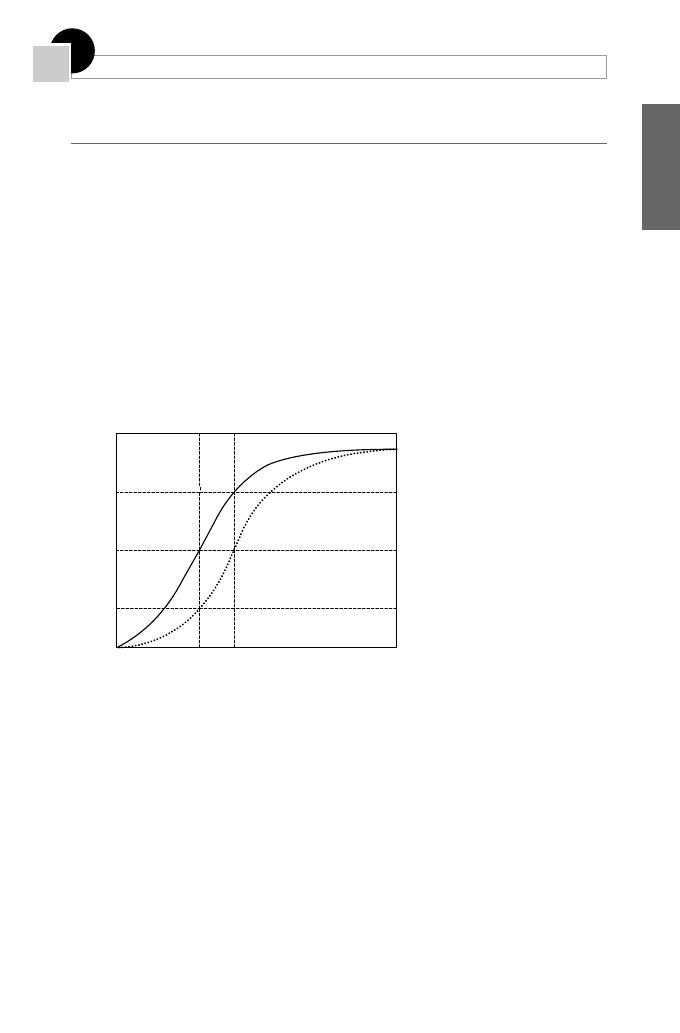
291
12
MCQ Question 692
Figure 12.1 shows two blood oxygen dissociation curves. ‘A’ represents the oxygen partial pres-
sure in normal alveoli, ‘H’ the lowered alveolar oxygen pressure in hypoxic lungs due to high
altitude or pulmonary disease and ‘V’ the mixed systemic venous oxygen pressure in the person
suffering from hypoxia. In this diagram:
a.
If (i) is a normal person’s curve, then (ii) is the hypoxic person’s curve, rather than vice
versa.
b.
The blood in curve (i) has a higher red cell level of 2,3-diphosphoglycerate (2,3-DPG).
c.
The O
2
saturation of blood leaving the hypoxic lungs is lower with curve (ii) than with
curve (i).
d.
The oxygen extracted by the tissues equals oxygen uptake in the lungs for both curves
in both people, other things being equal.
e.
The curve labelled (i) is more suitable for fetal conditions than the curve labelled (ii).
MCQ
100%
0
V
H
A
Z
Y
X
(i)
(ii)
Oxygen partial pressure
Blood o
xygen satur
ation
Figure 12.1

292
Interpretive questions – answers
Answers to 692
a.
True
The hypoxic person’s curve is displaced to the right.
b.
False
2,3-DPG shifts the curve to the right.
c.
True
This is apparent from the graph and is a disadvantage of the increased 2,3-DPG;
notice that at this point the curve is shifted downwards as well as to the right.
d.
True
Neither normal people nor hypoxic people can run up an oxygen debt at rest, so
in both cases pulmonary uptake must balance tissue delivery; in the case of the
hypoxic person, pulmonary uptake corresponds to XY which equals YZ which
corresponds to tissue delivery.
e.
True
Fetal blood is shifted even further to the left and is able to take up O
2
at the low
P
O
2
levels found in the maternal sinusoids.
MCQ
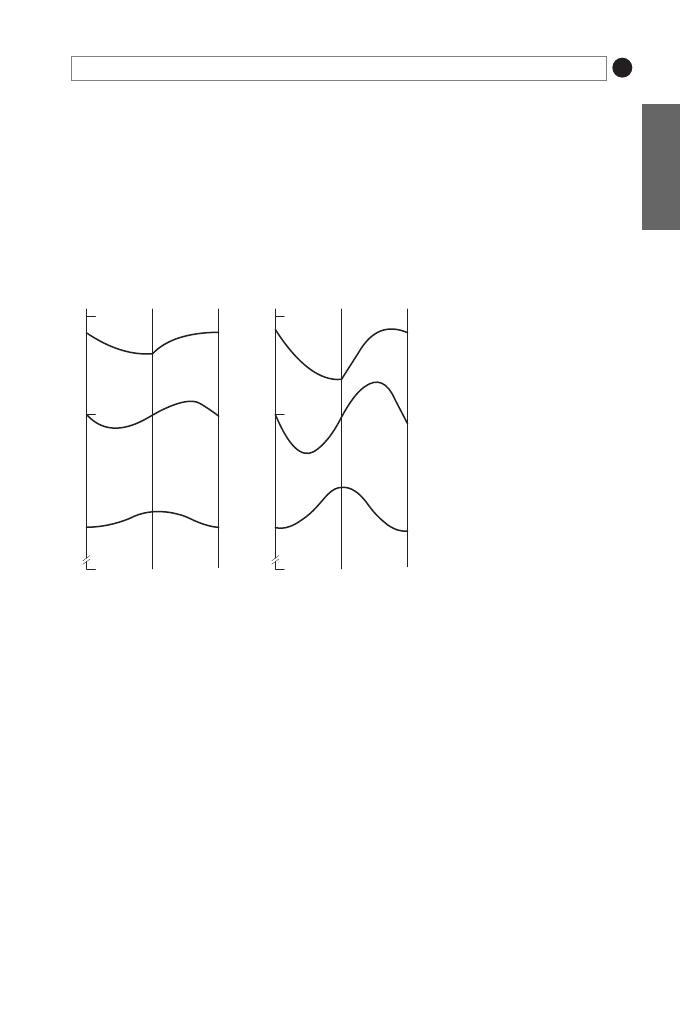
Interpretive questions – questions
293
MCQ Question 693
Figure 12.2 indicates some events during two respiratory cycles, where I
⫽inspiration and
E
⫽expiration. In the second cycle, tidal volume was three times that in the first cycle.
Expiration was not forced. It can be concluded that:
a.
Record A shows the changes in intrapleural pressure.
b.
Record B shows the changes in intrapulmonary pressure.
c.
Record C shows the rate of gas flow into and out of the lungs.
d.
The compliance of the lungs and chest wall is increased markedly in the second cycle.
e.
Maximum airflow occurs at the end of inspiration.
MCQ
0
0
0
I E I E
A
B
C
Figure 12.2

294
Interpretive questions – answers
Answers for 693
a.
True
Intrapleural pressure is negative throughout the cycle and is minimum at the end
of inspiration; it becomes more negative with a deeper inspiration.
b.
True
Intrapulmonary pressure (that is intra-alveolar pressure) reaches its minimum
around mid-inspiration and its maximum around mid-expiration.
c.
False
The flow record closely follows the intrapulmonary pressure record B since flow
is directly related to pressure gradient between alveoli and atmosphere; record C
shows changes in lung volume.
d.
False
Compliance, the volume change for a given pressure change, is similar in both;
though the pressure gradient is increased about three times in the second cycle,
so is the tidal volume.
e.
False
Airflow is zero at end inspiration; it is maximum in mid-inspiration and mid-
expiration.
MCQ
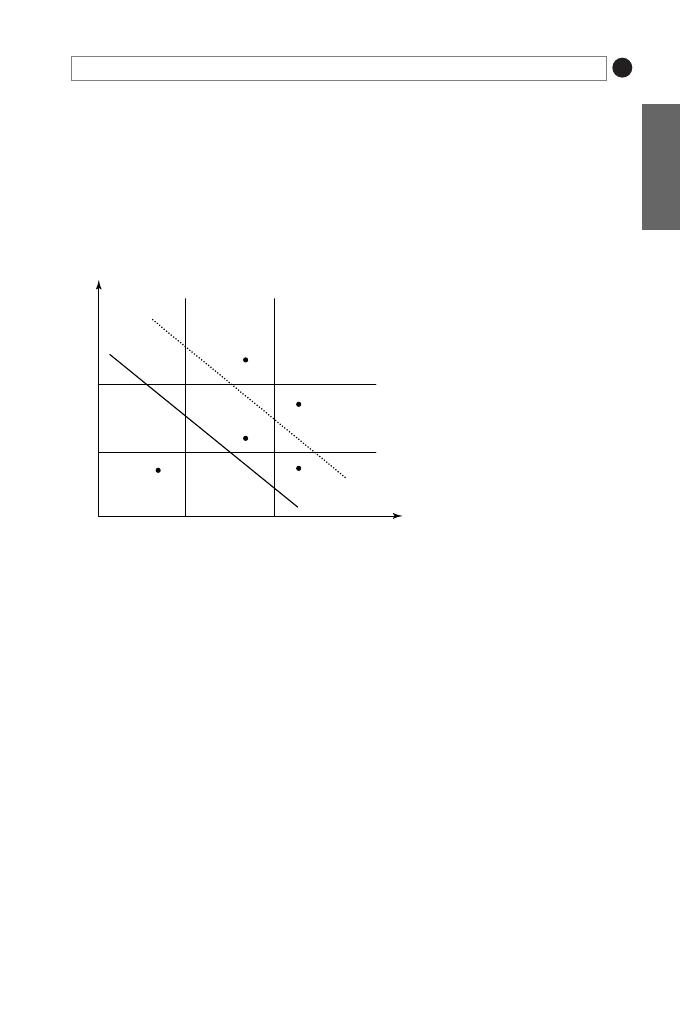
Interpretive questions – questions
295
MCQ Question 694
In the acid–base diagram shown in Figure 12.3, where ‘L’ and ‘U’ represent the lower and upper
levels of normal respectively, a patient whose arterial blood values were found to be at point:
a.
V might have a compensated metabolic alkalosis.
b.
W might have an uncompensated respiratory alkalosis.
c.
X might have a compensated metabolic alkalosis.
d.
Y might have a partly compensated respiratory acidosis.
e.
Z might be suffering from severe vomiting.
MCQ
L
U
U
L
pH
X
Z
V
Y
W
U
L
Log P
CO
2
HCO
3
–
HCO
3
–
Figure 12.3

296
Interpretive questions – answers
Answers for 694
a.
False
Since all parameters are within normal range, acid–base balance is normal; for a
metabolic alkalosis (compensated or uncompensated) the bicarbonate level must
be above normal.
b.
True
The rise in pH is associated with a low P
CO
2
but a normal HCO
3
⫺
.
c.
True
Or a compensated respiratory acidosis; in both cases bicarbonate and carbon
dioxide levels are raised proportionately, so that the ratio P
CO
2
to HCO
3
⫺
is normal,
giving a normal pH.
d.
False
The patient has a partly compensated metabolic acidosis (low bicarbonate); the
low pH indicates incomplete compensation; for a respiratory acidosis the carbon
dioxide level must be above normal.
e.
True
The patient has an uncompensated metabolic alkalosis caused by severe loss of
gastric acid.
MCQ
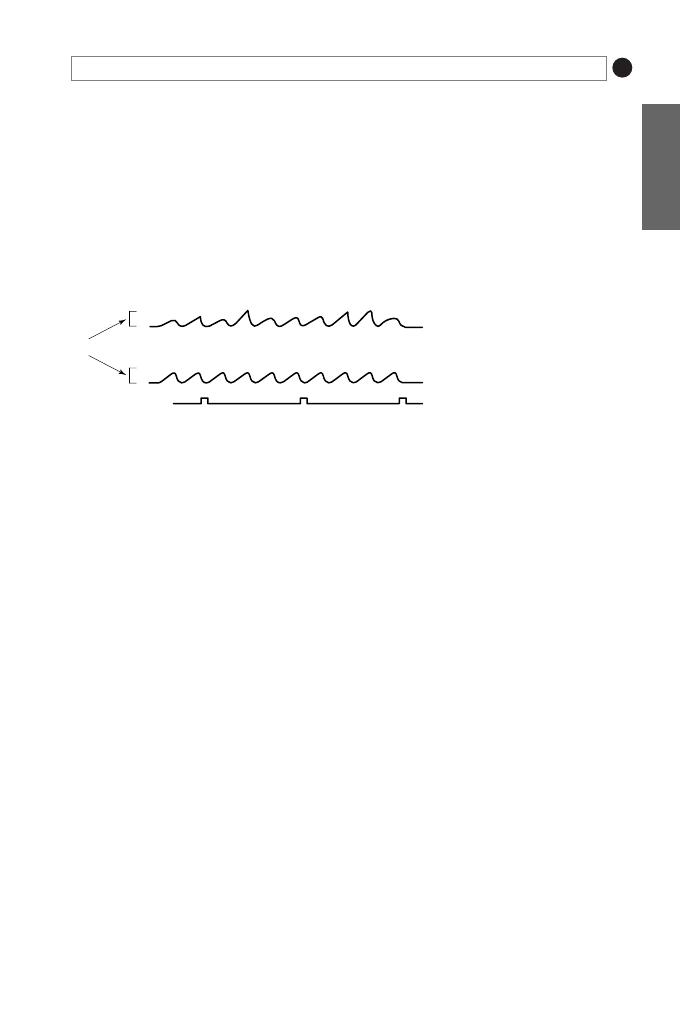
Interpretive questions – questions
297
MCQ Question 695
Figure 12.4 shows simultaneous records of changes in right hand and left forearm volume
when collecting pressures are applied intermittently by means of cuffs on the right wrist and
left upper arm respectively. The volume of the hand in the plethysmograph was 300 ml and the
volume of the forearm was 600 ml. These records (venous occlusion plethysmograms) show:
a.
A greater hand blood flow in the third than in the fourth plethysmogram.
b.
That the rate of blood flow per unit volume of tissue is similar in the hand and forearm.
c.
That hand blood flow is more variable than forearm blood flow.
d.
That forearm blood flow is nearer 20 than 50 ml/minute.
e.
That the collecting cuffs are not occluding the arteries.
MCQ
10 ml
1
2
3
4
5
6
7
8
9
10
Right hand
Left forearm
Minutes
Figure 12.4

298
Interpretive questions – answers
Answers for 695
a.
False
Flow is measured as increase in volume with time and hence is directly propor-
tional to the slope of the volume record during collection.
b.
False
The total blood flow rates are similar on the two sides; since hand volume is half
that of the forearm, its rate of flow per unit volume of tissue is approximately
double forearm flow.
c.
True
The slopes are more variable; the more variable flow is due to greater variability
in the level of sympathetic vasoconstrictor tone.
d.
False
The rate of flow is quite close to 50 ml/minute.
e.
True
If the arteries were occluded, flow would be zero.
MCQ

Interpretive questions – questions
299
MCQ Question 696
Results are given in the table below of a person’s vital capacity (VC), forced expiratory volume
in one second (FEV
1.0
) and peak flow rate (PFR). The subject of these tests:
a.
Is more likely to be a man of 25 than a woman of 65.
b.
Is more likely to be suffering from restrictive lung disease than obstructive airways dis-
ease.
c.
May have asthma, chronic bronchitis or emphysema.
d.
Typically will have an arterial P
CO
2
50 per cent above normal.
e.
May have a compensated respiratory acidosis.
Observed (O)
Predicted (P)
O/P
VC
4.0
5.3 litres
76%
FEV
1.0
2.0
4.4 litres
45%
FEV
1.0
/VC%
50%
83%
56%
PFR
200
645 litres/minute
31%
MCQ

300
Interpretive questions – answers
Answers for 696
a.
True
The predicted values are those of a man of 25 (height 70”, 1.8 m); for a woman
of 65 (63”, 1.6 m), the FEV
1.0
of 2.0 litres would be normal.
b.
False
The relatively severe reduction in FEV
1.0
and PFR are typical of severe obstruc-
tive disease; in restrictive disease, FEV
1.0
and VC are reduced to a similar extent.
c.
True
All of these produce a similar ‘obstructive’ pattern of respiratory function.
d.
False
Respiratory failure is a rare complication of obstructive airways disease.
e.
True
If the condition leads to some carbon dioxide retention. Note: ‘typically’ implies
a majority of cases; ‘may’ implies a possibility, which could be a small minority
of cases.
MCQ
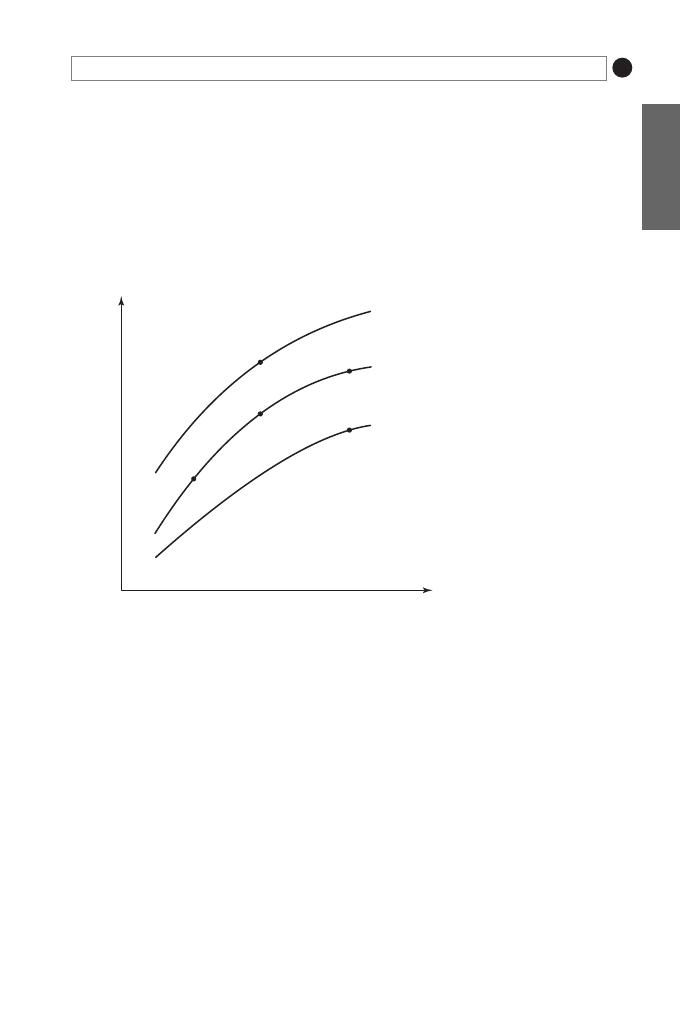
Interpretive questions – questions
301
MCQ Question 697
Figure 12.5 shows left ventricular (LV) function curves of the Frank–Starling type. If point X
on curve B represents the conditions in the normal heart at rest then point:
a.
Z might represent conditions in the failing ventricle at rest.
b.
Y might represent resting conditions in the ventricle in hypertension prior to failure.
c.
Y, rather than point V, might represent conditions in the ventricle after administration
of a beta adrenoceptor agonist drug.
d.
V might represent conditions in a patient with aortic valve stenosis prior to failure.
e.
W might represent the conditions in hypovolaemic circulatory failure.
MCQ
LV End-diastolic pressure
LV
Stro
k
e
w
o
rk
A
B
C
V
X
Y
Z
W
Figure 12.5

302
Interpretive questions – answers
Answers for 697
a.
True
Stroke work is subnormal; end-diastolic pressure increased.
b.
False
In early hypertension the left ventricle hypertrophies; stroke work is greater than
normal at a given filling pressure (point V on curve A).
c.
False
Such a drug, e.g. isoproterenol (isoprenaline), mimics sympathetic stimulation
and moves the ventricular curve upwards and to the left (to a point below V on
curve A).
d.
True
Stroke work is considerably increased, end-diastolic pressure little changed.
e.
True
Ventricular function is normal but filling of the heart is inadequate.
MCQ
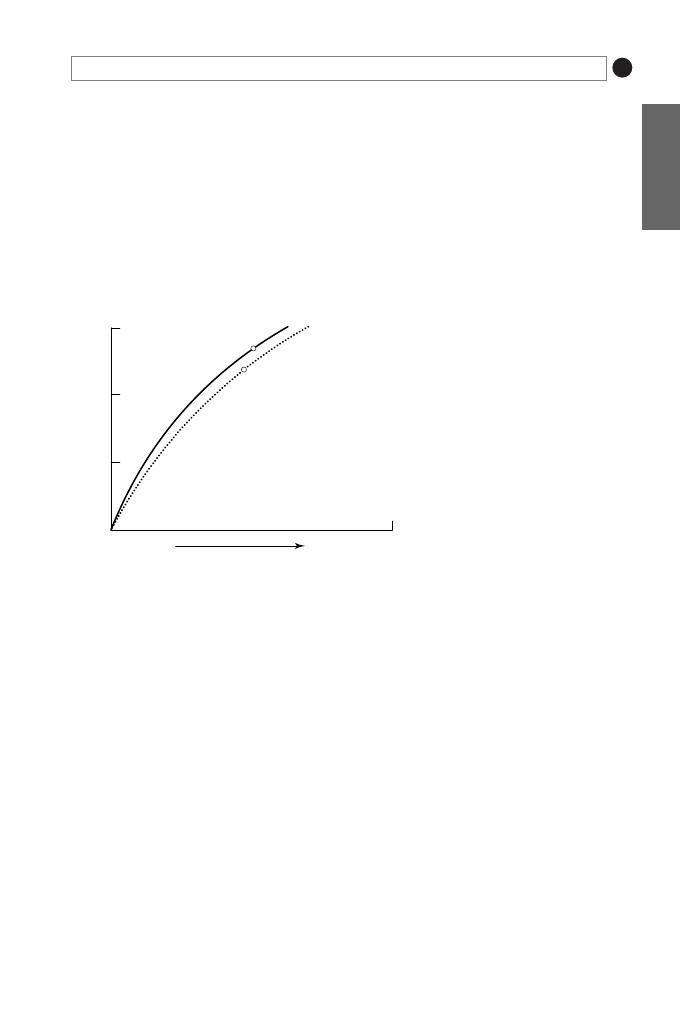
Interpretive questions – questions
303
MCQ Questions 698
In Figure 12.6 showing blood carbon dioxide dissociation curves:
a.
A fall in blood P
O
2
would shift the curve from A to B.
b.
If point X represents the situation at the venous end of systemic capillaries, then point
Y represents the situation of the same blood at the venous end of the pulmonary capil-
laries.
c.
A rise in blood P
CO
2
would shift the curve from B to A.
d.
The decrease in the slope of the curves as P
CO
2
rises is related to the saturation of
plasma with CO
2
as P
CO
2
rises.
e.
At a P
CO
2
of 50 mmHg, the amount of CO
2
in solution is lower in curve B than in curve
A.
MCQ
60
40
20
0
100 mmHg
13.3 kPa
A
B
X
Y
P
CO
2
Blood CO concentr
ation mm
/100 ml
2
Figure 12.6

304
Interpretive questions – answers
Answers for 698
a.
False
The reverse is true; deoxygenated blood can carry more CO
2
than oxygenated
blood at a given carbon dioxide pressure.
b.
True
In the lungs the blood oxygen saturation rises shifting the curve from A to B and
the CO
2
content and pressure fall from point X to point Y.
c.
False
It would merely shift the position on a given dissociation curve.
d.
False
Plasma does not become saturated with CO
2
; CO
2
content remains proportional to
P
CO
2
; the initial sharp rise is due to formation of carbamino compounds – this falls
off sharply as the number of free amino groups declines.
e.
False
The amount of CO
2
in solution is the same for both curves for any P
CO
2
; differ-
ences in total CO
2
content are due to differences in bicarbonate and carbamino
content; at low oxygen pressures, the desaturated haemoglobin is increasingly
more effective in buffering hydrogen ions and, by the law of mass action, favours
formation of bicarbonate ions from carbon dioxide.
MCQ
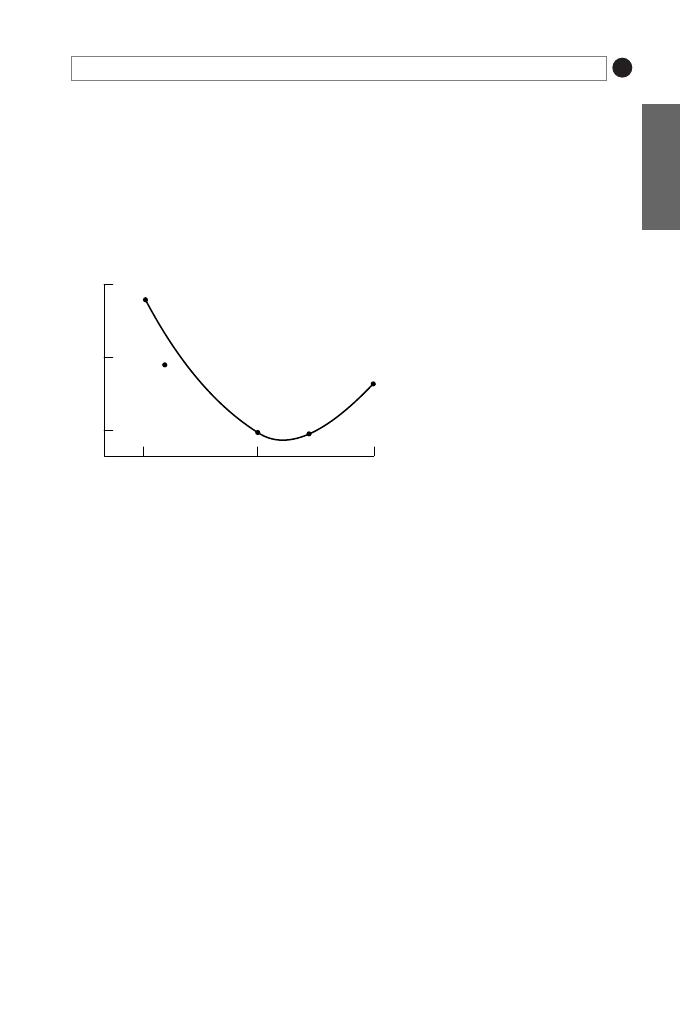
Interpretive questions – questions
305
MCQ Questions 699
In Figure 12.7, the line VXYW represents the threshold of hearing at various frequencies for a
normal subject. The:
a.
Sound waves with the characteristics represented by point Z are audible to the subject.
b.
Interval AB on the ordinate represents 2.0 rather than 20 decibels.
c.
Point D on the abscissa corresponds to 5000 rather than 1000 Hz.
d.
Segment XY includes the frequencies most important in the auditory perception of
speech.
e.
Curve is shifted downwards in the presence of background noise.
MCQ
V
Z
W
Y
X
D
A
B
C
Sound energy
100
10 000 Hz
Figure 12.7

306
Interpretive questions – answers
Answers for 699
a.
False
Anything below the line is inaudible, having less energy than the threshold value
for detection at a particular frequency (Hz).
b.
False
AB and BC both represent 20 decibels; thus sounds at the extremes of the hear-
ing range need relatively high energy to be heard.
c.
False
It corresponds to 1000 Hz; the frequency (or pitch) scale is logarithmic.
d.
True
The ear is most sensitive to sounds in the range 1000–3000 Hz (XY), which
includes the frequencies most important in distinguishing the different words in
speech.
e.
False
It is shifted upwards since extraneous (masking) noise raises auditory threshold,
that is the lowest energy level at which a sound of a particular frequency can just
be detected.
MCQ
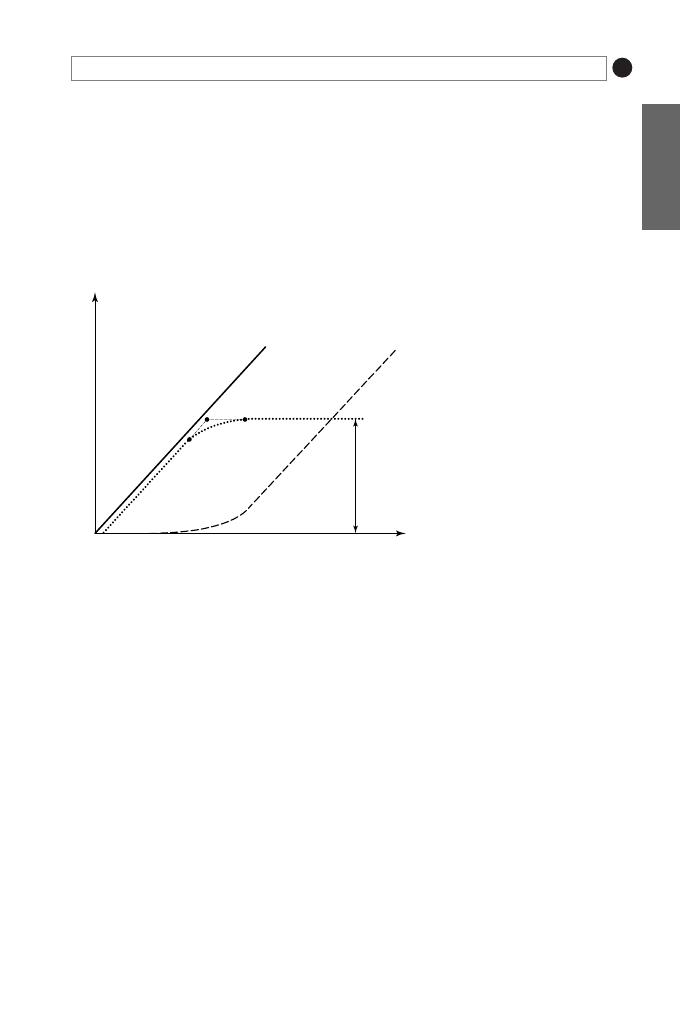
Interpretive questions – questions
307
MCQ Question 700
In Figure 12.8, which illustrates the handling of glucose by the kidney:
a.
Line A represents the rate of glucose filtration by the glomeruli.
b.
Line B could represent the rate of absorption of glucose by the proximal convoluted
tubules.
c.
Line C follows curve DE rather than angle DFE because different nephrons have differ-
ent thresholds.
d.
H indicates the maximal reabsorbing capacity of the kidney for glucose.
e.
Renal poisons such as phlorhizin lower the value of H and shift line B to the right.
MCQ
Glucose mass/min
Plasma glucose concentration
A
B
F
E
C
D
H
0
Figure 12.8

308
Interpretive questions – answers
Answers for 700
a.
True
The rate of filtration is directly proportional to the plasma concentration.
b.
False
Line B represents the rate of excretion of glucose; line C represents glucose reab-
sorbed; at low glucose concentrations absorption increases with the concentra-
tion and is complete; above these levels, EC, the maximal amount of glucose is
absorbed and the rest excreted.
c.
True
Notice that glucose excretion gradually builds up at the same time due to loss of
glucose by the less effective nephrons.
d.
True
The diagram shows features which are typical of a transport system with a lim-
ited maximal reabsorbing capacity.
e.
False
Though H is lowered, the reduction of T
m
(glucose) results in glucose excretion at
lower plasma glucose levels so the line B shifts to the left.
MCQ

Interpretive questions – questions
309
MCQ Question 701
In a patient with a red cell count (RCC) of 4
⫻10
12
/litre, a haemoglobin (Hb) of 7.5 g/100 ml
and a haematocrit of 0.28:
a.
The mean corpuscular haemoglobin (MCH) is nearer 20 picograms (pg) than 20 nano-
grams (ng). 1pg
⫽10
⫺12
g; 1 ng
⫽10
⫺9
g.
b.
The mean cell volume (MCV) is nearer 95 than 70 fl (1 femtolitre
⫽1 m
3
).
c.
The mean corpuscular haemoglobin concentration (MCHC) is nearer 30 than
35 g/100 ml.
d.
The cause of the anaemia is most likely to be vitamin B
12
deficiency.
e.
The patient requires a blood transfusion.
MCQ

310
Interpretive questions – answers
Answers for 701
a.
True
Hb/litre
75g
MCH
⫽
⫽
⫽18.75⫻10
⫺12
g
⫽18.75 pg
RCC/litre 4
⫻10
12
This is below normal (27–32 pg).
b.
False
Red cell volume/litre
0.28
MCV
⫽
⫽
litres
⫽70 fl.
Red cell count/litre
4
⫻10
12
Since the normal volume is about 75–95 fl, these cells are microcytic.
c.
True
Hb
7.5
MCHC
⫽
⫽
⫽26.8 g/100 ml
Haematocrit
0.28
Since the normal MCHV is about 30–35 g/100 ml, these cells are hypochromic.
d.
False
This microcytic, hypochromic picture is characteristic of iron deficiency.
e.
False
Moderate iron deficiency anaemia of this sort responds well to iron therapy:
blood transfusions should not be used unless absolutely necessary.
MCQ
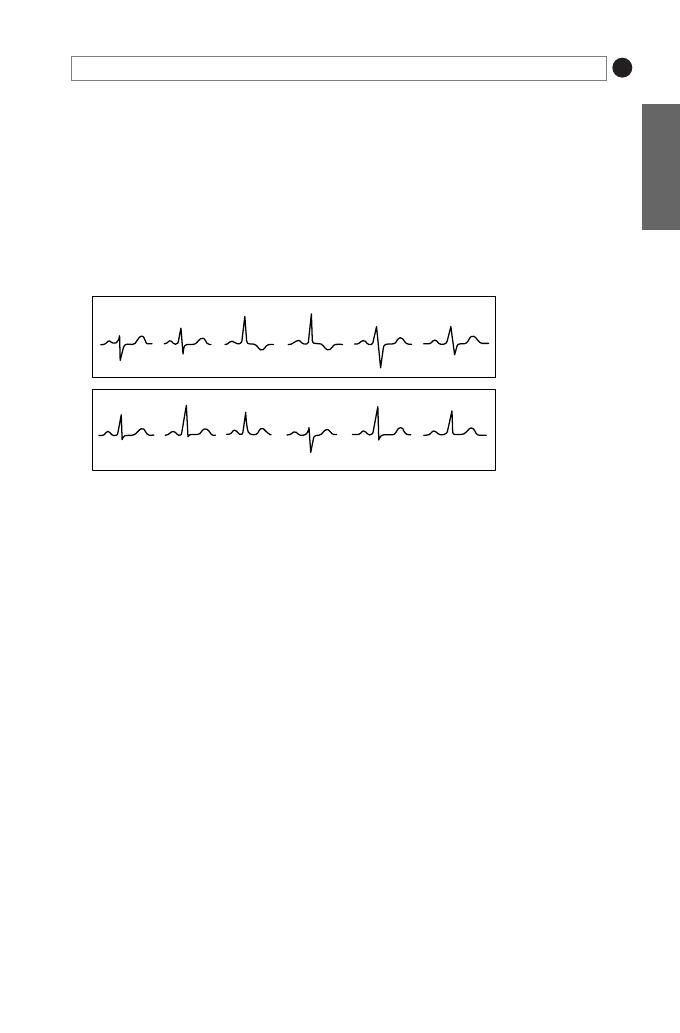
Interpretive questions – questions
311
MCQ Question 702
Figure 12.9 shows two electrocardiogram records from a patient. Record B was taken one year
after record A was obtained. In these records:
a.
The QRS axis in A is directed to the left rather than to the right of vertical.
b.
The QRS complexes V
1
, V
4
and V
6
in A suggest left, rather than right, ventricular hyper-
trophy.
c.
The change from A to B suggests a return towards normality.
d.
The QRS axis in B is directed downwards rather than upwards.
e.
The inversion of T in leads III and V
1
in record A indicates myocardial ischaemia.
MCQ
Lead
I
II
III
(A)
(B)
V
1
V
4
V
6
Figure 12.9

312
Interpretive questions – answers
Answers for 702
a.
False
The net QRS in lead I is negative, indicating an axis to the right rather than the
left; this is confirmed by lead III having a large positive deflection.
b.
False
The R dominance in V
1
and the prominent S wave in V
4
suggest an abnormally
great contribution from the right ventricle in these leads.
c.
True
In record B, V
1
now shows a normal S wave; V
4
has lost its S wave to show only
a normal R wave.
d.
True
It is roughly 60
o
below the horizontal (close to the axis of lead II). The swing from
right (A) to left (B) indicates return of left ventricular dominance, as do the V lead
changes.
e.
False
Occasional T wave inversion is common and usually has no sinister significance.
MCQ
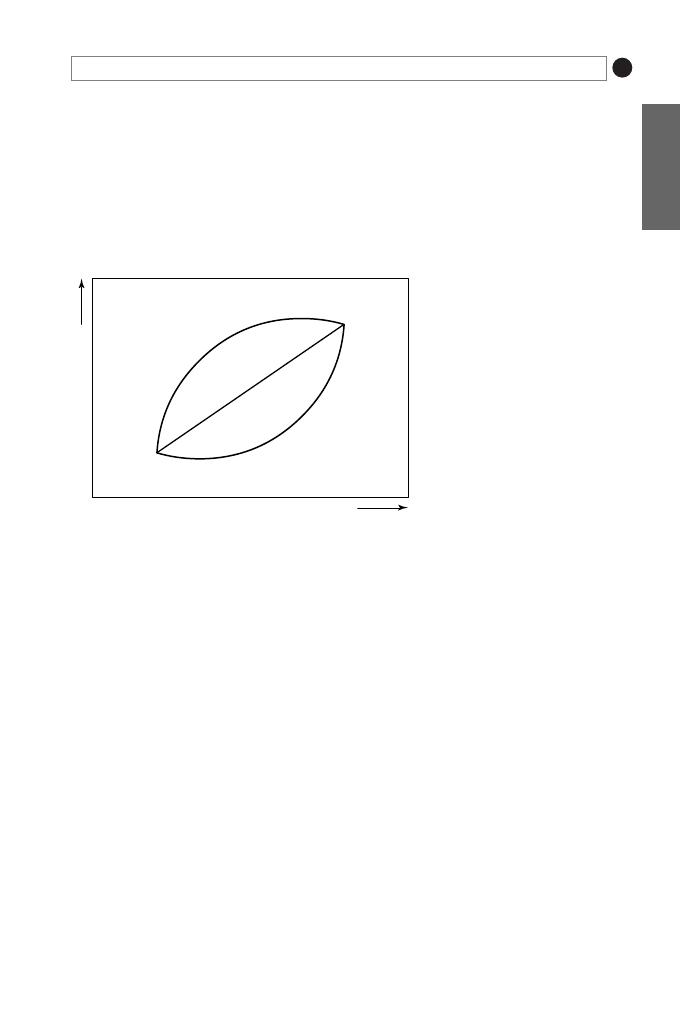
Interpretive questions – questions
313
MCQ Question 703
Figure 12.10 shows some relationships between lung volume (increasing upward) and oesoph-
ageal pressure (increasing to the right) during normal tidal breathing. In this diagram:
a.
The intra-oesophageal pressure is equal to atmospheric pressure at point A.
b.
The changes during the respiratory cycle follow the path ABDC.
c.
The slope of the line AD increases when lung compliance increases.
d.
The width of the loop CB increases when airway resistance increases.
e.
AD increases in length during exercise.
MCQ
Intra-oesophageal pressure
Lung v
olume
C
D
A
B
Figure 12.10

314
Interpretive questions – answers
Answers for 703
a.
False
Intra-oesophageal pressure is similar to intrapleural pressure which is negative
with respect to atmospheric pressure at the beginning of a normal inspiration.
b.
True
In both inspiration (ABD) and expiration (DCA) volume changes lag pressure
changes, thus the relationship is a hysteresis loop, rather than the straight line
AD.
c.
True
Since compliance is volume change per unit pressure change.
d.
True
The greater the airway resistance, the more does air flow lag behind pressure
changes, hence the greater the hysteresis.
e.
True
During exercise, both pressure changes and lung volume changes increase so that
tidal volume increases.
MCQ
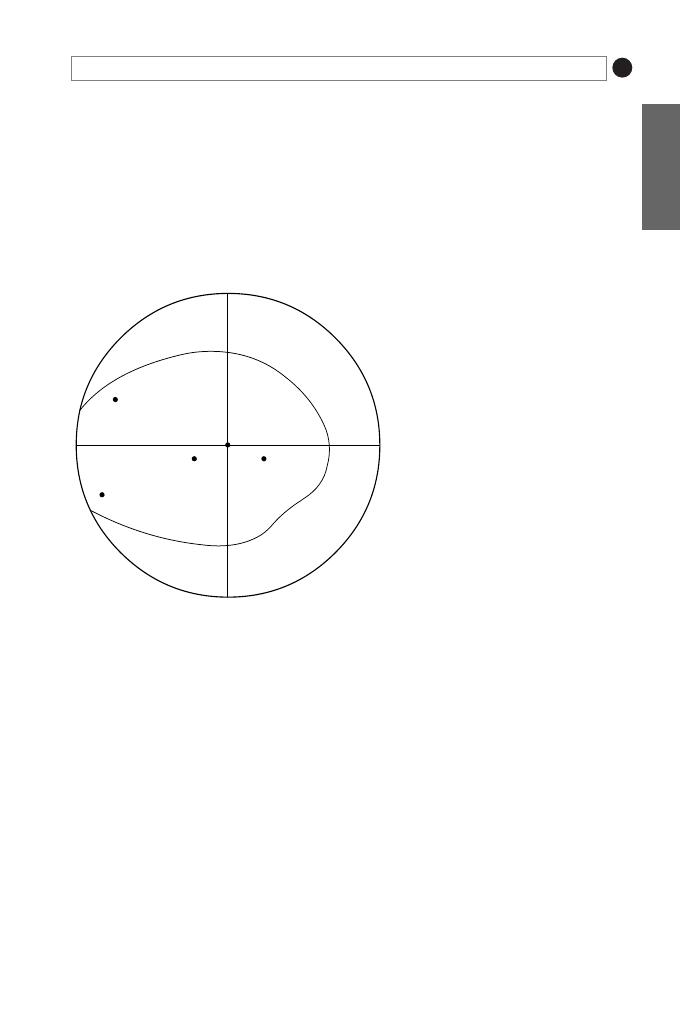
Interpretive questions – questions
315
MCQ Question 704
Figure 12.11 shows the visual field of a normal left eye as plotted by perimetry. When the eye
is focused on point Y, an object at point:
a.
W is detected in the lower nasal quadrant of the left retina.
b.
Y is detected in the region of the fovea of the macula.
c.
Z rather than at point X may be invisible.
d.
W is appreciated as a result of impulses transmitted in the left rather than the right
optic tract.
e.
V is seen in monocular vision.
MCQ
W
Y
X
V
Z
Figure 12.11

316
Interpretive questions – answers
Answers for 704
a.
True
The image is inverted and reversed with respect to the object.
b.
True
The point focused upon is detected at the macula where visual acuity is greatest.
c.
False
The reverse is the case; the optic disc is medial to the fovea, hence the blind spot
is in the temporal (lateral) part of the field of vision.
d.
False
Impulses from the temporal region of the field of vision cross the midline at the
optic chiasma.
e.
True
The visual fields of the two eyes do not overlap for this point.
MCQ
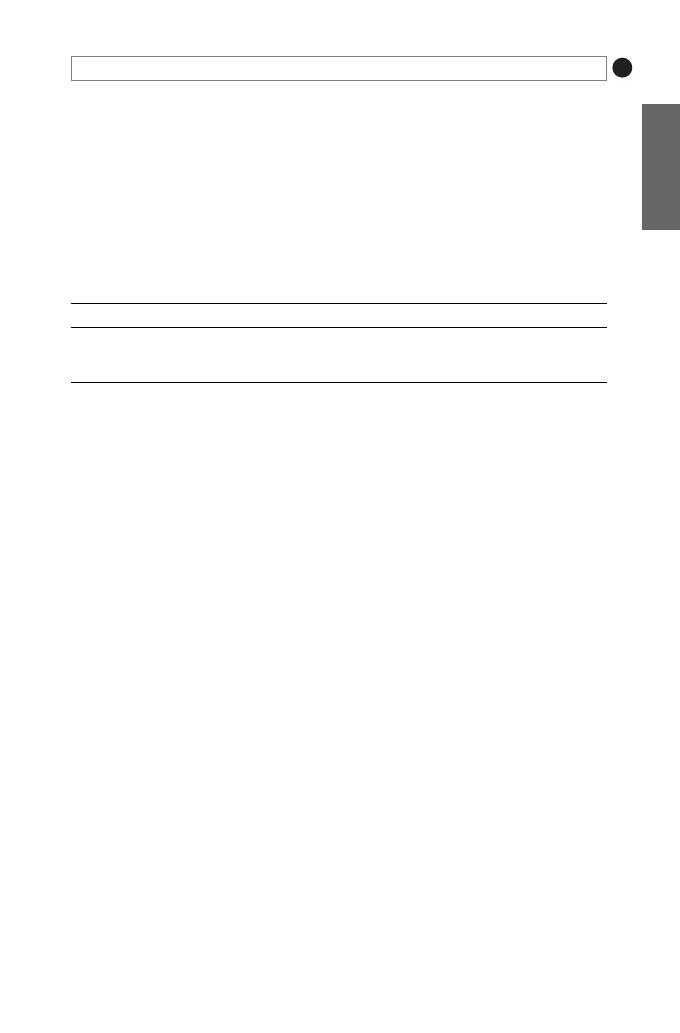
Interpretive questions – questions
317
MCQ Question 705
Samples taken from the ureters of a man with severe one-sided renal artery stenosis gave the
results shown in the table below. Plasma creatinine level was 1 mg/100 ml and the PAH level
was 3 mg/100 ml. In this patient:
a.
Glomerular filtration rate (creatinine clearance) was 10 times as great on the left side as
on the right.
b.
Renal plasma flow was approximately 67 ml/minute on the left.
c.
Renal blood flow was 900 ml/minute on the right (haematocrit
⫽33 per cent).
d.
The right kidney had the narrowed renal artery.
e.
It is likely that he was hypertensive.
Left ureter
Right ureter
Urine volume (ml/minute)
0.2
6.0
Creatinine conc (mg/100 ml)
100.0
10.0
PAH conc (mg/100 ml)
1000.0
150.0
MCQ

318
Interpretive questions – answers
Answers for 705
a.
False
Creatinine clearance (UV/P) was 20 ml/minute on the left and 60 ml/minute
(normal) on the right.
b.
True
From PAH clearance – a very low value.
c.
False
Blood flow
⫽plasma flow⫻1/1⫺Ht⫽300⫻3/2⫽450 ml/minute.
d.
False
The left side had the abnormality.
e.
True
Due to excessive renin release from the ischaemic kidney; the excessive renin
leads to excessive formation of angiotensin I and angiotensin II; the latter con-
stricts blood vessels and increases plasma volume.
MCQ

Interpretive questions – questions
319
MCQ Question 706
Figure 12.12 shows results obtained during a glucose tolerance test on three people. The person
represented by curve B was normal. The oral glucose load was given at time zero. It can be
deduced that:
a.
Curve A is consistent with a diagnosis of diabetes mellitus.
b.
Curve C is more consistent with a diagnosis of an insulin-secreting tumour than of mal-
absorption.
c.
A person showing curve B, who has glucose in the urine 30 minutes after glucose inges-
tion, is likely to have a low renal threshold for glucose.
d.
The renal clearance of glucose two hours after glucose ingestion in patient A is nearer
10 than 30 per cent of the renal plasma flow, assuming a normal renal threshold.
e.
The renal clearance of glucose for the patient showing curve B is likely to be about
60 ml/minute 30 minutes after glucose ingestion.
MCQ
A
B
C
300
200
100
0
15
10
5
0
1
2
3
Hours
Blood glucose (mg/100 ml)
Blood glucose (mmol/l)
Figure 12.12

320
Interpretive questions – answers
Answers for 706
a.
True
The fasting glucose level and the peak level are markedly raised and there is
delayed return of blood glucose to the fasting level.
b.
False
Curve C is typical of the flattening obtained with malabsorption; with an insu-
lin-secreting tumour, the fasting level would tend to be low, with a more marked
rise to a peak and a subsequent trough below the initial level.
c.
True
The normal renal glucose threshold is about 180 mg/100 ml (10 mmol/l).
d.
True
About 150/330 of the filtered glucose is being lost, corresponding to a clearance
of 40–50 per cent of the GFR, i.e. about 60 ml which is about 10 per cent of renal
plasma flow.
e.
False
Since blood glucose does not exceed the renal threshold for glucose, renal clear-
ance will be zero.
MCQ
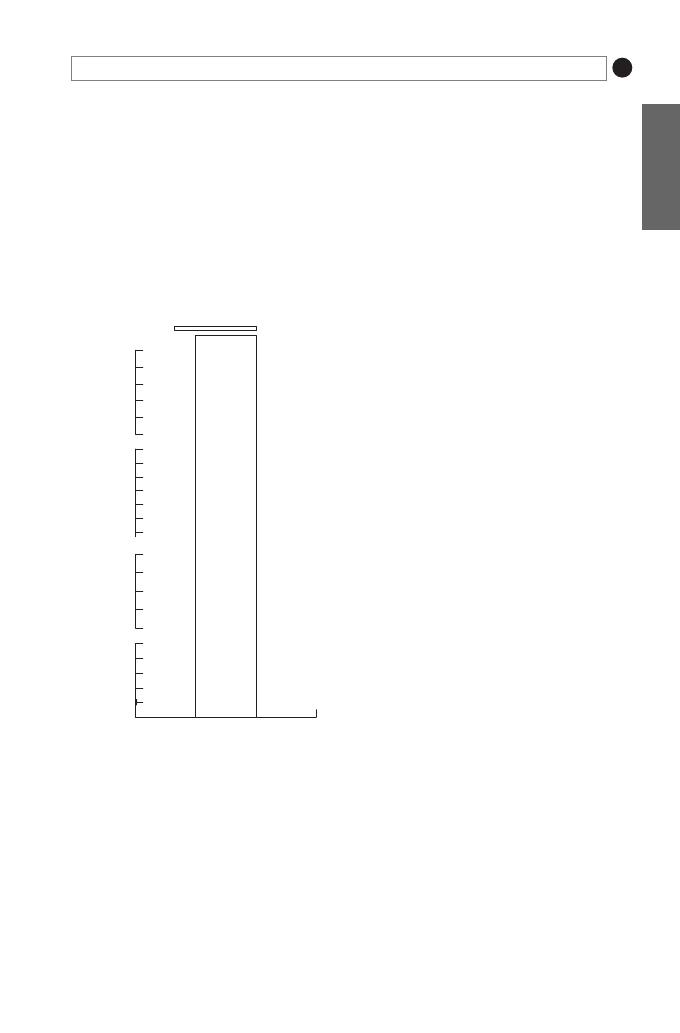
Interpretive questions – questions
321
MCQ Question 707
Figure 12.13 shows mean results of experiments in which sheep fetal (A) arterial pressure, (B)
heart rate, (C) femoral artery blood flow and (D) femoral vascular resistance were measured
before, during and after a period (marked by the rectangle) when the mother was made
hypoxic. The results suggest that:
a.
Maternal hypoxia causes a 50 per cent rise in fetal blood pressure.
b.
The fall in femoral blood flow with maternal hypoxia is due to the slowing of the heart.
c.
Maternal hypoxia causes vasoconstriction in the fetal lower limbs.
d.
The fetal responses are similar to those seen in the diving reflex seen in seals and other
animals that dive under water.
e.
The response might aid survival by redistributing cardiac output towards the brain.
MCQ
(A)
(B)
(C)
(D)
60
50
40
200
150
100
50
30
10
4
2
0
0
1
2
3
Hours
(mmHg)
(ml min )
–1
mmHg (ml/min )
–1
(beats min )
–1
(After Sanhueza et al. J. Physiol. (2003) 546, 899.)
–1
Figure 12.13

322
Interpretive questions – answers
Answers for 707
a.
False
The increase is not more than 25 per cent – from a mean value around 46 mmHg
to a mean value around 56 mmHg in the second half of the period of hypoxia.
b.
False
Blood flow is not normally a function of heart rate; notice that the change in
heart rate was modest – from around 175 to around 140 beats per minute and it
was accompanied by a rise in arterial pressure (A).
c.
True
The fall in flow despite the increase in perfusion pressure indicates vasoconstric-
tion and this is confirmed by the rise in femoral vascular resistance – resistance
rose about three-fold when flow fell to about one third.
d.
True
Diving animals show a bradycardia and peripheral vasoconstriction when they
dive under water.
e.
True
The vasoconstriction in the lower body diverts a greater fraction of the cardiac
output to the cerebral circulation which does not constrict in response to a
hypoxic stimulus.
MCQ
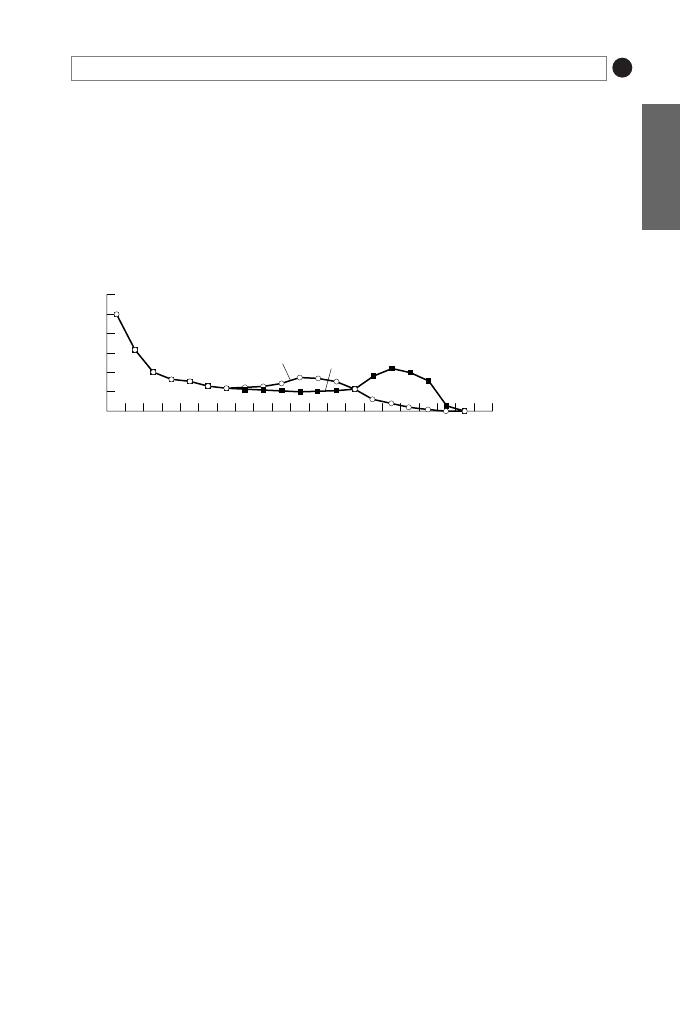
Interpretive questions – questions
323
MCQ Question 708
Figure 12.14 shows the growth rates of males and females from birth to 20 years. It indicates
that:
a.
Growth for both sexes is most rapid between the ages of 0 and 2 years.
b.
Boys and girls have similar growth rates around age 13–14.
c.
Boys stop growing at a later age than girls.
d.
Boys grow less quickly at age 5 than at age 16.
e.
The growth rate for girls of 12 is less than for boys of 16.
MCQ
30
25
20
15
10
5
0
1
2
3
4
5
6
7
8
9 10 11 12 13 14 15 16 17 18 19 20 21
Age in years
Growth rates in boys and girls
cm per y
ear g
ro
w
th
Boys
Girls
Figure 12.14

324
Interpretive questions – answers
Answers for 708
a.
True
But it falls rapidly over this period by about half.
b.
True
They are about the same but the growth rate in girls is decreasing whereas that
of boys is increasing.
c.
True
The curve for boys is about two years to the right of that for girls; girls stop
growing at about 16-18 whereas boys continue to grow until they are about 18-
20.
d.
True
Their height gain per year is much lower at 5 than at 16 years.
e.
True
Boys have a greater growth spurt than girls and on average attain greater adult
height.
MCQ
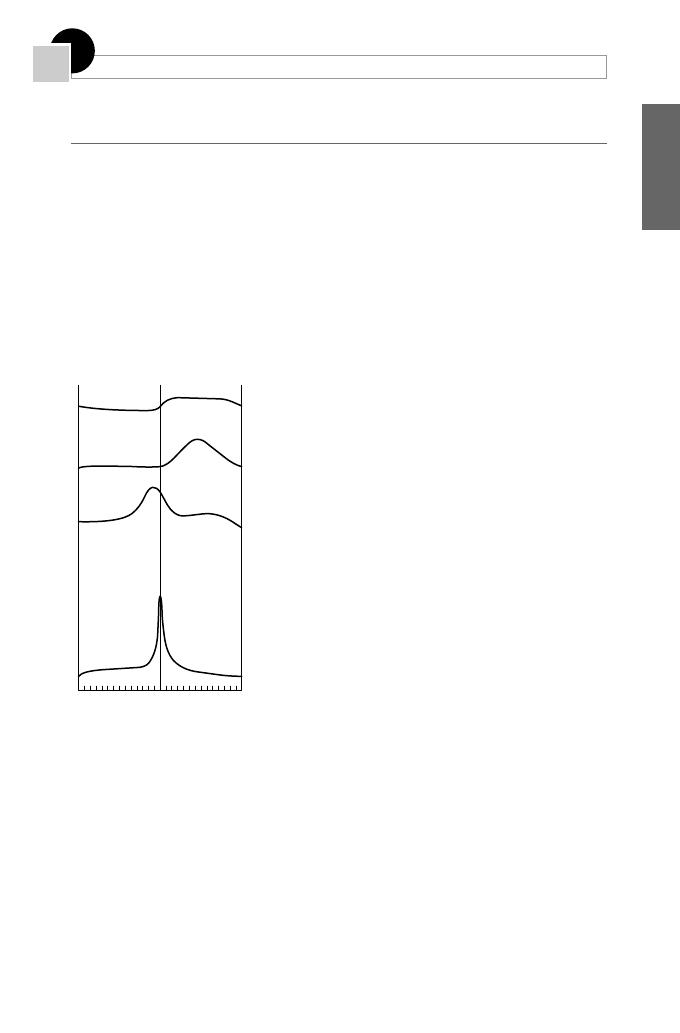
INTERPRETIVE QUESTIONS
325
12
EMQ Question 709
Figure 12.15 shows some of the changes that occur throughout the phases of a menstrual cycle.
For each of the physiological variables a–e below, select the most appropriate option from the
following list of traces.
1. Trace A.
2. Trace B.
3. Trace C.
4. Trace D.
a.
Oestradiol level.
b.
Core temperature.
c.
Luteinizing hormone level.
d.
Progesterone level.
e.
Inhibin level.
A
B
C
D
14
28
Days
0
Figure 12.16
Figure 12.15
EMQ

326
Interpretive questions – answers
Answers for 709
a.
Option 3
Trace C. Oestrogens produced by the follicular cells of the developing ovum
dominate the follicular phase of the cycle and peak about the time of ovulation; the level
is still somewhat raised during the luteal phase.
b.
Option 1
Trace A. Core temperature tends to rise about the time of ovulation and then
falls again coming up to the following menstruation.
c.
Option 4
Trace D. Luteinizing hormone secretion peaks at about the time of ovulation
(in a similar manner to follicle-stimulating hormone, but its concentration tends to be
greater).
d.
Option 2
Trace B. Progestogens formed by the corpus luteum dominate the luteal
phase of the cycle and cause the endometrium to enter the secretory phase.
e.
Option 2
Trace B. Inhibin is a hormone produced by the ovary that inhibits secretion
of follicle-stimulating hormone by the anterior pituitary gland. It peaks in the luteal phase
of the cycle with a time course similar to the progestogen level.
EMQ
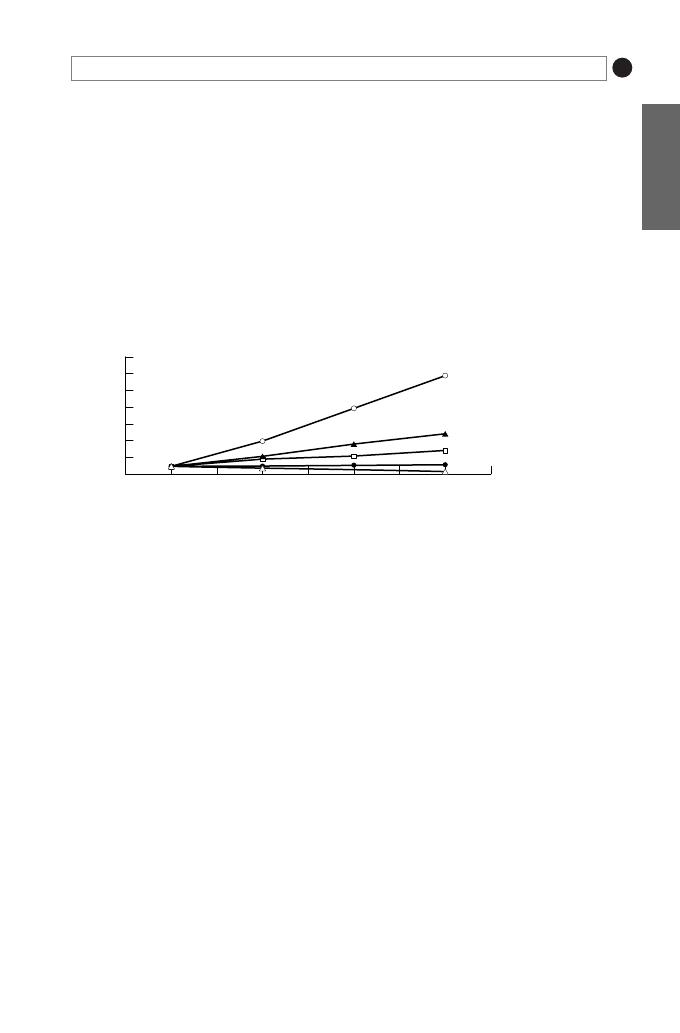
Interpretive questions – questions
327
EMQ Question 710
Figure 12.16 shows the effect of increasing grades of exercise (from rest in period 1 to near
maximal exercise in period 4) on some cardiovascular and respiratory variables. For each of
the traces A–E, select the most appropriate variable from the list below.
1. Oxygen consumption.
2. Cardiac output.
3. Heart rate.
4. Mean arterial pressure.
5. Total peripheral resistance.
a.
Trace A.
b.
Trace B.
c.
Trace C.
d.
Trace D.
e.
Trace E.
EMQ
1400
1200
1000
800
600
400
200
0
P
ercentage
1
2
3
4
Exercise workload
Effect of exercise on some physiological variables
A
B
C
D
E
Figure 12.16

328
Interpretive questions – answers
Answers for 710
a.
Trace A: Option 1
Oxygen consumption. Oxygen consumption can increase during
exercise from a resting value of 0.25 litre/minute to 3 litres/minute (1200 per cent) or
more.
b.
Trace B: Option 2
Cardiac output. Cardiac output increases fairly linearly with
increasing exercise from a resting value of about 5 to a peak value of over 20 litres per
minute.
c.
Trace C: Option 3
Heart rate. Heart rate increases fairly linearly with exercise from
a resting value of about 60 to a maximum of about 180 (220 minus age in years) beats
per minute, a rise to about 300 per cent of the resting value.
d.
Trace D: Option 4
Mean arterial pressure. Though cardiac output rises markedly in
exercise, peripheral resistance falls markedly; rises in mean pressure are usually slight.
e.
Trace E: Option 5
Total peripheral resistance. Total peripheral resistance falls mark-
edly due to vasodilation in the exercising skeletal muscles
EMQ
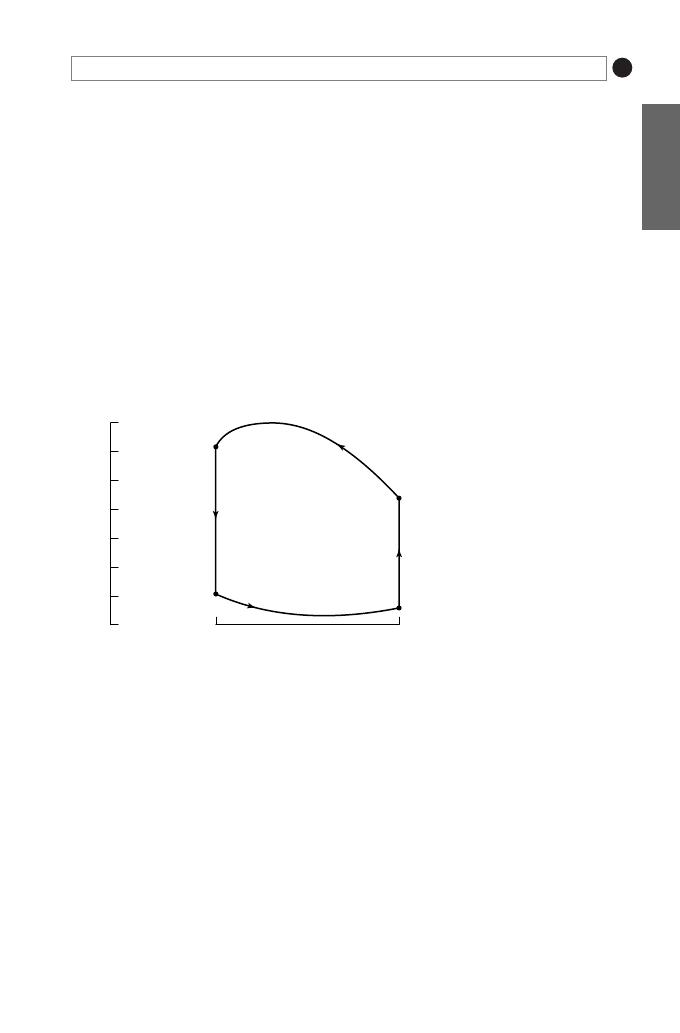
Interpretive questions – questions
329
EMQ Question 711
Figure 12.17 shows four points on the pressure–volume diagram of a left ventricle. For each
of the descriptions a–e below, select the best option from the following list of points and lines.
1. D
2. C
3. A
4. B
5. DC
6. DA
7. AB
8. CB
9. CD
10. AD
11. BA
12. BC
13. ABCD
14. DCBA
15. DCAB
16. ADCB
a.
The beginning of diastole.
b.
The end of systole.
c.
Isometric contraction.
d.
The segment between two points where the trace would depart maximally from a
straight line.
e.
One cardiac cycle starting with the onset of diastolic filling.
EMQ
120
80
40
0
Pressure (mmHg)
40
120
Volume (ml)
D
A
C
B
Figure 12.17

330
Interpretive questions – answers
Answers for 711
a.
Option 1
D. At the beginning of diastole ventricular volume is around 50 ml and the
pressure is around 120 mmHg (above atmospheric) because the isometric phase of diastole
has not yet occurred.
b.
Option 1
D. At the end of systole, ventricular volume has returned to 50 ml and the
pressure is around 120 mmHg, having fallen from a maximal value around 140 mmHg as
the aortic valve closes.
c.
Option 12
BC. By definition volume is unchanged during isometric contraction, while
pressure rises from about zero to a level which will open the aortic valve at arterial dias-
tolic pressure, around 90 mmHg; thus isometric contraction is represented by the vertical
line BC.
d.
Option 9
CD. The two segments BC and DA represent isometric systole and isometric
diastole, so are completely straight. During ventricular filling, AB, there is a small (around
5 mmHg) rise in pressure during atrial systole. In contrast, during the ejection phase of
ventricular systole, CD, the pressure rises from arterial diastolic to arterial systolic (from
around 90 to 140 mmHg) and then falls back to around 120 mmHg as the aortic valve
closes.
e.
Option 13
ABCD. Diastolic filling starts when ventricular volume is around 50 ml and
its pressure close to atmospheric. The pressure–volume trace then moves to B where filling
is complete, and continues in an anti-clockwise direction.
EMQ
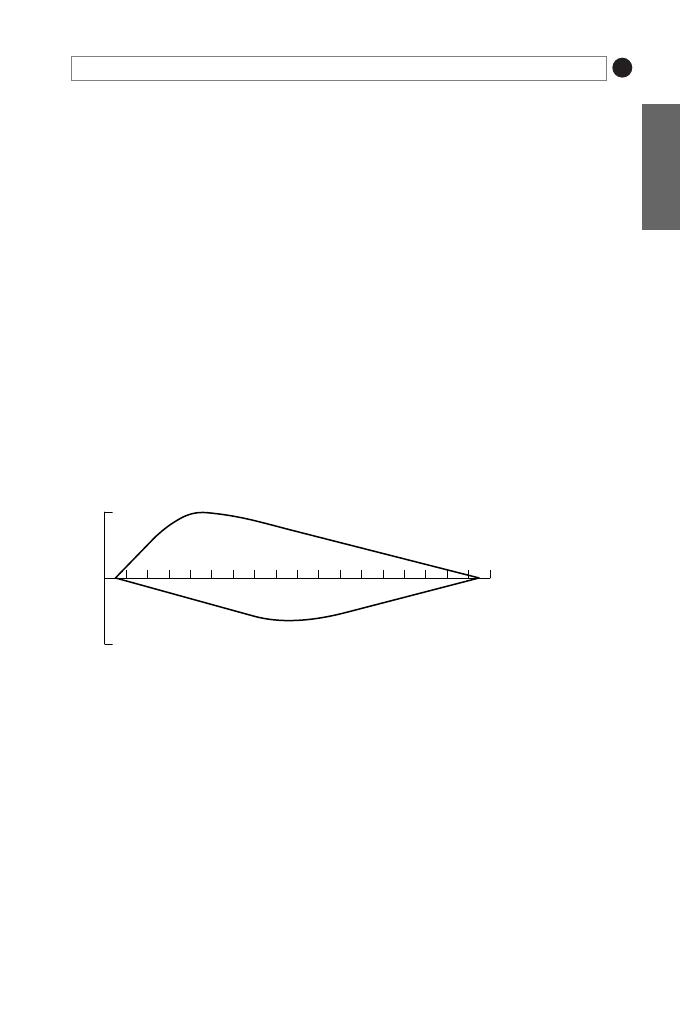
Interpretive questions – questions
331
EMQ Questions 712
Figure 12.18 shows four points on the flow–volume diagram of the lungs of a healthy young
man. W is the lung volume at total lung capacity and Y is the lung volume at residual volume.
Z and X represent maximal outflow and maximal inflow respectively. The person has breathed
in and out a vital capacity as quickly as possible. For each of descriptions a–e below, select the
best option from the following list of points, lines and areas.
1. W
2. X
3. Y
4. Z
5. WZ
6. ZW
7. ZY
8. YZ
9. WX
10. XW
11. XY
12. YX
13. ZX
14. XZ
15. Totally inside the loop below.
16. Partially outside the loop below.
a.
The line which corresponds most closely to the first part of a forced expiratory volume
in one second manoeuvre.
b.
The point at which lung volume is closest to one litre.
c.
The position of the loop during strenuous exercise in the same person.
d.
The final part of the manoeuvre of measuring a fast vital capacity.
e.
The point at which intra-alveolar pressure is likely to be most negative.
EMQ
6
0
– 6
W
Z
X
Y
Air flo
w
Lung volume
Flow volume diagram for lungs
Figure 12.18

332
Interpretive questions – answers
Answers for 712
a.
Option 5
WZ. The manoeuvre starts at total lung capacity and the volume expired in
the first second is measured.
b.
Option 3
Y. The residual volume of a healthy young man is usually a little over a litre.
c.
Option 15
Totally inside the loop. Although volumes and flows increase with exercise,
they are still below the maximal; the loop for tidal breathing is smaller still.
d.
Option 7
ZY. After the first second of rapid expiration the person must continue
breathing out until residual volume is reached, usually in a further second or two.
e.
Option 2
X. This is the point of maximal inflow; at this point the pressure gradient
between atmosphere and alveoli is also maximal, with alveolar pressure subatmospheric.
EMQ

Interpretive questions – questions
333
EMQ Question 713
Figure 12.19 shows some of the effects of simulating mildly increased gravitational stress by
lower body suction. For each of the physiological variables a–e below, select the most appro-
priate option from the following list of trends.
1. Trend A.
2. Trend B.
3. Trend C.
a.
Forearm blood flow.
b.
Cardiac output.
c.
Mean arterial pressure.
d.
Total peripheral resistance.
e.
Renin secretion.
EMQ
200
100
0
1
2
3
4
5
Grade of lower body suction
Change from control
Effect of lower body suction
B
A
C
Figure 12.19

334
Interpretive questions – answers
Answers for 713
a.
Option 3
Trend C. The forearm blood flow falls as part of the general vasoconstric-
tion that helps to maintain arterial blood pressure.
b.
Option 3
Trend C. As the blood pools in the lower body due to suction, the filling
pressure of the heart decreases and so the cardiac output falls.
c.
Option 1
Trend A. During this relatively mild gravitational stress, arterial pressure is
quite well maintained by mechanisms that compensate for the shift of blood volume
towards the feet.
d.
Option 2
Trend B. The shift of blood initiates reflex mechanisms to increase total
peripheral resistance to help to maintain arterial pressure.
e.
Option 2
Trend B. The diminished blood flow to the kidneys with vasoconstriction
related to the fall in cardiac output and output results in the release of renin from the jux-
taglomerular apparatus that again helps to maintain arterial blood pressure.
EMQ

Interpretive questions – questions
335
Question 714
Figure 12.20 shows the effects of intravenous adrenaline and noradrenaline infusions on some
cardiovascular variables. For each event or trace a–e below, select the best option from the fol-
lowing list.
1. Arterial pressure.
2. Heart rate.
3. Cardiac output.
4. Peripheral resistance.
5. The period of adrenaline infusion.
6. The period of noradrenaline infusion.
a.
Event A.
b.
Trace C.
c.
Trace D.
d.
Trace E.
e.
Trace F.
EMQ
150
100
50
30
20
10
100
50
8
6
4
15
20
35
40
Time (min)
A
B
D
F
C
E
(After Barcroft and Swan (1953) Sympathetic Control of Human Blood
Vessels, Edward Arnold, London.)
Figure 12.20

336
Interpretive questions – answers
Answers for 714
a.
Event A: Option 5
Period of adrenaline infusion. This corresponds to a period of
increased heart rate and widening of the pulse pressure with a fall in diastolic pressure,
whereas at the second event heart rate decreased and both systolic and diastolic pressure
increased, indicating that noradrenaline was infused during period B.
b.
Trace C: Option 2
Heart rate. Adrenaline accelerates the heart but noradrenaline
causes reflex slowing produced by the steep rise in mean arterial pressure. This is the only
scale giving an initial value (around 80) corresponding to a normal (slightly apprehensive)
heart rate.
c.
Trace D: Option 1
Arterial pressure. Adrenaline lowers the diastolic pressure but
noradrenaline raises it. This is the only dual trace corresponding to systolic and diastolic
pressures; the initial value 130/80 corresponds to normal blood pressure.
d.
Trace E: Option 3
Cardiac output. Adrenaline raises cardiac output but noradrena-
line reduces it because of the reflex depression of cardiac activity. Again the scale corre-
sponds to an initially normal/slightly raised cardiac output around 6–7 litres/minute.
e.
Trace F: Option 4
Peripheral resistance. Noradrenaline raises total peripheral resis-
tance because of its predominant effect on alpha adrenoceptors which mediate vasocon-
striction; adrenaline lowers it because of its predominant effect on beta adrenergic
receptors which mediate vasodilation. These units are appropriate for peripheral resis-
tance: from the equation
Mean arterial pressure
⫽Cardiac output⫻Peripheral resistance
we can derive that
Peripheral resistance
⫽Mean arterial pressure/Cardiac output
For the initial state this equals approximately 100/7
⫽14–15 as in F (the units are
mmHg/litre/minute).
Note that for this question it was necessary to consider all aspects of the diagram together,
rather than consecutively.
EMQ

‘A’ wave of venous pulsation in neck, 123
abdominal pressure, 188
ABO blood group see blood group antigens
absolute refractory period, ventricles, 79
absorption, 218, 224, 250, 255
calcium, 255, 502
fat/lipid, 218, 223, 255, 258
glucose, 246, 255, 258
intestinal, 246, 250
sodium see sodium
vitamin B
12
see also reabsorption
accommodation for near vision, 351, 385
loss of ability, 385
ACE inhibition, 478
acetylcholine, 292
acetyl-coenzyme A, 644
Achilles (ankle jerk) reflex, 302
acid—base balance see pH
acidosis, 624
bicarbonate administration, 66
metabolic, 41, 508, 641
hypokalaemic acidosis, 444
in renal failure, 647
respiratory, 42, 59, 434, 641, 694, 696
acquired immune deficiency syndrome see AIDS
action potentials, 642
Addison’s disease, 510
adenohypophysis see pituitary gland, anterior
adenosine triphosphate (ATP), 644
adrenal gland
adrenaline secretion, 461
cortex
CRH effects on activity, 512
decreased activity, 510
hormones secreted by, 475
paediatric overactivity, 504
failure, 495
medulla
overactivity, hypertension with, 509
tumour, 485, 509
adrenaline, 461, 467
adrenal secretion, 461
injection/infusion, 101, 452, 714
gastric motility decrease with, 257
adrenocorticotrophic hormone (ACTH), 447,
479
afferent inhibition, 649
age-related changes, 601, 606
body mass, 610
females, 576
lens elasticity, 385
respiratory system/function, 144
special senses, 380, 394
agglutinogens see blood group antigens
AIDS and HIV disease, 57
air
flow (gas flow) in lungs, 693, 694
see also flow—volume diagrams
in pleural cavity, 171
albumin, plasma, 10, 65
aldosterone, 413, 440
antagonist, 423
secretion, 413, 415
increased, 445
alerting reactions, 648
alimentary tract, 195-260
motility, 252, 257, 260
surgical removal of various parts, 259
see also specific regions
alkaline mucus, secretion, 253
alkalosis
metabolic, 41, 59, 694
respiratory, 41, 43, 45, 694
alpha-adrenoceptors see adrenoceptors
alpha rhythm (EEG), 281
altitude see high altitude
alveolar pressure, 188, 693
alveolar ventilation in breathing, 148
amblyopia, 387
amenorrhoea, 510
secondary, 545
athlete, 663
ammonia, renal handling, 436
amniotic fluid, 542
ampullary crest (crista ampullaris), 390, 646
amylase, 254
anaemia, 35, 62, 701
in gastric juice deficiency, 256
hypoxia in, 194
iron-deficiency, 36, 62, 701
in renal failure, 647
anaerobic activity, 690
metabolism in, fitness measurement, 687
androgens, 505, 520
female secretion, 566
angina, 113
angiotensin I/II, 419, 439
angiotensin-converting enzyme inhibition, 478
ankle jerk reflex, 302
anorexia, 198
anosmia, 394
antibodies, 13
ABO blood group see blood group
antidiuretic hormone (vasopressin), 440, 455, 503
deficiency and insufficient secretion (and diabetes
insipidus), 421, 482, 511
blood group see blood group antigens
antihaemophilic globulin (factor VIII) deficiency, 54,
anxiety, sporting event, 683
aortic chemoreceptors, 158
aortic valve, 130
incompetence, 119
stenosis, 697
aphasia, 307
apoferritin, 255
appendicectomy, 259
appetite loss, 198
aqueous humour, 360
337

338
Index
arousal in competitive sport, 679
arrhythmias
dialysis patient, 441
electric shock causing, 622
sinus, 595
baroreceptor reflexes, 333
blood analysis, 189
blood gases see blood gases; carbon dioxide;
oxygen
blood pressure see blood pressure
chemoreceptors, 132
elasticity, 129
fetal, pressure in maternal hypoxia (sheep), 707
leg, narrowing of major vessels, 114
pulse contours, 115
stretch receptors, 132
resistance, 96, 129
wall thickness, 129
arteriovenous anastomoses in temperature
ascending reticular formation, 269
ascorbic acid (vitamin C) deficiency, capillary
assisted reproduction, multiple pregnancy, 568
astereognosis, 394
asthma, 170
exercise in, 661
astigmatism, 394
asystole see heart, arrest
athletes
maximal exercise, 663
physical fitness see fitness
training, 599, 654
see also exercise
100mmHG, sudden exposure, 618
middle ear equalization with, 391
atonic bladder with overflow, 435
ATP, 644
atria
chemoreceptors, 132
dysfunction, P wave abnormalities, 134
fibrillation, 106
pressure increase in right when lying down, 135
atrial natriuretic peptide, increased secretion, 510
atrioventricular bundle interruption, 118
atrioventricular node, impulse conduction delay,
injection, 612
ocular instillation, 374
audition/hearing, 390-1
audiogram, 370, 699
disorder, 394
sound waves and transmission, 363, 389, 390,
391, 646
auditory ossicles, 391
auditory reflexes, 391
auscultation
blood pressure measurement, 78
bruits, 116
heart, 108, 116
automatic bladder, 435
autonomic nervous system, 292, 337
cardiac function and, 81, 86, 333, 337
see also parasympathetic nervous system;
sympathetic nervous system
autoregulation of blood flow, 131
autosomal genetic disorders
dominant, 635
recessive, 625
action potential, 289
myelinated see myelinated axons
non-myelinated, 290, 334
bacteria, Kupffer cell ingestion of, 253
balance problems, 371, 382
baroreceptor reflexes, 645
basilar membrane, cochlea, 345, 368, 391
beta-adrenoceptors see adrenoceptors
bicarbonate (HCO
3
)
administration in acidosis, 66
levels, 189
in acid—base imbalance, 59
in respiratory failure, 59, 647
reabsorption, 442
intestinal entry, 258
salts, 195, 217, 251, 255
biliary system
obstruction, pale stools, 256
stones, 227
bilirubin, plasma, 7
birth see neonates; parturition
bitter taste sensation, 392
bladder
abnormalities, 435
emptying, 426
pressure recording, 422
sympathectomy, 431
bleeding/haemorrhage
arresting see haemostasis
blood volume restoration after, 619
capillaries after, 136
from capillaries see capillaries
chronic gastrointestinal, faecal blood, 128
postpartum, 558
severe, reflex venoconstriction, 135
small skin cut, 12
blind spot, 387
blindness, 387, 388
colour, 373, 388
night, 387
with visual pathway interruption, 376
blood
arterial see arteries
centrifuged, appearance, 34
clotting/coagulation see clotting
CO
2
see carbon dioxide dissociation curve; carbon
dioxide tension
lactic acid, 655
loss see bleeding
O
2
see oxygen

Index
339
blood (continued)
pulmonary capillary, 166
stored, 61
viscosity, decreased, 62
blood—brain barrier, 136, 273
blood flow, 133
autoregulation, 131
cerebral, 133
coronary see coronary blood flow
forearm, measurement by venous occlusion
plethysmography, 126, 695
renal, 404, 406, 407
skeletal muscle
in exercising limb, 653
in fainting, 133
skin, 133
splanchnic, in sweating, 133
to tissues/organs (in general), local metabolic
turbulent, 95
velocity, 87
see also circulation
in acid—base imbalances, 59
in respiratory failure, 112
see also carbon dioxide; oxygen
blood group antigens (agglutinogens), 2, 33
group B, antibodies (agglutinins), 25
in transfusion reactions, 37, 61
arterial
adrenaline and noradrenaline (i.v. infusion)
effects, 714
dialysis patient, abnormal, 441
mean see mean arterial blood pressure
auscultatory measurement, 78
high see hypertension
reflex regulation, 132
venous see venous pressure
blood transfusion see transfusion
blood vessels see entries under vascular;
vasculature
blood volume
see also plasma, volume
reflex regulation, 132
restoration after haemorrhage, 619
see also hypovolaemic circulatory failure
blue bloaters, 186
bone, 586
metabolism, 507, 585
bowel see intestine
boys, growth rates, 708
see also males
brain, 648
capillary permeability, 136
function, depressed, 327
oedema, 67
respiratory centre see medulla oblongata
vasculature see cerebral vessels
see also specific parts
brainstem
brainstem (continued)
reflexes, 333
in pregnancy, 571
sensory pathways, 393
breast (mammary glands), 525
lactating, 503, 512
progesterone causing development, 505
breathing
alveolar ventilation in, 148
divers see divers
Kussmaul, 508
work of, 162
see also ventilation
breathlessness see dyspnoea
bronchi
complete obstruction, 174
smooth muscle contraction, 149
bronchial asthma see asthma
brown fat, 213
bruits, auscultation, 116
Brunner’s glands, 253
brush border, glucose absorption, 258
buffering, 605
by desaturated haemoglobin, 193
calcification (bone) disorders, 507
calcitonin (thyrocalcitonin), 465, 507
calcium, 502, 592
absorption, 255, 502
blood levels
fall, causes, 471
raised, 55, 502
one mole, 592
calculi see stones
capillaries, 136, 140
in vitamin C deficiency, 136
blood values in, 140
density, in fast twitch anaerobic muscle, 690
fluid loss and leakage, 65
glomerular, hydrostatic pressure, 395, 438
pulmonary, blood in, 166
carbaminohaemoglobin, 193
carbohydrate
absorption, 224
as energy source, 63
carbon dioxide, 146
retention, 179
transport, 146, 160, 193
see also respiratory quotient
carbon dioxide dissociation curve of blood, 161,
698
carbon dioxide tension (PCO
2
in acid—base imbalances, 59
effects of raised PO
2
in respiratory failure, raised, 112
carbonic anhydrase, 594
inhibitor, 429
carboxyhaemoglobin, 193
cardiac sphincter contraction, 252
cardiovascular system, 68-138
see also circulation; heart

340
Index
CCK see cholecystokinin
cell organelles, 640
see also specific organelles
central inhibition, 649
central venous pressure see venous pressure
centrosomes, 640
cerebellum, 270
movement disorder, 336
cerebral hemispheric damage, 336
left, 332
see also stroke
cerebral oedema, 67
cerebral vessels/vasculature, 138
blood flow, 133
resistance
cerebrospinal fluid, 21
cerebrovascular accident see stroke
cervical spinal cord, lower
hemisection, 301
transection, 323, 340
chemical mediators, site of pain, 335
chemoreceptors
aortic, 158
arterial, 132
atrial, 132
carotid, 158
coronary artery, 132
chest pain
cardiac (angina), 113
non-cardiac, 128
chest wall compliance, 163
childbirth see parturition
childhood factors, short stature in adults, 486
children
endocrine disorders, 504, 507
fovea centralis, 381
secondary sexual characteristics see sexual
characteristics, secondary
see also infants; neonates; puberty
chloride reabsorption, 444
cholecalciferol see vitamin D
cholecystectomy, 259
cholecystokinin (pancreozymin; CCK; PZ), 260, 477
gallbladder contraction and, 252, 257
gastric emptying and, 260
choleliths (gallstones), 227
cholesterol, 63, 225
cholinergic nervous system, 292
heart rate and, 337
see also muscarinic receptors
cholinesterase, 643
chorionic gonadotrophin, human, 518
in pregnancy, 575
chromosomal disorders
chromosome 21 non-dysjunction, 504
sex, 504, 549
chronic obstructive disease, pulmonary (COPD), 175,
chymase (rennin), 254
ciliary muscles, 385
circadian rhythms, 588
circle of Willis, 138
circulation
changes, 127, 138
failure
central, 105
hypovolaemic, 697
peripheral, 105, 647
fetal see fetus
neonatal, 516
see also blood flow; cardiovascular system
claudication, intermittent, 114
clearance, renal, 397, 411, 417, 439
clotting/coagulation, 24
coagulation see clotting
cochlea, basilar membrane, 345, 368, 391
cold, 659
digital artery spasm, 414
cold water, sudden application, 638
colectomy, 259
collecting ducts/tubules, 412, 436
colliculi, inferior, 391
colloid osmotic pressure, 65
ratio of intravascular hydrostatic pressure to, 637
colon, 106
colour blindness, 373, 388
coma, 331
hyperglycaemic, 494
hypoglycaemic, 331, 494
compliance
chest wall, 163
lungs, 151, 163, 693, 703
conditioned reflexes, 649
cones, retinal, 346, 361, 386
consciousness, impaired, dialysis patient, 441
constipation, 245
contraception, methods, 556, 569
convoluted tubules see tubules
coronary arteries, 138
chemoreceptors, 132
disease, lipids as risk factor, 63
resistance, decreased, 127
coronary blood flow (to myocardium incl. ventricle)
left ventricle, 68
poor/inadequate
corpus luteum, 534
corticosteroids see glucocorticoid; mineralocorticoid
corticosterone, 505
corticotrophin (adrenocorticotrophic hormone;
ACTH), 447, 479
corticotrophin-releasing hormone, 512
Corti’s organ, 390
cortisol, alpha globulin binding to, 505
coughing, 181
cranium (skull) and hearing, 391
creatinine clearance, 439
cretinism, 504
crista ampullaris, 390, 646
critical fusion frequency, 386
cuneatus, 393

Index
341
cupula, 390
Cushing’s syndrome, 492
cutaneous physiology see skin
cyanosis, 178
‘pink puffers’ vs ‘blue bloaters’, 186
cystometrogram, 422
dark adaptation, 344, 348, 386
dead space, respiratory, 164
death
brainstem, 306, 331, 443
fetal, 567
local tissue, vascular obstruction causing, 125
perinatal, multiple pregnancy, 568
defaecation, 200
deglutition (swallowing) reflex, 197, 333
delta waves (EEG), 303
deoxyribonuclease, 265
depolarization, nerve cell membrane, 286
dextrose, 5% and 50%, 66
diabetes insipidus, 421, 482, 510
diabetes mellitus, 500
insulin treatment, 662
ketoacidosis, 189, 331, 497
ketosis, 496
oral glucose tolerance test for, 476, 500, 706
severe, 483, 491
type-1 (insulin-dependent), and exercise, 689
type-2, 509
dialysis, 424, 441
diarrhoea, severe, 236
metabolic acidosis, 641
dichromatism, 388
dietary energy intake, appropriate, 684
see also food; malnutrition
digestive tract see alimentary tract
digital artery spasm with cold, 414
dihydroepiandrosterone, 505
dilution indicators, 29
2,3-diphosphoglycerate, 674
diplopia, 387
disaccharidases, 251, 254
divers, breathing
air at 30m depth, 177
helium instead of nitrogen, 621
DNase (deoxyribonuclease), 265
dominant autosomal genetic disorders, 635
dopamine, 643
dorsal (posterior) column of spinal cord, 393
double vision, 387
Down’s syndrome, 504
ductus arteriosus, 138
dumping syndrome, 259
duodenum
fat in, 252, 257
pancreatic juice lack in, 241
passage of gastric contents to, 216
ulcer see peptic ulcer
dwarfism, 504
dynamic vs static exercise, 76, 656
dyspnoea (breathlessness)
‘pink puffers’, 186
ventilation associated with, 191
ear
inner, 390
hair cells, 355, 390, 646
middle, 375, 391
see also audition
ear drum (tympanic membrane), 353, 358, 389
ECG see electrocardiography
ectopic beats (extrasystoles), ventricular, 120
EEG see electroencephalography
egg (ovum), fertilization, 514
ejaculation/ejaculate see semen
elastic recoil, leg muscle/tendons, 668
elasticity
arteries, 129
lens with ageing, loss, 385
lung in emphysema, loss, 173
electric shock causing ventricular fibrillation, 622
electrical potentials, 642
electrocardiography, 90, 109, 134, 137, 702
treadmill exercise danger signs, 657, 670
electroencephalography, 276
embolism, pulmonary, 121
emesis see vomiting
emmetropia, 385
emphysema, pulmonary elastic tissue loss, 173
endocrinology see hormones
endolymph, 342, 390
endopeptidases, 254
endoplasmic reticulum, 584
endorphins, 335
endurance fitness, Olympic level, 676
endurance running see running
energy, 644
dietary intake, appropriate, 684
sources of
enkephalins, 335
enteric nervous system, polypeptide secretions, 260
enterochromaffin cells, 253
enterokinase, 253
enzymes
digestive, 203, 204, 207, 251, 253, 254
intracellular, 640
eosinophils, 23
epididymis, 574
equilibrium potential, 298
erection, penile, 535, 569
erythrocytes (red cells), 9
antigens see blood group antigens
breakdown, 4
circulating, 14
CO
2
erythropoietin, 444
increased secretion, 510
transplanted kidney, 443
Eustachian tube, 391
excitatory post-synaptic potential, 268
exercise (and sport), 670-91, 710
capillary pressure in muscle during, 136
hyperaemia in skeletal muscle during, 83
isometric vs isotonic, 76, 656

342
Index
exercise (continued)
maximal, 629
athlete, 663
ventilation increase, 685
metabolic rate in see metabolic rate
syncope/pre-syncope during, 128
see also athletes
exophthalmos, thyroid overactivity, 506
external inhibition, 649
extracellular fluid
decreased, 60
intracellular vs, 1
osmolality rise, 628
extrapyramidal motor system disease, 336
extrasystoles, ventricular, 120
eye
atropine application, 374
involuntary oscillatory movements (nystagmus),
379, 388
left, visual field, 367, 704
protrusion of eyeball in thyroid disease, 506
refraction system, 354, 385
visual acuity see visual acuity
see also vision and specific parts of eye
facial nerve and taste sensation, 392
factor VIII deficiency, 54, 58
faeces/stools
bulky liquid, with colectomy, 259
chronic loss of blood in, 128
discharge, 200
pale, in biliary obstruction, 256
see also constipation; diarrhoea
fainting/syncope
in exercise, 128
heart rate decrease, 135
skeletal muscle blood flow in, 133
vasovagal, 103, 135
absorption, 218, 223, 255, 258
brown, 213
in duodenum, 252, 257
emulsification, 251
increased body fat, 208
stores (adult), 231
transport, 253
fatty acids, free (non-esterified), plasma, 226
fatty meals, cholecystectomy causing indigestion,
fear reaction, 648
females (women)
androgen secretion, 566
growth rates, 708
life cycle, 576
males and, reproductive comparisons, 522
oestrogen and progesterone administration,
554
pregnancy see pregnancy
subfertility, 557, 569
fertility, reduced (incl. infertility), 557, 569
males, 564, 569
see also contraception
fertilization of ovum, 514
fetal haemoglobin, 523
fetus, 544
arterial pressure in maternal hypoxia (sheep),
707
death, 567
prematurity in multiple pregnancy, 568
size at birth, 532
fever, 623
fibrinogen conversion to fibrin, 28
Fick principle, 578
cardiac output estimation, 100, 578
fitness (physical) of athletes, 650
endurance, Olympic level, 676
measurement, 687
flexor (withdrawal) reflex, 645
flow—volume diagrams of lungs, 712
fluid
body, 1-67
osmolality see osmolality
renal, 398, 402, 421, 436, 442
dialysis, 424
follicle-stimulating hormone, 570
food
appetite loss, 198
energy expenditure increase after ingestion, 644
salivation seeing or thinking about, 645
specific dynamic action of, 219, 644
see also dietary energy intake; malnutrition
foot, pain sensation, 267
foramen ovale (sphenoid), 389
foramen ovale valve (heart), 130
forced expiratory volume in one second (FEV
1
forearm blood flow, 713
measurement by venous occlusion
plethysmography, 126, 695
fovea centralis, 341, 381
fungiform papillae receptors, 646
GABA, 643
gallbladder
contraction, CCK-induced, 252, 257
surgical removal (cholecystectomy), 259
gallstones, 227
gamma-amino-butyric acid, 643
gas(es)
blood see blood gases
flow in lungs see air, flow; flow—volume
diagrams
gastrectomy, 235, 259
gastric physiology see stomach
gastrin release, 252, 260
gastrocolic reflex, 252
gastrointestinal tract see alimentary tract
generator potentials, 642
genetic disorders, 625, 632, 635
girls, growth rates, 708
see also females
glomerulus
capillaries, pressures, 395, 438
filtration, 438, 439
in renal transplantation, 443
glossopharyngeal nerve and taste sensation, 392
glucagon, pancreatic, 456
increased and excessive secretion, 508, 511

Index
343
glucocorticoid, 505
excessive production, 492, 511
injections, effects, 451
glucose, 508
absorption, 246, 255, 258
administration (
blood/plasma levels, 400
abnormal see hyperglycaemia; hypoglycaemia
metabolism, 508
renal handling, 700, 705
in urine, 439, 440
glucose tolerance test, oral, 476, 500, 706
glycogen, 63
skeletal muscle stores, 686
glycosuria, 439, 440
Golgi apparatus, 604
gonadotrophin (gonadotrophic hormone)
human chorionic see chorionic gonadotrophin
pituitary see follicle-stimulating hormone;
luteinizing hormone
gonadotrophin-releasing hormone (GRH), 512,
569
granulocytes, neutrophil, 11
gravitational stress, 713
growth, males and females rates of, 708
growth factors, hepatic secretion, 503
growth hormone, 453, 512
secretion, 468
excessive, causes and effects, 493, 509
impaired, 498
growth hormone-inhibiting hormone, 260
GRP, 260
gustation see taste
gyrus, postcentral, 393
H
2
receptor blockers and gastric secretion, 257
haematocrit (packed cell volume), 38, 701
fall in late pregnancy, 135
haemodialysis, 441
haemoglobin
carbamino group bound to, 193
CO combined with, 193
CO
2
concentration in anaemic hypoxia, 194
desaturated, buffering of H
+
ions by, 193
fetal, 523
haemolytic disease of newborn, 33
haemorrhage see bleeding
haemostasis
hair cells (ear), 355, 390, 646
head, angular acceleration, 646
headache, 326
hearing see audition
heart, 75
auscultation, 108, 116
autonomic nervous system and, 81, 86, 334, 337
block, complete, 118
disease/abnormalities (in general)
exercise tolerance limits with, 674
treadmill exercise test for see treadmill exercise
test
heart (continued)
see also ventricles, failure
delay, 134
murmurs, 116
muscle see myocardium; ventricles, muscle
output, 91
adrenaline and noradrenaline (i.v. infusion)
effects, 714
in anaemia, compensatory rise, 62
exercise and, 710
gravitational stress and, 713
techniques of estimation, 99, 100, 578
Purkinje system, 93, 137
rate, 337
adrenaline and noradrenaline (i.v. infusion)
effects, 714
decrease in fainting, 135
in exercise, 710
rhythm disturbances see arrhythmias
sounds
sympathetic drive to, 81, 86
valves, 130
heat (and hot environments), 668, 682
adaptation, 630, 658, 672, 682
exercise in, 658, 672
height, short (adults), childhood factors, 486
helium, divers breathing, 621
hemianopia, 388
hemiplegia, right-sided stroke, 321
hepatic physiology see liver
hereditary disorders, 625, 632, 635
Hering—Breuer reflex, 132
high altitude, 152, 636
acid—base imbalance, 59, 641
arterial blood values, 59, 189, 194, 692
effects of moving to, 636
exercise hindrance, 677
sudden exposure to 100mmHG atmospheric
pressure (e.g. aircraft), 618
histamine receptor type 2 blockers and gastric
HIV disease see AIDS
hormone(s), 445-512
renal actions, 440
reproductive/sex, 570
in pregnancy, 575
hormone replacement therapy, 576
hot environment see heat
human chorionic gonadotrophin see chorionic
gonadotrophin, human
hydrogen ions
active exchange of sodium ions for, 444
buffering see buffering
concentrations, 597
urine vs plasma, 437
excess, elimination, 439
see also pH
hydrostatic pressure, intravascular
colloid osmotic pressure, ratio of, 637
glomerular capillaries, 395, 438

344
Index
5-hydroxytryptamine see serotonin
hyperaemia in skeletal muscle during exercise, 83
hypercalcaemia, 55, 502
hyperglycaemia
coma, 494
exercise-related risk (diabetic), 689
hyperhidrosis, limb, 634
hyperinsulinism, 511
hyperkalaemia see potassium
hypermetropia, 384
hyperosmolality, 67
hyperparathyroidism, 499, 509
hyperphosphaturia, 502
hypertension
adrenal medullary overactivity causing, 509
renal causes, 510, 705
severe, 107
hyperthyroidism (thyroid hormone excess secretion;
thyrotoxicosis), 128, 449, 484, 509
exophthalmos, 506
hyperventilation
dialysis patient, 441
reflex, 191
voluntary, 157, 191
hypoglycaemia, 508
coma, 331, 494
exercise-related risk (diabetic), 689
hypokalaemia, 627
hypokalaemic acidosis, 444
hyponatraemia, 48
hypo-osmolality, 67
hypoparathyroidism, 481
hypothalamus
circulation, 138
hormones, 457, 512
reflexes, 333
temperature regulation and, 648
hypothermia
coma, 331
oxygen consumption decrease, 135
hypothyroidism, 480
congenital (causing cretinism), 504
hypovolaemic circulatory failure, 697
hypoxia, 666, 674
anaemic, 194
in chronic respiratory failure and disease, 185,
hypoxic, 189, 194
maternal, fetal arterial pressure (sheep), 707
immunity, gut, 258
incontinence
overflow, 435
stress, 435
indicator dilution technique see dilution indicators
infants
compared with adults, 633
newborn see neonates
infections (local) with saliva deficiency, 256
infertility see contraception; fertility
inherited disorders, 625, 632, 635
inhibin, 570, 709
innervation, stomach, 215
early, 150, 590
insulin, 440, 463, 487, 508
deficiency, 508
diabetics
administration, 662
requirement with physical exertion, 689
excessive secretion, 511
structure, 474
insulin-dependent diabetes mellitus and exercise,
689
insulin-like growth factors (somatomedins), 453,
503, 512
intermittent claudication, 114
interstitial cells, testis, 531
interstitial fluid, renal medulla, 442
intestine (bowel; gut)
absorption see absorption
activity, factors affecting, 257
bile entering, 258
motility, 252
mucosal cells see mucosal cells
obstruction, 233
pain receptors, 305
Peyer’s patches, 258
secretions, 203, 251
small see small intestine
intra-abdominal pressure, 188
intra-alveolar pressure, 188, 693
intracellular vs extracellular fluid, 1
intracranial pressure, raised
causes, 329
effects, 304
treatment, 309
intra-oesophageal pressure see oesophagus,
pressure
intrapleural pressure, 693
intrauterine device, 556, 569
intravenous infusions, 31, 56, 66
intrinsic factor, 255
deficiency, 256
ions
equilibrium potentials, 298
and ions channels (in cell membranes), 596
iris muscle, 339, 385
iron absorption, 250, 255
iron deficiency anaemia, 36, 62, 701
isometric exercise vs isotonic exercise, 76, 656
isometric ventricular contraction, 89
isotonic vs isometric exercise, 76, 656
jaundice, 234
jejunal mucosal cells and proximal convoluted
tubules, similarities, 583
jugular venous pulse and pressure, 110
ketoacidosis, diabetic, 189, 331, 497
ketosis, diabetic, 496
kidney
blood flow, 404, 406, 407
calculi, 502
chronic failure, 420, 430, 432
metabolic acidosis, 641
transplantation in, 427, 443, 620

Index
345
kidney (continued)
clearance, 397, 411, 417, 439
failure (and damage)
acute, 432, 647
chronic see subheading above
dialysis, 424, 441
progressive, treatment, 433
severe, arterial blood values, 59, 189
functional regions, 442
see also specific parts
glucose handling, 700, 706
hormonal actions, 440
hypertension related to, 510, 705
water retention see water
knee jerk (quadriceps/patellar) reflex, 261, 333, 334,
645
in spinal cord transection, 340
Kupffer cell, ingestion of bacteria, 253
Kussmaul breathing, 508
labour, 572
premature, 561
deficiency, 256
lactation, 503, 512
lacteals, 258
lactic acid, blood, 655
laryngeal obstruction, sudden, respiratory acidosis,
641
legs
capillary fluid loss, 77
elastic recoil of muscle/tendons, 668
narrowing of major arteries, 114
oedema, 32
see also limb
lemniscus, medial, 393
lens
elasticity loss with ageing, 385
maximum convexity, 385
leukaemia, 64
Leydig cells, 574
light
bright, visual acuity impairment in, 383
from object to right of visual axis, 357
poor, dark adaptation, 344, 348, 386
light reflex, pupillary, 356, 385
limb
exercise-related pain, 673
lower see leg
skeletal muscle blood flow to, in exercise, 653
sweating, excessive, 634
limbic system, 648
lipase, 63, 251
lipids see fat
liver, 205
cells, 222
failure and dysfunction, 237, 242, 647
growth factors secreted by, 503
long-sightedness, 384
loop of Henle, 442, 444
lower motor neurones see motor neurone
lungs
chronic obstructive disease (COPD), 175, 182,
lungs (continued)
compliance, 151, 163, 693, 703
elastic tissue loss in emphysema, 173
expansion, 153
flow—volume diagrams, 712
function (respiratory function), 190
gas/air flow, 693, 694
residual volume, 154
stretch receptors, 132
surfactant see surfactant
surgical removal of one, 180
vessels see pulmonary vasculature
volume, and oesophageal pressure, 703
luteinizing hormone, 503, 570, 573, 709
luteinizing hormone-releasing hormone, 512
lying down, 591
right atrial pressure increase, 135
lymphoid aggregations (Peyer’s patches) in intestine,
lysosomes, 591, 640
macular damage or sparing, 388
males (men)
growth rates, 708
infertility, 564, 569
pre- and postpubertal state, differences, 526
women and, reproductive comparisons, 522
malnutrition limiting exercise tolerance, 678
maltase, 251, 254
mammary glands see breast
marathon running see running
mass, body see weight
mean arterial blood pressure
50% fall, renal responses, 404
in exercise, 710
gravitational stress and, 713
medulla, renal, interstitial fluid, 442
medulla oblongata
respiratory centre see respiratory centre
vomiting centre, 335
melaena, 128
melanocyte-stimulating hormone (MSH), 503
melatonin, 448
membranes
cell/plasma, 588
ion channels see ions
nerve see nerve cell
potentials, 642, 649
skeletal muscle, 18
intracellular (organelles), 640
men see males
menopause, 562
menstrual cycle, 513, 539, 573, 709
menstruation, absence see amenorrhoea
metabolic acidosis see acidosis
metabolic activity (local) affecting blood flow to
metabolic alkalosis, 41, 59, 641, 694
metabolic energy per unit mass, fat and

346
Index
metabolic equivalent of oxygen consumption
(METS) in exercise, 667, 681, 691
metabolic rate
in exercise
doubling, 584
maximum, 660
measurement, 232, 644
in pregnancy, increased, 571
resting/basal, 644
metabolism, 665
anaerobic, fitness measurement, 687
in exercise, 665
micelles, 253
microsomes, 640
microtubules, 640
micturition, voluntary, 409
milk
breast, ejection, 503
digestion, 254
intolerance, 256
mineralocorticoid, 505
mitochondria, 579
mitral valve, 130
monoamine oxidase, 643
monocytes, 8
mortality see death
motor neurone (somatic), lower, 266
motor neurone disease/lesions, 336
lower, 311, 332
upper, 332
movement disorders, 336
mucosal cells, intestinal
glucose absorption, 246
proximal convoluted tubules and, similarities, 582
mucus, alkaline, secretion, 253
multiple sclerosis, 336
murmurs, auscultation, 116
muscarinic receptors, 292
muscle
potassium uptake, increased, 508
various types compared, 293, 298, 339
see also skeletal muscle; smooth muscle;
ventricular muscle and specific muscles
muscle fibres, skeletal see skeletal muscle fibres
muscle spindle, 338, 646
stimulation of sensory ending, 283
myelinated axons/nerve fibres, 290, 334
myocardium (cardiac muscle), 137, 339
blood flow see coronary blood flow
infarction, plasminogen activators, 127
non-cardiac muscle compared with, 297
see also ventricles, muscle
myocytes, skeletal, membranes, 18
myoglobin levels, 690
myopia, 372
myxedema, 506
near point, 385
near vision, accomodation for see accommodation
neck, ‘A’ wave of venous pulsation in, 123
neonates/newborns, 519, 540, 551-2
cardiovascular system, 516
haemolytic disease, 33
neonates/newborns (continued)
poor physical condition, features, 560
size at birth, 532
neoplasm see tumour
nephron, 436
osmolality, 402, 436
nerve cell membranes
potentials in efferent neurones, 649
resting, permeability, 291
nerve endings, bare, 646
nerve fibre see axon
nerve impulses, 274, 282
foot pain, sensation, 267
pre-synaptic neurones, 295
from utricle receptors, 364
nerve supply, stomach, 215
nervous systems, inhibition in, 649
neurology, 261-340
neuromuscular junction
skeletal muscle, 262
sympathetic transmission, 272
neuromuscular system, 261-340
neurotransmission, synaptic
at neuromuscular junction, sympathetic, 272
neurotransmitter action, inhibition produced by,
649
neurotransmitter release, inhibition produced by,
649
neutrophil granulocytes, 11, 64
newborns see neonates
night blindness, 387
nitrogen
balance, 214
divers breathing helium instead of, 621
non-unmyelinated axons, 290, 334
noradrenaline
excessive secretion, 511
intravenous infusion, 101, 452, 714
vasoconstriction and, 131
normocytic anaemia, 62
nucleic acids, digestion, 154, 251
nucleus, cell, 599, 640
nucleus gracilis, 393
nutritional status and exercise tolerance, 678
see also dietary energy intake; food
nyctalopia, 387
nystagmus, 379, 388
obesity, 248, 617
treatment, 611
obstructive airways disease, chronic (COPD), 175,
occipital cortex and vision, 648
Oddi’s sphincter, 258
oedema
cerebral, 67
legs, 32
optic disc, 313
in ‘pink puffers’, 186
oesophageal-gastric sphincter contraction, 252
oesophagus
lung volume and, 703

Index
347
oesophagus (continued)
oestrogen (incl. oestradiol)
administration to women, 554
in menstrual cycle, 709
in pregnancy, 575
see also hormone replacement therapy
olfactory cells, 343
olfactory system, 350
impaired sense of smell, 378, 394
Olympic level endurance fitness, 676
ophthalmology see eye
optic disc oedema, 313
oral glucose tolerance test, 476, 500, 706
organ of Corti, 390
organ transplantation see transplantation
organelles, cell, 640
see also specific organelles
osmolality, 19, 65, 440
abnormal, 67
extracellular fluid, rise, 628
renal/urinary, 402, 421, 436, 440, 442
osmotic pressure
colloid see colloid osmotic pressure
of plasma, total, 600
ossicles, auditory, 391
osteoblast activity, 507
osteomalacia, 507
osteoporosis, 507, 669
otolith organ, 390
oval foramen see foramen ovale
oval window, 389
ovaries, 537
dysgenesis, 504
overflow incontinence, 435
ovulation
contraceptives inhibiting, 569
failure, 559
ovum, fertilization, 514
oxygen
consumption/uptake, 194
decrease in hypothermia, 135
exercise, 652, 710
increased, various causes, 210
maximal, in physical fitness measurement,
687
measurement, 644
metabolic equivalent of (METS), 667, 681,
691
content (blood)
fetal circulation, 529
mixed venous, 169
dissociation curve (blood), 161, 174, 192,
674
dissolved/in solution, 192
partial pressure (blood) see oxygen tension
saturation, 192, 192
supply/delivery, 187, 194
total available, 186, 194
transport, 192, 194
see also respiratory quotient
oxygen debt, 167
oxygen tension/partial pressure (PCO
2
698
oxygen tension/partial pressure (PCO
2
) (continued)
in acid—base imbalances, 59
at high altitude, 59, 189, 194, 692
in respiratory failure, low, 112
urinary system response to long-standing
increase in, 434
oxyntic cells, 258
oxytocin, 503
in labour, 572
P value and treatment superiority, 626
P waves, 134, 137
abnormalities, 109, 134
see also P-T interval
pacemaker potentials, 642
packed cell volume see haematocrit
paediatrics see children
pain, 335, 673
chest see chest pain
cutaneous, 325
exercising limb, 673
foot, sensation, 267
head, 326
loss of sensation, 267
peptic ulcer, 230
receptors, 296, 646
severe, 330
thalamic, 335, 393
visceral, 315
pancreatectomy, 259
pancreatic glucagon see glucagon
pancreatic juice/secretions, 204, 251, 253
lack/deficiency, 256
pancreatitis, acute, 63
pancreozymin see cholecystokinin
papilloedema, 313
para-aminohippuric acid (PAH), 406, 443
in renal artery stenosis, 705
urine vs plasma concentrations, 437
parasympathetic nervous system, 278, 292
blockade, 318
generalized activity, 337
parathormone, 440, 473, 502
increased secretion (and hyperparathyroidism),
499, 509
parathyroid gland, loss of function, 481
parietal cells, 258
parkinsonism, extrapyramidal motor system disease,
parturition (childbirth), 530
fetal size, 532
see also labour
patellar reflex see knee jerk
peak flow rate/peak expiratory flow rate (PFR;
penis, erection, 535, 569
pentagastrin, 257
peptic (gastroduodenal) ulcer
peptide bond splitting, 254
perfusion pressure, regional, decreased, 127

348
Index
perinatal death, multiple pregnancy, 568
peripheral circulatory failure, 105, 647
peripheral resistance, total
adrenaline and noradrenaline (i.v. infusion)
effects, 714
exercise and, 710
gravitational stress and, 713
peristalsis, 252
peritoneal dialysis, 441
pernicious anaemia, 62
peroxisomes, 640
Peyer’s patches, 258
pH (and acid—base balance), 20
disturbances, 41-5, 641, 694
arterial blood analysis, 59
at high altitude, 59, 641
investigation of acid—base status, 44, 189
see also buffering; hydrogen ions, concentration
phaeochromocytoma, 485, 509
phosphate, 502
extracellular and renal clearance, 440
increased urinary excretion, 502
physical activity see exercise
physical fitness, athletes, 650
pigmentation, skin, increased in Addison’s disease,
510
pink puffers, 186
pituitary gland, 138, 464
anterior (adenohypophysis), 489
decreased secretion, 510
paediatric deficiency, 504
surgical removal, 501
tumour, 493
placenta, 527
plasma
albumin, 10, 65
bilirubin, 7
dialysis fluid components and their levels in,
424
free fatty acids, 226
glucose see glucose
hormone half-lives, 445
renal flow following in renal transplantation, 443
sodium, fall, 48
total osmotic pressure, 601
urinary solutes and their levels in, 424
volume, decreased, 60
plasma membrane see membranes
plasminogen activators in myocardial infarction,
in haemostasis, 6
lack/low count, 58, 63
stickiness/aggregation, 63
plethysmography, venous occlusion, forearm blood
flow measurement by, 126, 695
pleural cavity
air in, 171
pressure, 693
pneumonectomy, 180
pneumothorax, 171
polycythaemia, 510, 614
postcentral gyrus, 393
posterior column (spinal cord) see dorsal column
postoperative physiology, 609
postpartum blood loss, 558
postsynaptic inhibition, 649
postsynaptic potentials, 642
excitatory, 268
inhibitory, 294
postural reflexes, 648
potassium
depletion, 52
high levels (blood/extracellular fluid), 53
dialysis patient, 441
low levels, 627
muscle uptake, increased, 508
renal handling, 418, 444
urine vs plasma concentrations, 437
see also hypokalaemic acidosis
pregnancy, 521, 528, 571, 575
5
⫹ previous deliveries, risks, 565
diagnosis, 550
first child with over-35 year olds, 563
haematocrit fall, 135
multiple, 568
physiological changes in, 541
postpartum blood loss, 558
see also fetus; labour; parturition
premature beats (extrasystoles), ventricular, 120
premature fetus, multiple pregnancy, 568
premature labour, 561
presbycusis, 394
presbyopia, 385
pressure sensation, 393
pressure—volume diagram in left ventricle, 711
pre-synaptic inhibition, 649
pre-synaptic neurones, volley of impulses, 295
preterm fetus, multiple pregnancy, 568
preterm labour, 561
progesterone, 505, 570
administration to women, 554
menstrual cycle and, 573, 709
in pregnancy, 575
prolactin, 470
prolactin-inhibiting hormone, 512
proprioception, 280, 393
prostatic obstruction, chronic, 435
proteins
ingestion, 602
peptide bond splitting, 254
ribosomal synthesis, 640
prothrombin deficiency, 58
P-T interval, 134
puberty
males, differences before and after, 526
precocious, 546
see also sexual characteristics, secondary
pulmonary non-vascular tissue see lung
pulmonary valve, 130
pulmonary vasculature, 138, 159
capillary blood, 166
embolism, 121
resistance, 72, 159
pupil
dilatation, 349
light reflex, 356, 485
Purkinje system (heart), 93, 137
pyrexia (fever), 623

Index
349
QRS axis and complexes, 109, 702
quadriceps (patellar/knee jerk) reflex, 261, 333,
R waves, 109
rage reaction, 648
rapid eye movement sleep, 300, 606
Raynaud’s phenomenon, 414
reabsorption, tubular, 399, 403, 436, 439, 440,
444
active vs passive, 439
bicarbonate, 442
recessive genetic disorders
autosomal, 625
sex-linked, 632
red cells see erythrocytes
reflex(es), 132, 261, 333, 645
see also specific reflexes
reflex hyperventilation, 191
refraction system, eye, 354, 385
refractive error, 394
refractory period, absolute, ventricles, 79
regional perfusion pressure, decreased, 127
relative density, 16
REM sleep, 300, 606
renal artery stenosis, 705
renal system see kidney; urinary system/tract
renin, 419, 440
increased secretion, 510
in gravitational stress, 713
rennin, 254
reproductive system, 513-75
residual volume, 154
respiratory acidosis, 42, 59, 434, 641, 694, 696
respiratory alkalosis, 41, 43, 45, 641, 694
respiratory centre (
exercise and, 688
respiratory cycles, 693
respiratory disease
chronic
acid—base imbalance, 189, 641
hypoxia, 189
exercise limits, 675
arterial blood values, 59
chronic, 172
hypoxia in, 185
respiratory pressures, 188
respiratory quotient, 209
respiratory system/tract, 139-94
sudden complete obstruction, 630
reticular formation, 648
retina, 386
cones, 346, 361, 386
pigments, 366, 386
rods, 346, 360, 366, 386
rhesus disease, 33
rhodopsin, 366, 386, 387
ribosomes, 641
rickets, 507
rods, retinal, 346, 360, 366, 386
round window, 389
running, endurance (incl. marathons), muscle fibres,
651
sacral spinal segment reflexes, 333
saline, normal and hypertonic, 66
saliva, 196, 211
deficiency, local infections with, 256
secretion, 251, 254
increased, 199
in seeing/thinking about food, 645
salt
excretion, increased, 510
taste sensation, 347, 392
saltatory conduction, 277
scotoma, 387, 388
secretin, 477
semen
ejaculate, 538, 574
ejaculation, 543, 569
semicircular canal, 390
hair cells, 355
seminal vesicles, 574
seminiferous tubules, 574
sensation
in spinal cord transection, 340
pain see pain
senses, special, 341-94
sensory ending of muscle spindle, stimulation,
sensory nerve supply, muscle, 338
sensory pathways, 393
sensory receptors, 265, 646
serotonin (5-HT), 643
sex chromosomes
numerical anomalies, 504, 549
recessive genetic disorders, 632
sexual characteristics, secondary, development
early, 546
failure, 555
short bowel syndrome (with 90% removal of small
short-sightedness, 372
short stature, adults, childhood factors,
486
sinuatrial node, 84, 137
sinus arrhythmia, 596
skeletal muscle, 275, 339
blood flow, in fainting, 133
cell membrane, 18
in exercise/sport, 651, 690
blood flow to limb muscle, 653
capillary pressure, 136
elastic recoil in legs, 668
hyperaemia, 83
training, 654
glycogen stores, 686
histological and physiological study, 299
in labour, 572
neuromuscular junction, 262
other muscle types compared with, 293, 297
stimulation of sensory ending of muscle spindle,
endurance running, 651
fast and slow twitch, 687, 690

350
Index
skin
bleeding from small cut, 12
blood flow, in sweating, 133
pain, 325
pigmentation increase in Addison’s disease, 510
vasodilatation following skin damage, 645
skull and hearing, 391
sleep, 581
deep, 271
hormones in, 446
REM vs non-REM, 300
absorption see absorption
motility, substance P and, 260
smooth muscle, 339
surgical removal of 90%, 240
smell sensation see entries under olfactory
smooth muscle (visceral), 293
bronchial, contraction, 149
iris, 339, 385
oesophageal, tone, 249
other muscle types compared with, 293, 298
in pregnancy, 571
in labour, 572
Snellen letter charts, 386
sodium (ions), 65, 440
reabsorption, 440, 444
active exchange for hydrogen ions, 444
depletion, 50
drugs affecting renal transport, 428
hormones affecting clearance, 440
osmolality and, 65
plasma levels
compared with urine, 437
fall, 48
retention, 49, 50
see also salt
sodium bicarbonate administration in acidosis, 66
sodium-dependent glucose transporter, 255
somatomedins, 453, 503, 512
somatostatin, 260
sound(s), heart see heart, sounds
sound waves and transmission, 363, 389, 390, 391,
646
spasm, digital artery, with cold, 414
special senses, 341-94
specific dynamic action of food, 219, 644
specific gravity, 16
spermatozoa, 515
formation/development (spermatogenesis), 524,
574
hormones affecting, 503, 512
testicular temperature affecting, 569
sphincter(s)
cardiac, contraction, 252
Oddi’s, 258
VIP causing relaxation of, 260
left half damage, 332
lower cervical region see cervical spinal cord
posterior/dorsal column see dorsal column
reflexes, 333
transection, 323, 340
spinothalamic tracts, 393
spiral organ (organ of Corti), 390
splanchnic blood flow, 133
splanchnic resistance, increased, 127
splenic capillary permeability, 136
sport see exercise
squint (strabismus), 377, 387
ST segment depression, 134
standard deviation of series of observations,
587
stapedius muscle, 389
stapes, foot plate, 389
static vs dynamic exercise, 76, 656
stature, short (adults), childhood factors, 486
steatorrhoea, 256, 259
stereocilia, 390
sterilization, 556
steroids see glucocorticoid; mineralocorticoid
stomach, 202, 212
effects of modifying function, 228
emptying, 228, 243
innervation, 215
motility, fat in duodenum decreasing, 257
passage of contents to duodenum, 216
surgical removal (gastrectomy), 235, 259
ulcer see peptic ulcer
stomach juices (incl. acid), 207
deficiency, 256
rennin found in infants, 254
secretion, 202, 207, 220, 243, 251, 258
stones (calculi)
biliary, 227
urinary tract, 509
renal, 502
ureteric, 436
stools see faeces
strabismus, 377, 387
stress incontinence, 435
stretch receptors
arterial, 132
knee jerk, 646
pulmonary, 132
stroke (cerebrovascular accident), 336
one cerebral hemisphere
physical activity limitations, 680
right-sided, hemiplegia, 321
stroke work, left ventricular, 697
substance P and small intestinal motility, 260
substantia nigra, 648
sucrase, 251, 254
surfactant, pulmonary, 143
lack, 548
surgery, postoperative physiology, 609
swallowing reflex, 197, 333
sweating
limb, excessive, 634
skin blood flow, 133
in spinal cord transection, 340
sweet taste sensation, 392, 646
sympathetic nervous system, 272, 292, 337
bladder function following cutting of nerve
supply, 431

Index
351
sympathetic nervous system (continued)
exercise and
in diabetes mellitus, 689
in endurance running, 688
generalized activity, 287, 337
heart and, 81, 86, 337
in spinal cord transection, loss of motor function,
synaptic transmission see neurotransmission
syncope see fainting
T wave, 134, 702
taste sensation (gustation), 392
receptors, 362, 369
salty, 347, 392
sweet, 392, 646
tectorial membrane, 390
temperature
core, menstrual cycle, 709
regulation (thermoregulation)
arteriovenous anastomoses in, 129
hypothalamus and, 648
spinal cord transection and, 340
sensation, 393
testicular, affecting spermatogenesis, 569
see also cold; heat; hypothermia
tendons in legs, elastic recoil in sport, 668
tensor tympani muscle, 389
testis
interstitial cells, 531
surgical removal (adult), 553
temperature affecting spermatogenesis,
569
testosterone secretion, 533
testosterone, 570, 574
secretion, 517, 533
tetany, 488
thalamus (and sensation), 393
thermoregulation see temperature
thirst, 30
thoracic (chest wall) compliance, 163
thrombocytopenia (low platelet count), 58, 63
thyrocalcitonin (calcitonin), 465, 507
thyroglobulin, 506
thyroid gland, 506
overactivity see hyperthyroidism
removal, effects, 490
secretory activity-increasing factors, 459
underactivity (deficient hormone secretion) see
hypothyroidism
thyroid-stimulating hormone (TSH), 462, 506,
512
thyroid-stimulating hormone-releasing hormone
(TRH; thyrotrophin-releasing hormone),
512
thyrotrophin (TSH), 462, 506, 512
thyrotrophin-releasing hormone (TRH), 512
thyroxine (T
4
), 472, 506
deficiency, 506
tinnitus, 394
touch sensation, 393
impaired, 394
transcortin, 505
massive, 58, 61
multiple repeated, 61
reactions, 37, 61
transplantation
rejection, minimizing/prevention, 46, 616
renal, 427, 443, 620
transport maximum, 403
treadmill exercise test, cardiac abnormality, 670
ECG signs, 657, 670
tricuspid valve, 130
triglycerides, splitting, 251
triiodothyronine (T
3
), 506
trisomy 21 (Down’s syndrome), 504
trypsinogen, 253
tubules, renal
collecting, 412, 436
distal convoluted, 405, 436
fluid in, 398, 402, 421, 436
proximal convoluted, 398, 409, 414, 436, 442
drugs affecting sodium transport in, 428
jejunal mucosal cells and, similarities, 583
reabsorption see reabsorption
secretion in, 401
active, 439
transport maximum, 403
see also nephron
tumour
adrenal medullary, 485, 509
pituitary, 493
Turner’s (XO) syndrome, 504, 549
twin pregnancy, 568
tympanic membrane, 353, 358, 389
ultrafiltration, 577
unmyelinated axons, 290, 334
upper motor neurone lesion, 332
urea, 408
blood/plasma levels
dialysis patient, raised, 441
in liver failure, 647
urine vs, 437
clearance, 439
ureters
calculi, 436
in renal artery stenosis, 705
urethra, chronic obstruction, 425
urinary system/tract, 390-444
urination (micturition), voluntary, 409
urine, 415
acute retention, 435
solutes, 437
urobilinogen, 239
uterine smooth muscle in labour, 572
utricles, 359, 364, 390
endurance running and, 688
Valsalva manoeuvre, 582, 594
labour, 572
valve
cardiac see heart, valves
venous, 129
vas deferens, 574

352
Index
arteriolar, 96, 129
cerebral see cerebral vessels
coronary, decreased, 127
pulmonary, 72, 159
splanchnic, increased, 127
obstruction causing local tissue death, 125
tone, and endurance running, 688
see also specific (types of) vessels
vasoactive intestinal polypeptide, 260
vasoconstrictor nerves, 131
vasodilatation in skin following damage, 645
vasodilator metabolites, 131
vasopressin see antidiuretic hormone
vasovagal fainting/syncope, 103, 135
veins, 74
venous blood, mixed, oxygen content, 169
venous capacity in severe haemorrhage, reduced, 135
venous occlusion plethysmography, forearm blood
flow measurement by, 126, 695
venous pressure
central
lowered, in peripheral circulatory failure, 647
raised, in heart failure, 647
venous pulsation in neck, ‘A’ wave of, 123
ventilation, 156, 191
alveolar, breathing and, 148
control, 191
increased, various causes, 156, 508
maximal exercise, 685
reflex regulation, 132
see also breathing; hyperventilation
ventilation/perfusion ratio, 147
ventricles
absolute refractory period, 79
blood flow (coronary) see coronary blood flow
extrasystoles, 120
failure in LV, 124
fibrillation, electric shock causing, 622
filling, 73
function in LV, 697
muscle contraction
isometric, 89
in LV, strength increases, 88
muscle oxygen supply, 117
pressure—volume diagram in LV, 711
repolarization, T wave, 134
stroke work in LV see stroke work
vestibular disease, unilateral, 382
VIP, 260
viscus/viscera
pain, 315
smooth muscle see smooth muscle
wall distension, 252
vision, 385-8
dark adaptation, 344, 348, 386
long-sightedness, 384
loss see blindness
near, accomodation for see accommodation
occipital cortex and, 648
short-sightedness (myopia), 372
various disturbances, 385, 387, 388
visual acuity, 352, 386
impairment in bright light, 383
visual field, left eye, 367, 704
visual pathways, interruption, 376
visual threshold, 386
vital capacity (VC), 165, 184, 192, 696
vitamin A and vision, 387
vitamin B
12
absorption, 250, 251, 255
deficiency, 62
intrinsic factor and see intrinsic factor
vitamin C deficiency, capillary haemorrhages,
vitamin D (and cholecalciferol), 469
deficiency, 255, 502
hydroxylation, 502
metabolic alkalosis, 694
warfarin, 58
water
absorption, 250
channels (kidney), 444
cold, sudden application, 638
drinking, 603
excretion, increased, 510
immersion, 659
to chest level, 608
survival at 15°C with life jacket, 615
retention, 503
total body
decreased, 60
increased, 60
as percentage of body weight, 3
see also divers
weight, body
ageing and, 610
total body water as percentage of, total body
see also obesity
withdrawal reflex, 645
women see females
X chromosomes
numerical anomalies, 549
recessive genetic disorders, 632
XO syndrome, 504, 549

